

The Langtang Trek Itinerary: the ultimate guide
This post offers you the ultimate Langtang Trek itinerary. The Langtang trek is a beautiful multi day hike in the Bagmati province of Nepal . An area that is 51 kilometers north of Kathmandu . Making this an easy and accessible trek for those that love to see the Himalayas, but have limited time
The Langtang trek brings you to a beautiful valley at the foot of the snow capped mountain peaks of Kyanjin Ri and Langtang Lirung. All are part of the Langtang National Park.

Why choose the Langtang Trek?
So why choose the Langtang trek? My first response would be, because it is a very beautiful and diverse hike. The Langtang trek starts in lush forests where you might see langur monkeys or red panda’s and ends in the alpine meadows of Kyanjin gompa where yaks wander around.
Culturally it is also an interesting hike as you pass by multicultural villages with Tamang and Sherpa communities. Most ethnic groups along the Langtang trek are of Tibetan origin and follow Buddhism.
The Langtang trek is one of the shortest tea house treks in Nepal and brings you to beautiful high altitude mountain sceneries in just a few days. Perfect if you are short on time, but if you prefer a longer hike it is easy to combine the Langtang trek with the Gosainkund lakes and the Helambu circuit.
The Langtang trek is also a sustainable choice as you do not need to fly to reach the start of the trail. Syabrubesi is an 8 hour bus journey from Kathmandu. Despite all these advantages, the Langtang trek gets relatively few visitors compared to the Everest and Annapurna regions. If you want to avoid the crowds, Langtang is a great destination.

The Langtang Trek and the earthquake
The Langtang area was hit hard by the earthquake in 2015 when a deadly avalanche completely destroyed Langtang village. The families that survived slowly rebuilt their lodges, but then covid came. If there is one area in Nepal where people can really benefit from the return of tourism, it is on the Langtang trek.
I did the Langtang trek in 2010. Long before the earthquake hit the area. The Langtang village that I visited and stayed at, no longer exists and is still buried under the avalanche. Survivors moved to Kyanjin gompa, but a new Langtang village is built 100 meters above the old one.
As of now, the Langtang Trek is open again and there are enough lodges in the new Langtang village to receive trekkers.

Langtang Trek Itinerary
In this Langtang trek itinerary I mention every day the amount of time it took me from start to finish. I am a slow hiker though. I like to take frequent breaks to enjoy the beautiful views.
If you are a fit hiker, you can probably do it in less time
Day 1: Bus from Kathmandu to Syabrubesi
You need the first day to get from Kathmandu to Syabrubesi, the start of the Langtang trek. Like any bus journey in Nepal , it is a long and bumpy ride over winding mountain roads. Delays are common with frequent breakdowns or landslides blocking the road.
In theory, the bus journey to Syabrubesi takes around 8 hours. In practice, it often takes much longer. Buses stop everywhere to let in new passengers. Up till the point that the only place left for more people is on the roof.
My bus was half empty when we left Kathmandu, but one hour later was totally packed. As we left the city behind us the views got more beautiful and soon the peaks of the Himalaya were in sight.
Right before Dunche there were some scary parts with steep cliffs right next to the road. Even the Nepali lady next to me was afraid.
After 9 long hours I finally arrived at Syabrubesi. Because it was late in the afternoon I decided to stay the night.
Logistics : Buses and shared jeeps to Dhunche and Syabrubesi leave everyday from the Gongabu bus station (new bus park or Machapokhari) in Kathmandu. Get there early as it is a chaotic bus station and buses to Langtang leave between 6 – 8 AM in the morning. It is best to reserve your tickets a day in advance at the bus station or at a travel agency in Thamel.
Insider tip : there are delux buses that are slightly more expensive, but don’t stop everywhere to let in new passengers. Shared jeeps are also slightly faster. The best option are private jeeps, but they are expensive ($150+)

Day 2: Syabrubesi (1492) – Lama Hotel (2447)
15 kilometers, 7 hours, altitude gain 1070+
The first day of the Langtang trek is also one of the most difficult days of the trek as you gain more than a 1000 meters in altitude. It starts with a 3 hour gentle climb up to Bamboo village.
Bamboo village is about halfway and a great place for a lunch break. After Bamboo the climb gets more steep, but is still not too difficult if you take it easy.
Overall, I really enjoyed my first day. Most of the day is right next to the Langtang river and through lush forests where I saw langur monkeys in the trees. In total it took me little over 7 hours to reach Lama Hotel or Changtang village. A cluster of lodges in the forest.

Day 3: Lama Hotel (2447) – Langtang village (3430)
14 kilometers, 6 hours, altitude gain 980+
The second day of the Langtang trek is another day of long ascents. The first half of the day is still next to the river and through the forests. However, after 3 hours you leave the forests behind you and enter the beautiful Langtang valley.
Ghodatabela is midway and a great place to stop for lunch. From here you have beautiful views on the snow capped mountain peaks of the Himalayas. The second half of the day is through the glacial valley past small rural villages.
Langtang village used to be the largest and oldest village in the Langtang valley. Famous for its yak yogurt and yak cheese. Langtang village was swept away by an avalanche in the 2015 earthquake. Slowly a new village is built and there are a number of new lodges to stay the night.

Day 4: Langtang village (3430) – Kyanjin Gompa (3900)
7 kilometers, 4 hours, altitude gain 470+
The third day of the Langtang valley is the shortest and only has a small gain in altitude. I did feel the ascent more than the previous days though which probably had to do with being over 3000 meters high.
I felt tired easily and was more quickly out of breath. Therefore, I had to take frequent breaks. Stil, I enjoyed every step I took because of the spectacular views. Between Langtang village and Kyanjin gompa are a few yak herding villages with visible buddhist influences such as ancient mani walls and stupas.
Kyanjin gompa was the most lively village I visited in the Langtang valley. Yaks and horses were grazing in the fields, children were playing outside and women walked outside carrying buckets of yak milk.
Kyanjin gompa is a good place to try yak yogurt or yak cheese and the yak cheese factory is definitely worth a visit.

Day 5: Kyanjin Gompa
Kyanjin Gompa is a great place to stay for at least one day to explore the valley. For half day hikes you can choose between the peaks of Kyanjin Ri and Tsergo Ri that both offer beautiful viewpoints. The hike up to the summer yak pastures of Langshisha Kharka is a long and challenging day trip.

Day 6: Kyanjin Gompa – Lama Hotel
20 km, 8 hours, altitude loss -1440
The sixth day of the Langtang valley trek was a very long day walking back from Kyanjin Gompa all the way to Lama Hotel. At Ghodatabela I was doubting whether to stop and still had energy, but I miscalculated the time it took to reach Lama Hotel. Being alone in the forest with misty clouds in the mountains and the sun setting was very beautiful, but I was glad to reach the warmth of my guesthouse just before dark.

Day 7: Lama Hotel – Syabrubesi
15 kilometers, 7 hours, altitude loss -1070
The seventh day of the Langtang valley trek I felt a bit sad that this would be my last day of hiking. I loved being back in the forests and once again saw langur monkeys. It felt too soon for my lunch break at Bamboo and my arrival at Syabrubesi.

Day 8: bus back to Kathmandu
Going back to Kathmandu after trekking in the mountains of Nepal always brings mixed feelings. Of course I am looking forward to the comforts and delicious foods in Kathmandu, but at the same time I am missing the mountains as soon as I take my seat in the bus back.

The Langtang Trek Travel tips
Langtang trek permits.
For the Langtang trek you need two permits.
TIMS card : The Trekkers information management card is necessary for almost all treks in Nepal. You can get your TIMS card at the Tourism Board office at Bhrikuti Mandap in Kathmandu. Bring your passport and two passport size photos. The TIMS card costs 2000 nepalese rupees.
National Park Entrance permit : For the Langtang trek you also need a national park entrance permit. Although you can get this at the checkpoints in Dunche and Syabrubesi I recommend you to get it as well at the Tourism Board Office at Bhrikuti Mandap in Kathmandu. This costs 3000 nepalese rupees plus 13% VAT.
Do I need a guide on the Langtang Trek?
The Langtang trek is moderately difficult, but easy to do without a guide. There is one trail to follow and it is hard to get lost. Unless you go off season there will be enough other hikers on the trail to keep you company.
If you are alone and not that experienced you might want to consider joining a guided trek or hiring a guide, porter or porter guide.
In Nepal there is a clear distinction between a porter and a guide. A guide shows you the way and can tell you more about the history and the culture of the places you visit. A porter will only carry your luggage. Despite their heavy burden they often walk far in front of you and might have reached the lodge when you are only midway. A porterguide is less common, but does both.
If you prefer a female guide I can recommend the 3 sisters adventure trekking that works to empower women and trains women to become trekking guides in Nepal.
Update April 2023 : The Nepal Tourism Board issued a press release that trekking without a guide is no longer permitted from 1 April 2023 onwards. Trekkers planning to hike in Nepal’s National Parks where you normally need a TIM’s card should have a government licensed guide that is registered with the official Trekking Agency Association of Nepal (TAAN) . It is unclear yet how this rule will play out in practice. Everest issued a press release stating that they will not enforce it. Other areas do. However, there are no guidelines on how they are going to implement the ban on solo trekking .

Accomodation on the Langtang Trek
Along the Langtang trek there is plenty of accomodation and teahouses to choose from. They are rather basic compared to other treks like, The Gokyo Lakes , Poon hill trek or the Annapurna Circuit . They can’t be booked online beforehand. There is a first come first serve basis and some lodges are fully booked by big tour groups.
At the regular stops like Lama Hotel, Langtang village and Kyanjin Gompa there are enough lodges that there will always be a bed for you somewhere.
The prices of accomodation is incredibly cheap, sometimes even free, but they do expect you to order dinner and breakfast at their establishment.

Food on the Langtang Trek
The good thing about tea house treks in Nepal is that however basic lodges might be, the food is often quite good if you stick to Nepali cuisine. Yes, many lodges try all kinds of international dishes to attract tourists, but in my opinion often not the best choice.
When trekking in Nepal I eat Dahl bath at least once a day. This national dish of rice with lentils knows a huge variety. Different vegetable curries from fermented spinach to roasted cauliflower and different pickles to spice it up. Not one dahl bath is the same.
Other Nepali foods to try are Tibetan bread, Thukpa and Momo’s.

When to hike the Langtang Trek
The best time to go trekking in Nepal is spring and autumn.January and February will be too cold with lots of snow on the trail. March, April and May are the warmer months before the monsoon. As the rainy season approaches it can become hot, dusty and humid, but this is not a problem at the higher altitude Langtang valley. Another highlight in spring are the blooming rhododendrons
June, July and August are the monsoon months bringing lots of rain and leeches at the lower altitudes. The biggest problem regarding the Langtang trek is the high chances of landslides on the road from Kathmandu to Syabrubesi and muddy trails.
September, October and November are the most popular months for trekking. Autumn brings clear blue skies and mild temperatures before the cold sets in in December. Autumn is also a festive season with the celebration of Dashain and Tihar . Nepal’s biggest festivals .

Altitude Sickness on the Langtang Trek
The Langtang trek involves a rapid gain of altitude with Syabrubesi at less than 1500 meters high and Kyanjin gompa at 3900 meters high. Experts advise to not ascend more than 300 – 400 meters per day once you are above 3000 meters high. This Langtang trek itinerary actually ascends a little bit more than that and therefore it is important to be cautious of altitude sickness.
The key to prevent altitude sickness is to take it slow, give your body enough time to adjust to the height and to drink enough water. Diamox is a medicine that might help your body to acclimatize, but will not cure altitude sickness once you have severe symptoms. In that case, the only remedy is to go down to a lower altitude as soon as possible.
Mild symptoms may include being tired and more easily out of breath. More severe symptoms of high altitude sickness are headache, dizziness, trouble sleeping, breathing problems, loss of appetite and nausea.
Take these symptoms seriously and watch out for symptoms in others, even in your nepali guides or porters. It is a misconception that they cannot get altitude sickness.
Langtang Trek Books and Guides
Cicerone and Trailblazer both have excellent and comprehensive guides about treks in Nepal. Unfortunately their guidebooks about Langtang are out of print and somewhat outdated. Still, if you can get one of those I would certainly recommend it.
Another option is the Lonely Planet’s trekking in the Nepal Himalayas guide. However, even the newest version was released shortly after the earthquake and lots of things have changed in Langtang since.
Langtang Trek packing list
If you need to carry your own gear on a multi day trek the advice is to bring as little as possible. The Langtang trek is not difficult and there is no need to bring a tent or food. Below a few things to consider
Sun protection : no matter what time of the year, you will need to bring protection against the sun. Sunscreen and a hat are a must.
Rain protection : there is always a risk of rain. I brought a poncho along that protected both me and my backpack from the rain.
Sturdy shoes : There is no need for proffesional hiking boots. However, there are rocky trails. Bring sturdy shoes that fit you well. Don’t bring brand new shoes. Make sure they are tested and comfortable to prevent blisters.
Hiking socks : Besides good shoes, hiking socks are key to prevent blisters. Merino wool socks are lightweight and dry quickly. Wrightsocks are specially designed with double layers to prevent blisters. Decathlon has good merino wool socks too.
Layers : there can be a big difference in temperatures during the day and night. The best way to deal with this is to wear layers. As a base layer I bought merino wool tshirts. I had a fleece vest as a midlayer and as the upper layer I had a windproof jacket.
Backpack : Your shoes and backpack are two things that will have a big influence on the comfort of your multi day trek. I recommend to go to an outdoor store to get some good advice to buy a backpack that fits your torso length and that is comfortable when you wear it. I own the Osprey Fairview trek 50 that I am very happy with.
Reusable water bottle : to prevent plastic waste I always bring a reusable water bottle with me and a water filter or steri pen.
Sustainable Travel on the Langtang Trek
Although the Langtang trek is not as crowded as other trails, tourism is increasing. The trails become more crowded and pollution is a growing problem. Traveling sustainably to the Himalayas is essential to minimize your environmental impact and preserve the area’s natural beauty for future generations.
Support the local community : You can support the community by purchasing goods and services from local vendors. It is better to try Nepali Cuisine that uses local ingredients rather than imported foreign foods. Nepali food is vegetarian friendly and it is very easy to follow a vegetarian or vegan diet.
Stay in small scale sustainable hotels : It is also better to stay in locally-owned guesthouses or homestays to support the local economy directly. These accommodations often have a more positive impact on the environment compared to large hotels.
You can try to look for guesthouses or homestays that prioritizes sustainable practices. That said, environmental awareness is still low. It’s up to you to use water sparsely, turn off lights, air conditioning, and heating when leaving your accommodation.
Leave no trace principle : When hiking the Langtang Trek, stick to designated trails to protect the fragile alpine ecosystem. Straying off the marked paths can cause soil erosion and damage to plant life. If you are lucky enough to spot wildlife, observe quietly from a distance to prevent disruption to their habitats and help maintain their natural behaviors.
I encourage you to take all your trash back with you and dispose of it responsibly. In other words, leave no trace of your visit. Even better is when you bring something to pick up any of the trash that other people left behind.
To avoid single-use plastics, invest in reusable items. For example, you can bring your own water bottle with a filter. At last, use biodegradable and eco-friendly personal care products to minimize pollution of water sources.
Respect the culture : Besides environmental concerns it is also important to be sensitive of the community’s way of life. Nepal is a multicultural country and on the trail you will encounter different ethnic groups.
People will appreciate it, if you dress modestly. Learning a few basic phrases in Nepali, can go a long way in building meaningful connections and to learn more about the local culture. Not everybody is happy to have their picture taken. When in doubt, ask permission.
Disclaimer : This post with a travel guide about the Langtang trek in Nepal contains affiliate links. If you buy any service through any of my links, I will get a small commission at no extra cost to you. These earnings help me to keep Backpack Adventures alive! Thanks for your support!

2 thoughts on “The Langtang Trek Itinerary: the ultimate guide”
Thanks for this great overview. It’s just what I was looking for
Hi! Happy to read it! Being a trekking – tourist guide, i want leave one suggesstion : While you stay a couple of days at kyanjing gumba, should not miss to hike to Tserku-Ri (4984m)
Leave a Reply Cancel reply
Your email address will not be published. Required fields are marked *
- Kale by LyraThemes.com.
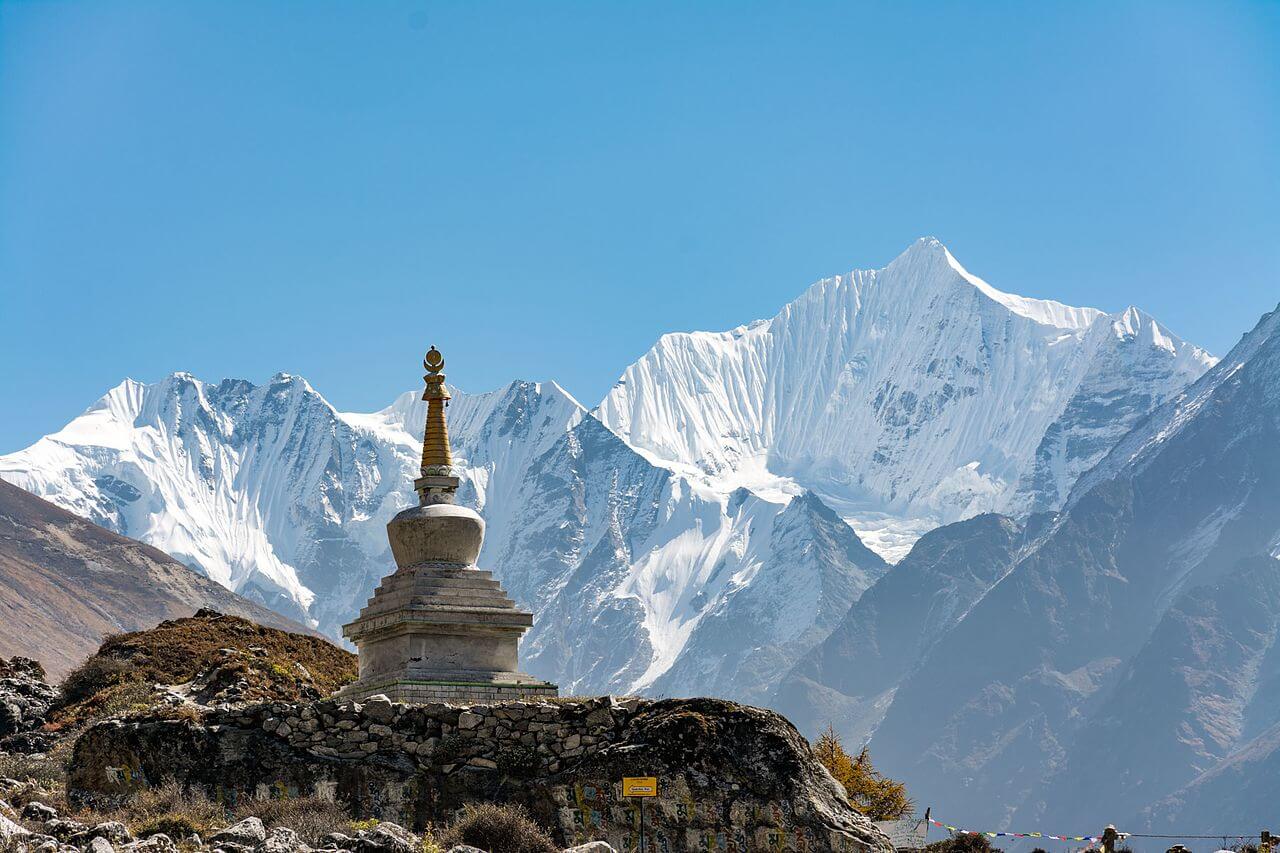
Langtang Valley Trek
Langtang Valley is a classic trekking destination, located only 61.8km away from aerial distance, north of Kathmandu.
Although the Langtang Valley Trek is relatively short, accessible, and cheap, the trails are quieter with less number of trekkers compared to other classic trekking destinations in Nepal .
The trek is ideal for both experienced trekkers as well as novice travel enthusiasts. This trek provides an incredible opportunity to traverse through beautiful Tamang villages, diverse landscapes, eye-catching waterfalls, high Himalayan valleys, monasteries, and densely forested areas.
The mountain trails to Langtang also offers you a spectacular sight of the glaciers and mountains including Langtang Lirung, Ganesh Himal, Jugal Himal, Dorje Lakpa, and Ganja La Pass.
Protected as Langtang National Park , it is home to an abundance of exotic animals and birds. On a lucky day, you may spot plenty of wild animals including red panda, langur, musk deer, snow leopards, Himalayan tahr along with birds like Himalayan monal, white-winged redstart, and the snow Patridge.
Before the catastrophic earthquake in 2015, Langtang used to be one of the most commercial trekking destinations in Nepal. The region was severely affected and damaged by the earthquake. Some of the villages in the region were destroyed and buried under the rubble. However, after massive reconstruction and renovation efforts, the area is now open for the trekkers.
Table of Content
Langtang Valley Trek Facts
Highlights of langtang valley trek.
- Langtang Valley is a relatively short and accessible trekking destination with a fantastic Himalayan experience.
- Relish the beautiful spectacles of Langtang Lirung, Ganesh Himal, Manaslu, and Jugal Himal.
- Breathtaking climb to the vantage point of Tserko Ri at the elevation of 5033m.
- Explore the beautiful Tamang villages and get a more in-depth insight into their cultures and heritages.
- Opportunity to witness rare animals like the red panda, snow leopard, langur, and musk deer.
- Explore the ancient monastery of Kyanjin Gompa.
Getting There and Away
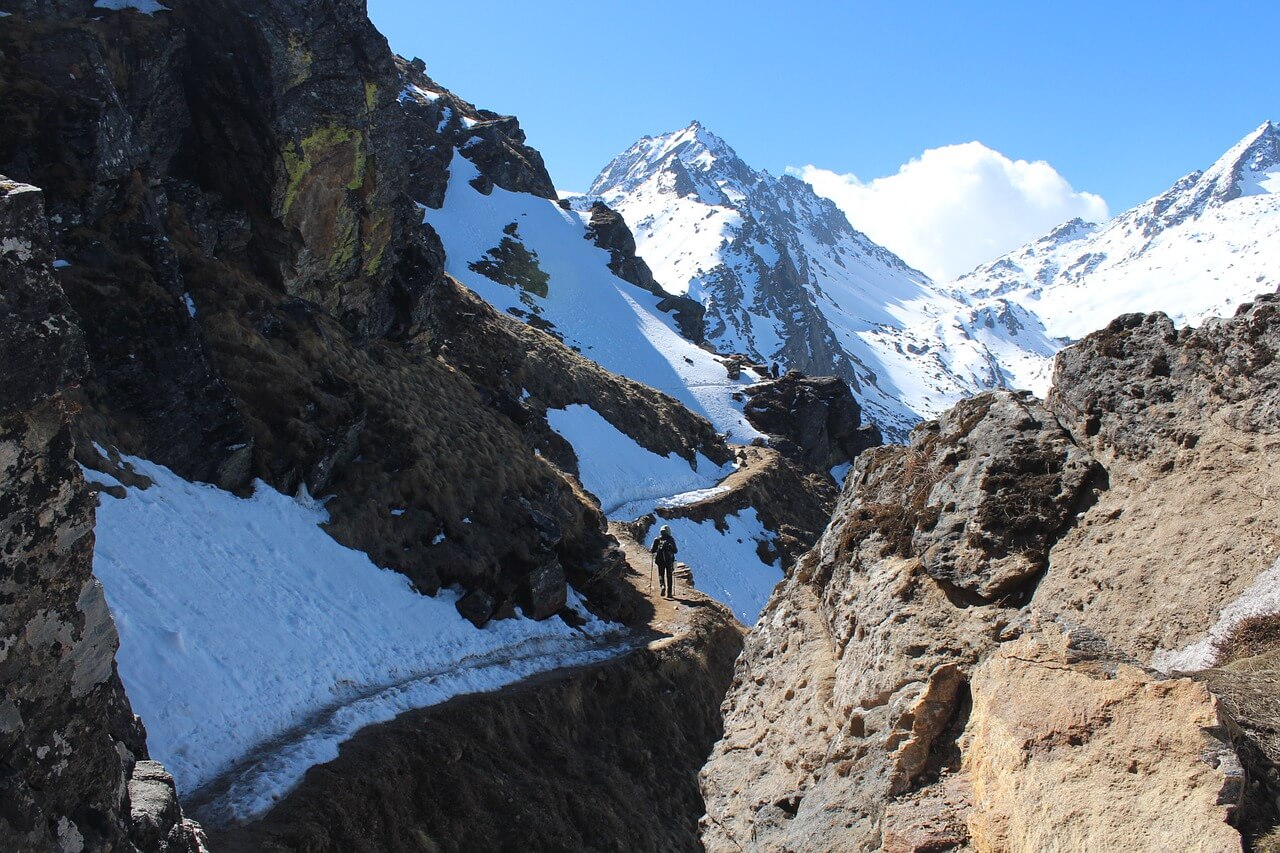
Start of the Trek
Your journey to Langtang Valley Trek begins with a 7-hour drive from Kathmandu to Syabrubesi. The drive from Kathmandu to Syabrubesi covers the total distance of 122km. Although reasonably short in distance, there is still no luxury transportation services available for this region. You can drive to Syabrubesi either by local bus or local/private jeep.
The local bus departs from Machhapokhari every morning from 7 to 9 AM. The bus fare may cost you from $6 to $8 depending upon the different transportation companies. The main discomfort while driving on a local bus is congested seats and too many passengers.
The local jeep will cost about $8 to $10 per person on a sharing basis. You can take these jeeps from Machhapokhari as well. They depart every morning from 6:30 to 9 AM.
If you’re willing to hire a private jeep, it’ll cost you around $150 for a group of 6-7 travelers.
The road condition you travel along reveals its pathetic and rough forms. The highway from Kathmandu to Trishuli Bazaar is good with a narrow winding road. However, once you drive further from Trishuli Bazaar, the road becomes rough and bumpy. Along the way, you come to experience some dreadful landslides.
End of the Trek
Since both starting point and endpoint of Langtang Valley Trek is at Syabrubesi, you’ll be retracing the route backward from Syabrubesi to Kathmandu at the end of the trek.
You’ll have similar transportation options while traveling from Syabrubesi to Kathmandu.
Outline Itinerary of Langtang Valley Trek – 8 Days
Lantang valley trek detailed 8 days itinerary, day 1: drive from kathmandu (1,400m) to syabru besi (1,550m) – 7 to 8 hours.
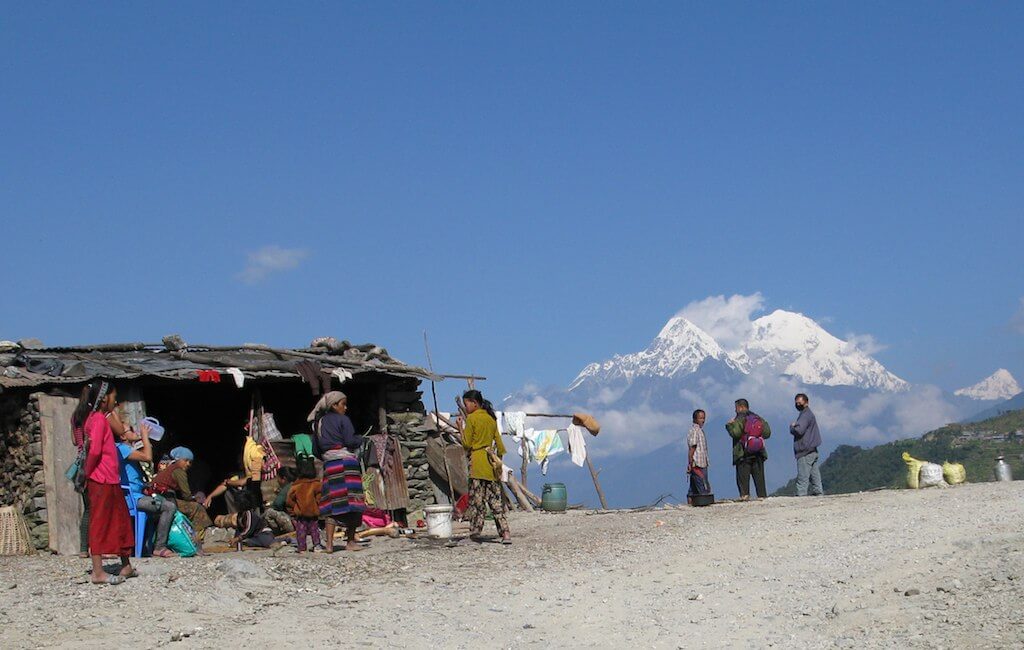
The adventure of Langtang Valley Trek begins with a 7-hour drive from Kathmandu to Syabru Besi. You can either take a local bus from Macchapokhari or hire a jeep to Syabru Besi.
As soon as the bus departs from Kathmandu, the road climbs over the ridge offering majestic views of Ganesh Himal, Manaslu, and Annapurna. The condition of the highway is extremely rocky and rough with tons of potholes and small ditches.
You’ll be driving alongside the Trishuli river for most of the day. Driving past the bustling town of Trisuli, the road leads towards Dhunche, the administrative center of Rasuwa District. Make sure to keep your TIMS card and National Park Permit in an easily accessible place as you’ll need to show them at the Park Gate right before Dhunche. After driving for another hour downhill from the town of Dhunche, you’ll reach Syabru Besi.
Day 2: Trek from Syabru Besi (1,550m) to Lama Hotel (2,380m) – 6 to 7 hours
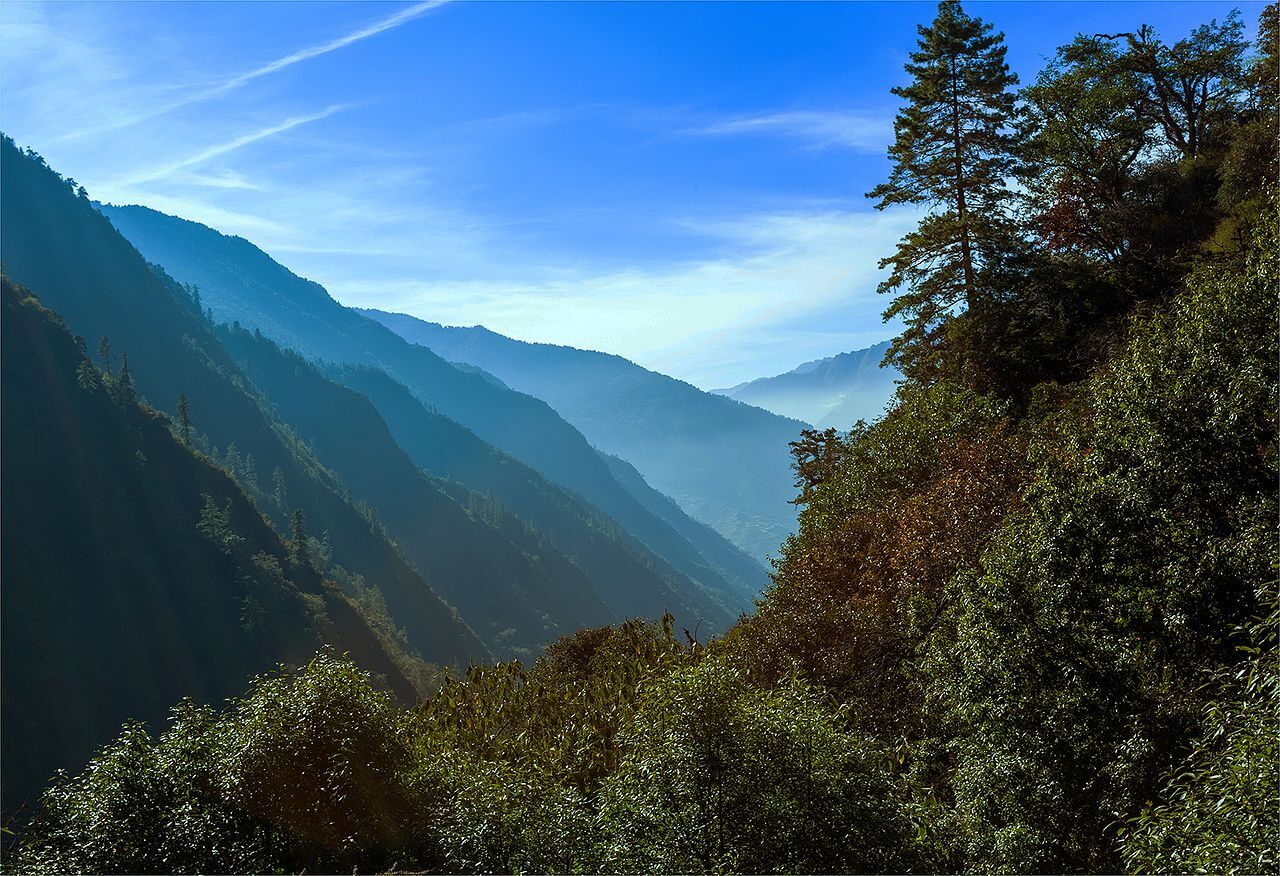
You’ll start the trek from Syabru Besi by crossing the bridge over the Ying Yang River. The trail ascends and descends simultaneously through the dense sub-tropical forest alongside Langtang Khola.
As the trek continues, oak and rhododendron trees dominate the surroundings. While walking in the woods, make sure to watch out for the langur monkeys. The trail goes steep and slightly strenuous through the forest up to Lama Hotel.
Day 3: Trek from Lama Hotel (2,380m) to Mundu (3,430m) via Langtang Village – 6 to 7 hours
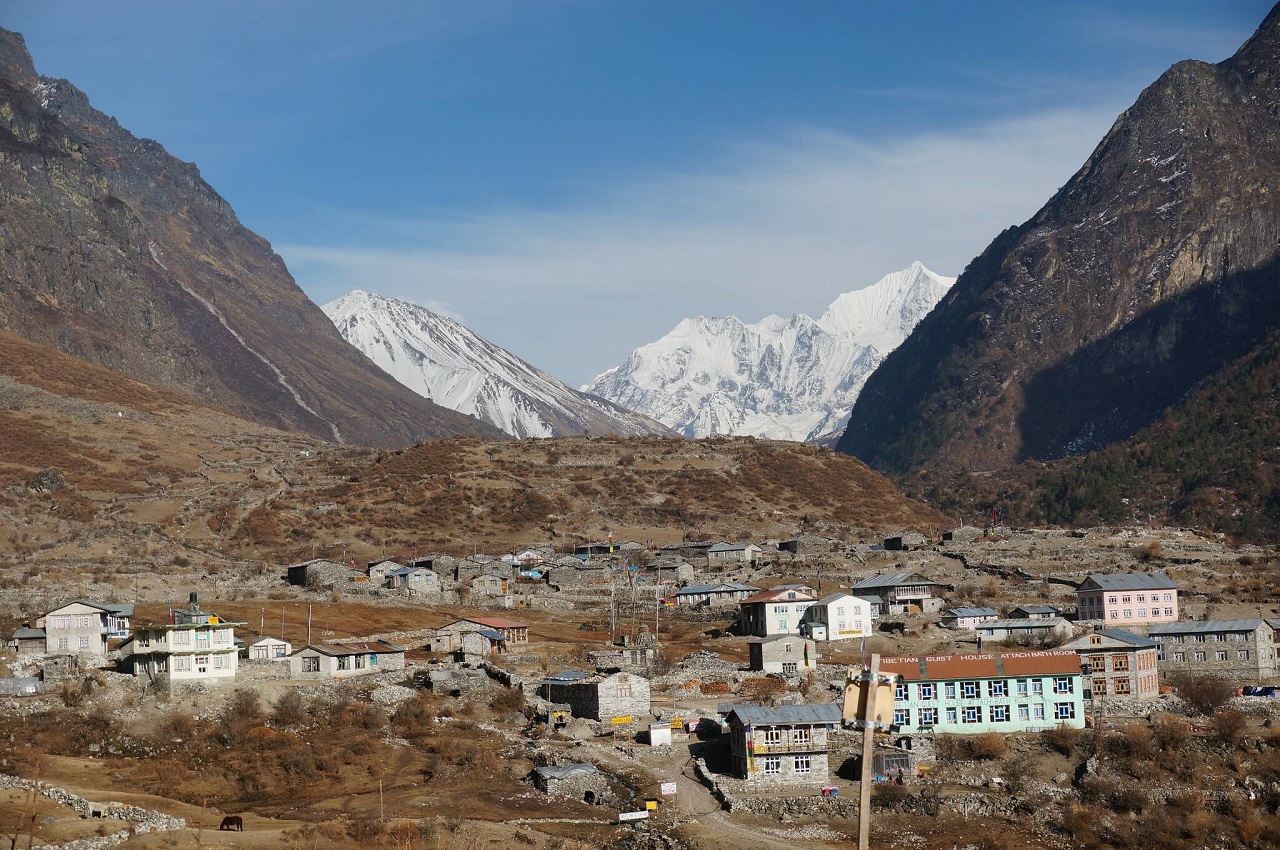
On this day, the forest trail continues through plenty of waterfalls and occasional glimpses of Langtang Lirung. At Ghoda Tabela, the path emerges out of the woodlands into the lush green meadow. The snow-capped peaks of the Langtang range begin to appear on either side of the valley.
The trail further continues to a gentle uphill, passing a few temporary settlements towards Langtang village. Before the 2015 earthquake, Langtang village was once a bustling settlement with plenty of teahouses and lodges. A massive rock field surrounds the entire valley. Mundu village is only half an hour away from Langtang village.
Day 4: Trek from Mundu (3,430m) to Kyanjin Gompa (3,870m) – 3 hours
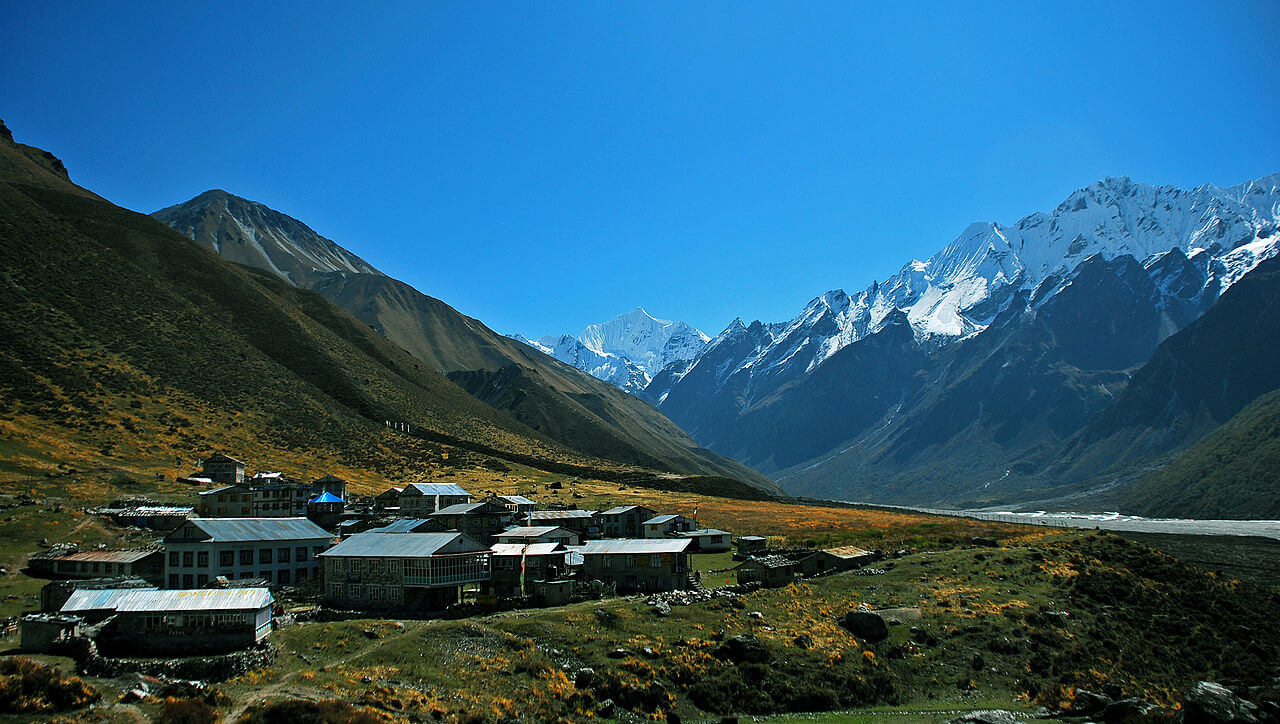
Today, the trail continues gradually passing water mills, chortens, prayer flags, and sacred mounds of rocks with carved inscriptions. The route heads upwards to a yak pasture where the sight becomes more extensive with the mountain views.
As you cross over some moraines and small streams, you’ll reach Kyanjin Gompa. Since this is the shortest day of the trek, you’ll arrive at Kyanjin Gompa by lunchtime. So, if you do not want to spend the day resting, we recommend you head towards Langshisha Kharka for incredible views.
Day 5: Excursion to Tserko Ri (5,000m) – 5 to 6 hours
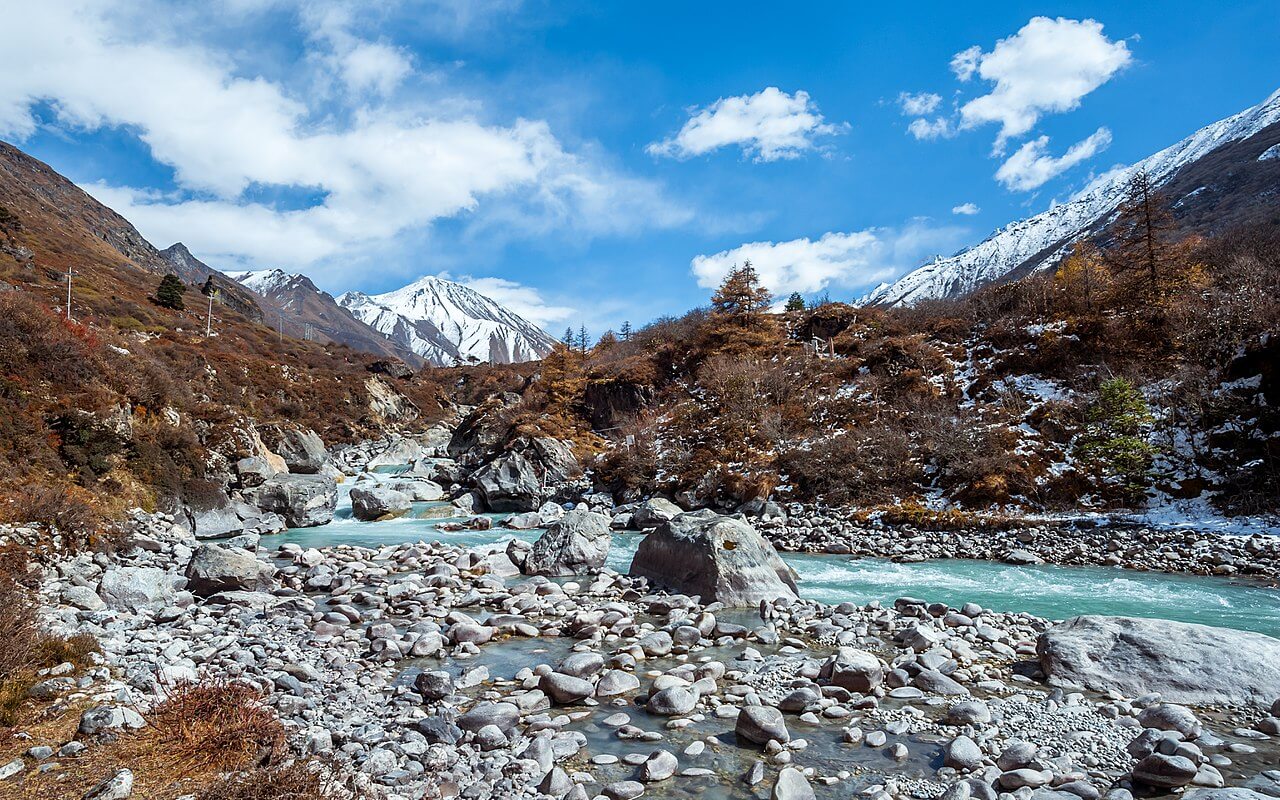
Hike up to the vantage point at Tserko Ri to relish the incredible sights of the mountains, glaciers, and the Langtang valley. Tserko Ri marks the highest elevation point of the trek at 5,000m above sea level.
Since you’ll return to Kyanjin Gompa by the afternoon, you can also explore the ancient monastery of the village. Additionally, you can also visit the cheese factory and glacier.
Day 6: Trek from Kyanjin Gompa (3,870m) to Lama Hotel (2,380m) – 6 to 7 hours
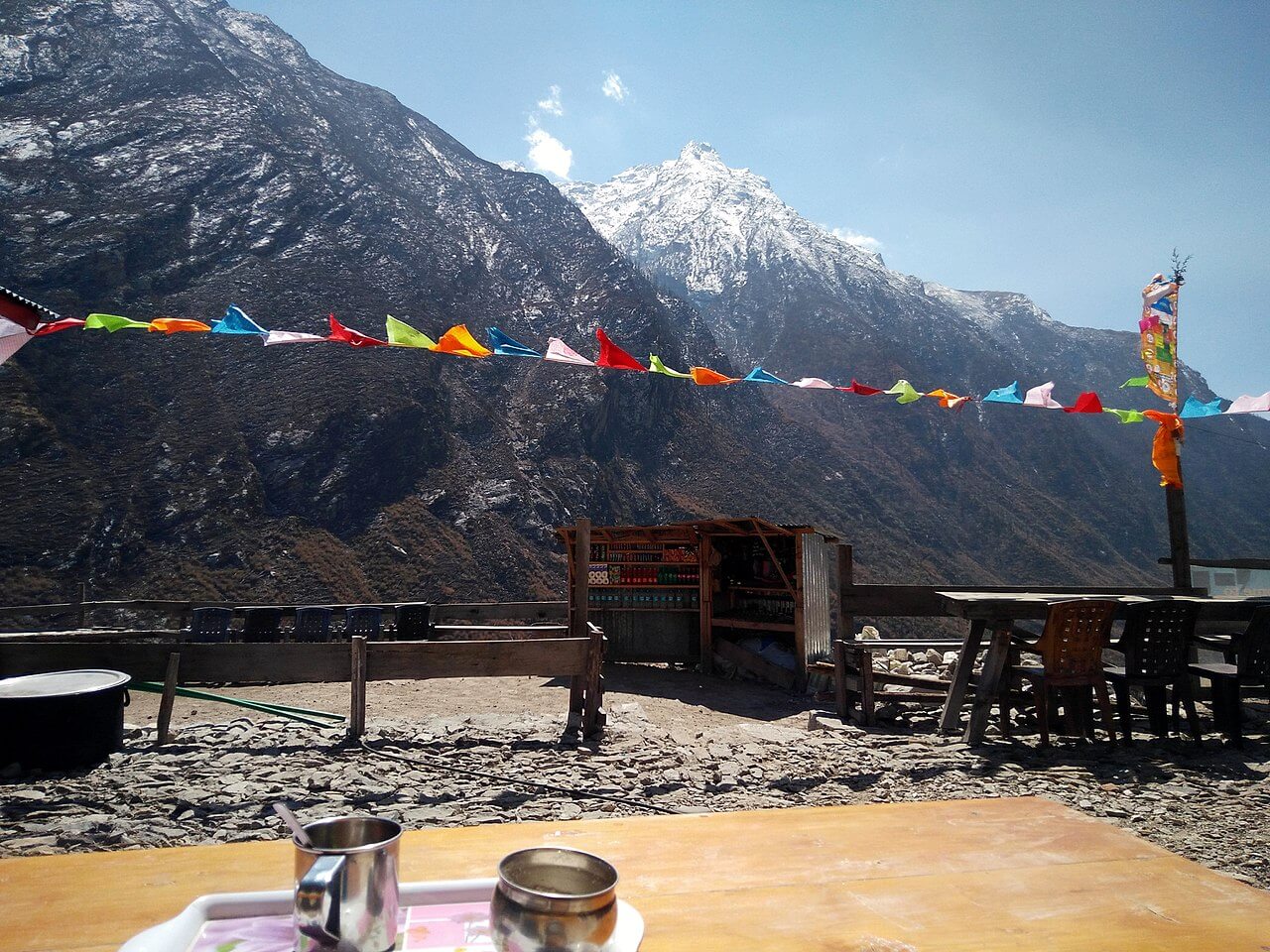
On this day, you retrace the route from Kyanjin Gompa back to Lama Hotel. The way follows back alongside the Langtang River through Mundu village to Ghoda Tabela. The trail is mostly downhill throughout the day. Upon reaching Ghoda Tabela, you’ll continue descending on a steep downhill to Lama Hotel.
Day 7: Trek from Lama Hotel (2,380m) to Syabru Besi (1,550m) – 6 to 7 hours
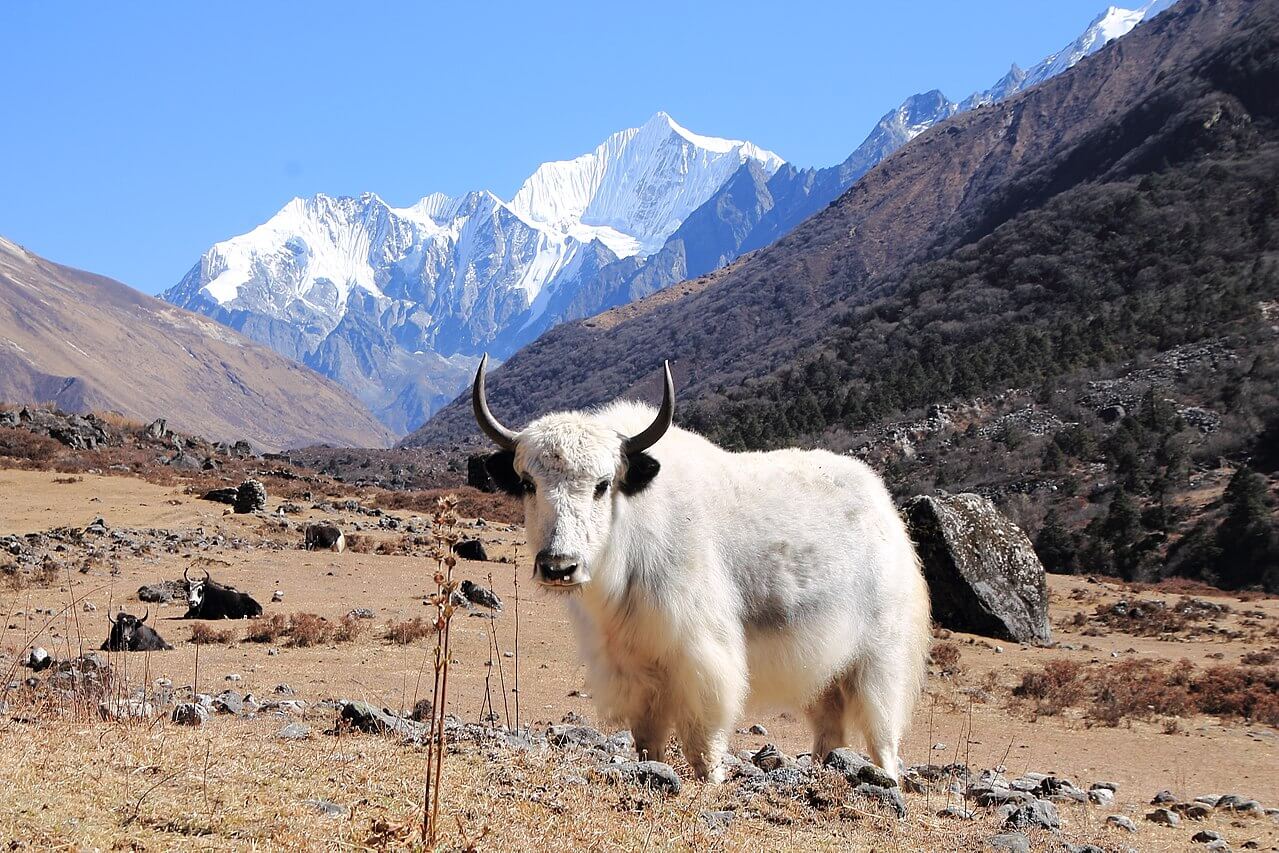
Two different trails lead to Syabru Besi. You can either retrace the route enjoying the forest from Lama Hotel or you can take a detour from Rimche via Sherpa Gaun to Syabru Besi.
The detour from Rimche takes much longer to arrive at Syabru Besi, but this spectacular route is worth the time.
Day 8: Drive from Syabru Besi (1,550m) to Kathmandu (1,400m) – 8 to 10 hours
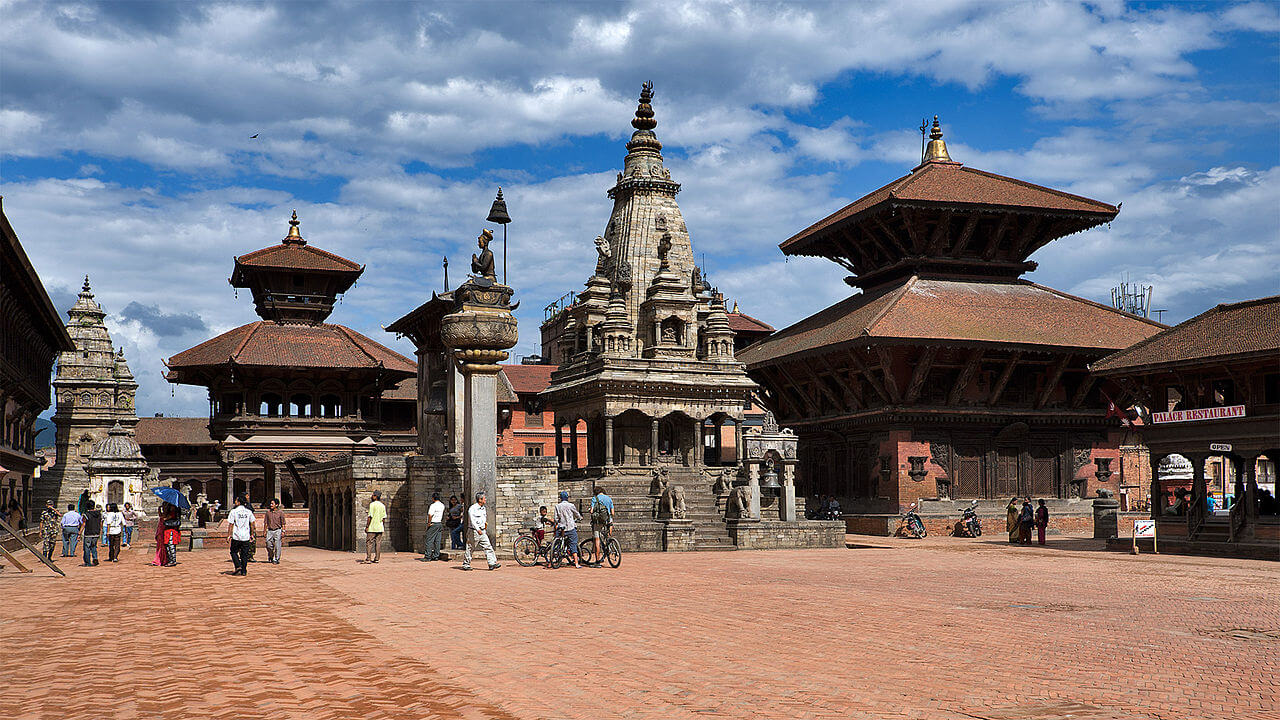
On the final day, you drive back from Syabru Besi to Kathmandu. If you’re early, you can catch a local bus from here. Otherwise, you can also take a local jeep for a slightly convenient experience. It takes about 7-8 hours to drive from Syabru Besi to Kathmandu.
Langtang Valley and Gosainkunda Extension
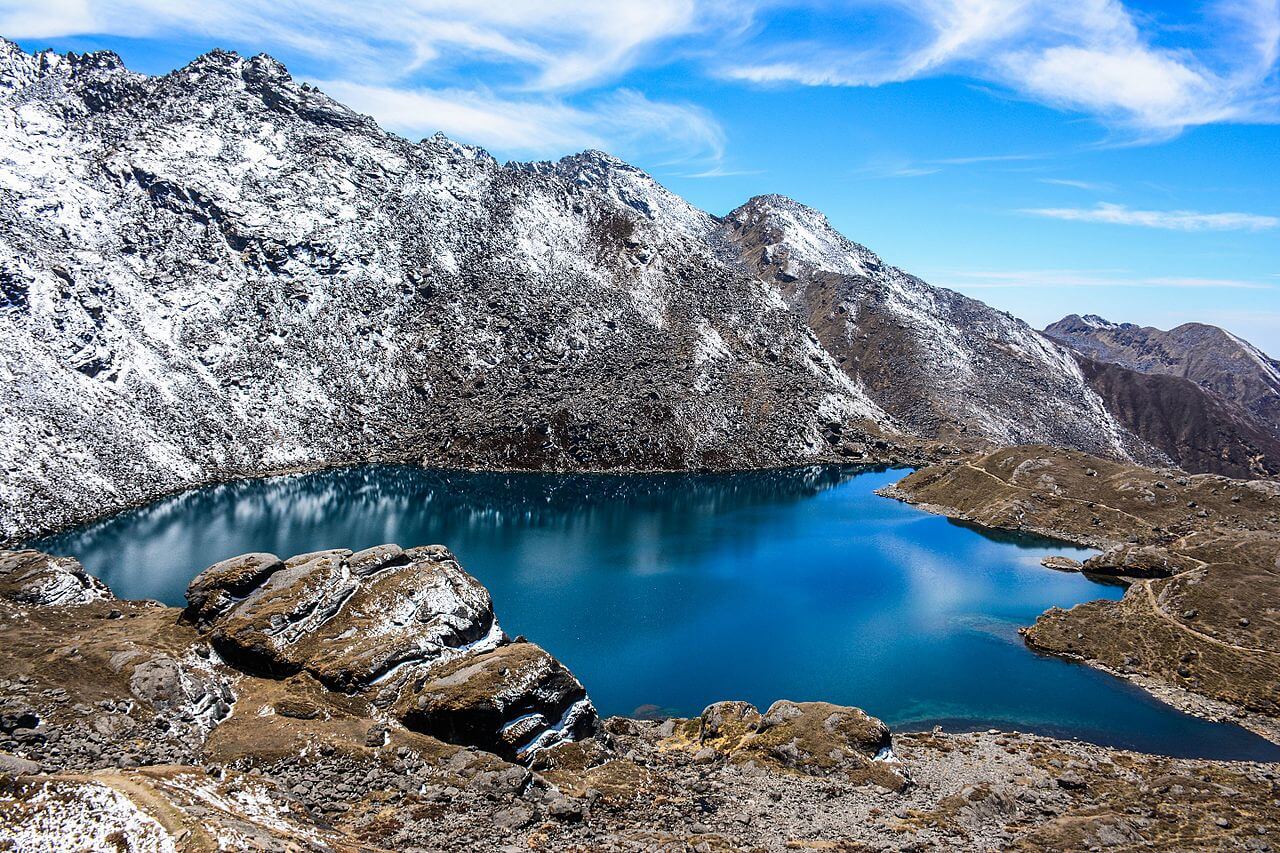
If time permits, you can combine the Langtang Valley Trek with Gosainkunda. The trek offers remote trails with spectacular views of the mountains at Langtang and high Himalayan lake at Gosainkunda.
Gosainkunda, a holy glacial lake at an elevation of 4,380m, is a shrine of Hindus. The diverse landscapes, lush green forest, terraced fields, hills, and scenic mountain views make Gosainkunda one of the most stunning trekking destinations in Nepal.
Langtang Valley Trek with Gosainkunda Extension begins with a drive from Kathmandu to Syabru Besi and then follows through the Langtang Valley. The trail to Gosainkunda connects from Thulo Syapru while retracing the route back from Langtang Trek. The path is quite steep from Thulo Syabru to Sing Gompa and up to the pristine lake of Gosainkunda.
Best Time to Travel in Langtang Region
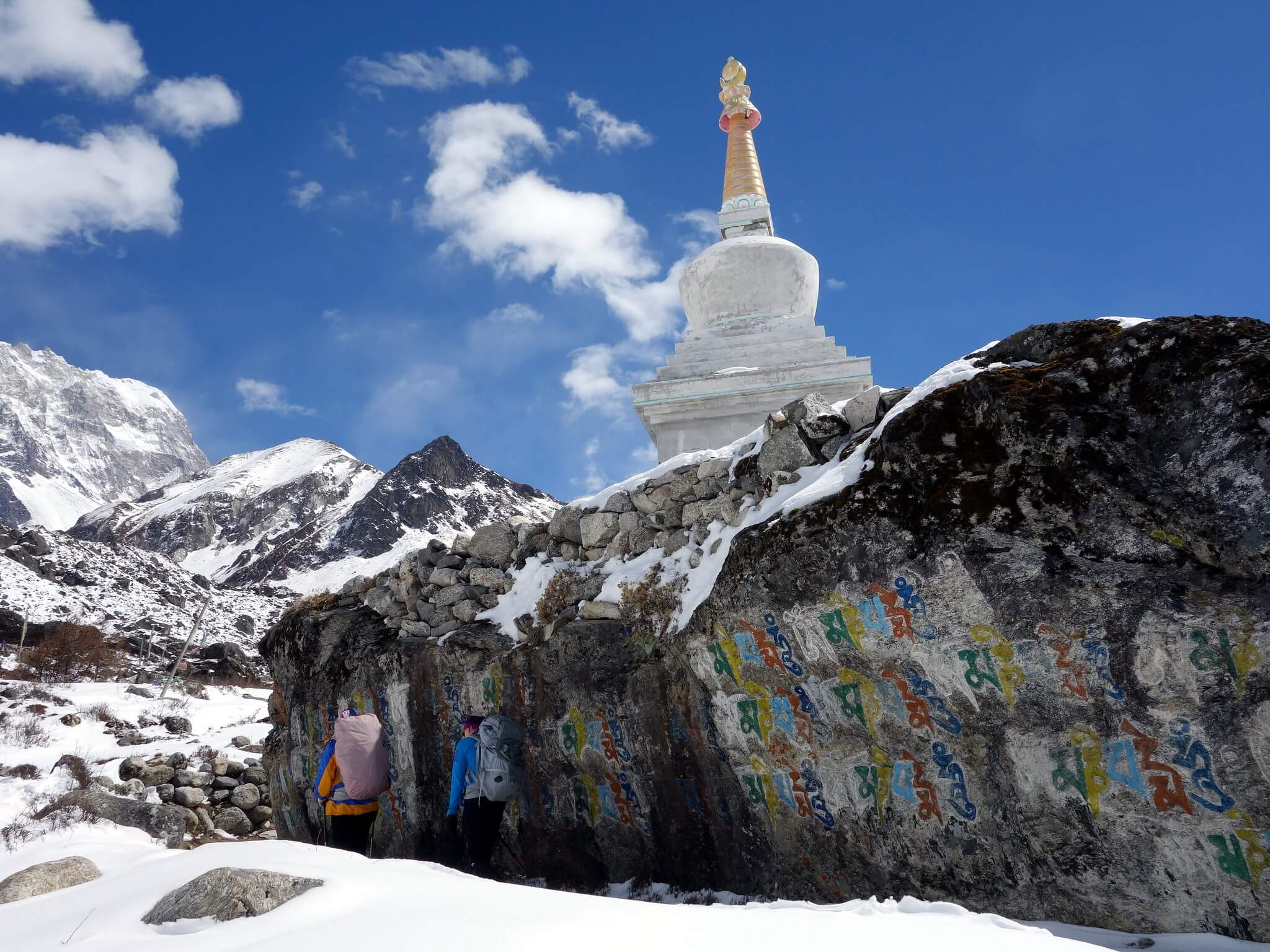
Trekking to Langtang Valley is possible throughout the year. However, Spring season (March to May) right after the cold winter and in Autumn season (September to November) right after the soaking monsoon are two most popular periods to visit the Langtang region.
In most of the days during the Autumn, the temperature remains moderate with a crystal clear sky. This means the temperature during this time of the year is perfect for walking. Also, you get to witness the incredible scenery of the Himalayas throughout the trek. However, the only drawback to trek at this time of the year is the crowded trails.
During the spring season, the temperature is slightly warmer during the day, and the sky looks hazy at times. This means the view may not be as exceptional as the Autumn.
Winter brings cold and harsh weather, especially at the higher elevations. Thick snow covers the trails making it hard to walk during winter. However, the skies are unclouded and reward magnificent sights. If you’re planning to trek to Langtang Valley during the winter, make sure to pack warm clothes and high-quality sleeping bags.
Monsoon is the least favorable time to go trekking in Langtang. The temperature is far too unstable with wet and slippery trails. Since dense forests dominate this region, the risk of leeches increases extensively. Trekking in monsoon demands proper preparation and packing.
Here’s a table indicating the details of average temperature and rainfall of different places en-route to Langtang Valley Trek:
How Difficult is Langtang Valley Trek?
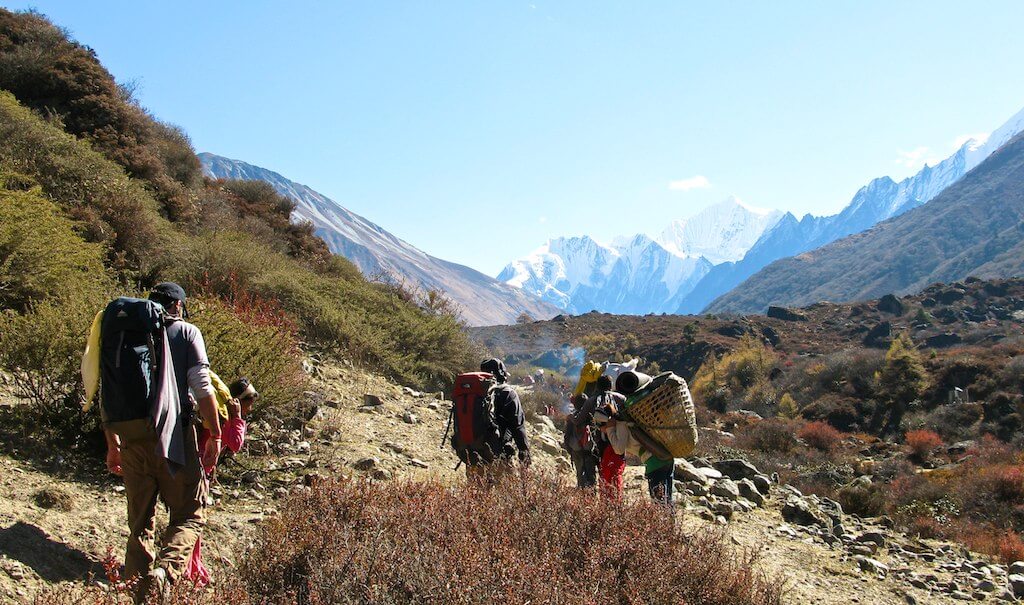
Langtang Valley Trek is a short and moderate trek that does not require any technical skills or previous trekking experience. You can complete the entire trek in 8 to 10 days, walking 5 to 7 hours per day.
The most challenging section of Langtang Trek is the hike from Kyanjin Gompa to Tserko Ri. The trail to Tserko Ri is mostly steep uphill on the rocky Himalayan terrain. However, on most days, the path is easy and comfortable with a pleasant walk.
The highest elevation point in Langtang Valley Trek is 5,000m above sea level. Therefore, Acute Mountain Sickness (AMS) is one of the significant threats while trekking in Langtang. You are required to take all the necessary precautions while traveling in such high elevation. Insist on drinking plenty of water, and be aware of the symptoms of AMS.
The weather in the Himalayas is always unpredictable, especially in the upper reaches. Therefore, it is essential to pack all the necessary equipment while trekking in Langtang Valley. If you’re planning to trek during monsoon season, stay cautious on the trail. There are plenty of landslide-prone areas en-route to Langtang Valley.
While this trek may be relatively easy for experienced trekkers, it does demand a certain level of physical fitness and attitude. One proper way to keep yourself fit for the trek is to engage in cardio-oriented exercises.
What Permits are Requied for Langtang Valley Trek?
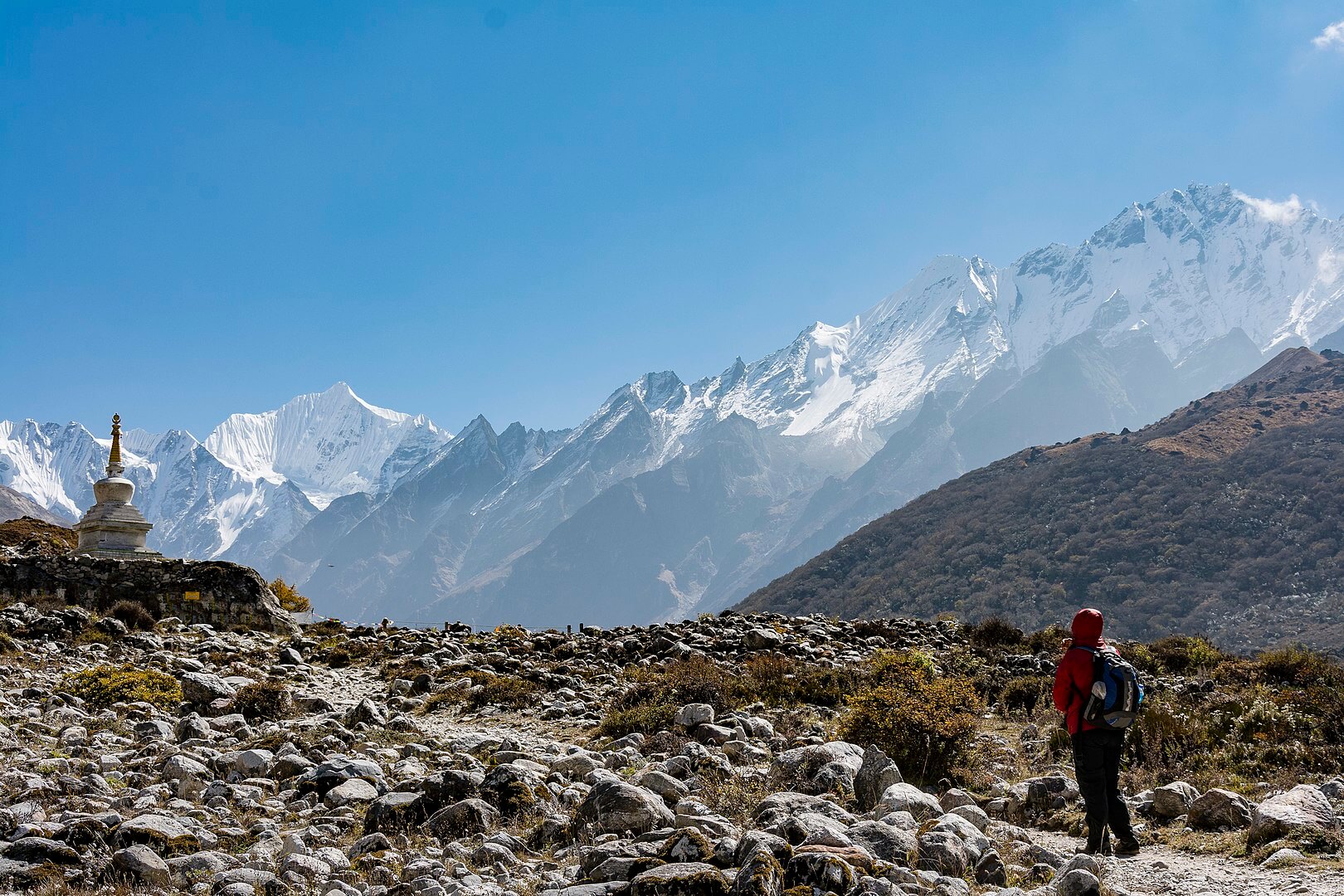
You only require two different permits — TIMS Card (Trekking Information Management System) and Langtang National Park Entry Permit, while trekking to Langtang Valley.
There are three types of TIMS Card; blue for organized group trekkers, green for individual travelers, and a pink one for SAARC nationals. You can acquire TIMS Card from Nepal Tourism Board (NTB) or Trekkers Agencies’ Association of Nepal (TAAN) Secretariat in Kathmandu.
Since you’ll be trekking through the Langtang National Park also need an exclusive National Park Permit to enter the area. The permit is available in Nepal Tourism Board in Kathmandu, or you can also get them from the entry gate at Dhunche.
While issuing a TIMS Card, you’ll require your passport, four passport size photos, insurance details, and contact details of someone in Nepal.
Here’s the price of the permits required for Langtang Valley Trek:
Insurance for the Trek
Having travel insurance is an excellent idea if you’re planning to trek to Langtang Valley. While trekking in such high elevations, you may come across unexpected situations. Therefore, it is essential to get travel insurance for Langtang Trek.
Make sure to choose a policy that covers emergency helicopter evacuation, medical costs, natural disasters, theft, and losses. While several companies provide travel insurance, we advise you to get it from World Nomads. The best thing about World Nomads is that you can claim, buy, or extend the policy anytime online from anywhere — even while traveling.
Guided VS Independent
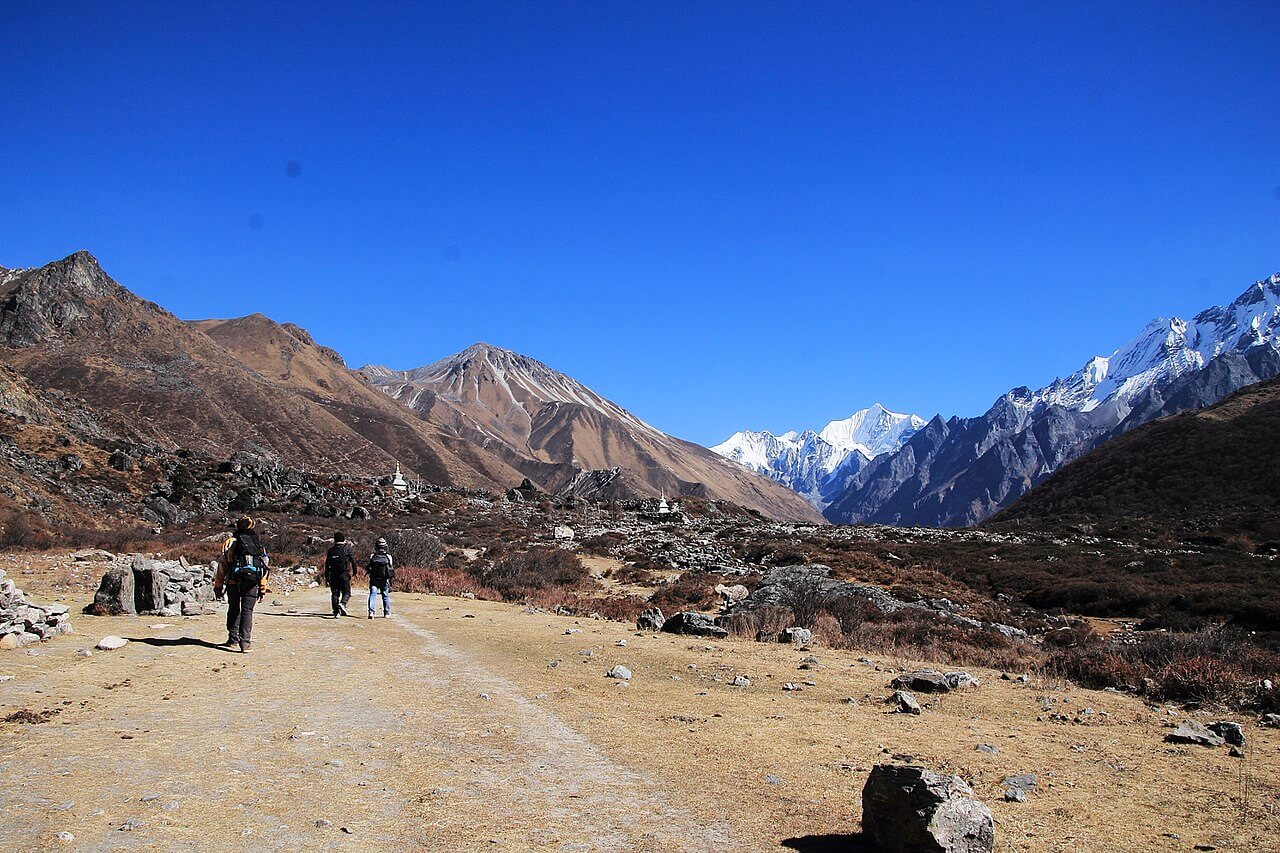
Since Langtang Valley Trek is a moderate walk, you can do it both independently or with a guide. If you’re planning a solo adventure and have prior trekking experience, this trek is an excellent choice for you. The route does not disperse into other trails, and occasional signposts mark the entire trail. Therefore, the risk of taking the wrong path is very minimal.
Altitude is the primary threat while trekking to Langtang Valley. Stay aware and precautious regarding this factor.
Trekking independently is relatively cheaper than hiring a guide, but you need to deal with hassles of transportation, teahouses, food and permit. It is always handy to have an experienced guide at high altitude treks. The guide will assist you throughout the trek and will make sure of your safety.
An experienced guide will also know about the place, culture, people, and the mountains. You’ll also get more in-depth information about the valley if you hire an experienced guide.
Accommodation and Food
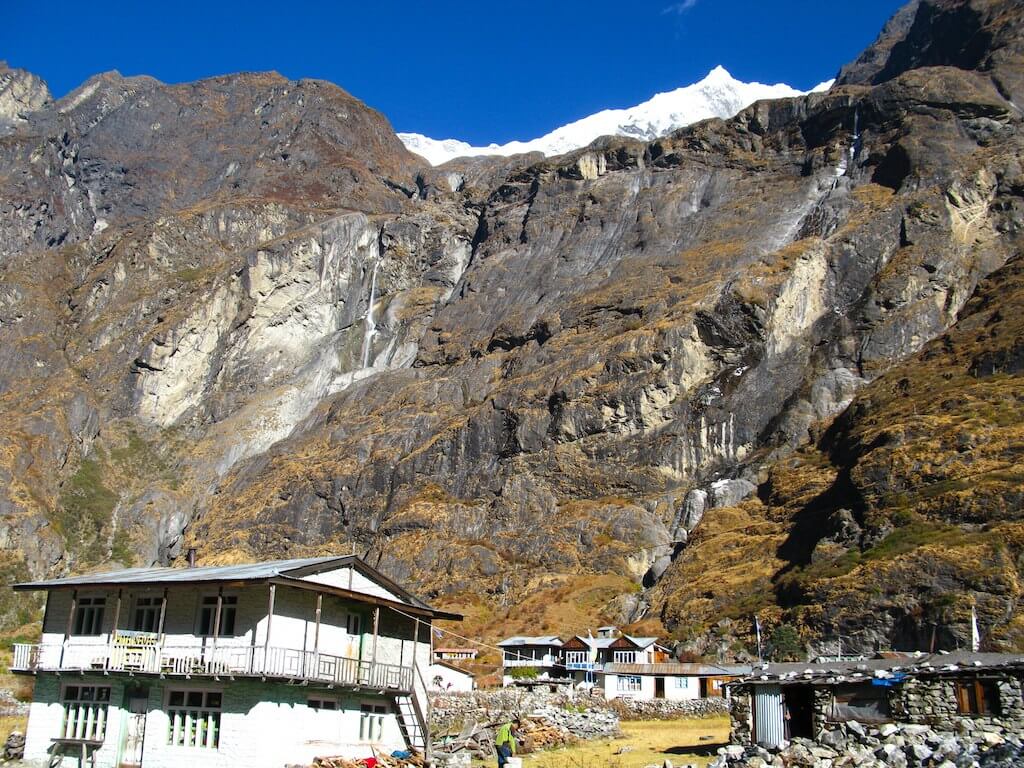
On Langtang Valley Trek, you will mostly stay at the teahouses, which provide rooms, food, and basic amenities like wifi, hot shower, and charging facilities. On the lower reaches of Langtang Valley Trek, you will get high standard rooms with attached bathrooms. These teahouses will offer standard services but may charge you higher than normal rates. Some of the teahouses provide device charging facilities at free of cost.
As you get higher on the trail, teahouses provide only essential services with twin shared rooms. The rooms have two single beds, a thin mattress, a pair of bedsheets, and a cushion. The toilets are usually on a sharing basis without the facility of running water. You’ll have to pay the additional amount for a hot shower, wifi, and charging facilities.
These teahouses also have their restaurant, serving meals to the guests. The choices in the menu are limited, but portions of the food will be quite substantial and filling. Generally, the menu offers Dal Bhat, chowmein, omelet, fried potatoes, pancakes, Tibetan bread, and soups. The non-veg items include yak meat, canned fish, and chicken.
Langtang Valley Trek Cost
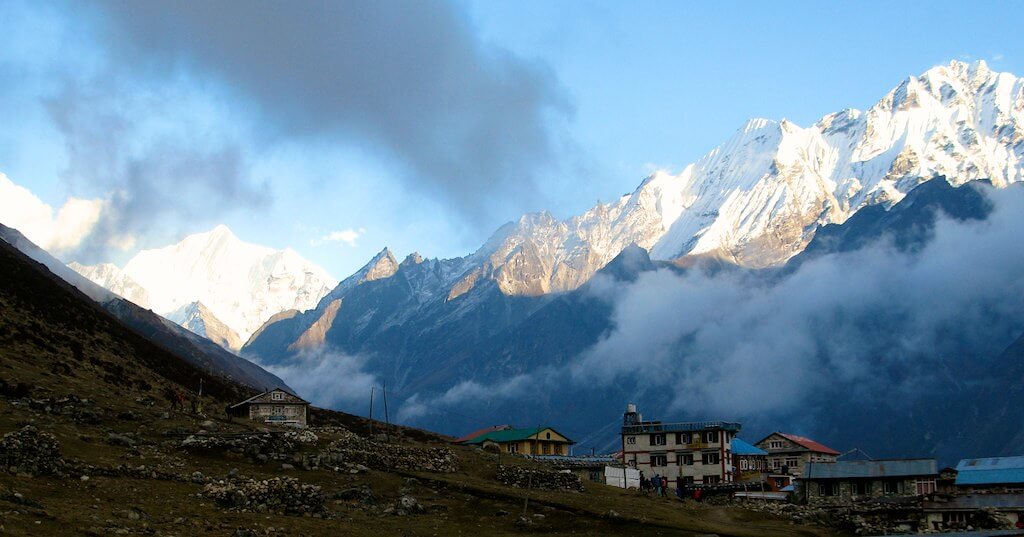
The plenty of factors like trek duration, transportation, type of trek, and season determine the cost of the trek. On average, the total cost of 8-day Langtang Valley Trek can be around US$ 300-400.
You’ll require TIMS Card and Langtang National Park Entry Permits to trek to Langtang Valley. For individual trekkers, the cost of the TIMS Card is US$ 18 while for group trekkers, it is US$ 9 her head. Additionally, the National Park Entry Permit costs US$ 27 per person.
The charge of the teahouses depends on season. Generally, the rooms in Langtang will cost approximately US$ 5 to 10 per night with an additional US$ 4 to 6 per meal.
A local bus from Kathmandu to Syabru Besi will cost about US$ 6-8 per person at par various transport companies. You can also take a local jeep that will cost you around US$ 8-10. Additionally, you can also hire a private jeep for $150 for a group of 6 to 7 people.
If you hire a licensed guide, they will charge you US$ 22 to 25 per day. If you hire a porter, it’ll cost you approximately US$ 15 to 18 per day. If you want to hire a porter-guide, they’ll charge you US$ 18 to 20 per day.
Packing List for Langtang Valley Trek
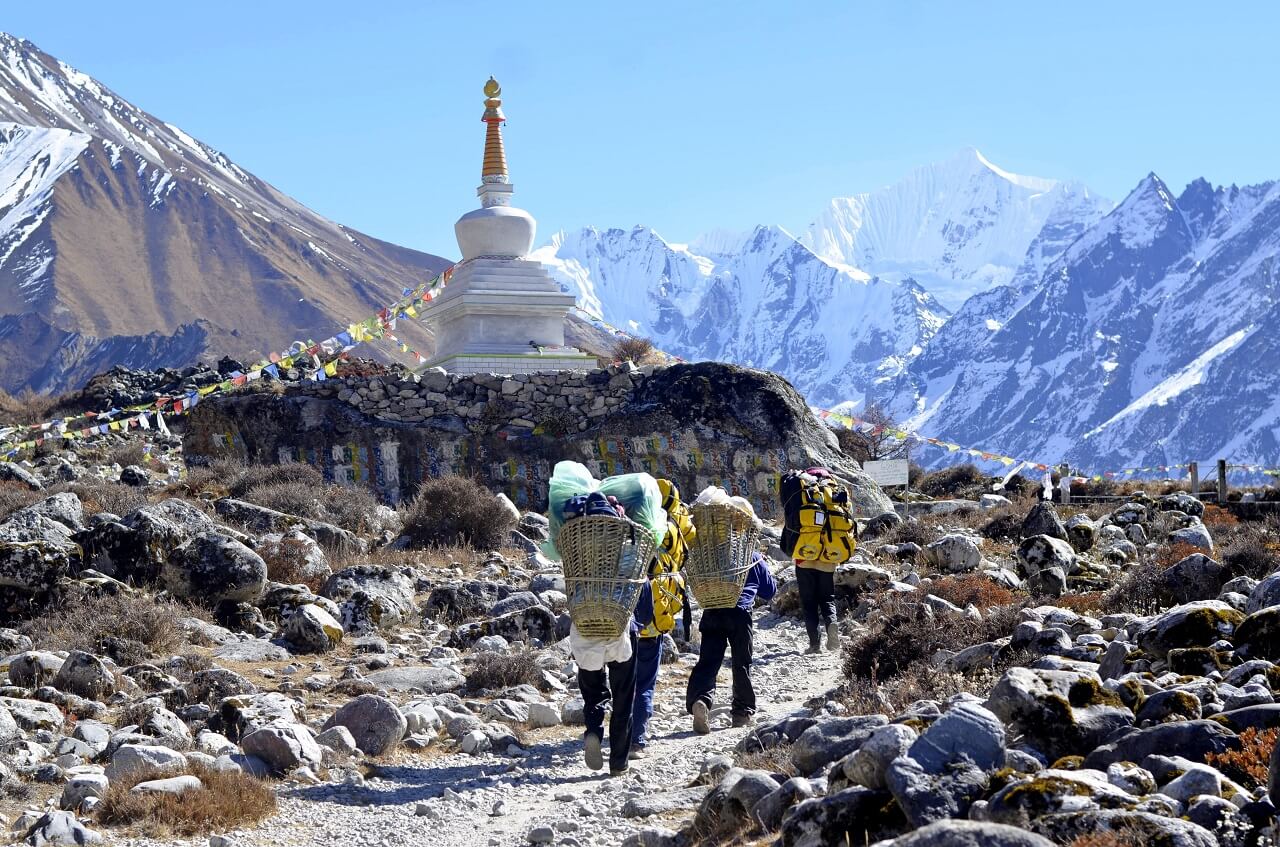
- Duffel Bags
- Trekking Shirt: Pack at least 5 to 7 shirts balancing both long and short.
- Trekking Trousers: Carry a minimum of 2 trekking trousers with a couple of shorts.
- Base Layer: Pack a couple of wool base layers to stay protected from the cold in the upper reaches of the trek.
- Insulation Layer: We recommend you pack a high-quality fleece jacket.
- Outer Layer: Carry a warm and waterproof jacket for extreme weather.
- Waterproof Shell Jacket: Pack a pair of waterproof jackets for wet weather.
- Breathable Underwear: Minimum 5 to 6 pairs of breathable underwear.
- Hiking Boots: Invest in high-quality waterproof hiking boots. Make sure the boot is lightweight and comfortable.
- Trainers/Sandals: It is handy to carry a pair of trainers or sandals.
- Hiking Socks: You should carry 4-6 pairs of breathable hiking socks.
- Thermal Socks: A pair of thermal socks to keep your feet protected from the cold in the higher altitudes.
Head Wears:
- Sun Protection Hat: Carry a protection hat to protect your face from the harsh sun.
- Beanie: An absolute must to keep yourself warm, especially during the evening and night.
- Buff/Neck Gaiter: This small piece of gear comes in handy to protect your neck from the cold winds and also helps you stay protected from the dust.
- Inner Gloves: Pack light inner gloves as they can be useful when the temperature is moderate.
- Outer Gloves: You’ll be wearing them in the upper reaches of the trek. Outer gloves need to be insulated, warm, and waterproof.
Sleeping Bags:
Sleeping bags are the most crucial gears while trekking in the Langtang region. With basic rooms and sleeping facilities, you can never rely on the teahouses for warm, decent blankets.
Therefore, we advise you to invest in a high-quality, 4-season sleeping bag while trekking in Langtang.
Important Accessories:
- Trekking Poles
- Water Bottle
- Basic Medical Kits
- UV Protection Sunglasses
- Water Purification Tablets
- Hand Sanitizers
- Sunscreen/Lip Balm
- Trekking Towels
- Portable Chargers
Network Information
Both Ncell and NTC networks do not work in the Langtang Valley. Once you depart from Kathmandu, NTC services are not available, and Ncell works only up to Lama Hotel. Sky Network is the most preferred telecommunication service in the Langtang Valley. Sky Network works throughout the entire trek, from the lower reaches up to the higher elevations.
Remember, phone services may not be consistent throughout the entire region. Due to the inconsistency of networks, the mobile internet will also be unstable. However, most of the teahouses do provide WiFi facilities, but it might cost you a few extra bucks.
The majority of the teahouses in Langtang have landline phones. In case of emergencies, landline phones are the best way to connect with your emergency contacts.
Useful Tips for Langtang Valley Trekking
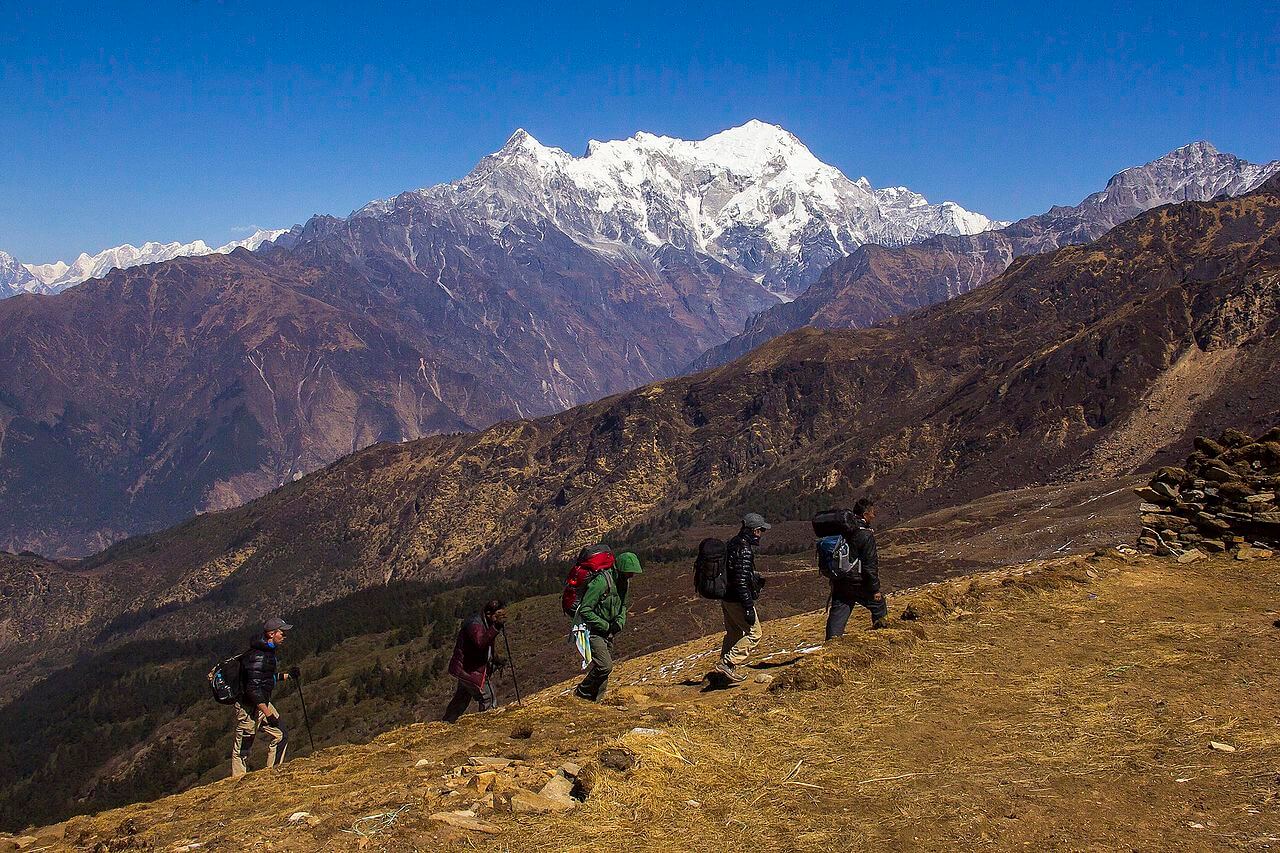
- While trekking in the upper reaches of Langtang Valley, you’re in a constant threat of suffering from acute mountain sickness (AMS). It is crucial to drink more water and take all the necessary precautions to protect yourself from altitude sickness.
- Packing the right equipment is essential while trekking to Langtang Valley. If you do not wish to buy all the expensive trekking gears, we advise you to rent them in Kathmandu.
- Although Langtang Valley Trek is a relatively moderate trek, it requires a certain level of physical fitness. We suggest you engaging in cardio-oriented activities like cycling, swimming and running, a month before the trek.
- It is not advisable to buy bottled waters as they pollute the trekking trail. We highly recommend you to fill up the water at the teahouses and use water purifiers to treat the water.
- Invest in high-quality hiking boots. If you’re planning to trek to Langtang Valley during monsoon or winter, buy waterproof boots that have sturdy soles.
- Before you go for trekking to Langtang Valley, get proper travel insurance that covers both medical costs and helicopter evacuation.
- Carry enough cash on the trek. ATMs are not available on the trail.
Accommodation in Kathmandu
Recommended travel agencies for langtang valley trek.
- Himalayas on Foot
- Magical Nepal
- Mosaic Adventure
- Nepal Eco Adventure
Recommended Books and Guidebooks
- A Trekking Guide to Langtang
- Lonely Planet Nepal (Travel Guide)
- The Rough Guide to Nepal
- Trekking in Langtang, Helambu & Gosainkund
- Climate Change and the Extreme Events in the Himalayas
- High Adventure
- The Snow Leopard
1. Is it possible to do the Langtang Valley Trek solo/independently?
Langtang Valley Trek is a short and moderate walk in the Himalayas of Nepal. It is possible to do solo as well as in a group. The trail does not diverge in multiple routes and it occasionally marks the signposts. So, the trekkers do not stray off the path.
2. How likely am I to suffer from Acute Mountain Sickness in Langtang Valley Trek?
Keep in mind, Langtang Valley Trek exceeds the elevation of 3000m above sea level. Once you cross the height of 3000m, the possibility of suffering from altitude sickness becomes higher. Therefore, it is crucial to drink more water and take the necessary precautions to stay safe from AMS.
3. What type of accommodation can I expect in Langtang Trek?
In the lower region of Langtang, there are plenty of high standard lodges and teahouses that provide quality services. However, these teahouses are relatively expensive than the common one.
In the upper reaches of the trek, the teahouses offer rooms in sharing basis and other basic facilities.
4. Is it safe to drink water in Langtang Valley Trek?
No, it is not safe to drink water directly from local streams or taps while trekking in the Langtang region. Bottled water is quite expensive on the trail. It is advisable to carry your bottle and fill the water in the teahouses. Carry water purifiers or SteriPen purifiers to treat the water before drinking.
5. Do I need travel insurance before trekking to Langtang Valley?
While travel insurance is not mandatory, it is highly advisable to have one in high altitude treks. Even though Langtang Valley is a short and moderate, trekking in such high elevation is risky. Therefore, it is advisable to have proper travel insurance that covers all the necessary costs.
Langtang Valley Trek is a short and moderate trek in the Himalayas of Nepal. Easily accessible from Kathmandu, this trek is an excellent opportunity that rewards trekkers with authentic experience and warm hospitality.
Langtang Trek is an ideal choice for people who are looking to escape the massive crowd of Everest and Annapurna. It offers a diverse landscape, unique culture, beautiful scenery, and panoramic mountain spectacles.
Langtang Valley is also a perfect adventure destination to discover rare wildlife and plants. Carrying a decent camera is highly advisable as this trek offers plenty of opportunities to capture picture-perfect photographs.
Similar Posts
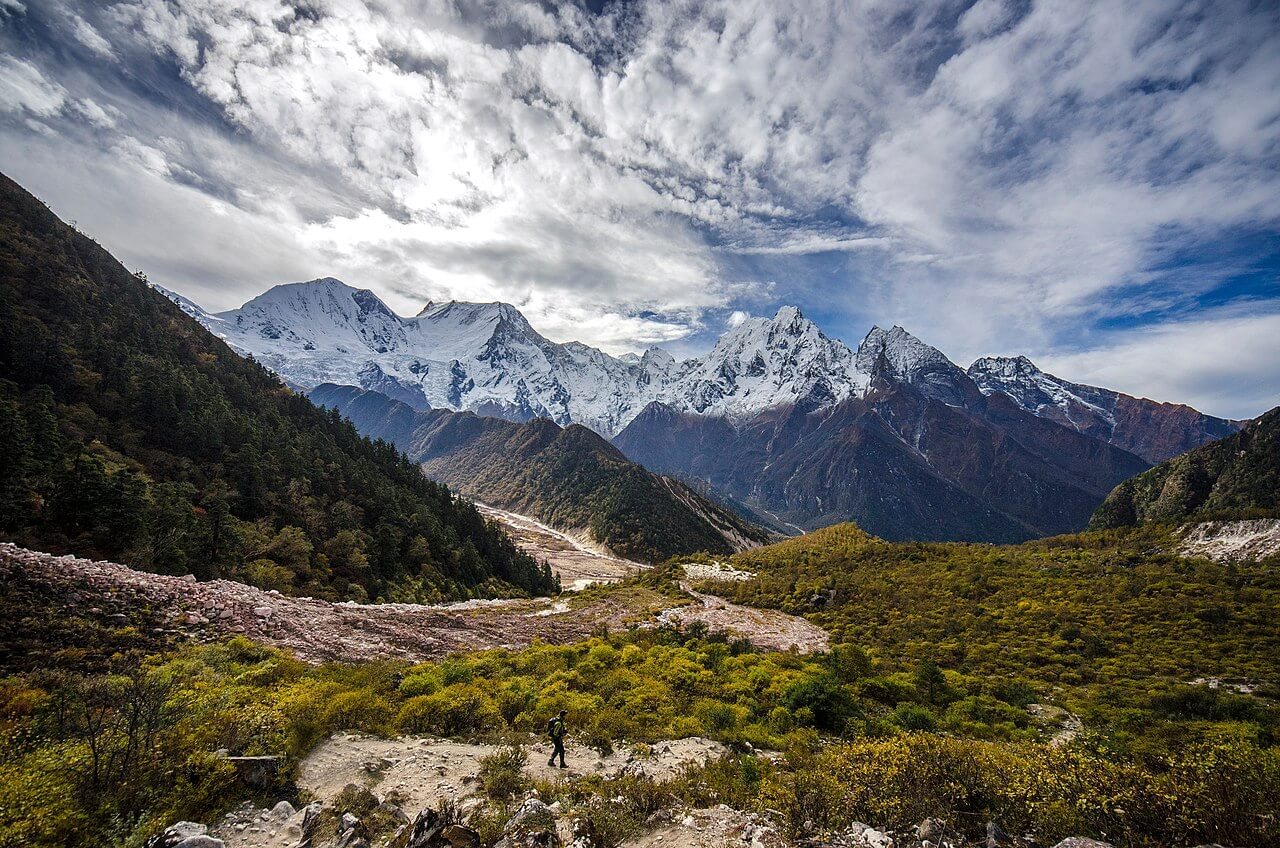
Manaslu Circuit Trek
Manaslu Circuit Trek stands less beaten and secluded compared to treks like Everest or Annapurna, but it is equally as impressive as other classic treks. Manaslu Circuit Trek is the most beautiful as well as demanding treks in Nepal. Trekking in Manaslu is a delightful experience with a blend of adventure, scenery, culture, lifestyle, and…
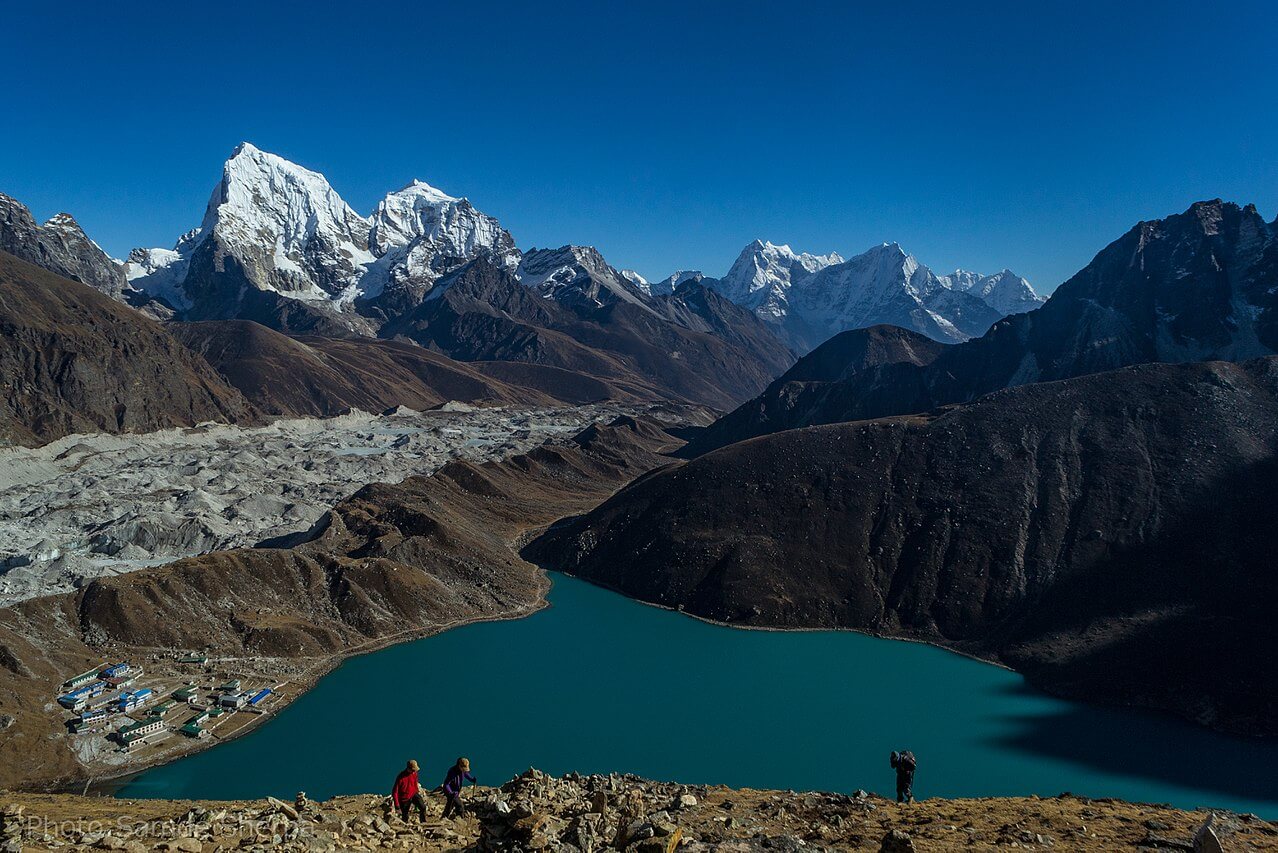
Gokyo Ri Trek
Gokyo Ri Trek, the best alternative trail to the Everest Base Camp Trek, offers exceptional views of the Himalayan peaks along with lakes and glaciers. Gokyo Ri Trek is a moderate trek in the high Himalayas of the Everest region. Instead of traveling to the more commercial Everest Trek, trekkers often choose this itinerary to…
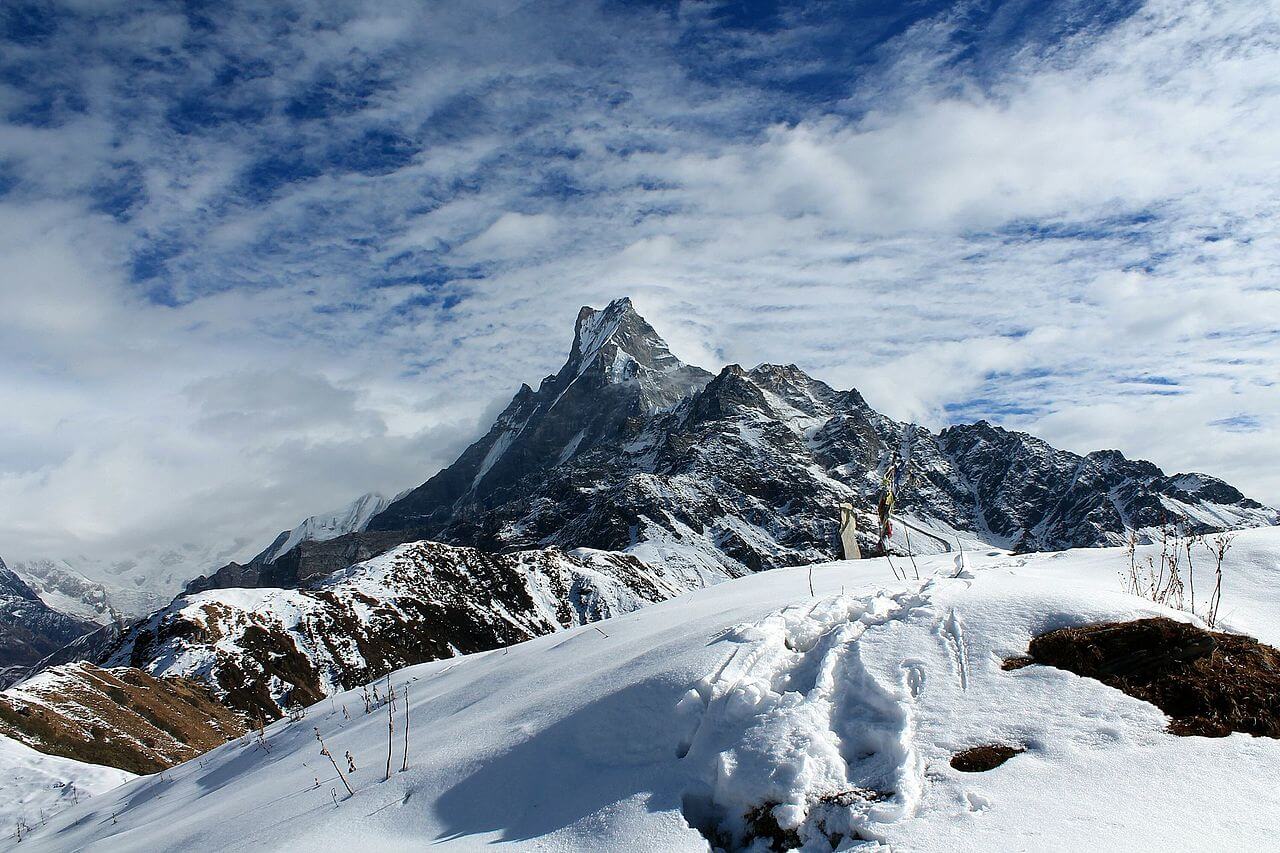
Mardi Himal Trek
Mardi Himal Trek is a hidden gem for the dedicated trekkers and backpackers. Located eastwards of the classic Annapurna Base Camp, this trekking route is yet to witness a large crowd like other commercial treks in Nepal though it officially opened for all in 2012. The richly diverse terrains of Mardi Himal takes you across…
Trekking in Nepal
Langtang Valley Trek – Best Time, Cost, Route, Itinerary
By Suraj Katwal
Updated On May 30, 2023
Langtang Valley Trek offers a majestic view of mountains with panoramic landscapes. It is the top 3 most visited trekking destinations in Nepal alongside Everest Base Camp Trek and Annapurna Base Camp Trek.
This trek is exciting with picturesque views of the beautiful village within the Langtang National Park. Langtang is the best vacation spot for regular and novice trekkers, and I am sure it will be your unforgettable lifetime experience.
Langtang Valley is a hidden gem with a wild rural landscape, and most people follow Tibetan Culture. Moreover, in the peak season, you can get spectacular views of pine forests, rhododendron, snow-capped mountains, magnificent glaciers, etc.
Furthermore, this will be a very long and ultimate guide about Langtang Valley Trek , so if you want to know about specific things about Langtang trekking, then you can follow the quick navigation.
Langtang Trekking Overview
Langtang Valley Trekking is the nearest region from Kathmandu for trekking located on the north side of Nepal. It is a classic and pleasing trek that lies between Nepal and China (Tibet) border. Langtang Valley is also named the “ Valley of Glaciers.”
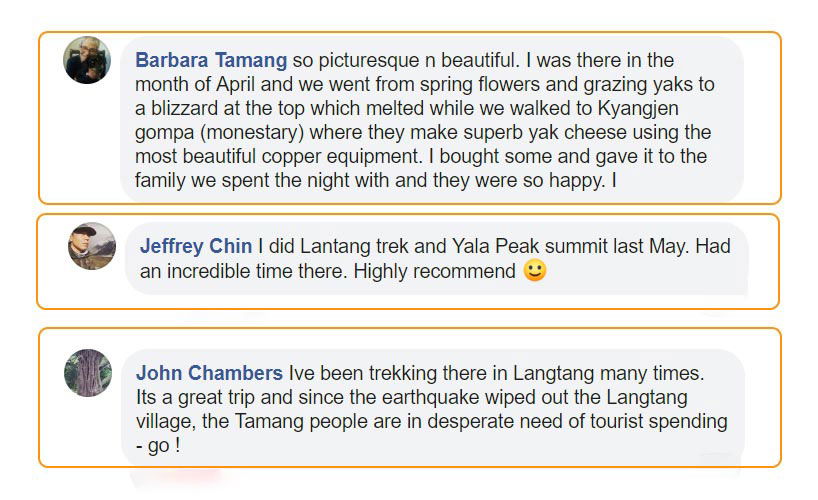
The popular international news website The New York Times has listed Langtang Valley as the top 52 places to visit in the year 2017. I have snapped some Langtang Valley trek reviews from New York Times Travel Facebook Page.
Getting To Langtang Valley
The trek begins from Kathmandu to Syabru Besi. The distance between the capital city and Syabrubesi is roughly 122 km. It takes around 9-10 hours by Public bus and 8-9 hours by Jeep.
It’s not recommended to trek from Kathmandu to Langtang Valley on foot as it’s a long distance and not a safe option. Instead, the trek usually starts from either Syabrubesi or Dhunche, which can be reached by road transport.
2) By Private Jeep
Hiring a private jeep for transportation to Syabrubesi or Dhunche is more expensive than taking a public vehicle. However, if you’re traveling to Nepal through a travel agency, they can arrange private transportation for you, so you don’t have to worry about it.
If you want faster and more comfortable service, you can opt for a private jeep instead of a public bus. A 6-7 seater private jeep service usually costs around $150-$200 for a one-way drive to Dhunche, the starting point of the trek to Langtang Valley.
3) By Public Bus
Taking a public bus is a much cheaper option compared to hiring a jeep for transportation to Syabrubesi or Dhunche. The cost of a public bus is around $7 – $8 per person. The bus service is available at Macha Pokhari, Kathmandu.
The road condition of Pasang Lhamo Highway, which leads to the Langtang Valley trek starting point, is generally okay, but there are some areas where the road can be a bit scary.
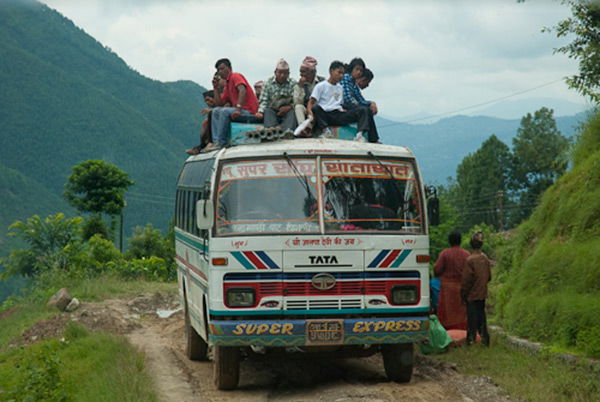
Start Here: Getting Around Nepal
Highlights of Langtang Valley Trek
- Scenic Drive from Kathmandu to Syabrubesi with breathtaking views of the landscapes.
- Explore the unspoiled beauty of Langtang National Park, located between the Nepal-China (Tibet) border.
- Learn more about Tibetan Buddhist culture and their way of life.
- Experience the extended diversity of flora and fauna, including rare species like the red panda and snow leopard.
- Enjoy stunning views of towering peaks like Dorje Lakpa (6,990 m), Langtang-II (7,227 m), Langtang Lirung (7,200 m), Ganesh Himal (7,429 m), and more.
- Immerse in the unique culture and lifestyle of the Tamang community by visiting typical Tamang villages.
- Get the chance to climb Chorko-Ri and witness a panoramic view of the Langtang range.
- Walk through an unimaginable Rhododendron forest, especially during the spring season when the flowers are in full bloom.
Langtang Necessary Permits
Permits are generally required for entry and exit from the Langtang Valley trekking route. Make sure to obtain the necessary permits from the Nepal Tourism Board (NTB) in Kathmandu. You will need to carry your passport and photos for the permit application process.
1) TIMS Card
Trekker’s Information Management System (TIMS) is a card that you get as a permit. These permits must be shown at checkpoints in different places.
The TIMS Card for Langtang Trek is a record that helps trekkers in case of an earthquake, or extreme weather, and for finding lost trekkers.
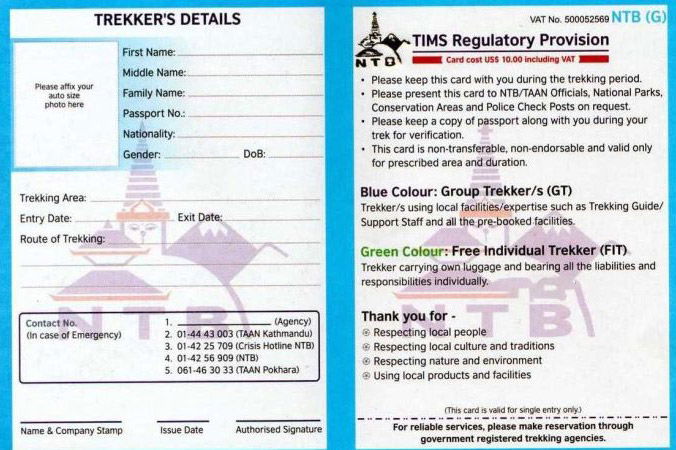
For independent trekkers, it cost around Rs. 2000 ($20), and for group trekkers with a guide, it cost around Rs. 1000 ($10). But if you are traveling through Travel Agency, then they will manage TIMS Cards for you.
2) Langtang National Park Fee
The entrance to Langtang National Park will cost you around Rs 3000 (~$30). You need to ask for this permit at Tourism Board Kathmandu, or you can get it from the Dhunche (Starting point of Langtang Valley Trekking)
Langtang Valley Trekking Itinerary
If you are searching for a good itinerary about Langtang, then this is a new itinerary route after the earthquake in 2015.
This is just an outline itinerary of Langtang. Find the days, hours, heights, and different places in Langtang Valley Trek Itinerary.
The level of the trek starts from easy, and furthermore, you get more challenges, and the journey will reach moderate difficulty as the height rises.
Normally, Pro trekkers want to finish the trek quickly, but novice trekkers need to acclimatize to the surrounding. So, it may take more than a week to complete the full trek.
Langtang Valley Food Guide
For meals, you can get different delicious items. As always you are far away from your home, therefore, don’t expect the food to be of your choice instead adjust with the items in the guesthouse.

1) Breakfast At Langtang Route, you can get tea, juice, toast, pancake, egg, potatoes, mo: mo, etc. for breakfast. The cost of breakfast at this route starts at $2-$3. Higher the elevation the price may increase up to $4-$5.
2) Lunch and Dinner For lunch and dinner, the best food to eat is “ Dal Bhat ” which provides you with lots of calories and proteins. There is a saying about it, “Dal Bhat Power 24 Hours”. You can also find several items beside it like salad, pickles, etc. The price for lunch and dinner is around $4-$5 and may go up at the top.
3) Water Water is yet another most essentials thing to consider while trekking around the Himalayan region. Most trekkers neglect this thing, but it is good to carry an extra bottle with you to avoid spending an additional amount. You can always refill a bottle of water at hotels for free or for a lesser amount.
If you want to buy a bottle of water, then it may cost you from $1.5 at a lower elevation to $3.5 at a higher elevation. And also, don’t forget to drink hot water at the stop to prevent Acute Mountain Sickness (AMS).
Accommodation
Langtang Valley is a much-loved destination, and you can find plenty of tea houses and hotels for accommodation. Don’t expect the guesthouse to be luxurious, but there will be enough clothes to keep you warm.

You can find a clean room, decent beds, and toilets, which will be kind enough to stay at teahouses. In peak season, you may have to adjust the beds and clothes. It is best to contact your travel agency to book excellent accommodation out there.
Langtang Circuit Trekking Route Map
You can find the Langtang Circuit Trekking Route Map that covers the whole valley and basically, the journey starts from Kathmandu. The highest point you will see is Langtang II and Langtang Lirung.
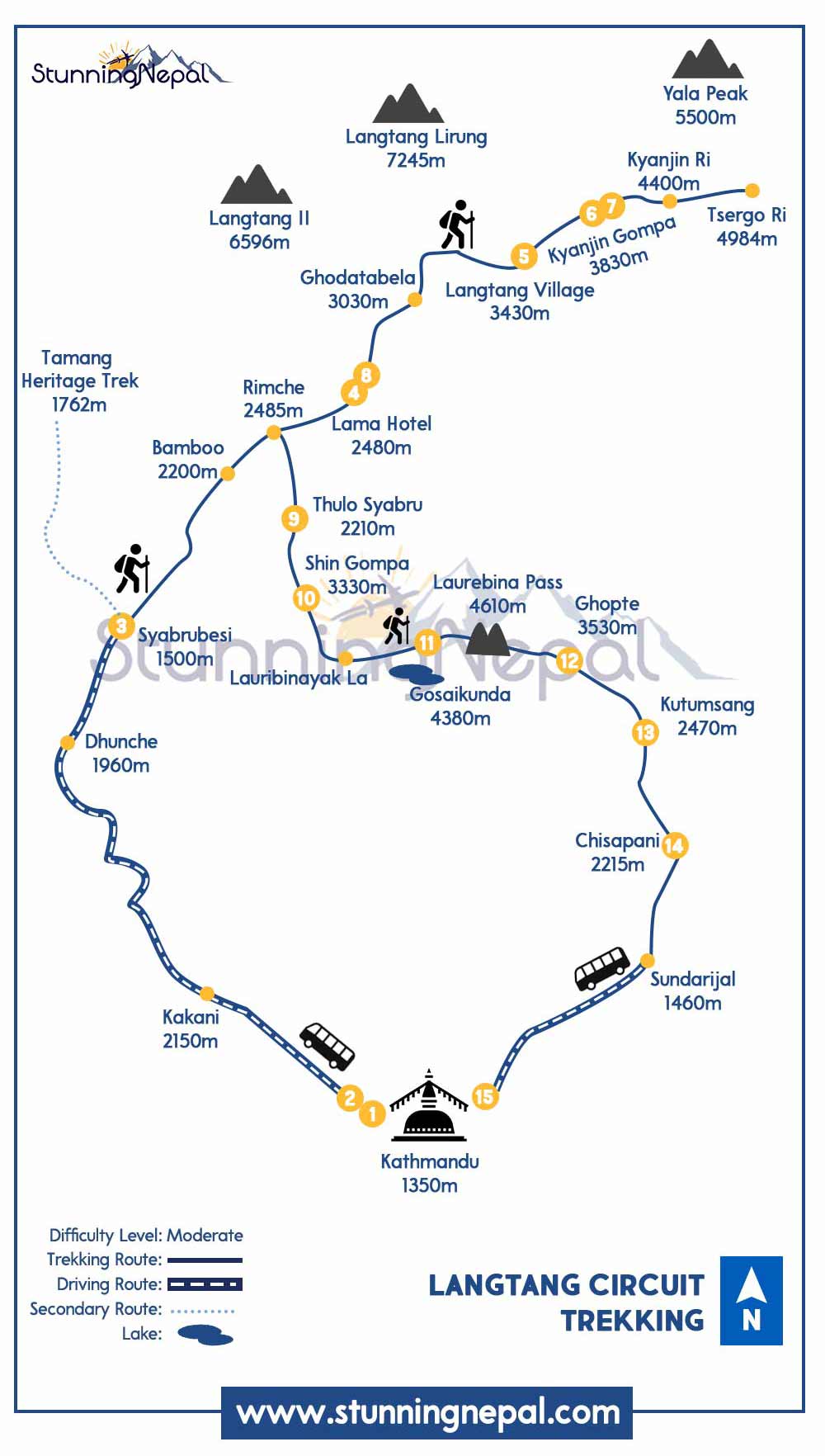
Langtang Trek Altitude Graph Map
There are various itineraries available for the Langtang Valley trek, and each may have a different altitude graph map. However, for the itinerary mentioned above, we will provide the altitude graph map accordingly.

Langtang Trekking Map
If you prefer a hardcopy trekking map of Langtang, you can easily find it in Kathmandu. Numerous shops sell different trekking route maps.
Maps are essential items that you need to carry while trekking. Additionally, you can find the Langtang Geographic map on Amazon.
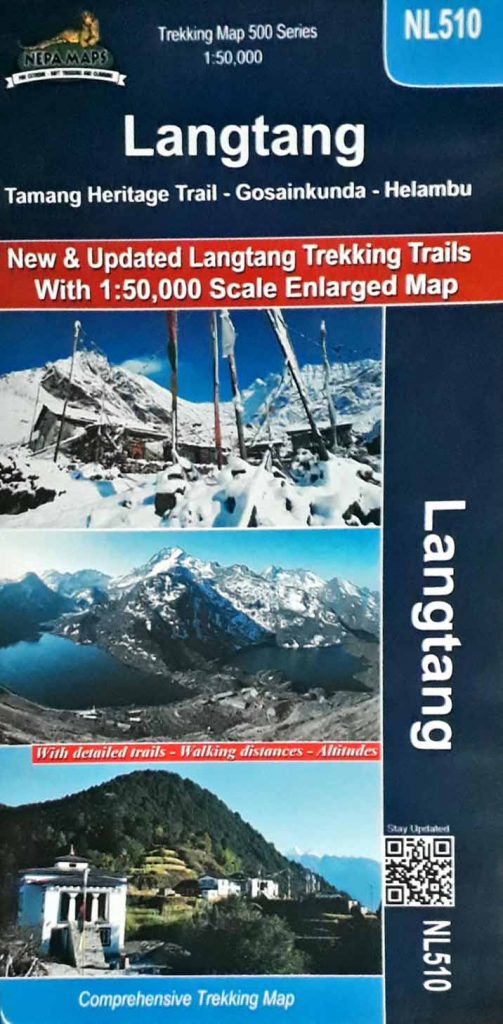
Famous Langtang Trekking Route
Apart from the Langtang Valley trek, there are other famous trekking routes in the Langtang region that you can explore while in Nepal. These include the Helambu Trek, the Gosaikunda Trek, and Tamang Heritage Trail. You can choose to trek to these places individually, or you can opt for a joint Helambu-Gosaikunda-Tamang Heritage trek.
1. Helambu Valley Trekking

Helambu region is a great and nearby place to visit from Kathmandu for a short trek . This place remains unspoiled despite being close to the Capital City. Helambu Trek is a glorious opportunity to explore the culture and tradition of the Sherpa community.
At peak season, you will get to see Rhododendron Forests, Snow-Capped Mountains, Waterfalls, Bamboo Forests, etc. The trek to Helambu starts from Sundarijal located at the eastern end of Kathmandu.
Helambu Trek Highlights
- Explore Buddhist Monastery.
- A glimpse of Snow-capped Mountains.
- Sunrise and Sunset over Mountains.
- Pass through dense rhododendron forest.
- Find unique Sherpa Culture and Lifestyle.
2. Langtang Gosaikunda Trek

Langtang Gosaikunda is an easy trek that is best for a picturesque view of the mountains and is famous for Gosaikunda Lake. Starting from Dhunche to Syabru Besi, Gosaikunda can be reached within 3-4 days.
This sacred lake is one of the holiest lakes famous among Hindus and Buddhists. Thousands of domestic and international travelers visit Gosaikunda Lake every year.
Gosaikunda Trek Highlights
- Beautiful Mountains Ranges.
- Gosaikunda Lake is one of the holiest lakes.
- Astonishing evergreen forests and landscapes.
- Flora and Fauna.
- Explore Lake like Nagkunda, Suryakunda, Saraswatikunda, and, Bhairabkunda.
3. Tamang Heritage Trail
Tamang Heritage Trail is an easily accessible trek from Kathmandu Valley. You will find beautiful Tamang village and tourism in this area has helped to uplift the lifestyle of the people.
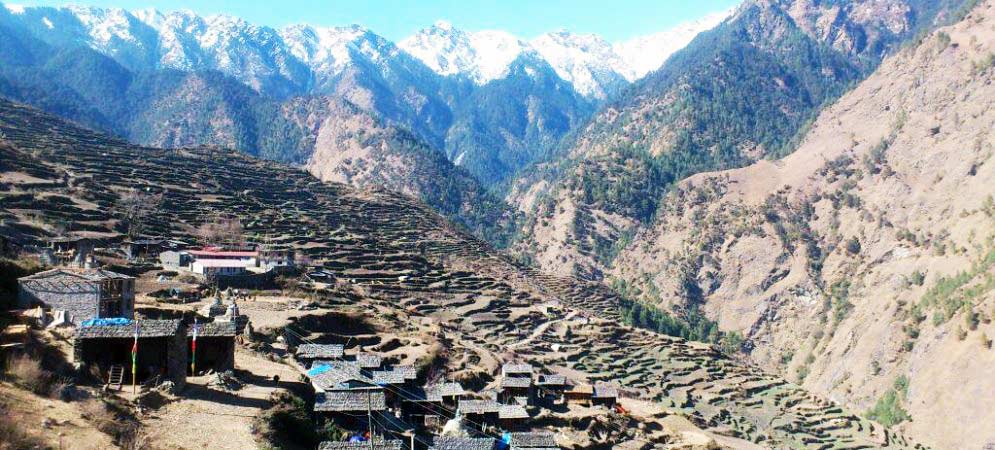
Tamang Heritage is a moderate-difficult trek, and after the earthquake, the route was closed. But now, the route is re-opened, and also hire a local guide to explore more about this heritage trail.
Tamang Heritage Trail Highlights
- Explore traditional houses.
- Culture and Lifestyle of Tamang and Sherpas Community.
- View the highest point Nagthali Pass (3,165 meters).
- View snow-capped mountains Ganesh Himal (7,429 meters), and Langtang Lirung (7,245 meters).
Trekking Gear
This is the most crucial section of this guide. Gears are vital aspects if you are going for short or long trekking. Sometimes backpacking is difficult if you are unfamiliar with the weather condition of a particular place.
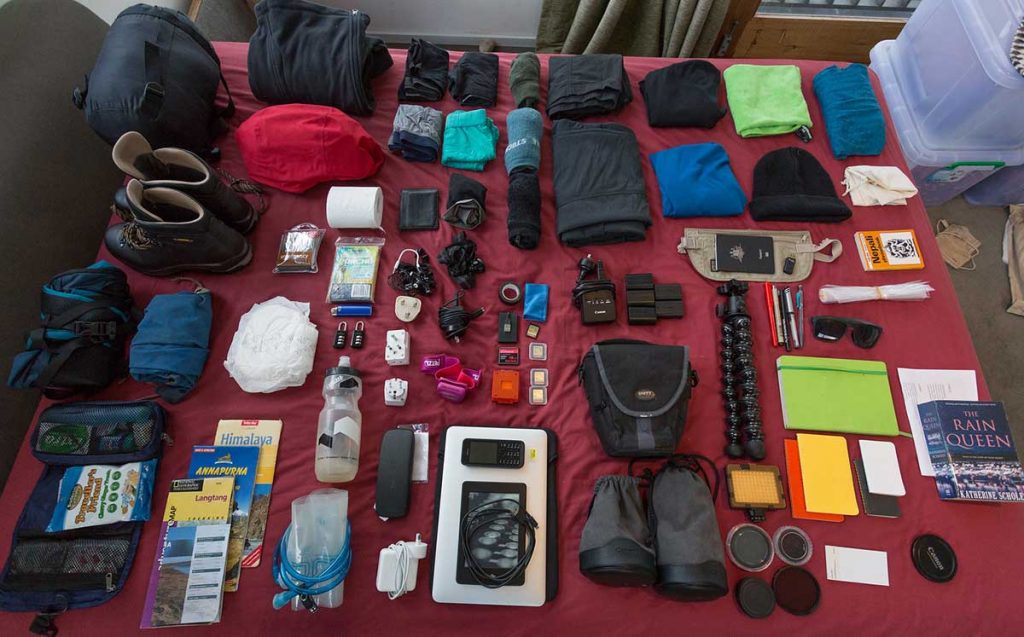
Actually, You don’t have to carry all the trekking gear from your hometown. You can find hundreds of trekking shops in Kathmandu. The shop generally sells or rents the gear items at a low price.
But bring the basic stuff like a hiking boot, Trekking Bag, etc. from your country. Trekking Shop in Kathmandu commonly rents gloves, jackets, Sleeping Bags, etc.
Hiring a Guide and a Porter
Most people love to go hiking or trekking with a guide and a porter. A porter helps to carry your goods so that it will be easier for longer hiking at a higher altitude. Generally, a guide helps to make you more comfortable in a newer place.

Make sure that your travel agency is registered with the Nepal Tourism Board (NTB) and Trekking Agencies Association of Nepal (TAAN). Besides that, you also need to make sure that your agency has a certified guide.
Langtang Trekking for Female Travelers

Nepal is safe for both male and female travelers. For female trekkers, you need to be extra careful while exploring different places.
Sometimes, it will be different situations as every country has its own culture, languages, and lifestyle. So always respect it and be sure you follow them.
Always be careful about the dress code while in Nepal. Also, don’t forget to hire a guide and never go outside alone in the evening time.
Additionally, if you feel uncomfortable with a male guide, then you can hire a female guide too in Nepal and also read our guide for Female Travelers .
Langtang Valley Trek Without Guide
It is always true that you need to hire a guide and porter to be safe while trekking the Langtang region.
Moreover, if you don’t have any prior experience with solo trekking, then this trek might be much more challenging.
Actually, Solo traveling means gaining more experience and knowing the place better. Although, It is best to hire a guide with a porter so that they can carry your luggage and make trekking much more fun.
But, if you are thinking of trekking Langtang without a guide, then be sure about everything, including routes, weather, hotels, and other things.
Then, it is good to explore the Langtang Trek independently starting from the capital city, Kathmandu.
Moreover, most travelers don’t know the Nepali language, but if you have a little bit of experience with it, then it will be much easier. Though, most of the people here at hotels can understand the standard English Language.
Langtang after Earthquake
In the year 2015, Nepal was hit by a devasting 7.8 Magnitude earthquake. Among various affected areas, Langtang was one of them, and her home and the lives of people were deeply affected.
The earthquake hit some parts of this trekking route and moreover, teahouses and guesthouses were destroyed. The avalanche buried the entire village. Therefore, the trekking route was closed for a long time.
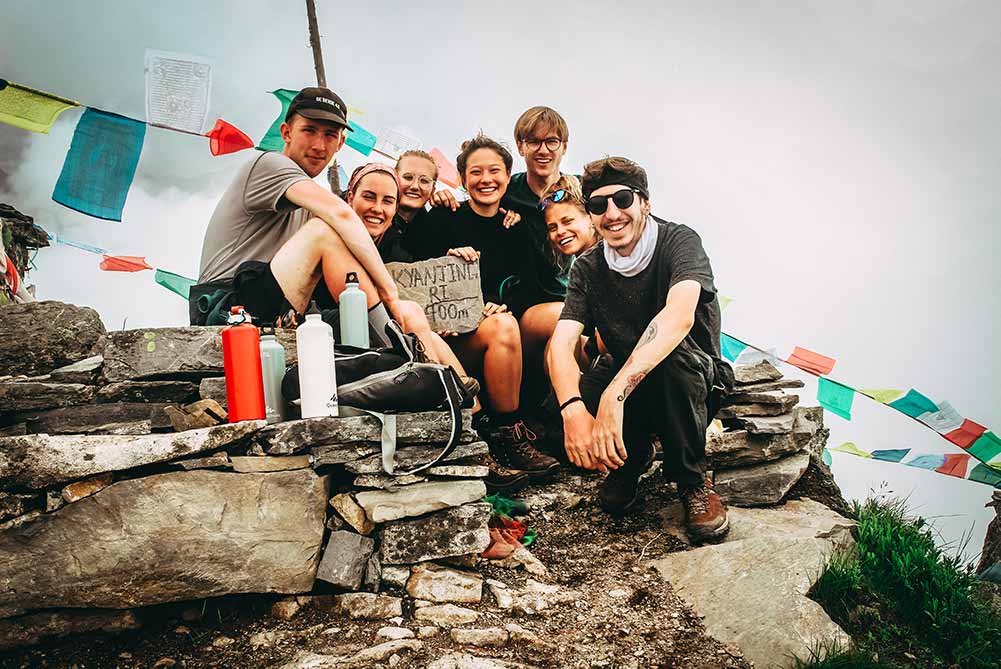
But, now the Nepal Government has reopened this route for trekking. Presently, the Lives of People at Langtang have recovered from the earthquake. The route is good, and you don’t have to worry about it. Also, you can contribute economically to revive the life of the local people.
Nepal Trekking Insurance
While traveling in any part of the world, insurance is a must because no one knows the future. It is essential to have insurance while trekking and traveling to Nepal. Most insurance is necessary when you are going hiking, trekking, climbing, or on an expedition.
Is it necessary to have trekking insurance while visiting Nepal?
Trekking insurance is one of the crucial things while traveling. Nepal is best for hiking and trekking as you can find various routes with easy to hard difficulty levels. So, if you are unfamiliar with hiking and trekking, then we advise going for insurance.
There are different types of insurance policies, and you can take benefits from them. So if you are a solo traveler, then you can go for personal insurance. Also, if you are a group of travelers, then you can also go in bulk too.
Langtang Valley Trek Cost for Nepali
If you want to know the price for the Langtang Valley trek then the cost of the trek ranges from Rs. 15,000 – 20,000. But the cost may vary depending upon the group size, food, and accommodation you take during the trek. Be sure to carry extra money, it will be helpful in case of emergencies and other stuff.
The duration of the trek is 5-7 days that starts from Kathmandu. It is best to manage a group of up to 10 people so that it can be comfortable going for the trek.
So, if you are your friends are looking for a unique trekking experience, be sure to put the Langtang Valley Trek at the top of your list!
Frequently Asked Questions
Which Nepal trek is best?
There are many attractive places in Nepal for trekking. Some of the popular trekking destinations are Everest Base Camp and Annapurna Base Camp . Besides, this Langtang Valley Trek is another popular trekking destination in Nepal. It is the magical and unspoiled trek of Nepal.
How long is Langtang Trek?
Normally, if you have less time, then you can go for 7 days trekking, but if you are searching for an extended version, then you can go for 20-22 days trekking.
Can you trek without a guide?
Basically yes, you can go Langtang trekking without a guide. As said by a local guide, the level of this route starts from Easy to Moderate. So, it is possible without any guide. But we recommend you hire a guide for safekeeping.
How safe is Langtang Trek?
After the devasting earthquake in 2015, the route was closed by Nepal Government, but now the route has been completely changed and re-opened for trekking moreover, it is much safer for trekking.
How much does it cost to trek to Langtang Valley?
It depends upon the trekking days and the travel agency itself. There are lots of factors behind the cost. The estimated cost for the Langtang Valley Trek is between $600-$1000.
How difficult is the Trek?
Trekking Levels are generally graded in 4 parts: Easy, Moderate, Difficult, and Strenuous. The Langtang Valley Trek is a moderate difficulty trek. Most trekkers can finish the Langtang route easily.
How many hours a day do I have to walk during the Trek?
The average walk time is around 5-6 hours a day. So, be prepared mentally and make yourself stronger physically to finish the Langtang Trek.
Do I need a permit for the Langtang Trek?
Yes, you need Trekker’s Information Management System (TIMS) card which must be issued by the Tourism Board. TIMS card must be presented at the entry point at Langtang Gateway.
Will I get altitude sickness on the trek to Langtang?
The range of this trek is moderate. So, there is a low chance of getting altitude sickness, but be sure to take precautions while advancing to a higher altitude.
Can I charge my phone and camera battery during Langtang Valley Trekking?
For electricity, solar panel powers the village, and you get an opportunity to charge your camera battery or cellphone, but you have to pay an extra charge of around $1-$3 per hour. But be sure to carry a portable power bank during the trek to charge up small devices like phones. Also, you can use a portable led USB light using a power bank that comes in handy during the journey.
Is there WiFi on Langtang Valley Trek?
There are WiFi services available in different guesthouses/teahouses. There is around 90% of the area where can use WiFi but you have to pay extra money to use it.
Can I use the ATM during Trek?
Usually, in Langtang Areas, it is difficult to find an ATM lounge. You can use an ATM and Credit Card in Capital City, Kathmandu. It is the best idea to take cash with you if you are exploring rural areas.
Can I hire a local guide during Trek?
Basically, the Travel Agency will arrange a local guide and porter for the whole trek to make your trekking fun and colorful.
We almost have mentioned all the details like the best time to visit, routes, itinerary, Price, Altitude Graph, Trekking Map, etc. So I hope you liked our ultimate guide to Langtang Valley Trek .
If you have a long holiday to spend in Nepal, then you can go for an extended Langtang tour but if you have short vacations then keeping the itineraries tight you can go for 7 days trekking.
If you have any questions/feedback regarding this trek, then please feel free to comment or contact us.
Love this post. Pin it for later
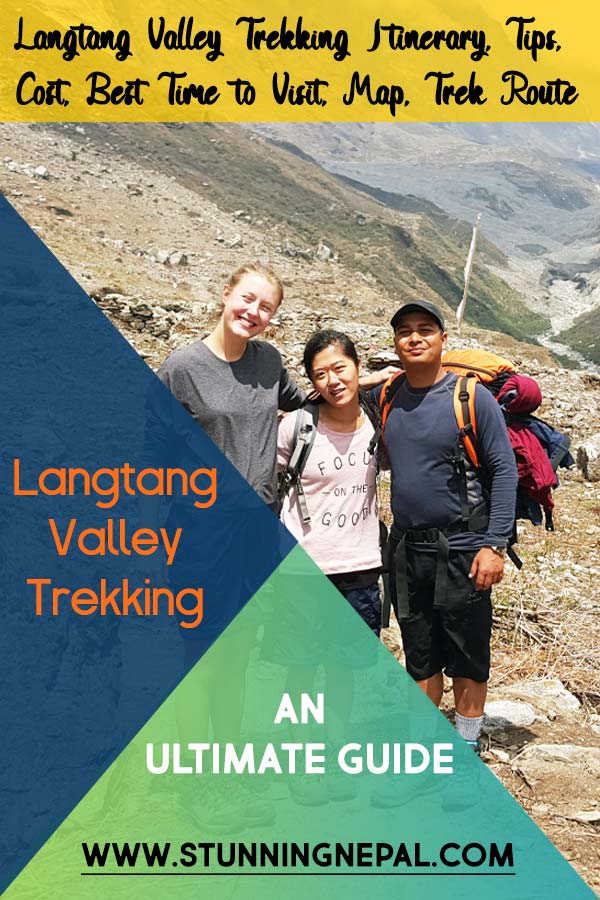
Suraj Katwal
Suraj is a travel enthusiast who believes in finding solace in the heart of nature. He enjoys exploring new destinations, different culture, and encouraging people to travel.
Travel Resources
Hotel & Flight
Searching for the best hotels & flight tickets to visit Nepal? Check out the best deals.
Related Articles...
5 Best One Week Treks in Nepal
Annapurna Base Camp Trek Cost for Nepali
Annapurna Base Camp Trek vs Everest Base Camp Trek
30 Interesting Facts About Mount Everest
Why is Annapurna so Deadly Mountain?
How to Find Travel Agency for Everest Base Camp Trek?
Annapurna Base Camp Trek Weather
Top 5 Family Trek in Nepal
1 thought on “Langtang Valley Trek – Best Time, Cost, Route, Itinerary”
Thanks for sharing very well-written and worth reading this article. Wish to see more in the coming days.
Leave a Comment Cancel reply
About stunning nepal.
Stunning Nepal is a travel blog that intends to provide travel tips, references & guides, things to do & also your guide for hiking & trekking in Nepal.
Travel Guide
Things To Do
Food and Festivals
Privacy Policy
Get in Touch
Stunning Nepal
Address: Dhanawantari Marg, Kathmandu 44600, Nepal
+977-9808211139
© 2024 Stunning Nepal. All Rights Reserved

- Best Hikes In The World
- Appalachian Trail
- European Hikes
- Nepal Hikes
- Patagonia Hikes
- See All Hikes
- Mount Kenya
- Mount Kilimanjaro
- Mount Toubkal
- See All Mountains
- South Africa
- New Zealand
- Switzerland
- United Kingdom
- Packing Lists
Langtang Valley Trek – One Of The World’s Most Beautiful Valleys
Asia , Nepal
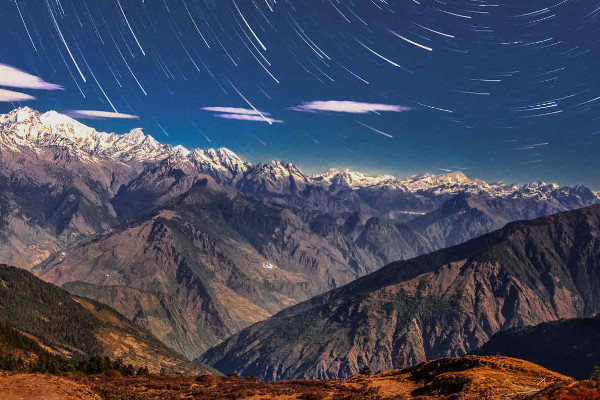
The Langtang Valley Trek is a relatively easy trek and is often far less busy than other popular treks in Nepal . The trek can be done in seven days; however, it usually takes 10 to 12 days.
On this page, you will find a comprehensive and impartial guide to the Langtang Valley Trek.
Langtang Valley Trek
Route overview.
The famed British mountaineer and travel writer, Bill Tilman (1898-1977), called this “one of the world’s most beautiful valleys.”
The local people in the Langtang Valley are mostly of Tibetan origin and, according to legend, the valley was first discovered by a lama – a teacher of Tibetan Buddhism – who was pursuing a runaway yak. “Lang” is Tibetan for “lama” while “tang” is Tibetan for “follow.”
The highlight of the Langtang Valley Trek is the sight of the Langtang Lirung range, which is simply stunning. The eponymous mountain is 23,773 feet high and dominates the valley.
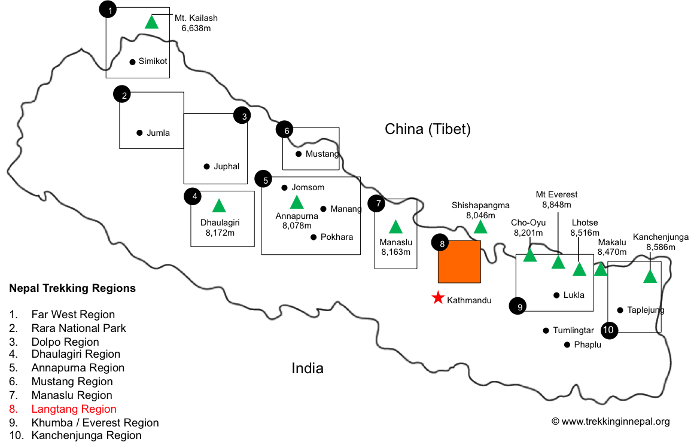
Langtang Regional Map
The Langtang valley region is in central Nepal, around 19 miles directly north of Kathmandu and near the border with Tibet. Although close to Kathmandu, closer than any other trek, this is as wild as it gets.
As you can see from the map above, the valley runs from east to west, sandwiched between the Himalayas to the north and the slightly lower Langtang Lirung range to the south.
Langtang Recommended Map
We believe the best map of the Lantang region is the Langtang & Helambu Map of the GHT which can be purchased online via Amazon. The map is produced based on data collected from the National Geographic Information Infrastructure Programme (NGIIP).
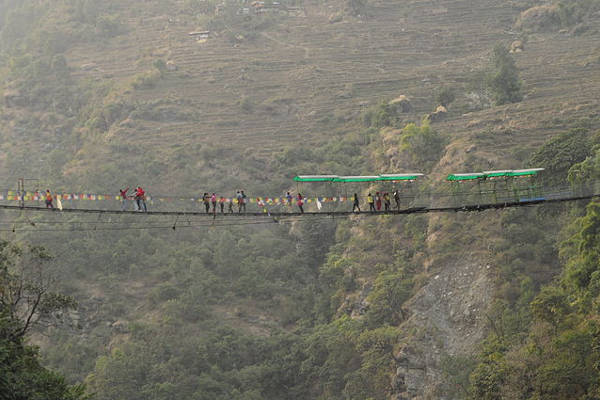
Langtang Trek Itinerary
It is possible to conduct this trek staying only at tea houses, but there is some time under canvas in this particular itinerary. There are several trek itineraries for this route, however, the one below is the most popular. You could also possibly arrange to meet your operator in Syabrubesi if you want to make your own way there.
Day 1-2: Arrive Kathmandu
You will arrive in Kathmandu on the first day.
You have the second day to spare while the provider arranges things. Kathmandu is a UNESCO World Heritage Site , so you could use the time to explore some the incredible local sites. Or you could do some last-minute shopping around the markets.
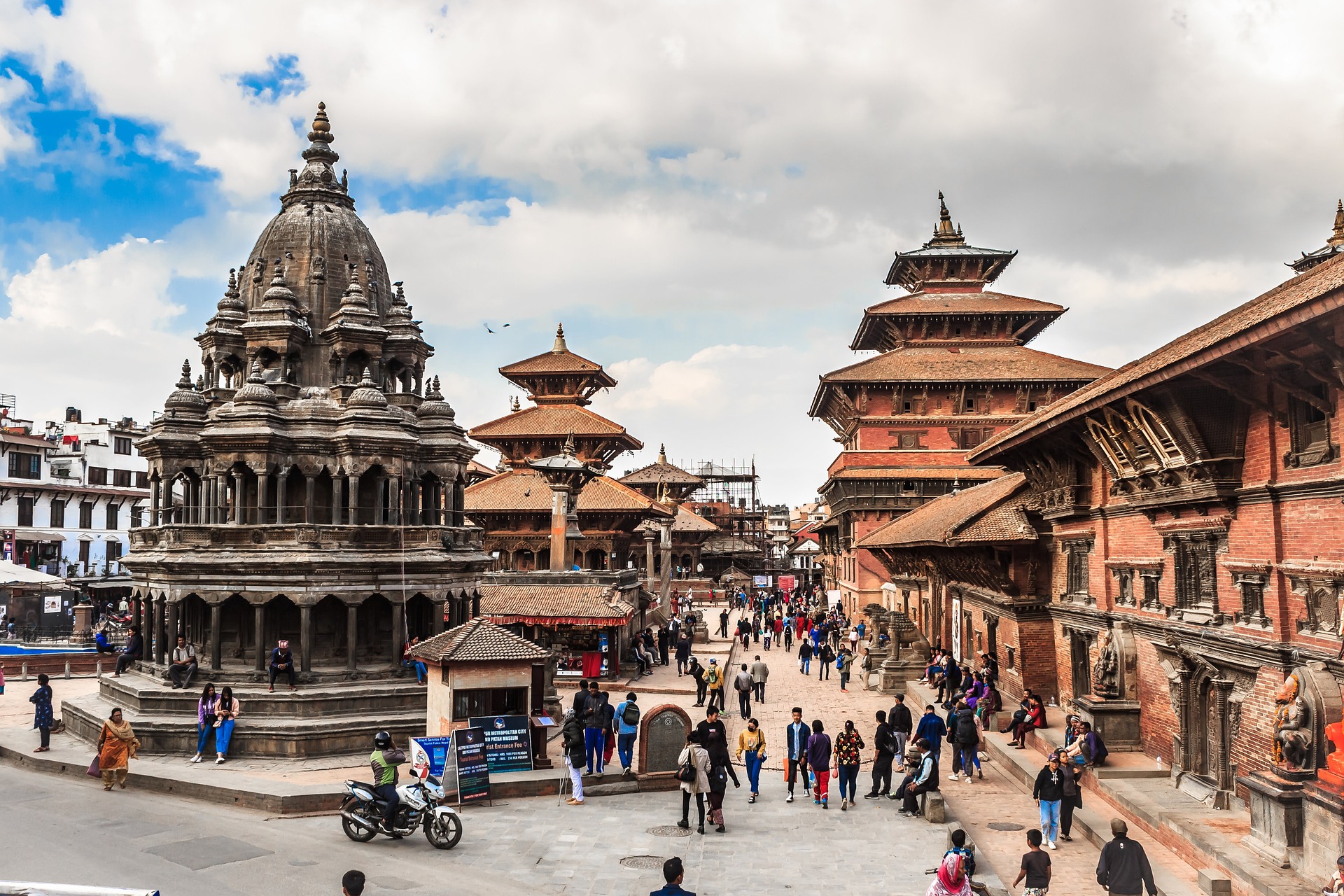
Day 3: Drive to Syabrubesi
Leaving early in the morning, you embark upon a seven-hour drive to Syabrubesi at the bottom of the Langtang Valley, the valley of glaciers. The second half is unpaved and the drive becomes quite rough. You might share a bus with goats and chickens. Sometimes, during the rainy season, the road is blocked by landslides.
The route is dazzling, passing through high ridges and with a marvellous panorama of the Himalayas that includes the Annapurnas, Ganesh Himal, Manaslu and the peaks of the Langtang range. There are many waterfalls and wild bee hives. You could also potentially see yellow-throated martins, Himalayan black bears or red pandas, which are endangered. There will certainly be no shortage of monkeys.
Day 4: Trek across the Bhote Kosi
Here, the trek begins properly. The trail takes you across the Bhote Kosi, which emanates from Tibet and lies in a deep gorge. You then climb through sub-tropical forests that teem with bird life, connecting to the trail from Syabru. One of these birds is the danphe, which is a colourful bird and the national bird of Nepal.
You will follow the river, ascending through uninhabited forests of oak and rhododendron, catching sight of langur monkeys if fortune smiles upon you. Vegetation becomes sparser as you go. You will camp overnight in a forest.
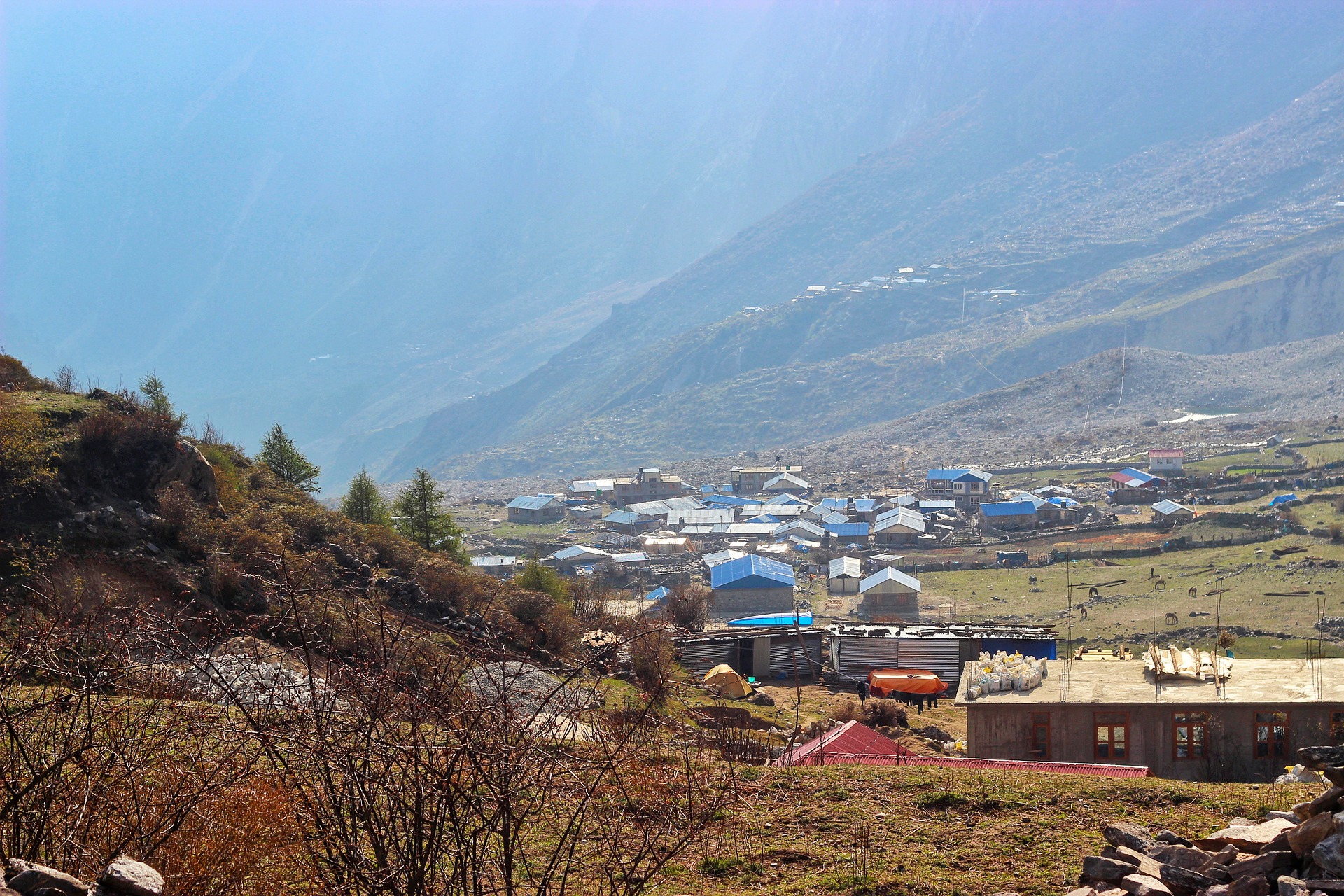
Day 5: Trek to Langtang
This day sees more climbing, with the occasional glimpse of Langtang Lirung visible through the trees. The trail leaves the forest at Ghora Tabela, now a Nepalese army post. The trail climbs comfortably, and the valley grows wider.
In summer, you will pass the temporary settlements of herders whose livestock grazes here. There are numerous chortens and mani walls, structures featuring inscriptions. In Tintin in Tibet , Captain Haddock was informed that you should always walk to the left of a chorten or demons will be released, but this was an invention of the author, so there is no cause for worry.
Shortly before the village of Langtang, there is a monastery for your delectation. The village is the headquarters of the Langtang National Park, which opened in 1976, the first in the Himalayas and the most unspoiled in Nepal. Houses there are of Tibetan style, with flat roofs and surrounded by stone walls.
Day 6: Trek to Kyangjin and onward
You will climb slowly through small villages and yak pastures. The valley opens, allowing for even better views. Having crossed a few small streams and moraines (patches of dirt or rock), before lunchtime, the trail arrives at the settlement of Kyangjin.
Here, there are facilities for the production of spiritual fulfilment and cheese: a small monastery and a famous government-owned factory. The factory makes Swiss cheese from yak milk and is supported by the Swiss government. Really, it should be called nak milk, as that is the female. This is just a small, three-roomed building, but it churns out prodigious quantities of cheese in summer. The snow-covered peaks in every direction make this spot very dramatic and beautiful.
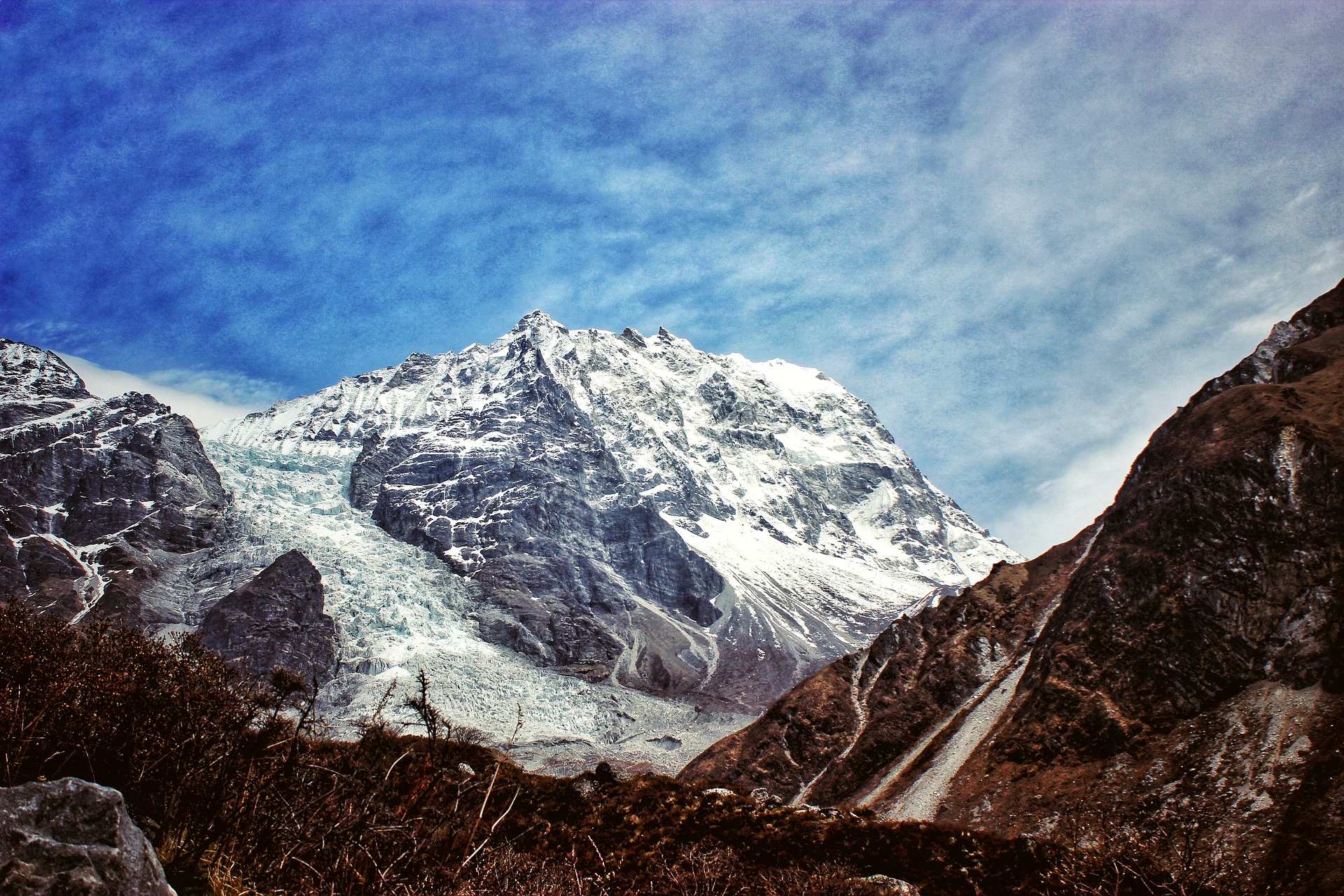
Day 7: Acclimatisation Day
This is a rest day which you will probably use to explore. The glaciers of Langtang Lirung are sensational. You could even summit Kyangjin Ri (14,209 feet), known locally as Brana Chumbo, which is immediately behind the village and provides a breathtaking 360-degree view of the Langtang peaks.
Day 8: Retrace route to Langtang
You will retrace your route towards Langtang village. The trail heads is down hill through forest following the river. You pass through ethnic Tamang settlements who strictly follow religious and cultural practices similar to that of the Tibetans.
Day 9: Return to Syabrubesi
You will continue the return journey, finishing at Syabrubesi. This is roughly a 5-hour walk and the easy trail goes mostly downhill through lush green vegetation.
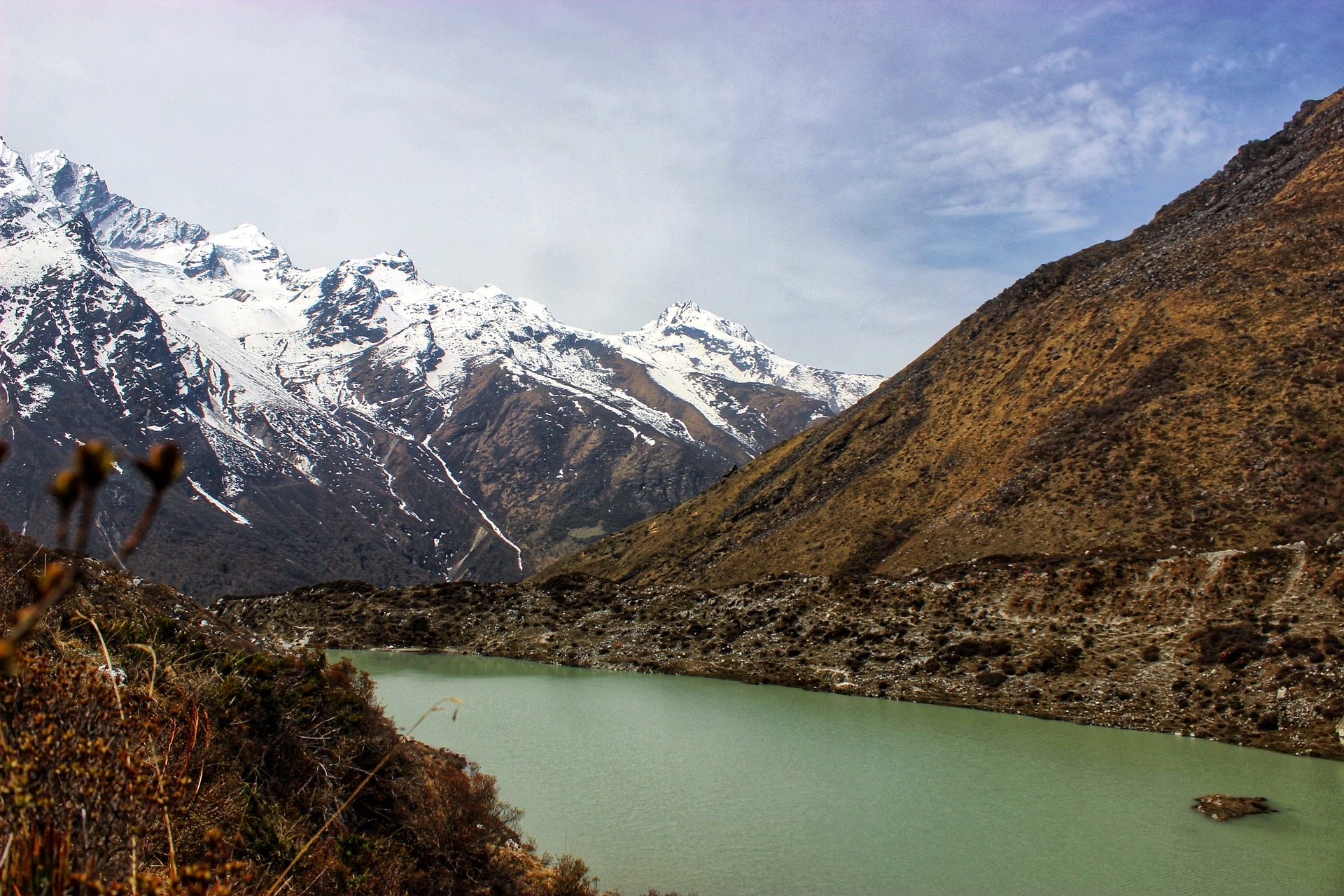
Langtang Valley Trek FAQ
How much does the langtang valley trek cost.
Costs for the Langtang Valley trek range from $1000 on the low-end to $2,000 on the top-end. Check out our list of the best trekking companies in Nepal .
Are permits required for the Langtang Valley trek?
You don't need a permit for the Langtang Valley Trek. However, you must be registered with the Trekkers Information Management system (TIMS for short) in order to do the trek. An entry fee of $30 is charged by the Langang National Park.
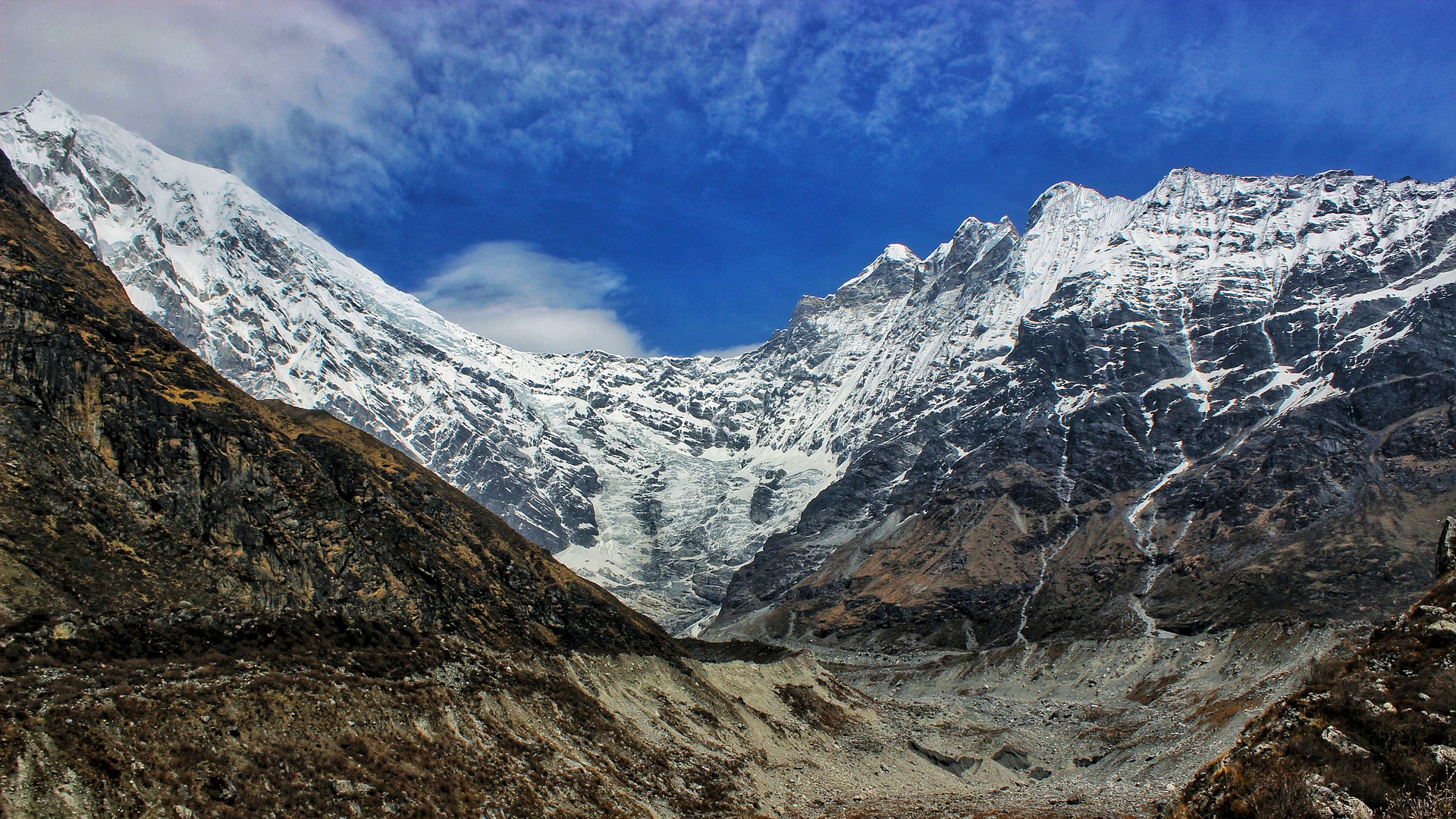
When is the best time to trek the Langtang Valley?
The best time to trek the Langtang Valley is Autumn, from mid-September to mid-December, and Spring, from March to May. These are considered the best seasons to hike in Nepal . when the sun is out during the day, but the nights are cold. Winter is also a possibility, if you don’t mind the cold.
Is altitude sickness a risk on the Langtang Valley trek?
Yes, altitude sickness is a risk because the Langtang Valley trek ascends to some high-altitude points. At its highest point, Tserko Ri, you will reach an altitude of 5,000 meters (16,347 feet). There are steep section on this trek where you will ascend fairly quickly.
Because of this, it is important to have a good understanding of the risks associated with high altitude trekking and how the body acclimatises to high altitude. We recommend you read our detailed article on Altitude Sickness and Acclimatisation .
How difficult is the Langtang Valley trek?
The Langtang Valley Trek is considered to be of moderate difficulty. There are steep sections that require a good level of fitness; however, the trek is relatively short and most people with a good attitude and high level of determination should be okay.
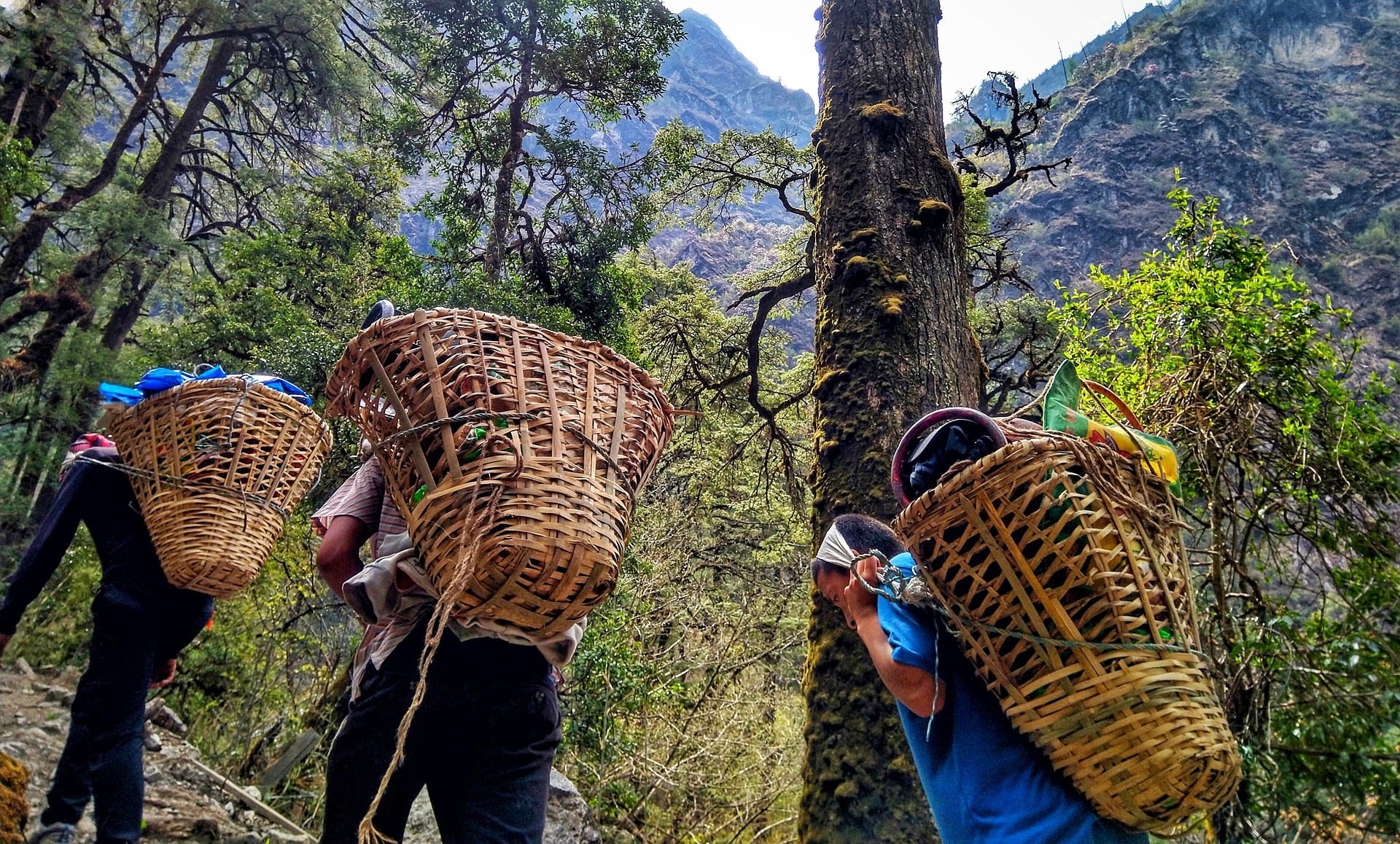
What gear do I need for the Langtang Valley trek?
Trekking the Langtang Valley requires a number of essential pieces of trekking gear and equipment. It is a long and moderately difficult trek, exposing you to a range of altitudes where temperatures fluctuate dramatically between night and day.
Much of your gear can be rented or bought in Kathmandu, but we strongly suggest bringing the most important pieces of gear and equipment with you.
To help you plan and prepare for your trek, we recommend reading our hiking packing list . Also, dont forget to take out good travel insurance for Nepal .
Are there any recommended guidebooks for the Langtang Valley trek?
Yes, there are several recommended guidebooks for the Langtang Valley trek. The Langtang Valley trek appears in many guidebooks which you use before and during your trip.
We highly recommend A Trekking Guide to Langtang: Gosainkund, Helambu and Tamang Heritage Trail by Sian Pritchard-Jones and Bob Gibbons. If this guidebook isn’t available, then Trekking the Tamang Heritage Trail of Nepal by Alonzo Lucius Lyons is very good too.
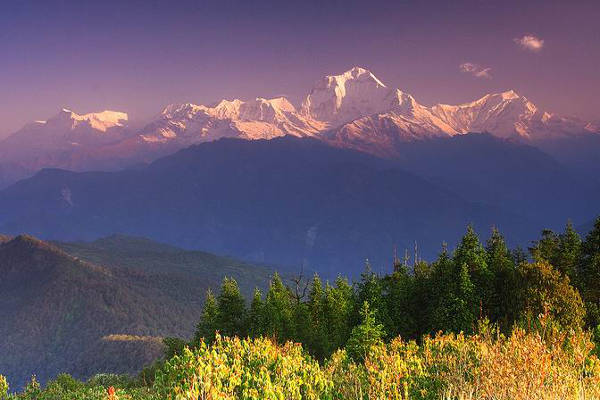
Continue browsing
See more information on Nepal . Or check out these other Nepal hiking articles:
- Short Nepal Trails
- Kala Patthar Trek
- Annapurna Circuit Hike
- Everest Base Camp Trek
- Trekking the Khumbu Valley
- Island Peak Hiking Guide
- Hiking to Rara Lake
- Limi Valley Trek
- Rolwaling Trekking Guide
- Panchase Hike
- Dhaulagiri Circuit Trek
- Trekking the Jomsom Muktinath
- Hiking to Kanchenjunga Base Camp
- Mera Peak Trek
- Helambu Hiking Trail
- Mustang Circuit Trek
- Gokyo Lakes Hike
- Trekking to Makalu Base Camp
- Gosainkunda Trek
- Ghorepani Poon Hill Trek
- The Royal Trek
About the author
Mark Whitman
Mark has trekked extensively in Asia, Europe, South America and Africa. He founded Mountain IQ in 2014 with the sole aim to be the best online information portal to some of the most popular mountain destinations around the world. When not writing for Mountain IQ, Mark is out exploring the outdoors with his wife!
Leave a Reply
Your email address will not be published. Required fields are marked
We work with local guides to offer great value adventures at unbeatable prices
- Skip to content
- Skip to primary sidebar
Full Time Explorer
Nepal Travel Blog
Langtang Valley Trek Itinerary: 5, 6, 7 & 8 Days
Nepal Itinerary , Trekking in Nepal / February 18, 2022 by fulltimeexplorer / 6 Comments
The Langtang Valley Trek is a trekking route located north of Kathmandu and south of Tibet. It passes through Langtang National Park and typically takes seven or eight days of which two are spent in a jeep. My husband and I are avid trekkers, but we like to take our time and enjoy ourselves, so we opted for the eight day itinerary. I thought it was hard enough to be interesting, but not so hard that we wanted to give up. Here’s everything you need to know when planning your Langtang Valley Trek itinerary.
Langtang Valley Trek Map
Note: This map should not be used for navigational purposes. It is just meant to give an idea of the route and is not perfectly to scale. Download maps.me on your phone for an accurate offline map that is free to use.
Langtang Trek Overview
Trek duration.
This trek takes between 5 and 8 days, however I would not recommend the 5 and 6 day itinerary as it’s extremely difficult.
Langtang Valley Difficulty Level
We did an 8 day itinerary, and I found this trek to be difficult, but not so hard that we wanted to give up. We had trekkers of all different levels in our group, and everyone completed the trek and had a fantastic time.
Required Permits
A Langtang National Park permit is required for foreigners. It costs 3,000 rupees (about $26 USD)
Trek History
The Langtang Valley has a long history. Some of the buildings along the trekking route are rumored to be 200 to 300 years old! In more recent years, it became infamous for the 2015 earthquake which hit the area hard.
Trekking began in this region around 30-35 years ago (circa 1985) when expeditions and tourists started camping in the area. Over time, the route developed and evolved into a well-worn path offering tea houses and lodging.
Best Time to do the Langtang Valley Trek
It’s best to do this trek in October or November since that is when the views are the best. March and April are the second best time since you’ll still get good views, and the flowers will be in bloom. It is extremely dangerous to do this trek in monsoon season due to landslides.
Langtang Valley Trek Altitude
Kyanjin Gompa Altitude – 3,830 m (12,565 ft)
Kyanjin Ri Altitude – 4,400 m (14,435 ft) There are a few different stopping points along the Kyanjin ridge and they have different altitudes. Some tour companies say it is 4,700 m at the highest point, our maps didn’t specify and locals said it’s 4,600 m.
Tsergo Ri Altitude – 4,984 m (16,351 ft)
Langtang Valley Trail Info
The trail for Langtang is well worn. The path is easy to spot, and it’s well maintained. Locals use the route to get from village to village and they take good care of it. Some of it is dirt trails and other parts are stone that has been laid out. Some of the terrain is steep with cutback turns which make it easier to climb.
Navigating the Langtang Valley Trek
It’s easy to navigate this trek, but I do recommend new trekkers to have a guide with them. Weather can change quickly in the mountains and that can be dangerous. If it began to snow and the easy to see trail suddenly disappeared, would you be able to find your way to the next village?
Those with more experience can download maps.me for an offline map of the area. We made everyone in our group download it in case anyone got lost since we all walk at different speeds.
Packing List
I have a separate post for my packing list as it was too much to include here. Read this blog post for a list of everything I carried with me…
Langtang Valley Trekking Gear List
I’ve written an entire post breaking down what we spent on the trek. You can read it here…
Langtang Trek Cost
Langtang Valley Trek Itinerary Options
Langtang valley trek 5 days.
I highly discourage people from following this route. It involves long days, and high jumps in altitude that will likely result in altitude sickness. This would not be a fun or relaxing itinerary. If you are in peak physical shape and are acclimated to the altitude, then you might be able to follow this itinerary. As someone who treks in Nepal several times a year, I would not even attempt this.
Day 1 – Drive from Kathmandu to Syabrubesi, then walk to Rimche (8 hours driving time, 5 hours walking time)
Day 2 – Walk from Rimche to Langtang Village (7 hours walking time)
Day 3 – Walk from Langtang Village to Kyanjin Gompa (4 hours walking time)
Day 4 – Option to climb Kyanjin Ri, then return to Rimche (9 hours walking time)
Day 5 – Walk from Rimche to Syabrubesi, then drive to Kathmandu (2.5 hours walking time, 8 hours driving time)
Langtang Valley Trek 6 Days
The six day itinerary is a little more manageable than the five day itinerary, but I still wouldn’t recommend it. Climbing Kyanjin Ri and then descending to Rimche is a long exhausting day with 9 hours of walking (not including breakfast and lunch breaks). If you are walking slowly, you may end up walking at night. This is a tough itinerary and you should only do it if you’re in great physical shape.
Day 1 – Drive from Kathmandu to Syabrubesi (8 hour drive)
Day 2 – Trek from Syabrubesi to Lama Hotel (5 hours and 30 minutes walking time)
Day 3 – Trek from Lama Hotel to Langtang Village (6 hours walking time)
Day 4 – Trek from Langtang Village to Kyanjin Gompa (3 hours and 15 minutes walking time)
Day 5 – Option to climb Kyanjin Ri, then return to Rimche (9 hours walking time)
Day 6 – Walk from Rimche to Syabrubesi, then drive to Kathmandu (2.5 hours walking time, 8 hours driving time)
Langtang Valley Trek 7 Days
The seven and eight day itineraries are the most popular for the Langtang Valley Trek. These are enjoyable options which allow you not to rush or have hours of walking with no end in sight. I find that the enjoyment level ends around five hours of walking, and I lose interest in walking any further at around six hours. That’s my own physical limits and I keep that in mind when planning. These routes allow you to finish each day without wanting to give up.
Day 5 – Sunrise trek to Kyanjin Ri, then trek back to Lama Hotel (8 hours walking time)
Day 6 – Trek from Lama Hotel to Syabrubesi (7 hours walking time via Sherpagaon)
Day 7 – Drive from Syabrubesi to Kathmandu (8 hours driving time)
Langtang Valley Trek 8 Days
We opted for the eight day route. For one, we weren’t in a rush. Two, we had some first time trekkers with us and wanted it to be enjoyable. Three, I prefer to spend two nights in the highest village rather than try to combine a sunrise hike and descent to a lower village in the same day. Some of our group was eager to descend until they saw how beautiful Kyanjin Gompa is. After that, everyone was more than happy to have a “relaxing” day there. Mind you, we still did some difficult treks that day. If you plan to do Tsergo Ri, this is the best option as you need a full day to get there and back to Kyanjin Gompa.
Day 5 – Sunrise trek to Kyanjin Ri or Tsergo Ri (2-9 hours walking time depending on the route you choose. We did Kyanjin Ri I, II, and III and took 5 hours including long photo breaks and a snack)
Day 6 – Trek from Kyanjin Gompa to Lama Hotel (6 hours walking time)
Day 7 – Trek from Lama Hotel to Syabrubesi (7 hours walking time via Sherpagaon)
Day 8 – Drive from Syabrubesi to Kathmandu (8 hours driving time)
Detailed Itinerary Breakdown (8 days)
Day 1 – drive from kathmandu to syabrubesi.
Kathmandu Altitude: 1,400 m (4,593 ft)
Syabrubesi Altitude: 1,503 m (4,931 ft)
Daily Altitude Increase: 103 m (338 ft)
Oxygen Concentration: 84% compared to 100% at sea level
Driving Time: 8 hours (with stops for lunch)
Tea house: Hotel Malla & Restaurant – This hotel was okay, I would probably try a different place the next time I’m in town. It wasn’t bad, but it wasn’t good either.
The drive from Kathmandu to Syabrubesi is long and exhausting. We hired a private vehicle which made the trip more enjoyable and a lot safer than taking the bus. Some parts of the road are in bad shape and are extremely bumpy. The road is narrow and winds around blind turns. If you get motion sickness, you’ll want to take medicine ahead of time and have a plastic bag handy. We decided not to walk this day as it’s easier just to get out of the car and chill out after such a long drive.
Day 2 – Syabrubesi to Lama Hotel
Lama Hotel Altitude: 2,480 m (8,136 ft)
Daily Altitude Increase: 977 m (3,205 ft)
Oxygen Concentration: 75% compared to 100% at sea level
Walking Time: 5 hours and 30 minutes (not including lunch or tea breaks)
Distance: 10.9 km (6.8 miles) walking distance
Difficulty Level: Difficult
Tea houses: There are several tea houses on the way where you can stop for breaks. We ate lunch in Pairo at the Namaste Hotel International Bakery & Cafe. We stayed at Hotel Jungle View in Lama Hotel.
There were some minor landslides that blocked the old trekking path on our first day, so we had to follow a road for the first two hours. Usually, you can avoid the road as soon as you leave Syabrubesi. The road that leads to the trekking trail goes up and down a lot more than the old walking route, plus it was in the direct sun making it more tiring than the trail. After leaving the road, we had to cross a suspension bridge. The sides of the bridge had broken, and they were lying flat. This was an unusual thing because it gave the sensation that you were tipping over when crossing it which made it terrifying even though it wasn’t tipping over.
We ate lunch in Pairo at the Namaste Hotel International Bakery & Cafe. The food here was delicious, and the tea house had a beautiful view. Between Pairo and Bamboo, the trail is a gorgeous dirt trail weaving through the jungle. The path goes up and down a lot, but it’s not too steep. It’s an enjoyable walk with views of the river and waterfalls coming down from the hills.
After Bamboo, the path gets steeper and becomes more difficult. Although tiring, it’s a beautiful walk. Before Rimche, the trail becomes even steeper and passes over a large landslide. From here, our whole group began to struggle, even those in good physical shape. The trail is stone and dirt with some steep steps that are hard to get up. The last 20 minutes or so of the trek is a nice gentle path with few ups and downs leading to Lama Hotel. We ended up arriving in the rain when it was almost dark.
Pro Tip: Leave early. We left a little lazily at 8:20 due to having a large group at our hotel who woke us up at the crack of dawn. We were groggy in the morning and tried to sleep in. We didn’t get walking until 8:30 am which is late. We should have been on the move by 7:30 am. We took a lot of tea breaks to make sure the whole group was okay and not far behind, and lunch usually takes an hour and a half (they cook everything when you order it). So, we ended up arriving when it was starting to get dark which is not ideal or safe.
Day 3 – Lama Hotel to Langtang Village
Langtang Village Altitude: 3,430 m (11,253 ft)
Daily Altitude Increase: 950 m (3,116 ft)
Oxygen Concentration: 67% compared to 100% at sea level
Walking Time: 6 hours (not including lunch or tea breaks)
Distance: 11.7 km (7.3 miles) walking distance
Tea houses: There are tea houses on the way for breaks. We ate lunch at Lovely Guest House in Ghodatabela. We slept in Hotel Samsara in Langtang Village.
The beginning of day three starts off easy with an enjoyable walk through the woods. The path is a combination of stone and dirt. The stone was a bit slippery and uneven. It was difficult for new trekkers, but was easy for those with confidence in their footing. About 1/2 hour into the trek, there are gorgeous views of the Langtang mountain range.
We stopped for tea in Riverside. After tea, there were some steep areas that were a bit more difficult, but the last half hour of the walk was almost flat. It’s a gorgeous walk along the river. We stopped in Ghodatabela for lunch at the Lovely View Guest House. The food here was fantastic and fresh.
After lunch, there is one large steep uphill followed by some mild uphills. The greenery starts to fade and the valley opens up. The air starts to get a little thinner, so the small inclines feel more difficult. In this section, you’ll pass the giant landslide that took out the entire Langtang Village in 2015. Seeing it in person is hard to explain. It’s as if a giant chunk of land just disappeared. We decided to walk towards the end of the new Langtang Village to stay in Samsara Guest House which was recommended to us. The food there was surprisingly good considering how less vegetables grow at this altitude. It was one of the best meals on the entire trek.
Day 4 – Langtang Village to Kyanjin Gompa
Kyanjin Gompa Altitude: 3,830 m (12,565 ft)
Daily Altitude Increase: 400 m (1,312 ft)
Oxygen Concentration: 64% compared to 100% at sea level
Walking Time: 3 hours and 15 minutes (not including lunch or tea breaks)
Distance: 6.4 km (4 miles) walking distance
Difficulty Level: Moderate (due to the altitude)
Tea houses: There are plenty of tea houses to stop at along the way. We ate lunch in Kyanjin Ri at our hotel. We stayed at Panorama View which had clean rooms, an attached bathroom, and hot water for showers. We also visited and ate at Nayakhanga Peak Guest House which was equally as nice and had great food.
Day four is a gorgeous day with incredible views of the Langtang Valley. The path here has some mild inclines which feel difficult due to the altitude and thin air. Overall, I’d consider this an easy day if it were easier to breathe. We moved slowly to avoid altitude sickness and took tons of breaks to watch the yak roaming free and to take photos. There were lots of baby yaks when we passed through, so it was fun to watch them playing with each other. This is definitely the most enjoyable day of the trek. If you still have energy when you arrive, you can go see the Kyanjin Yak Cheese Factory and the 200-300 year old Gompa.
Day 5 – Sunrise trek to Kyanjin Ri (or Tsergo Ri)
Kyanjin Ri Altitude: 4,400 m (14,435 ft) – 4,700 m (15,419 ft) depending on where you stand on the ridge.
Tsergo Ri Altitude: 4,984 m (16,351 ft)
Daily Altitude Increase: You sleep at the same altitude as the night before.
Oxygen Concentration: 55% (at Tsergo Ri) compared to 100% at sea level
Walking Time: 5 hours walking time for Kyanjin Ri I, II, and III with breaks. 9 hours walking time for Tsergo Ri with breaks.
Difficulty Level: Very difficult
Tea house: There are no tea houses on the way to Kyanjin Ri or Tsergo Ri, so it’s best to pack whatever food you need. For Kyanjin Ri, we packed a chapati and slices of yak cheese for a snack. Those going to Tsergo Ri may want to pack a larger lunch.
The trek to Kyanjin Ri is difficult due to the steepness of the hill and the high altitude. With the air being thin, it’s extremely hard to breathe and catch your breath. There were times I needed to stop and sit because my heart was pounding so much. It’s important to move slowly and try not to get out of breath. A slow steady pace is best. It took us a little over two hours (walking time) to Kyanjin Ri III, then down to Kyanjin Ri II, down to Kyanjin Ri I, and back to the tea house in Kyanjin. However, we took tons of breaks for photos and sat down and ate our snack so we took about five hours total. We probably stopped at each of the viewpoints for a half hour. It was a beautiful warm day and we planned to stay in Kyanjin Ri that night so there was no rush.
Pro Tip: You should try to be back to the tea house by 11am because the valley is very windy and that can make walking even harder (and dangerous in some areas). We came down around 11:00 am and the wind was hitting my face so hard that it was painful. I do recommend trekking poles as the way down is very steep and slippery. If you have knee or ankle problems, wear a knee/ankle brace.
Later in the day, we walked to “7 Lakes” which is more like “7 Ponds.” A few of our group didn’t make it to Kyanjin Ri and wanted to do a day trek. This is an easy route with very few hills. 7 Lakes took us about 2 hours round trip. If you go in the morning when there’s no wind, you can get some nice photos of the mountains reflecting in the water.
Day 6 – Kyanjin Gompa to Lama Hotel
Daily Altitude Increase: – 1,350m ( -4,429 ft)
Oxygen Concentration: 75% compared to 100% at sea level
Distance: 17.7 km (11 miles) walking distance
Difficulty Level: Easy – Moderate
Tea house: There are plenty of tea houses to stop in for breaks. We ate lunch in Ghodatable at Lovely Guest House. We slept in Hotel Jungle View in Lama Hotel.
Day six was surprisingly easy. We were told it was a long walk and would take 7-8 hours. Since we’d been walking slowly the whole trip, we decided to cut down on breaks and move a little quicker to avoid arriving in the dark. During the flat sections, we had a nice power walk going which was easy to maintain. In the steep sections, we took our time and went slow. The walk ended up being really enjoyable. We arrived at Lama Hotel just before 4pm and all of us agreed it was a much easier walk than we had mentally prepared for. My knees hurt a little by the end of the day, but overall it wasn’t too bad. We ended up making it in six hours.
Day 7 – Lama Hotel to Syabrubesi (via Sherpagaon)
Daily Altitude Increase: – 977 m ( -3,205 ft)
Walking Time: 7 hours (not including lunch or tea breaks) via Sherpagoan
Distance: 11.26 km (7.9 miles) walking distance
Tea house: There are teahouses in Sherpagoan and Khangjim for tea breaks. We ate lunch in Super View Guest House and the food was phenomenal. It was the best food we’d had in days. We ended up staying in Khangjim instead of Syabrubesi. We stayed at Mother’s Home.
We took off late due to a misunderstanding about when we wanted breakfast. We didn’t hit the trail till 9:40am which was more than an hour behind schedule. So, we did a trail run to Rimche. After Rimche, we decided to take the route that goes through Sherpagoan. The route was beautiful, but it was tough. There were steep up and down hills which we weren’t expecting. It also ran along a cliff and would not be a good choice for those afraid of heights. If it weren’t for a giant blister on the bottom of my foot, I would have enjoyed this section as it was much prettier than the route we walked on day two.
We had lunch in Sherpagoan at Super View Guest House. The food was amazing and it was the first time we got so many vegetables since we started the trek. After lunch, it was a steep downhill all the way to the village of Khangjim. Walking through the villages was gorgeous. We were surrounded by wheat fields set in front of giant green rolling hills. The village had old stone buildings lining the pathways. Because of the late start and my blister, we didn’t arrive till 4:15 pm.
Day seven was difficult for me because of the massive blister on the bottom of my toes. Going uphill was manageable, but the steep downhills caused me a lot of pain. I ended up hobbling into the village of Khangjim almost in tears from walking on it for seven hours. So, we opted to stay there the night instead of walking another hour and a half to Syabrubesi. We arranged for a jeep to pick us up which cost more, and the road was a little scary, so I’d recommend walking if you can.
Day 8 – Drive from Syabrubesi to Kathmandu
K athmandu Altitude: 1,400 m (4,593 ft)
Daily Altitude Increase: – 103 m ( -337 ft)
Oxygen Concentration: 85% compared to 100% at sea level
Driving Time: 8 hours (with stops for lunch)
We ended up hiring a jeep from Khangjim which I wouldn’t recommend. The road was bad and the brakes on our jeep broke on the way up. We had to wait hours for a temporary fix which, no joke, involved a condom. Then it was a slow ride down to Syabrubesi where we had to wait another two hours for a proper replacement part to be put in (because let’s be honest, a condom is not an ideal car part). After all that, we didn’t get on the road till after 1pm. We ended up driving back to Kathmandu in the dark which is not as safe since the roads are not well paved in sections. It was a long and tiring day and we didn’t get home till almost 9:00 pm.
Langtang Valley Village Guides
Syabrubesi Village Guide
Lama Hotel Village Guide
Langtang Village Guide
Kyanjin Gompa Village Guide
You might also like…
Michelle della giovanna.
Writer at Full Time Explorer
I’m just your average New Yorker who quit her job in the fashion industry to explore the world. Come find out what it’s like to trade in five-inch heels for squat toilets.
- Visit Twitter account (opens in a new tab)
- Visit Facebook account (opens in a new tab)
- Visit Instagram account (opens in a new tab)
- Visit Pinterest account (opens in a new tab)
This website uses affiliate links. This means that I may receive a small commission (at no extra cost to you ) if you purchase something through these links. I only link to products and companies that I love. Those companies, in return, reward me for connecting them to you .
Full Time Explorer LLC is a participant in the Amazon Services LLC Associates Program, an affiliate advertising program designed to provide a means for sites to earn advertising fees by advertising and linking to Amazon.com.
Reader Interactions
December 14, 2022 at 9:31 pm
I happened to land on your blog and find it very helpful. Your easy & engaging style of writing makes it joyful to read it. And all the excitement and pain you felt during your treks comes through that!
I’m planning to do a solo Langtang Valley trek in March-April, and will be visiting this blog multiple times. Thanks for writing and maintaining this site.
December 14, 2022 at 11:55 pm
Thank you so much! Have a wonderful trip. Langtang is a gorgeous area… you’ll love it!
September 5, 2023 at 10:36 pm
Hello! Do you recommend hiring a porter and guide online or when I land? I am planning a trip April 2024
September 7, 2023 at 4:19 am
Hello MJ, Since it’s peak season in April, I would personally do it a month or two in advance. I’ve found that in peak season, if you wait till the last minute to book, you will find someone, but it’s likely they aren’t as experienced or there might be a reason they haven’t been booked yet.
October 31, 2023 at 6:20 pm
Greetings! I read in great detail your blog posts about trekking in the Langtang Valley. I just booked a very last minute trip (leave in four days), and am feverishly searching for guide recommendations. Your posts were so well written and thoughtful I though you may have some tips regarding booking at guide at the last minute. I’d prefer to hire a private guide, but can of course join a group if needed. I imagine a group would cut down on potential jeep costs. Many thanks!!!
November 1, 2023 at 11:06 am
Hello! I sent you an email, but wanted to write it here as well. We recommend Karma who is a guide who lives in the Langtang Valley and knows the area well. His phone number is +977 9808753202. Have an amazing trip!
Leave a Reply Cancel reply
Your email address will not be published. Required fields are marked *
For quick Inquiry: +977 98510 42334
- Everest Base Camp Trek
- Annapurna Base Camp Trek
- Upper Dolpo Trek
- Manaslu Circuit Trek
- Kanchenjunga Circuit Trek
- Langtang Valley Trek
- Ruby Valley Trek
- Makalu Sherpani Col Pass trek
- Everest Khumbu Treks
- Annapurna Treks
- Ganesh Himal & Manaslu Treks
- Dolpo Treks
- Dhaulagiri Treks
- Humla Simikot Treks
- Kanchenjunga Treks
- Langtang & Helambu Treks
- Rara Mugu & Jumla Treks
- Less Touristic Trekking Destination
- Nepal Package Tours
- Day Hike Around In Kathmandu
- Nepal Bhutan Tours
- Nepal Tibet Tours
- Nepal India Tours
- Nepal Bhutan India Tours
- Nepal Bhutan Tibet Tours
- Adventure Sports
- Trekking and Walking
- Peak Climbing in Nepal
- Homestay Trips
- Rafting & Kayaking
- Cultural & Religious Tours
- Mountain Expedition
- Online Payment
Langtang Trek Itinerary, Guide, and Cost - 11 Days
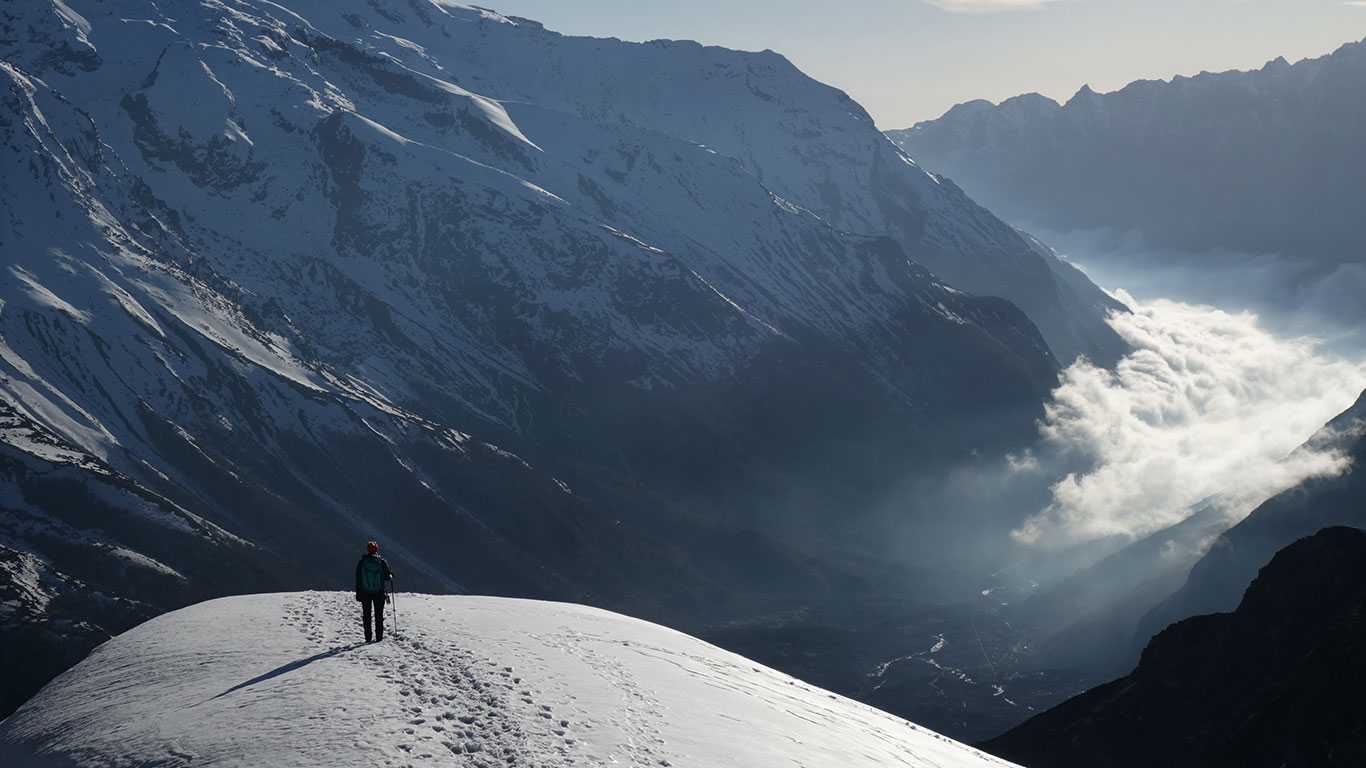
Trip Duration

Max Altitude
Tsergo Ri 5000 m

Trip Ends At
Langtang trek itinerary, guide, and cost overview.
Langtang Valley Trek is a short and moderate-level trekking journey that runs through the beautiful Langtang Region. Langtang Valley Trek 11 days is also one of the most favorite and classic trekking journeys alongside the Everest and Annapurna region’s treks. But when compared to those well-known competitors, it is still something of a hidden gem.
The Langtang Valley is also conveniently located just a few kilometers north of Kathmandu and south of the Tibetan border surrounded by beautiful peaks of great appeal. The valley is also referred to as the valley of glaciers with some magnificent mountains in its surroundings; Langtang Lirung (7,246 m) lies to the north, Gang Chhenpo (6,388 m) & Naya Kanga Ri (5,846 m) lies to the south and Dorjee Lakpa (6,966 m) at the east.
Langtang Valley Trek offers stunning landscape views of two major Himalayan series - Langtang, and Ganesh Himal along with diverse flora and fauna & miscellaneous culture of diverse indigenous groups. You will encounter indigenous Tamang and Sherpa communities when you come across numerous ethnic villages en route. These welcoming villagers will enthusiastically expose you to their culture, which is heavily influenced by Tibetan Buddhism, which thrives here in the Himalayas.
Our 11-day Langtang Valley Trek’s pathways start from Syabrubesi which is a day-long drive from the capital and takes you through a surreal world of mountains, glaciers, forests, and rivers. A week-long trek in the Langtang National Park through the lush forests, tropical lowland jungles, and cold high-altitude glaciers offers you spectacular views of Langtang Lirung (7246m), Kimshung (6781m), and Langshisha Ri (6370m) in Kyangjin Gompa. Also, there are chances of observing elusive wildlife such as musk deer, Himalayan tahr, or red panda wandering through the dense woodland cover of the national park. As we go from the tropical lowlands to the alpine heights of the Langtang Valley, keen-eyed hikers may even spot indications of the extremely rare snow leopard.
As a whole, the 11 Days Langtang Valley Trek Itinerary is a short, classic, and lesser-known trail that is ideal for those looking for a true Himalayan trip in a short length of time, that gives a taste of Nepalese trekking and is non-crowded even during the peak trekking season.
Note: Our 11 Days Langtang Valley Trek Itinerary includes a side trek to the Kyanjin Ri (4773)/ Tserko Ri (5450m)/ Langshisa Kharka (4100m) on the 7th day which makes the highlight of this trip. As per the day’s weather conditions, trekkers’ interests, and conditions, we could make one of these three viewpoints that day’s destination.
Out of these three, Kyanjin Ri is the most popular, Langshisha Kharka is the easiest, and Tserko Ri is the least popular and most difficult one. Popular or not, difficult or not, all these three wilderness side treks equally provide 360-degree views of the Himalayas, Kyanjin Village, numerous glaciers, yak pasture, and a wide bank of the Langtang River.
Highlights of Langtang Valley Trek
- Experience the difference between the busy city and once isolated region from this Langtang Valley Trek
- Trek through the wilderness of the Langtang region with the subtropical jungle to the alpine Rhododendron forest
- Trekking experience in the Valley of Glaciers aka Langtang Valley
- Deep gorges & rivers as well as terraced meadows
- Walk through the lush green forest filled with Rhododendron and other wildflowers
- Chance to spot some endangered wildlife species such as Red Panda, Langur Monkeys, etc.
- Marvelous views of snowy peaks like Dorje Lakpa, Langtang Ri & Langtang Lirung
- Visit different monasteries & a yak cheese factory
- Unique Culture and Traditions of Tamang & Tibetan
Difficulty Level of Langtang Valley Trek
Langtang Valley Trek is a moderate trekking journey that requires 6-7 hours of average walks per day for 8-9 days. This trekking does not require any previous experience and any age can complete the journey successfully if they are physically and mentally prepared.
This 11-day Langtang Valley Trek is easier than Nepal's other well-known treks, such as the Annapurna Circuit Trek, Manaslu Trek, or EBC Trek. There are no complicated trails and the trail only includes hiking uphills and downhills along a tough trail across narrow and high mountains. There are numerous teahouses and lodges along the trail, providing easy access to lodging and food. This hike necessitates ordinary physical fitness and a desire to see new locations. It is critical to exercise consistently before your expedition to make it easier. You can also go for a day hike that includes some uphill and downhill climbing. It will prepare you for the trekking trail's varied course.
The most common challenge that trekkers confront during a high-altitude journey is altitude sickness. It can happen to anyone, regardless of their age or physical condition. Even though the Langtang trip does not reach the same severe altitude as the Everest climb, altitude sickness can still occur. If you notice any of the symptoms such as a headache, Nausea, vomiting, Shortness of breath, Dizziness, Loss of appetite, Heart rate increment, Difficulty in sleeping, etc., you are suggested to inform your group and guide them immediately.
Unpredictable weather and temperature conditions add to the difficulty of the Langtang Trek. The weather and climate in the Langtang region change with the seasons. You are recommended to learn about the destination’s weather conditions before your journey so that you can get the best experience.
However, the mountainous region is not always predictable and you might face sudden challenges despite good preparations.
The best time to do Langtang Trek
Trekking in the Langtang Valley is possible in all 4 seasons. The valley takes on distinct flavors depending on the season. However, the most popular times to visit the Langtang region are in the spring (March to May), right after the freezing winter, and in the autumn (September to November), right after the rainy monsoon.
The pre-monsoon and the post-winter season- spring offers longer and warmer days with clear skies and wonderful scenery perfect for Himalayan trekking trips. The Langtang region in the spring season is filled with a colorful mix of pink, red, and white rhododendron forests. The greenery once again thrives after the dry cold winter. The trails mostly at the higher altitudes can be seen surrounded by aromatic wildflowers.
The most perfect time to explore the Langtang region is during the autumn months. Your walk is accompanied by the beautiful blue sky, breathing fresh air, and clear mountain views. The mild and consistent weather, the festive season, the outrageous vistas, and the trails in their best condition during the fall make your Langtang Trekking journey super perfect. During the peak season, the solo trekkers will encounter a large number of trekkers on the trail.
Winter is characterized by cold and harsh weather, particularly at higher elevations but it is not impossible to do the Langtang trek. Walking could be difficult due to the thick snow on the trails and the cold weather, so trekkers must come well-prepared for this season. The sky, on the other hand, is clear and rewards spectacular views of the valleys, rivers, and surely the Himalayas covered in fresh thick snow.
The monsoon season is the least pleasant for trekking in Langtang. The weather is quite unpredictable. The rain brings dampness and slickness to the trails. Insects or leeches may keep disturbing you. The intense fog can sometimes obscure vision. Other than that, you'll get to admire the rain-washed surroundings and the clearest views of the mountainscape following the rain.
- Guaranteed Satisfaction
- Transparent Price
- No hidden fees
- Experience of a More than two decade
- Personal Touch & Professional Service
US$ 1,120 P/P
Amount: US$ 1,120.00
Bank Charge(4.5%): US$ 50.40
Note: This expense includes bank charge of 4.5%

Quick Inquiry
Itinerary details.
Upon your arrival at the Kathmandu Airport, you will be greeted by one of the representatives from Himalayan Trekkers and then escort to the designated hotel. You can then rest or stroll around the surrounding streets before we head to Boudhanath Stupa. It is the biggest stupa built in Chaitya/Stupa style in the country which represents Tibetan & Local Nepalese Buddhism. It is one of the most loved destinations by both international and local visitors for its peaceful aura and religious significance.
Then we will drive to Pashupatinath Temple which is just a 15-minute drive from the stupa to join the aarti ceremony that takes place every evening. Pashupatinath is one of the most significant Hindu sites in the world which is devoted to Lord Shiva. Non-Hindus are not allowed to enter the main temple but can explore the surroundings. You can also witness the open cremation ceremony on the bank of the Bagmati River opposite the aarti ceremony.
After exploring these two UNESCO World Heritage Sites, we will return to Thamel and stroll around the streets and get a glimpse of the area.
Note: These visits are only possible if your arrival is before the afternoon.
After your breakfast, we will begin the full-day Kathmandu exploration. We will explore the remaining world heritage sites other than those that were visited on the previous day (if). If not, we will explore those landmarks and others such as Swayambhunath Temple which is widely famous as the monkey temple because the number of monkeys you see here could be your first time seeing this amount of these creatures. The temple has a history interrelated to the birth of the Kathmandu valley. The top of the hill where the white dome of Swoyambhu is located offers fantastic views of the valley and surrounding mountains.
We will then visit Bhaktapur Durbar Square and explore the surroundings. Bhaktapur is an ancient Newari town that is also called the city of devotees. The durbar square complex and its surroundings are the major attractions of this town. And some of the highlights of the durbar square are Nyatapola Temple, Golden Gate, 55 window palace, etc. There is a lot to explore in Bhaktapur.
Then we will drive to Patan and explore Patan Durbar Square. It is also an ancient Newari town known for its arts and architecture. The ancient houses and the complexes, buildings, temples, and statues in the durbar square really show wonderful craftsmanship. Pottery is also famous here. Krishna Mandir, Patan Museum, etc. are the most notable sites here.
Later in the afternoon, we leave Patan and drive back to Kathmandu and explore the Kathmandu Durbar Square. Once a royal palace is now a museum. This place is also called Hanumandhoka as you can see the statue of Hanuman, a god that resembles a monkey here. The complex also houses Kumari Ghar, the residence of the only Living Goddess, Kumari, and Kasthamandap, a temple built with a single tree’s wood.
After sightseeing, we can take a stroll around the freak street, the hub of hippies in the 90s. Then, we will take a walk to Newroad market, Indrahowk market, Ason market, and finally enter the Thamel market.
Later this day, we will have a short briefing session regarding this Langtang Valley Trek journey and you might buy your personal gear on the Thamel market.
Day 3 starts with an early morning breakfast so that we can leave early to avoid the traffic. We will leave Kathmandu behind and start the Langtang journey with a long scenic drive to a place called Syabrubesi in the Rasuwa district. As soon as we leave the hustle and bustle of Kathmandu, we can smell the fresh air and enjoy Nepal's beautiful scenery. We drive along the beautiful Trishuli River with the magnificent Himalayan views of the Annapurna, Manaslu, Ganesh Himal, and Langtang ranges.
After 3-4 hours of drive with short breaks in between, we will reach Trishuli Bazaar in the Nuwakot district where we will have a quick lunch break. Then, our drive turns right from the Bazaar to Dhunche town before we reach today’s destination, Syabrubesi. We will check in to our accommodation, rest, explore the surroundings if time permits, eat our dinner, and have a goodnight.
Finally the main theme of this journey, trekking begins starting today. We will have our breakfast, grab our belongings, and start to walk via the ridge on Syabrubesi’s main road. Soon after starting, we reach the Ghopcha Khola River and pass by terraced fields and dense forests with a variety of plant species like oaks, maple, alder, and bamboo. If we are lucky enough for the day, we might also spot some endangered species such as the red panda others such as yellow-throated martin, wild boar, langur monkey, and Himalayan black bear en route.
We will continue ascending steeply along the trail, come across a steel suspension bridge at 2000 m and cross to the north bank of the Langtang Khola and arrive at Lama Hotel. Lama Hotel isn't one hotel, but a collection of lodges and homes and our destination for the night. After we reach there, we will settle in at one of the best local lodges there for the night.
Today after breakfast, we will start early and trek alongside the river through a rich and lush environment. We get a view of beautiful Langtang Lirung and others. Then the trail goes across a log bridge and onto the meadows of Ghoda Tabela at 3000m. From here, the trail goes through the dense forest where here, you can catch a sight of Langur Monkeys and some unique local birds. Once, there was a Tibetan resettlement project here, but now it is a Nepalese army post/checkpoint where you will be registered though it has no permanent inhabitants. The route then ascends gently and reaches a wide valley where few temporary settlements can be seen.
We then continue and pass by a few traditional chortens, water mills, Mani Walls, and Prayer Wheels before arriving at Langtang Village. Langtang Village is a large scenic settlement of mostly Tamang people who follow Buddhism with flat-roofed Tibetan-style houses, encircled by stone walls surrounded by fields of buckwheat, potatoes, wheat, turnips, and barley. We will explore the village surroundings and might also have some interesting interactions with the locals.
After breakfast, we'll set out for Kyangjin Gompa, the region's most important monastery. We pass religious mounds of rocks with inscriptions etched on them, as well as water mills, prayer wheels, and chortens. We also walk through Nepal's largest mani wall, which is constructed of stone and has prayers written on it. We will spend the rest of the afternoon following the short climb exploring the Tibetan Buddhist shrine in Kyangjin Gompa and the surrounding environs, which provide us with breathtaking views of the mountains such as Dorje Larpa (6990 m), Langtang RI (6370 m), and Langtang Lirung (7245 m). We will also visit the cheese factory there and observe the procedure of making it. We dine in and call it our day.
We wake up with amazing scenery of mighty peaks and glaciers. We then head to the monastery to observe the Buddhist monks’ enchanting morning prayers and pilgrims praying. We return to our lodge, eat our breakfast, and prepare for the day. We either hike to Langshisa Kharka (4100 meters) or Tserko Ri (5450 meters) depending on the weather and your interests. Both places provide close-up views of the surrounding peaks, including Yala Peak, Langtang Ri, Langtang Lirung, Naya Kanga, and Langshisha Ri Peak. However, the path to Langshisha Kharka is less difficult than Tserko Ri.
As we say our goodbyes to the vibrant Buddhist village of Kyanjin Gompa, we will be hiking all the way back to Lama Hotel today. As we descend, we will pass by familiar yak herding towns and open alpine grasslands. After lunch at Ghoda Table, we will take some time to see any sights in Langtang village that we might have missed, such as the earthquake memorial, before setting out on the path to Lama Hotel.
We will check into the teahouse and unpack our hefty backpacks. Then it's time to relax and take in the scenery of pines and rhododendrons wafting in the mountain breeze as residents go about their daily routines.
We will start our walk back to Syabrubesi after breakfast this morning. Our routes return to Syabrubesi descending through pine forest and through Bamboo and Ramche before crossing the Bhote Khola River. Today’s trek will be easier than the previous days as it mostly involves descending. Once we check-in we will have a rest and in the evening, we sit together for dinner where we all will share experiences.
After our breakfast, we leave the Langtang Region via road to get back to Kathmandu. We will return along the same gorgeous road we took a week ago to get her. You will then check into the hotel when we reach the city and can get some well-deserved rest and leisure. This evening, spend some time exploring the city's bustling Thamel neighborhood's tourist markets.
This is how our amazing Langtang Valley Trek ends. Today after breakfast, you will be transferred to the airport 3 hours prior to your scheduled flight. If you have some leisure time before your flight, you can make the last Thamel stroll and buy get some souvenirs to take back home.
What is included / not included
- Airport Transfer on Private Vehicle
- Twin/Double Sharing Accommodations at 3* Standard Category Hotel in Kathmandu
- Daily Breakfast at Hotel in Kathmandu
- Guided Sightseeing in Kathmandu as per itinerary
- All Ground transfers as per Itinerary
- English-speaking Trekking Guide and required number of Porters as per Group Size
- Heritage/Monuments Entrance Fees as Given in the Itinerary
- Kathmandu - Syabrubesi - Kathmandu Private Transfer ( Depending on Group Size and Interest of Travelers)
- Twin/Double Sharing Guest House/Tea House Accommodations during the Trek as per itinerary given
- Meals - Breakfast Lunch & Dinner During the Trek
- Langtang National Park, TIMS Fees
- Wages, Medical, Travel Insurance, Salary, Meals/Accommodation, Equipment for Guide, Porter, and Supportive Crew
- Welcome/Farewell Dinner
- All Applicable Taxes
- Nepal Visa Fee ( Can be Obtain Upon Arrival at Airport/Border)
- International Airfare and taxes to/from Kathmandu
- Meals - Lunch and Dinner in Kathmandu
- Your Travel insurance
- Any kind of Beverages
- Personal Expenses and Extra Trip/Services which are not included in the services
- Personal Trekking Clothing/Gears
- Tipping/Gratitudes
- Expenses that are caused by unforeseen circumstances such as bad weather, natural disasters, political issues, personal illness, etc.
- Any other expenses that are not mentioned in the Includes section
Accommodation
This Langtang Valley Trek package of Himalayan Trekkers includes all the accommodations during your stay in Kathmandu and throughout the trek. We offer you the most affordable Langtang Valley Trek Cost . In Kathmandu, you are provided 3* Standard category accommodations in a prime location, They are on a twin-sharing/double-sharing basis. However, if you prefer luxurious choices or upgrade services, you can also get them at an additional cost.
We will stay at the local teahouses for 7 days in the Langtang Region as per this itinerary. The teahouses and lodges are of great quality with excellent service in the lower Langtang. But it can get very basic with other modest amenities at the higher elevations. The rooms are on a twin/double sharing basis with sharing dining and washrooms. You can get the single supplementary during the off-seasons at an extra price.
Meals During Langtang Trek
During your Langtang Valley Trek, you will be passing by several teahouses that provide a choice of lodging and dining options. They offer wholesome meals for breakfast, lunch, and dinner that cater to the trekkers' vegetarian and non-vegetarian choices. The cuisines may range from spaghetti to the Nepali staple menu, Daal Bhat which simply is rice and lentil soup with some veggies or vegetable curry.
Himalayan Trekkers make sure that the teahouses or the lodges where you will be dining provide fresh and healthy food.
Note: We have not included lunch and dinner during your stay in Kathmandu in the package because you will have plenty of choices from a vast variety of cuisines and restaurants/cafes/pubs accessible in the cities. But, we can recommend some of the best that match your preferences
Associated With

Ways You Can Pay
Quick navigation.
- MultiCountry trek and tours
- Nepal Budgets Tours
- Nepal Motorbike Tours
- Adventure Bike Tours
- Day Hikes in Kathmandu
- Cultural and Religious Tours
- Photography Tours
- Legal Documents
- Terms and Condition
- Privacy Policy
- Gear List for Trekking & Climbing
+977 98510 42334
Thamel-26, Kathmandu, Nepal
+614 516 05387
4/8 Florence St
Coburg, 3058, Melbourne, VIC
© 2024 Himalayan Trekkers. All rights reserved.

Alpha Adventure Treks
Your Perfect Trekking Partner

A Guide to the Langtang Valley Trek in Nepal

Last Updated on May 17, 2023 by Alpha Adventure Treks
The Langtang trek is one of Nepal’s shortest trekking trails. From the jungle with banana trees and monkeys at lower heights to glaciers and ice peaks at higher elevations, it offers spectacular beauty. Short does not imply simple; the path is difficult from the start, with several long and steep ascents, as is typical of Nepalese trekking.
The trek can be completed as a standalone adventure, in conjunction with the Tamang Heritage trek, or as an acclimatization trek before attempting one of the longer and more difficult routes like as Everest Base Camp or the Annapurna Circuit.
The Langtang Valley is one of the most well-known treks in Nepal’s central region. The alpine scenery around Langtang valley is very magnificent and spectacular.
Langtang trekking takes you through some of Tibet’s old monasteries, Tibetan Buddhist culture, and alpine meadows. Langtang’s valley floor and alpine slops bloom freely with poppy and other alpine flowers throughout the summer, creating a spectacular display of world flowers.
Langtang Lirung (7,246 m), Gang Chhenpo (6,388 m), Naya Kangri (5,846 m), and Dorje Lakpa(6,966 m) are some of the most important mountains in Langtang .
Check Langtang Valley Trekking Package
Table of Contents
Top 10 Reason To Choose Langtang Valley Trek
- Stunning views: The Langtang Valley trek offers breathtaking views of the Langtang Lirung glacier and the surrounding peaks, including Langtang Ri, Yala Peak, and the Dorje Lakpa massif.
- Cultural diversity: The Langtang Valley is home to a diverse mix of Tamang and Tibetan cultures, and the trek offers the opportunity to learn about and experience these cultures firsthand.
- Off the beaten path: While the Langtang Valley trek is not as crowded as some of the other popular trekking routes in Nepal, it is still well-maintained and offers a variety of accommodation options. This means that you can enjoy a more authentic and peaceful trekking experience.
- Wildlife spotting: The Langtang Valley is home to a variety of wildlife, including Himalayan black bears, red pandas, and even the occasional leopard. The trek offers excellent opportunities for wildlife spotting and birdwatching.
- V aried terrain: The Langtang Valley trek takes you through a variety of landscapes, including forests, meadows, and high-altitude passes. This diversity makes for an interesting and varied trekking experience.
- Adventure: The Langtang Valley trek offers plenty of opportunities for adventure, including the option to summit Tserko Ri, a peak that offers panoramic views of the Langtang region.
- Community-based tourism: Many of the accommodations along the Langtang Valley trek are run by local communities, which helps to support the local economy and promote sustainable tourism practices.
- Spiritual significance: The Langtang Valley is home to several Buddhist monasteries and holy sites, which adds a spiritual dimension to the trek.
- Natural hot springs: The Langtang Valley is home to several natural hot springs, which provide a welcome respite after a long day of trekking.
- Good for all levels: The Langtang Valley trek is suitable for trekkers of all levels, from beginners to experienced hikers. There are a variety of routes and options available, making it possible for everyone to find a trek that is suitable for their fitness and experience level.
Overview of the Langtang Trek
- Distance – 77 km/48 mi
- Total ascent – 3925 m/12 877 ft
- Total Days: 9-11 Days
- Highest point – 4600m/15 000 ft Kynajin Ri peak
- Accommodation – guest houses
- Permits – TIMS card and Park entrance permit required
- Cost per day – US$25-30 per person including permits and transportation
Outlined Itinerary for Langtang valley trek:
Day 1 : Arrival day Day 2 : Kathmandu valley (1,300 m) (sightseeing) Day 3 : Kathmandu (1,300 m) to SyabruBesi (1,550 m) Day 4 : SyabruBesi (1,550 m) to Lama Hotel (2,450 m) Day 5 : Lama Hotel (2,450 m) to Langtang village (3,430 m) Day 6 : Langtang village (3,430 m) to Kyanjin Gompa (3,870 m) Day 7 : Kyanjin Gompa (3,870 m) (Acclimatization day) Day 8 : Kyanjin Gompa (3,870 m) to Lama Hotel (2,450 m) Day 9 : Lama Hotel (2,450 m) to SyabruBesi (1,550 m) Day 10 : Drive back to Kathmandu (1,300 m)
Typically, 10 days are enough for concluding Langtang valley trek in accessible manner.
Here are a few reasons why you should consider a Langtang Trek for your next walking vacation:
- Langtang is a breathtakingly magnificent mountain range.
- Langtang treks are easily accessible.
- More than 70 glaciers and stunning lakes, including Goshainkunda (4,380 m), Parvatikunda, Bhairavkunda, and Dudhkunda, can be found in the Langtang valley.
- Survey Langtang National Park (the first Himalayan national park), which was established in 1976 and contains a diverse mix of flora and animals within a 1,710 km2 overall territory.
- Diverse cultures and landscapes
- Because it’s quiet, you’ll be able to learn (and give) much more than you would elsewhere.
“Even if you are unaware of Nepal’s recent history, the Langtang region is a unique corner of the world. By choosing to spend time in Langtang and with its people, you may obtain a better understanding of what life is like beneath Nepal’s vast snow mountains.”
Difficulty level and physical effort for Langtang valley trek
Langtang valley trek is categorized as moderate because it is just over 5,000 meters above sea level. If we can consistently walk for 5-6 hours, we can build up a trek for using a light bag load. For those who are accustomed to walking at higher heights, the climb is much easier.
Furthermore, the Glacier region necessitates a bit more activity in terms of running and exercising on a regular basis before beginning the trek in a couple of months. Aside from that, workouts focusing on the heart, muscles, and lungs would be good in preparing for the Langtang valley trek.
Langtang Valley Trek Facilities and Accommodation:
When compared to other Nepalese treks, the Langtang Valley trek is well-equipped. Imagine savoring a cup of world-class Italian coffee while admiring the magnificent scenery of Langtang Lirung.
Isn’t that fantastic? There are numerous recently constructed hotels and guesthouses that offer superb lodging and dining.
You won’t need to bring any food with you on your hike. There are various alternatives here, ranging from local cuisine to international cuisine.
The hotels provide amenities such as free WiFi and hot showers. Hotels and teahouses can be found at regular intervals throughout the walk. In general, the cuisine and lodging amenities are outstanding.
Best Time to do Langtang Trek:
Spring (March, April, and May) and fall (September, October and November) are the optimum seasons for a Langtang valley trek. The greatest time to see the spectacular mountains and glaciers is in the autumn. Spring also brings us snow-capped mountains and green woodlands brimming with crimson rhododendrons.
Aside from this, the Monsoon has its own significance. Trails are infested with leeches due to the rainy season. Waterfalls, rivers, foliage, and flora and fauna, on the other hand, shine brightest during this season. As a result, nature lovers and photographers enjoy this season.
For the Langtang Valley Trek, you’ll need the following information:
- Passport, separate photocopies of passport, proof of insurance, two additional page size photos, flight tickets, card money, ready money for obtaining Nepalese visa at airport, and photocopies of identity card (for withdrawing cash from bank/ATM).
- Head scarf, warm hat/cap, alternative head lamp, sunglasses, half and long sleeve upper wears, wind cheater jackets, waterproof jackets, light and warm thermal tops and pair of normal, woolen or fleece gloves, trekking shorts, trekking trousers, woolen trousers, waterproof pants, light weighted thermal bottoms, normal and woolen socks, and trekking shoes
- Sleeping bag, large travel bag, small personal carry bag, camera with additional batteries, binoculars, little folding knife, anti-bacterial hand wash, guide books, pocket travel games, power bank are all useful goods.
- Medical and toiletries: First-aid kit (containing bandages, anti-loose motion pills, anti-headache pills, cold and cough medicine, anti-altitude sickness pills, water purification tablets, and stomach antibiotic) and toiletry information, if desired.
Trekking Equipment List:
Body clothing:.
- Sleeping Bag
- Down Jacket
- Three pairs of trekking t-shirts
- Long sleeved shirts
- Thermal Shirt for Colder place
- Fleece Jacket
- Warm wool Sweaters
- Waterproof and windproof Jacket
- Cotton Trekking pants with folding
- Waterproof and windproof pants
Head and Face:
- Wool or fleece hat
- Sunscreen 50
- Face wipes and towel
List of Foot wears :
- Trekking Boats
- ¾ Paris Preferably Cotton Socks
- One pairs extra Sport Shoes
Necessary Gears:
- Gaiters just in case if snow
- Gloves and Thick Gloves
- Big rucksack above the 40 L
- Waterproof Bag Cover
- Trekking Pole (if you needed)
- Laundry Soap
- Toilet papers
- Water peals
- Bottle for drinking water
- Pen and Note Book
- Copy and Tourist Guide Book
- Battery charger
- Memory card
- Cell Phone and Charger
- Money Wallet
- Altimeters and Playing card
First aid Kid:
- Cotton bandages
- Paracetamol
- Painkillers
- Loperamide to Control diarrhea (just in Case).
- Water purified tablets
- Elastic bandages
- Thermometer
- Moleskin and sling.
Activities To Do in Langtang National Park:
Visitors can participate in a range of activities in the park with the help of guides and tour operators.
Visitors can go hiking, climbing, bird watching, or go on a nature walk, village walks, visit hot springs after the trip for a hot bath, and many more activities, depending on their level of adventure and interest.
Langtang Treks FAQs:
Langtang trek difficulty is rated as ‘Strenuous’, which falls midway between moderate and challenging. To reach Kyanjin Gompa, you’ll need to trek for about 5-6 hours each day, which is doable for novices. To go above Kyanjin, though, you’ll have to hike 6-7 hours’ round trip at a high height, eventually arriving at the legendary Tserko Ri (5000 m).
It takes 4 hours to drive from Kathmandu to Langtang National Park (202Km). Early morning buses go from Machhapokhari, New Bus Park in Kathmandu to Syabrubesi in Langtang National Park, commencing at 7-9 a.m.
Yes, Langtang Valley is open all over years for trekking and Hiking to Local as well as Foreign tourists.
Yes, langtang is absolutely safe to trek and enjoy the beautiful landscape and wildlife.
The region is known for its gorgeous cedar trees and flowers, as well as breathtaking vistas of soaring Himalayan peaks such as the gigantic Shishapangma, one of the 8000-meter summits, Manaslu Massif, Ganesh, Langtang, and Jugal Himal.
Langtang trek is considered to be one of the easiest trek which is about 10-12 days’ trek from Kathmandu.
The Langtang Valley begins just north of Kathmandu, on the Tibetan border. Langtang Lirung (7246m), the highest peak in the vicinity, dominates the valley.
Yes, you can exchange your currency in Nepal with the help of your local tour guide agency.
Yes, you will have internet connection in most of the tea houses, you might have to pay minimal fee to use it but don’t be expecting the fast browsing.
Langtang valley trek is possible and safe for solo/individual hikers because it is a short and moderate trek. The track is not difficult to follow, and there are numerous signposts along the way.
No, ATMs and banks are not available on the Langtang Valley trip; therefore, you must bring Nepali cash from Kathmandu.
The cost for langtang trek ranges anywhere between $750- $999 depending on the way you travel and accommodation you stay in. The package includes your stay, dining and other necessary expenses.
Guide to Langtan isn’t Mandatory however trekking to any routes in the place you are not familiar with is no less risky so we recommend hiring a professional guide for better travel experience.
Langtang Treks takes about 9 to 12 days from Kathmandu. We recommend you take at least a day or two in leisure just in case of bad weather or any unforeseen situations.
Langtang Village is located at 3400 Meters above sea level from the North of Kathmandu and takes about 8 days to reach there.
The Langtang Base Camp Trek is a popular trekking route in Nepal that takes you through the beautiful Langtang Valley and up to the base camp of Langtang Lirung, a 7,227m peak in the Langtang region.
The Langtang Base Camp Trek typically takes about 10-12 days to complete, depending on the itinerary and pace of the trekker.
The Langtang Base Camp Trek is considered to be a moderate trek, suitable for people with some prior trekking experience. The trek involves walking through rugged terrain, steep climbs, and high altitudes, so it is important to be in good physical condition.
The best time to do the Langtang Base Camp Trek is during the spring (March to May) and autumn (September to November) seasons. During these months, the weather is generally clear and dry, with good visibility and pleasant temperatures.
The maximum altitude reached on the Langtang Base Camp Trek is around 4,984m at the Kyanjin Ri viewpoint.
Yes, you need a trekking permit to do the Langtang Base Camp Trek. You can obtain a permit from the Nepal Tourism Board or through a licensed trekking agency.
There are several teahouses and lodges along the Langtang Base Camp Trek route that offer basic accommodation and meals. You can also choose to camp if you prefer
You will need to bring suitable trekking gear, including good quality hiking boots, warm clothing, a sleeping bag, a backpack, and other essentials. It is recommended to bring a first aid kit, trekking poles, and a headlamp as well. A comprehensive packing list can be obtained from your trekking agency.
The Langtang Base Camp Trek is generally considered to be safe, but it is important to take appropriate precautions and follow the guidance of your trekking agency and guides. Altitude sickness is a risk at higher elevations, so it is important to acclimatize properly and be aware of the symptoms.
The maximum altitude reached on the Langtang Valley Trek is around 4,984m at the Kyanjin Ri viewpoint.
The cost of the Langtang Valley Trek varies depending on several factors such as the trekking agency you choose, the duration of the trek, the type of accommodation and meals you prefer, and other additional expenses such as permits, transportation, and equipment rentals. Generally, the cost can range from $500 to $1500 USD.
The highlights of the Langtang Valley Trek include the stunning mountain views, the beautiful Langtang Valley, the Kyanjin Gompa monastery, the diverse flora and fauna of the Langtang National Park, and the opportunity to experience the local Tamang culture and lifestyle.
The Langtang Valley Trek covers a distance of approximately 50-60 kilometers, depending on the specific route and itinerary chosen by the trekker.
Feel Free To Contact Us:
Share this:.
- Click to share on Twitter (Opens in new window)
- Click to share on Facebook (Opens in new window)
- Click to share on WhatsApp (Opens in new window)
Related Post
Author: Alpha Adventure Treks
You might want to explore the highest and coolest Himalayas of Nepal, explore Nepali cultures, and visit many beautiful places of Nepal. We are here to make your travel dream come true. There are so many thing you can do in Nepal. You can enroll in trekking, mountaineering, hiking, rafting, and jungle safari. We create best itinerary for our customers according to their travel plans. Our agents are very cooperative and they will contact you beforehand so that you can tell what to include in your travel itinerary. We have highly experienced and very professional team in our Company. They make sure about your safety and other travel things. With us, it will be easy for you to travel to your favorite destination. View all posts by Alpha Adventure Treks
- Travel Guides Plan your adventure
- Destinations Our favourite places
- Tours Book a trip
- Travel Companies Independent specialists
- Travel Guides
- Destinations
- Travel Companies
- Langtang Valley treks
The most accessible trekking in Nepal
- In this guide
- Remote treks
- Challenging treks
- Everest treks
- Annapurna treks
- Upper Mustang treks
Manaslu treks
- Dolpo treks
- Far Western Nepal treks
- Makalu treks
- Kanchenjunga treks
- What to eat in Nepal
- Best Langtang treks
Langtang Valley Trek
Tamang heritage trail, ganesh himal, langtang trekking highlights, langtang region trekking information.
Often visible from Kathmandu city centre, the Langtang Valley treks are some of the most accessible trekking in Nepal .
If the city pollution and traffic wasn’t so off-putting, you could start walking from your guesthouse straight to the mountains.
This accessibility, easy-to-follow trails and lots of lodges has meant the Langtang Valley has always been, alongside Everest and Annapurna, one of the big three independent trekking areas.
The 2015 earthquake caused massive damage and loss of life in and around the Langtang Valley. The beautiful stone wall village of Langtang was buried under a huge avalanche. Today, all the trekking areas have re-opened and once again there are lodges along the routes. But the reminders of the disaster are still there. Where there were yak pastures, pine forests and the village itself, there is now a grey wasteland of rubble stretching for at least two kilometres. Slowly though, even this is fading from sight as vegetation starts to cover the rockfall.
But don’t be put off. This is a beautiful area to trek with high Alpine pastures, rewarding side trips, holy lakes, stunning mountain views, cultural interactions, relatively few other trekkers, and easy and cheap access with no internal flights needed.
Here's my expert guide to trekking in the Langtang Valley.
Featured Langtang Treks
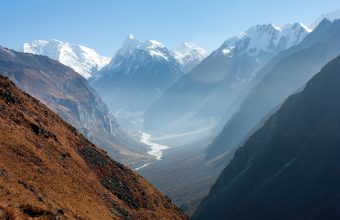
Langtang Helambu Trek
Incredible trek in langtang valley.
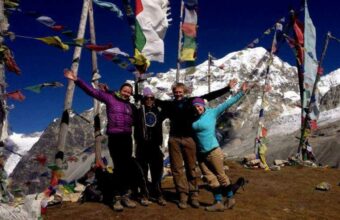
Trekking in Langtang National Park

Ruby Valley Trek
Hidden trails and cultural tales.
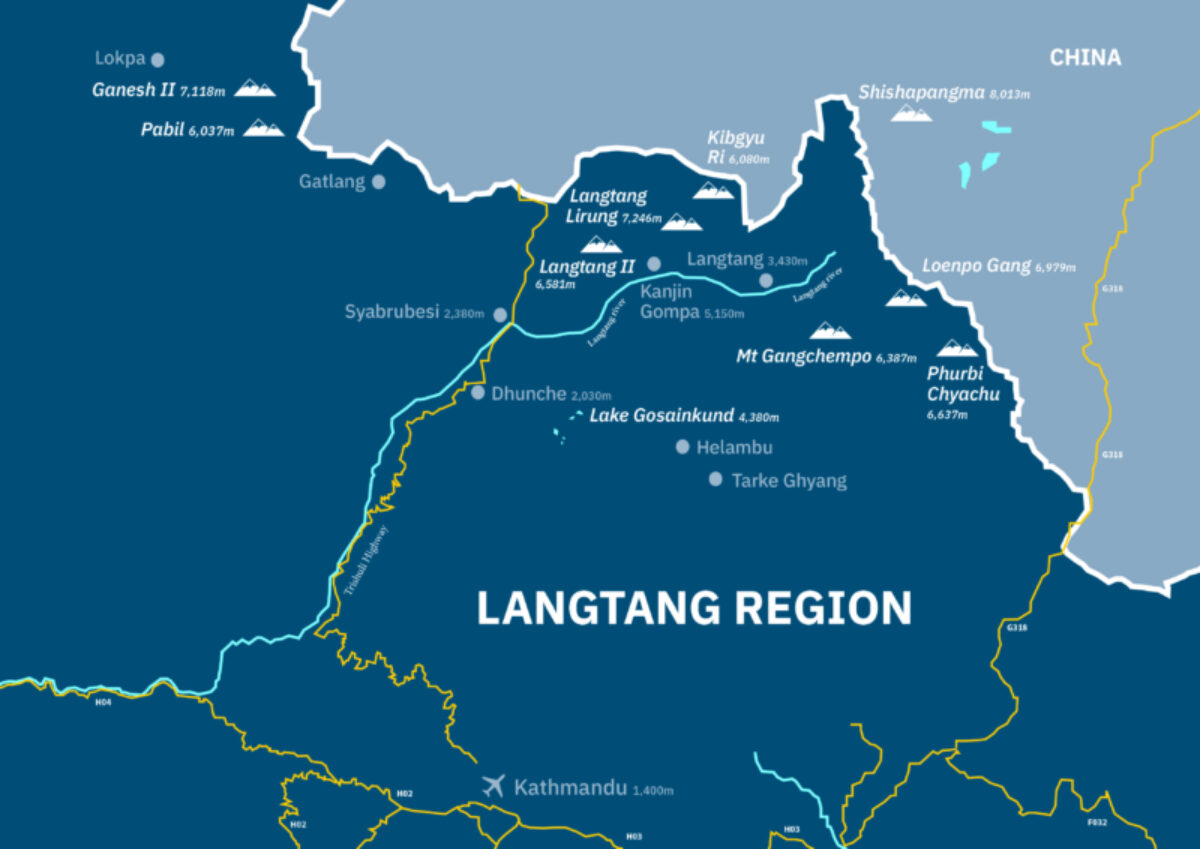
The Langtang Trekking region
The best Langtang Valley treks
Top trekking routes in the langtang region.
The Langtang Valley is a good choice for those with limited time, with the shortest routes taking just a week (or even slightly less) including travel time from Kathmandu. There are also many ways of combining treks to create routes lasting several weeks.
Here's my rundown on the best treks in the Langtang Valley area.

Glorious views of the Langtang Valley
Difficulty: Moderate. The trail climbs quite rapidly so there is a risk of altitude sickness.
Trek Duration: 6 days from Syabrubesi but allow another 2-3 days for side trips from Kanjin Gompa.
Max. Elevation: 3,860m
Accommodation: Trekking lodges. Camping required for any overnight trips beyond Kanjin Gompa.
Start/End Point: Syabrubesi
Before the earthquake, this was one of Nepal’s most popular trekking routes. The trails have been repaired or re-routed and trekking lodges reconstructed. And despite the obvious damage this is still one of the most delightful walks in Nepal. The basic trek takes eight days including travel time from Kathmandu, but add in another couple of days for side trips from Kanjin Gompa.
The standard route follows the Langtang river up a steep and narrow valley. On day two the trail passes over the rubble fields under which Langtang village is buried and on day three the valley opens out to arrive at Kanjin Gompa and big views of Langtang Lirung (7,246m), Langtang II (6,581m) and, perhaps the most distinctive mountain in the valley, the pyramid shaped Mt Gangchempo (6,387m). Kanjin Gompa can be a base for many different day and overnight side trips.
Most people go back the way they came but with more time it’s possible to link up with the Gosainkund and Helambu treks.
Trek Duration: Minimum 8 days depending on route options.
Max. Elevation: 4,610m
Accommodation: Fairly simple trekking lodges.
Start/End Point: Syabrubesi/Dhunche or Sundarijal
The most popular add-on to a Langtang Valley trek, and a fantastic short trek in its own right, is this haul up through pine forests where red pandas live to the Hindu holy lakes of Gosainkund. Although you don’t come face-to-face with the high mountains, you do get grandstand views of the Langtang and Ganesh ranges, as well as crossing the often snowbound and challenging Laurebina La (4,610m).
There are a number of different approach routes to Gosainkund, but to acclimatise it’s best to do the Langtang Valley trek first. Then, from close to the teahouses of Doman, cut across to Gosainkund and descend back to Kathmandu via the Helambu Circuit. Some people go directly to Gosainkund from Dhunche but the elevation gain is great and altitude sickness is common. Starting from Helambu and walking to Gosainkund is a long uphill drag that also invites altitude problems.
Helambu trek
Difficulty: Easy/Moderate.
Trek Duration: 7 days but increasing road accesses means you can cut the trek short at a number of points and bus back to Kathmandu.
Max. Elevation: 3,640m
The closest trek to Kathmandu — it starts from the northern outskirts of the city — takes you on a fairly gentle amble through terraced fields, wild forests, flower meadows and through lots of little villages with views of the mountains. The highest point reached on this trek is 3,640m, so it can be done as a mid-winter trek when higher routes might be snowed in. You can make an enjoyable week-long circuit (a good option for those with little time and/or trekking experience), but most people choose to use Helambu either as a walk in or out route to Gosainkund and the Langtang Valley.
However, be aware that doing this will involve crossing into Helambu via high-altitude passes at either Laurebina La (4,610m) or the very challenging, sometimes dangerous and often snowbound, Ganja La (5,106m). Trekking on these routes involve steep climbs and big changes in altitude, posing a real risk of AMS.
Difficulty: Easy to moderate.
Trek Duration: 5 to 6 days.
Max. Elevation : 3,300m
Accommodation: Homestays.
This route aims to highlight the culture of the Tamang people as much as the mountain scenery. It’s a real community project with money generated from trekkers going into local development projects and trekkers being hosted at night by families in their village houses.
The trail starts from Syabrubesi and is a five to six-day loop close to the border of Tibet. Highlights are the pretty Tamang village of Gatlang, the hot springs at Tatopani, and the fine mountain views over the Ganesh and Langtang range from Nagthali Ghyang. The highest point is 3,300m, so this is a good mid-winter trek when higher routes might be snowed in and it also suits those with limited time.
The Tamang Heritage Trail is very easily combined with the classic Langtang Valley trek. For those with more time, it’s possible to add in Gosainkund and the Helambu treks to make for three weeks of hiking.
Difficulty: Very strenuous and dangerous. People have died attempting this crossing.
Trek Duration: 4 days from Kyanjin Gompa.
Max. Elevation : 5,106m
Accommodation: Camping only.
Start/End Point: Kyanjin Gompa/Tarke Ghyang
The most challenging and dangerous trek in the Langtang region is the crossing of the high (5,106m) Ganj La pass, which links Kyanjin Gompa at the head of the Langtang Valley with Tarke Ghyang on the Helambu Circuit. This should only be attempted by very experienced trekkers with a good support team. You will need camping equipment, a guide who knows the route well, ropes, ice-axes and crampons.
There are no facilities along the route. Note that the pass is, at best, only open between October and November and March to May, but even during these months it’s often snowbound and impassable. Make sure you have a back-up plan in case the pass is closed. Avalanches are a very serious risk on the approach to and from the pass.
Difficulty: Moderate.
Trek Duration: 2 weeks
Max. Elevation: 3,842m
Start/End Point: Syabrubesi/Tripura Sundari
Named after Ganesh, the elephant-headed Hindu god of fortune, Ganesh Himal lies directly between the Manaslu and Langtang ranges, and is one of the great unknowns of Nepalese trekking. With stunning mountain scenery, attractive and welcoming villages, hot springs, waterfalls and a genuine sense of being well off the beaten track, the Ganesh region really has a bit of everything — except crowds of other trekkers.
A handful of homestays and trekking lodges have started to open up, but for now the trails are still largely empty. Because formal accommodation is still so scarce, an organised camping trip is the best way to tackle this trek.
There are a couple of different trekking routes in the Ganesh region which you can access from Manaslu and the Tsum Valley in the west, but the standard trail starts from Syabrubesi and follows the Tamang Heritage Trail to the gorgeous village of Gatlang before crossing the Pansang La pass (3,842m).

The Langtang area has it all. Start walking from Kathmandu and before you know it, find yourself in a tranquil mountain village, breezing through flower meadows, picnicking in the shade of pine trees, crossing rushing rivers, and a snowbound pass, and standing atop a minor Himalayan peak.
Kanjin Gompa day trips
The small village of Kanjin Gompa (3,860m) at the head of the Langtang Valley, might be the official end point of the Langtang Valley trek but in truth this is where the fun really starts. Numerous day and overnight trips fan out from the village. You can make the almost obligatory hike up to the Kyanjin Ri viewpoint (4,600m) for sensational views, or have a rollicking day’s adventure to the glaciers and yak pastures of the Lirung Valley. A bigger challenge is the long and exhausting day trip to the Tsergo Ri viewpoint at 4,984m, or, for the adventurous, an overnight camping trip to the summit of Yala Peak, which at 5,500m often requires ropes, crampons and an experienced guide.
Gosainkund Lake
The holy lake of Gosainkund (4,400m) has a black rock sticking out of it that Hindus believe is the head of Shiva, and the lake attracts scores of Hindu pilgrims particularly over the August full moon. Like any good pilgrimage, the trek to Gosainkund is a challenging one involving a high pass crossing and memorable scenery. Once at the lake there are a number of side trips to other lakes and high viewpoints.
Helambu and the Tamang Heritage Trail offer a delightful combination of mountain views and pretty villages. The latter offers a real insight into local life thanks to an exciting tourism-based community initiative in which trekkers can stay as guests in village houses, and traditional dances and events are laid on. Both these treks are (for the Himalayas) fairly low level with little risk of altitude-related problems.
Ease of access
The Langtang area offers the most accessible trekking in Nepal. Take a taxi across Kathmandu to the Shivapuri National Park and start walking the Helambu Circuit within an hour of leaving your guesthouse. If you’re heading straight to the Langtang Valley, Ganesh Himal or Tamang Heritage Trail, a day’s bus ride from the city will get you to the trailheads.
Exploration
Don’t think that because the Langtang region is so popular there’s no adventure left. Grab some tents and a guide in Kanjin Gompa (or bring them from Kathmandu) and walk for a day or so further up the Langtang Valley to Langshisha Kharka and towards the Langtang glacier, and you’ll feel as if you have the Himalayas all to yourself. The nearby Ganesh Himal is perhaps the most overlooked range in the Nepalese Himalayas. You could trek here for days without meeting another foreigner.
Apart from the TIMS card, no special permits are required for the treks in this area. The Langtang, Gosainkund, Ganj La and Helambu treks all enter the Langtang National Park for which there is a Rs 3000 entry charge. The Helambu trek also enters the Shivapuri National Park for which there is a Rs 500 entry fee.
The best time to trek the Langtang trails is from October to April. It can get very cold in December and January but lodges remain open and the trails are quiet. In April, flowering rhododendron add a palette of red and orange to the slopes. Few people trek here in the monsoon but during the Janai Purnima festival during the August full moon, thousands of Hindu pilgrims (including lots of sadhus and other holy people) make their way to the holy Gosainkund lakes to bathe. This makes for an interesting experience for those who aren’t bothered by the lack of mountain views.
The region suffered very badly in the earthquake but all the trekking trails have been repaired and trekking lodges rebuilt. Camping gear is only required if you’re exploring the Ganesh Himal, attempting the Ganj La pass, or heading further up the Langtang valley from Kyanjin Gompa. However, for safety and enjoyment reasons, a guide is a good idea on all these treks.
Access to this area from Kathmandu couldn’t be easier. Simply hop on a bus in central Kathmandu and by the end of the day you’ll be in Syabrubesi or one of several other trailheads. There is no scheduled air access to the area.
Featured tours

Featured tours View all
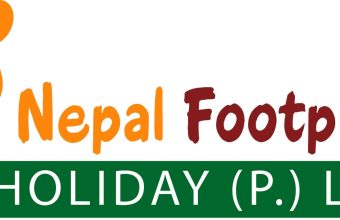
Why Horizon Guides?

Impartial travel guides
Our guides are written by the leading experts in their destinations. We never take payment for positive coverage so you can count on us for impartial travel advice.

Expert itineraries
Suggested itineraries and routes to help you scratch beneath the surface, avoid the tourist traps, and plan an authentic, responsible and enjoyable journey.

Specialist advice
Get friendly, expert travel advice and custom itineraries from some of the world's best tour operators, with no spam, pressure or commitment to book.
Our guides are 100% impartial and are written by independent, professional travel journalists. We make money by charging carefully-screened travel companies to list their business on our website. Our advertisers have no influence on our editorial content and we never accept payment for positive coverage.
Read more about how we work and what we believe in here .
- Travel guides
- Work with us
Sitemap , Privacy Copyright © 2024 Horizon Guides

- Why Do you Choose with Us?
- Everest Trekking Routes
- Legal Document
- Term & Condition
- Ghorepani Poon Hill Trek 4 Days
- Ghorepani Poon Hill Trek
- Annapurna Base Camp Trek 5 Days
- Annapurna Base Camp Trek 7 Days
- Annapurna Base Camp Short Trek
- Annapurna Base Camp Trek
- Annapurna Base Camp Trek 12 Days
- Annapurna Base Camp Trek Solo
- Annapurna Circuit Trek
- Mardi Himal Trek 5 Days
- Mardi Himal Trek
- Khopra Ridge Trek
- Annapurna Tilicho Lake Trek
- Jomsom Muktinath Trek
- Australian Camp Hike
- Dhampush Sarangkot Trek
- Ghale Gaun Trek
- Budget Annapurna Base Camp Trek
- Nar Phu Valley Short Trek
- Nar Phu Valley Trek
- Langtang Trek 7 Days
Langtang Valley Trek
Langtang gosaikunda trek, langtang tamang heritage trek.
- Langtang Valley Solo Trek
- Langtang Ganja la Pass Trek
Helambu Circuit Trek
- Shivapuri Nagarkot Trek
- 12 Days Manaslu Circuit Trek
- Manaslu Circuit Trek
- Short Manaslu Circuit Trek
- Manaslu Circuit Trek Solo
- Manaslu Tsum Valley Trek
- Everest view Trek 7 Days
- Everest Base Camp Trek 10 Days
- Everest Gokyo Lake Trek
- Everest Base Camp Trek
- Everest Base Camp Trek 12 Days
- Everest Cho la Pass Trek
- Everest Three Pass Trek
- Everest Base Camp Trek 14 Days
- Everest Base Camp Trek Budget
- Everest Base Camp Helicopter Tour
- Phaplu to Everest Base Camp Trek
- Upper Mustang Trek
- Upper Mustang Jeep Tour
- Kanchenjunga Base Camp Trek
- Ruby Valley Trek
- Rara Lake Trek
- Lower Dolpo Trek
- Upper Dolpo Trek
- Manaslu Annapurna Circuit Trek
- Arun Valley Trek
- Chepang Hill trek
- Dhaulagiri Round Trek
- Ganesh Himal Trek
- Guerrilla Trek
- Makalu Base Camp Trek
- Manaslu Rupina La Pass Trek
- Rolwaling Tashi Lapcha Pass Trek
- Sherpeni Col Pass Trek
- Kathmandu valley Sightseeing
- Pokhara Day Tour
- Kathmandu Chitwan Tour
- Kathmandu Chitwan Lumbini Tour
- Kathmandu Pokhara Bandipur Tour
- Kathmandu Nagarkot Dhulikhel Tour
- Annapurna Base Camp Helicopter Tour
- Pokhara Muktinath overland tour
- Bungee Jumping in Nepal
- Dhorpatan Hunting Tour
- Family Tour in Nepal
- Helicopter Tour in Nepal
- Mountain Flight in Nepal
- Island Peak Climbing
- Chhukung to Island Peak Climbing
- Lobuche Peak Climbing
- Dingboche Lobuche Peak Climbing
- Mera Peak Climbing
- Chulu West Peak Climbing
- Chulu East Peak Climbing
- Tent Peak Climbing
- Nayakang Peak Climbing
- Amadablam Expedition
- Pokalde Peak Climbing
- Tourist Visa for Nepal
- Trekking Equipment List
- Jeep Scorpio Rental Service in Nepal
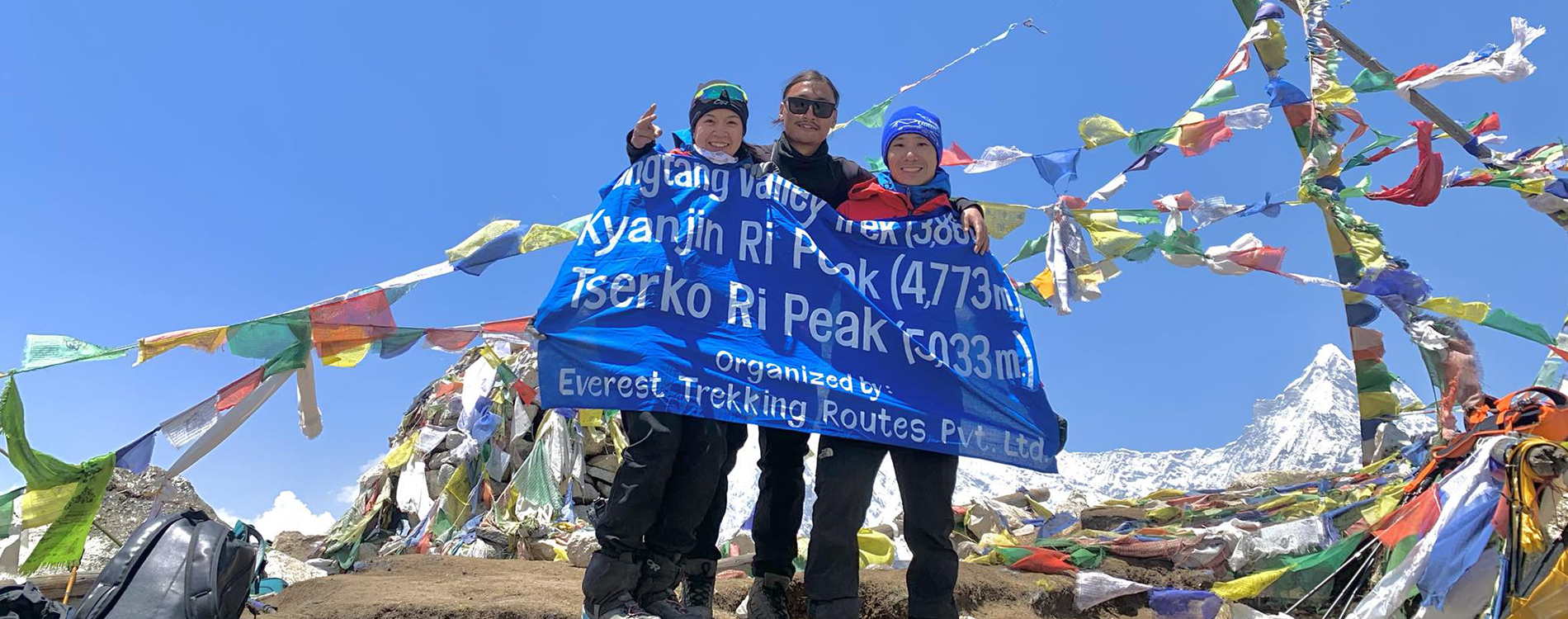
- [45+ booked]
- Share the trip
Discovering the Hidden Gems of Langtang Valley Trek
Nepal is a land of incredible natural beauty, with its rugged mountains, lush valleys, and winding trails that lead to some of the world’s most breathtaking vistas. Among its many trekking routes, Langtang stands out for its unique combination of stunning scenery, rich cultural heritage, and off-the-beaten-track adventure. This hidden gem of the Himalayas is a must-visit destination for any avid trekker or nature lover looking to explore the beauty of Nepal in all its glory.
From the snow-capped peaks of Langtang Lirung to the picturesque villages of Kyanjin Gompa and Langtang Valley, the Langtang trek offers a unique opportunity to experience the rich culture and natural beauty of Nepal up close. So, if you’re looking for an adventure of a lifetime, strap on your hiking boots and join us on a journey through the scenic trails of Langtang.
The Beauty of Langtang National Park
Langtang National Park is a stunning natural reserve that spans an area of 1,710 square kilometers. It is located in the northern region of Nepal and is home to a wide variety of flora and fauna. The park is named after the Langtang Valley, which is one of the most popular trekking destinations in Nepal. The Langtang Valley is surrounded by high peaks such as Langtang Lirung, Gang Chhenpo, Naya Kangri, and Dorje Lakpa. The valley is also home to the Langtang Glacier, which is the largest glacier in the Himalayas.
The Langtang National Park is also home to several endangered species, including the Red Panda, Snow Leopard, and Clouded Leopard. The park is also known for its rich birdlife, with over 300 species of birds recorded in the area. The park is a paradise for nature lovers and offers a unique opportunity to explore the natural beauty of Nepal.
Langtang Trek takes you through the heart of Langtang National Park, offering an opportunity to experience the beauty of the park up close. The trek takes you through dense forests, traditional villages, and high mountain passes with stunning views of the Himalayas.
Trekking Route and Difficulty Level
The Langtang Valley Trek is a moderate trek that takes around 7-10 days to complete. The trek starts from Syabrubesi, which is a 7-8 hour drive from Kathmandu. The first few days of the trek take you through traditional villages such as Lama Hotel and Langtang Village. The trek then takes you to the popular trekking destinations of Kyanjin Gompa and Tserko Ri. The trek is relatively easy, with a maximum altitude of 5,000 meters. However, the trek can be challenging due to the high altitude and steep climbs.
The Langtang Trek is ideal for those who want to experience the beauty of the Himalayas without the strenuous trekking of higher altitude treks such as Everest Base Camp or Annapurna Circuit .
Best Time to Trek Langtang
The best time to trek Langtang is from March to May and September to November . During these months, the weather is mild and dry, making it easier to trek through the mountains. The skies are clear, offering stunning views of the Himalayas. The temperatures during these months are also comfortable, making it easier to acclimatize to the high altitude.
During the monsoon months of June to August , the trekking routes can be muddy and slippery, making it difficult to trek. The skies are also cloudy, making it difficult to see the stunning views of the Himalayas. The winter months of December to February can be extremely cold, with heavy snowfall making it difficult to trek.
Cultural Experiences on Langtang Trek
The Langtang Valley is home to several ethnic groups, including the Tamangs and Sherpas. These groups have their own distinct culture and traditions. The Tamangs are known for their hospitality and warm nature, while the Sherpas are known for their mountaineering skills. The trek takes you through several traditional villages, offering an opportunity to experience the local culture and traditions.
The trek also takes you to the popular trekking destination of Kyanjin Gompa, which is a Buddhist monastery. The monastery is believed to be over 500 years old and is a popular pilgrimage site for Buddhists. The monastery offers stunning views of the Himalayas and is a must-visit destination on the Langtang Trek.
Wildlife Sightings on Langtang Trek
The Langtang National Park is home to several endangered species, including the Red Panda, Snow Leopard, and Clouded Leopard. The park is also known for its rich birdlife, with over 300 species of birds recorded in the area. The trek offers an opportunity to spot these rare and endangered species in their natural habitat.
The trek also takes you through dense forests, offering an opportunity to experience the natural beauty of Nepal up close. The forests are home to several species of birds, including the Himalayan Monal and the Satyr Tragopan.
Preparing for the Langtang Trek
Preparing for the Langtang Trek is essential to ensure a safe and enjoyable experience. Here are some tips to help you prepare for the trek:
- Get in shape – The Langtang Trek is a moderate trek that requires a good level of fitness. Start training a few months before the trek to build your endurance and stamina.
- Get the right gear – Invest in good-quality hiking boots, warm clothing, and a waterproof jacket. The weather in the Himalayas can be unpredictable, so it’s essential to have the right gear.
- Acclimatize – The Langtang Trek takes you to high altitudes, so it’s essential to acclimatize properly. Take your time and walk at a slow pace to allow your body to adjust to the altitude.
- Stay hydrated – Drink plenty of water and carry a water bottle with you at all times. Dehydration can cause altitude sickness, which can be dangerous.
- Pack light – Pack only the essentials, as you’ll be carrying your backpack for most of the trek. Keep your backpack light and comfortable.
The Hidden Gems of Langtang Trek – Kyanjin Gompa, Langtang Glacier, and Gosainkunda Lake
The Langtang Trek is full of hidden gems that are waiting to be discovered. Here are some of the must-visit places during the Langtang Trek:
- Kyanjin Gompa – Kyanjin Gompa is one of the most important monasteries in the region. The monastery is located at an altitude of 3,870 meters above sea level and offers stunning views of the surrounding mountains.
- Langtang Glacier – The Langtang Glacier is one of the largest glaciers in the region. The glacier is located at an altitude of over 4,000 meters above sea level and offers stunning views of the snow-capped peaks.
- Gosainkunda Lake – Gosainkunda Lake is one of the most sacred lakes in Nepal. The lake is located at an altitude of over 4,300 meters above sea level and offers stunning views of the surrounding mountains.
Accommodation and Food Options During the Trek
The Langtang Trek offers several accommodations and food options along the trail. Most of the trekking routes have tea houses and lodges that offer basic accommodation and food. The tea houses and lodges offer a warm and comfortable place to rest and refuel after a long day of trekking.
The food options during the trek are limited, but you can expect to find traditional Nepali dishes such as dal bhat (rice and lentils), momos (dumplings), and thukpa (noodle soup). The food is simple but delicious and provides the necessary energy to keep you going during the trek.
Tips for Langtang Trek
Here are some tips to help you make the most of your Langtang Trek experience:
- Walk at a slow pace to acclimatize properly
- Stay hydrated and drink plenty of water
- Pack light and carry only the essentials
- Dress in layers to adjust to the changing weather conditions
- Respect the local culture and customs
- Take plenty of breaks and rest when needed
- Hire a local guide for a more authentic and safe experience
Follow the Most Popular Langtang trek in the Langtang Region
- Langtang Valley Trek 8 days
Relatate Picture Gallery

Trip Itinerary
Outline itinerary, day 01: arrival in kathmandu and transfer to hotel, day 02: drive to syabrubesi (1,550m) 7-8 hours.
- Day 03: Trekking to Lama Hotel (2,380m) 6 hours
Day 04 Trekking to Mundu (3543m) 6-7 hours
Day 05: trekking to kyangjin gompa (3,870m) 4-5 hours, day 06: trekking to lama hotel 6-7 hours, day 07: trekking to syabrubesi 4-5 hours.
- Day 08: Drive to Kathmandu
Day 09: Final International departure
Details itinerary.
The representatives from Everest Trekking Routes will welcome you at Tribhuvan International Airport upon your arrival. He/she Assist in transferring you to the hotel for the overnight stay.
We start our 7-8 hours long drive to Syabrubeshi from Kathmandu today. On the way, we can witness the scenic foothills and ridgeline splendors of Syabrubeshi passing Dhunche. The beautiful glimpse of Ganesh Himal and terraced green hills along with the lush green forests will allure you during the drive. We check into the hotel upon reaching Syabrubeshi and stay overnight at the guest house.
Day 03: Trek from Syabrubeshi to Lama Hotel (2500m) – 5 Hours
Today will be the first day of our trekking. We follow the Langtang Khola River and pass through the dense forest crossing several suspension bridges en route. We also pass by some tea houses and eventually reach Lama Hotel where we stay overnight at lodge.
Today, we continue along the dense forests and then make a steady climb up through the valley. Leaving the tree line behind us, we walk further overlooking some of the marvelous views of Langtang Lirung. We finally arrive at Mundu, where we stay overnight at a local tea house.
Today, it’s going to a shorter walk but it’s adequate for acclimatizing. Today, we will find some very interesting things to explore. You can explore some popular cheese factories in this beautiful valley situated at the lap of Langtang Lirung. We stay overnight at tea house.
We take our morning time to visit Tserko Ri today where we can enjoy some phenomenal sunrise views. And then, we proceeded back to Lama Hotel. It takes almost 4 hours walking downhill to Lama Hotel where we stay overnight at a lodge.
Today, we trek down to Syabrubeshienjoying the easy trek mostly downhill through the lush green vegetation. Today is the final day of our trekking. Upon reaching Syabrubeshi, we checked into the guesthouse and stayed there overnight.
Day 08: Drive to Kathmandu 6-7 hours
We drive back to Kathmandu today. It takes approx. eight hours to reach Kathmandu via Bus Drive. On reaching Kathmandu, you can take your time for last-minute shopping. We celebrate the farewell dinner with our team tonight.
We are saying goodbye to Kathmandu as your journey in Nepal comes to an end today! We will transfer you to the airport for your return flight.
Cost Details
Cost includes.
- Airport / Hotel / Airport pick up and Drop by private car/van/bus.
- Local Transport : Kathmandu to Syabrubesi and Syabrubesi to Kathmandu by Express Bus
- You’re Meal : During the Trekking are (7 Breakfasts, 7 Lunches, and 6 Dinners with a cup of tea or coffee)
- All Trekking Permit (Langtang National Permit) and Trekkers’ Information Management System (TIMS) Permit.
- 6-night Lodge Accommodation /tea houses during the treks.
- Trekking Guide : An experienced, helpful, friendly, and English-speaking Trekking Guide. His well-paid salary, meals, accommodation insurance, etc.
- Trekking Porter : porters (1 porter for 2 people). for Solo Trekker No Porter
- After the successful trip, Everest Trekking Routes will Provide an Adventure Certificate.
- Arrangement of Emergency Helicopter service which will be paid for by your Travel insurance company.
- All government taxes and service charges.
Cost Excludes
- All accommodations and meals in Kathmandu, before and after the journey
- Private Jeep From Kathmandu to Syabrubesi and Return to Kathmandu
- personal expenses (Hot Shower, bar bills, beer, coke, a bottle of water, hot water, pot size of tea or coffee, phone call, laundry service, Helicopter rescue, Electronic device recharge such as Mobile, Camera, Private, etc.)
- Tips for guide, porters, and driver.

Explore the Langtang Valley Trek with our comprehensive FAQ guide. Find answers to common questions about permits, accommodations, difficulty levels, best trekking seasons, and more. Plan your adventure in the stunning Langtang region of Nepal with confidence, covering everything from costs to customization options. Get expert insights to ensure a memorable and safe trekking experience in this Himalayan gem.
More Details Here:
Join Upcoming Trips 2024
Latest customer reviews.

Samuel Hendrickson Elias
Thanks for making my langtang trek dreams come true.
I feel very fortunate to have had Veer Gurung as my guide during my Langtang Valley trek ! He was not only very helpful and supportive to me during the trek, but he also went above and beyond in helping many other trekkers along the trail. During our summit day of Tsergo Ri, we were met with a fair amount of snow. Veer pushed on when other guides may have shied away from the bad conditions. The next day, Veer was also willing to join me for an impromptu day hike not listed on the itinerary. Throughout the trek, he expressed concern and care about my condition and was always looking out to make sure I was having a good time. It was also fantastic to meet some of his friends and family members at the teahouses along the trek. In all, thanks for making my Nepal trekking dreams come true!
Notes about the Langtang Trek: This was my first trek in Nepal and I recommend it, particularly if you can’t squeeze in one of the longer treks. With that said, I will now for sure be back to do other treks! The trek never felt too crowded, and I loved how the trek slowly got more and more scenic over time. It is the third most popular trek in Nepal for a reason. If you have ambitions of climbing Kyanjin Ri and/or Tsergo Ri I suggest spending a couple of days (I spent 3 nights) in Kyanjin Gompa to give yourself time/flexibility. I was glad I had extra time to explore the area.
Source by: Tripadvisor

Fulco Marinus Maria
Netherland,, we have booked the langtang 7 days trek.
We had a group of two, my son and me.
After checking several sites, we thought that Everest Trekking Routes would meet our requirements at most. We booked it directly and came in touch with Rabin Gurung, the owner. First through the mail and soon via WhatsApp.
As we were quite new to trekking, we had a lot of questions, Rabin answered very clearly and quickly. Communication was very good.
After booking the tour, Rabin suggested we stay at Kathmandu Suite Home, close to the Thamel area.
This was an excellent choice, quiet and good service.
During the tour, everything was taken care of by Rabin, from transport from the airport to the Hotel and backward and everything around the trekking.
The trekking itself was a lifetime experience. We had a great guide, Sandesh, who was looking after us, laughing with us, playing cards with us. Great guy. And we had a porter, Uncle. He is very strong. We felt a little awkward that he was carrying our 13kg bag, but this was not a problem for him, since he used to carry bags of over 30 kg.
Me and my son had an unforgettable experience.
I Would recommend everybody to book their next trek with Everest Trekking Routes . You can find the route that best suits you as they have a lot of choices.
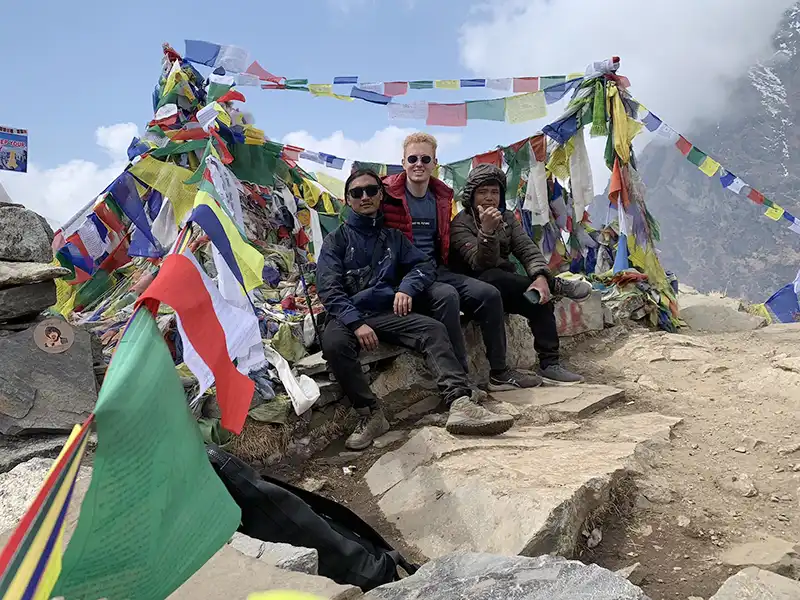
Dang Hoang Khang Truk
Amazing experience, beautiful scenery with professional and helpful guide langtang trek 7 days.
It was my first time in Nepal and my first “long” trek, Rabin and Samuel from Everest Trekking Routes certainly made it one of the most memorable trip for me!
Prior to my booking, Rabin was very patient in answering my many questions. Communication was very smooth and easy. He warmly welcomed me at the airport and introduced me to my guide, Samuel, who will accompany me throughout the 7 days trip. They take care of all the logistics, permits, transports etc. ( there were many check points on the way so permits are essential)
Needless to say, Samuel did an excellent job, very professional and kind to me the whole trip. He is always available to assist, whether it’s to help carry my bag, help me to go down when I have some trouble with the knees, to showing the many animals along the way, or help fixing my shoes, he was always so accommodating, kind and helpful. All the food and accommodations picked by them were very good and comfortable. Couldn’t have done this trip with so much joy without Samuel, big kudos!!!
Regarding the trek, the scenery is so surreal and varried. Snow capped mountains, glaciers, lush green valley, dense forest, rivers, many animals and beautiful flowers, you get to see it all on this trip. I will forget many things in my life but certainly, Langtang valley will always have a special place in my memories for its breathtaking beauty!!!!
For me, a woman in early 30s, regularly exercise, this was a moderate trek, there was some challenging parts but not that difficult. I don’t walk alot at home, but to complete 6hr walking every day on the trip for me wasn’t that difficult. We also got lucky with weather, clear sky for most days. Even when it’s rain a little and get foggy, it’s still so beautiful and mystic. Also you get to meet other trekkers along the way and gathering at teahouses, where we are served supper yummy fresh cooked dishes. It wad not crowded at all, or so I feel, cause I meat many people at the tea houses but along the way, you don’t really see anyone.
So well, what more can I say, do yourself a favor, book with them and enjoy the trip, you won’t be disappointed!!!
P. s: consider taking the jeep to go there, the road is terrible and many mountain passes with sharp u-turn corners.
Source by: TripAdvisor

Liau Gii Hau
Langtang 8 days tour.
I requested Mr. Rabin Gurung to have a guide/porter before starting my journey, and he sent a very experienced guide Mr. Phul to be my guide/porter. Mr. Phul has more than 25+ years of experience becoming a mountain guide. I had problems during the hike up to the mountain but Mr. Phul always gave me support all the way, he shared the newer things in the jungle with my brother along the trek.

Liau Jit Tsong
Best of the best in the langtang trek.
Trekking with them for a week in Lang Tang National Park. The organiser mr Rabin and mountain guide mr Phul were very helpful and organised. Very recommended.
Sorcess by: TripAdvisor

My Langtang Valley Trekking Experience 2023
This is my second trek in the Himalayan mountains. Compared to ABC, I find the Langtang Trek to be tougher because I started to have mild mountain sickness on the first day after Bamboo while hiking from Syabrubesi to Lama Hotel (altitude gain of 950m). I’m very grateful to Biraj, my porter who was observant and offered to carry my backpack that day. The trail is moderately tough as we had to climb up for the first 3 days to Kyanjin Gompa – sometimes over uneven rocky steps, stepping on stones over shallow streams, some paths are steep, and some can be slippery due to loose stones. Thankfully, we have a team of porters (Maran, Biraj, Michael, Suk and Buddha) who were friendly, attentive and very helpful, ensuring that we have the best experience and that we are safe, often lending a helping hand especially when we had to hike over some difficult terrain. I give 5 stars rating to our team of porters! The reward: a fantastic view atop Kyanjin Ri – it’s definitely worth the effort! Sources by: TripAdvisor

Amazing and spectacular view Langtang Trek
Amazing and spectacular view especially at the peak of Tsergo Ri. Its one of my best memories with my friends and family. The porters are very helpful too. All in all, its a great and unforgettable experience for me.
Sources by: TripAdvisor

Miriam Anna
7-day langtang trek.
My father and I pursued the 7-day Langtang trek from Shyphrubesi to the top of Kyanjin Ri. Our guide Bale was very well informed about the nature and the trekking conditions. He and our porter Aita were very friendly and we loved their humor. They made our trekking experience a blast. We will come back to Nepal for another trek with Bale & Aita. Further, the company „ Everest Trekking Routes “ led by Rabin is very trustworthy and organized our trekking tour extremely well.
Sources by: Tripadvisor
Related Trips

- Moderate/Hiking
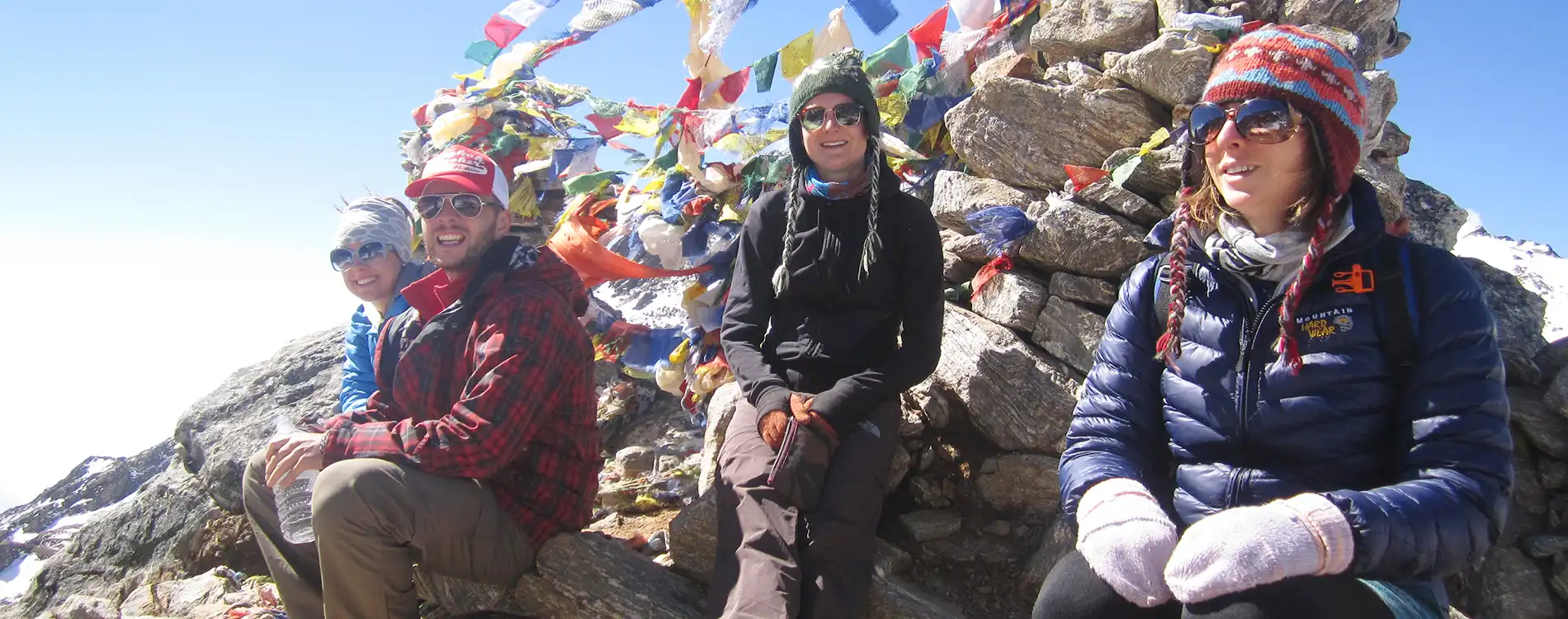
- Moderate/High Pass

Trekking and Peak Climbing in Nepal
- Regd. No.:63295/065/066
- Tourism Licence:1632
- VAT No.:303818070
Home » Langtang Guide » 5 Days Langtang Valley Trek
5 Days Langtang Valley Trek
You must be wondering whether you can finish trekking around the Langtang valley in 5 days or not? Then the answer is YES , as you get to visit the most popular viewpoint of the trek Kyanjin Ri and witness beautiful mountains in just five days.
Knowing this you must be quite excited now, as we bring to you a short 5 days Langtang Valley Trek. Normally, this trek can be 7 to 11 days long but exciting Nepal has made a short Langtang Valley trek 5 days itinerary for people with limited time.
This is a short trek inside the Langtang National Park that takes you away from the city noises to a peaceful environment.
Langtang region lies 51 km away from Kathmandu in the north-central part of the Province no. 3. This region is quite famous among trekkers for the trekking routes it has to offer.
It is one of the closest trekking destinations that is situated near the capital city. This region is also renowned for introducing one of the famous national parks i.e. Langtang National Park.
Langtang Valley is a part of Langtang National Park that was established in the year 1970 . This is the first Himalayan National Park to be established in Nepal.
It was made to conserve the wildlife, culture, unique vegetation, and natural resources of this sector. This park also contains different climatic conditions from Alpine to Subtropical.
The majority of people living in these places belong to the Tamang Community. You can dive deep into the cultural and traditional aspects of local inhabitants on Tamang Heritage Trail Trek . You can also find other communities such as Magar, Brahmin, etc. Most of these people still depend upon the timber and woods found inside the park.
To trek in these routes, it is not compulsory to have experience beforehand. The routes in this region have been graded as a moderate walk.
You begin your 5 days Langtang Valley Trek by heading out of the capital and entering the beautiful Langtang region . You make your stop at Syabrubesi then from there you trek towards Rimche and stay there for the night.
After a wonderful night, you trek towards Langtang valley looking at the scenic views and stay there. Then, you head towards your next destination which is Kyanjin Gompa. You will go up on a hike and explore the area then return back to Syabrubesi.
These paths take you through the dense lush green forests that give you the amazing view of various types of flora and fauna. You get to see different trees of pines, oak, maple, birches, etc and colorful shades of Rhododendron .
As you walk in these paths you get to view the mesmerizing snowy mountain peaks such as Langtang Lirung, Ganesh Himal, Langtang II, Dorje Lakpa, etc.
These routes of this region might be famous but still, it is not as crowded as Annapurna region treks and Everest region Treks making it a peaceful journey.
Highlights of Langtang Valley Trek 5 days
- Visit villages influenced by Tibetan cultures and tradition
- Finish Langtang Valley trek in 5 days
- Awestruck views of various mountain ranges
- Reach Kyanjin Ri the highest point of this trek
- Witness unique species of Flora and Fauna
- Visit Monasteries along the way.
- Explore the Langtang Valley
- Ancient cheese factory
Best Time for 5 Days Langtang Valley Trek
This trek gives you the chance to witness the beauty of nature. These trekking routes are not that far from Capital.
While going trek in this route you get to experience different weather and temperature according to the season you will be traveling in.
In the context of Nepal, you have four seasons to choose from Autumn, Spring, Monsoon, Winter.
However, trekkers considered Autumn and Spring season the best time for Langtang Valley Trek.
Autumn Season ( September to November)
Autumn Season is the peak season to go trekking on these routes. While walking these routes you get accompanied by many fellow travelers. So you won’t be getting much privacy during this time.
These months are when the beauty of nature is at its top. You can see the rain-washed environment and bloomed flora and fauna throughout the valley. It makes the view more mesmerizing.
During this season, the weather is clear giving out the perfect view of mountain peaks. Also, the walk during daytime is warm but the nights can be a bit chilly.

Spring Season (March to May)
Spring season is another peak time of the year when the routes are as crowded as Autumn. This season is when nature lovers travel to trek in the routes of Langtang valley.
These months bring a new beginning with them, the valley changes its color from dried brown leaves to luscious green forests. You also get to witness the blooming of flowers all along the way.
During this season, the skies are clear and the weather is favorable for trekking. The days are sunny but the nights can be a bit cold.
You should also book rooms in advance as lodges will be packed with trekkers. Making it hard to find rooms of your desire.
Winter Season ( December to February)
Winter season is often considered off-season time of the year. During these months the routes are filled with snows making the walk challenging. If you love snowfalls then this season is for you.
These months are the coldest time of the year but the blue sky gives you the clearest view of the snow-covered peaks. However, the temperature tends to drop below the freezing point so you should be well prepared to face the cold.
During this season, the routes are less crowded making the journey peaceful and the price also drops due to fewer people trekking these routes.
Monsoon Season ( June to August)
Monsoon Season is the least preferred time for 5 days Itinerary Langtang Valley Trek. There are low chances of meeting people in the trails. Most researchers are found trekking due this time of the year.
These months are when heavy rainfalls occur which makes the path slippery. So you should be careful while walking on these routes. Also, the view of mountains is hidden behind the dark rain clouds making it less interesting.
But during this season, unique types of flora and fauna are found blooming throughout the paths. If you have made up your mind to travel during Monsoon then you should carry raincoats along with you.
Similar articles you may like:
- Langtang Gosaikunda Trek Information
- How to Reach Langtang from Kathmandu
- Langtang Trek Cost
Difficulties You May face during Langtang Valley trek 5 Days Itinerary
This trek is considered neither too harsh nor too easy, it is a moderate walk. Even novice trekkers can make the climb in these trails with proper training.
Langtang Valley trek 5 days is the shortest time period to finish this trek. Thus, you will be walking for about 7 to 8 hours each day.
On this trek, you will be walking many up and down paths that require a huge amount of stamina. So it is necessary to increase your stamina while going on a trek.
To make this climb your body needs to be physically and mentally fit. You don’t need any technical training to complete this trek.
Two weeks prior to the actual trek you can do physical training on your own. Physical training such as cycling, running, swimming, skipping, short hikes, etc.
Detailed Langtang Valley trek 5 days Itinerary
Day 1: drive from kathmandu to syabrubesi then trek to rimche.
You begin your 5 days Langtang Valley trek by driving out of the busy city of Kathmandu and heading towards Syabrubesi.
To travel there you can either take a local jeep or bus. It is about a 7 to 8 hours drive from Kathmandu to Syabrubesi covering a distance around 122 km .
You will be traveling looking at the scenic views outside your window. Along the way, you get to see lush green hills and many small villages. You arrive at Syabrubesi.
Syabrubesi is situated at an altitude of 2380 m above sea level. It is the gateway for many awesome treks in the Langtang region.
Now you begin your trek towards Rimche from Syabrubesi. It is about 4 to 5 hours walk from here covering a distance of about 8.6 km .
To reach Rimche you have two options either travel from High trail or travel from Low trail. However, you will be traveling through Low trails that pass through Bamboo .
Today you will walk through small settlements and dense forests of oak and pine trees. These routes are not that rough so it is an easy trek this day.
Rimche is situated at an altitude of 2450 m above sea level. You stay here for the night.
Day 2: Trek from Rimche to Langtang village
Today you will be heading towards Langtang valley from Rimche. It is about 6 to 7 hours’ walk from here.
You begin your trek by taking an uphill climb that leads towards the Lama Hotel. Then from there, you enter a beautiful forest of colorful rhododendrons.
In between the trees, you get to see the mesmerizing view of mount Langtang Lirung, Ganesh Himal , etc. As you head in these paths, you come out from the forest and make a steep climb that leads to Ghora Tabela.
From here you make a slight downhill walk then again climb up the trails and reach Langtang Village. It is situated at an altitude of 3430 m above sea level.
Langtang valley is surrounded by walls to protect their crops such as potato, wheat, etc. You stay here for the night.
Day 3: Trek from Langtang Village to Kyanjin Gompa
Today you will be heading towards Kyajin Gompa from Langtang Village. It is about a 3 to 4 hours walk from here.
You will walk past many mani walls, prayer flags before you reach Mundu. Then from here, you cross a small wooden bridge and enter the forests of colorful rhododendron.
After walking for about half an hour you reach Kyanjin Gompa situated at an altitude of 3830 m above sea level . From here you get to view the beautiful mountain peaks such as Mt. Ganchhenpo, Mt Langtang Lirung, etc.
This village is also famous for its ancient Cheese factory that is quite famous among the locals. If you like cheese you can visit the factory and try some.
After exploring the valley you stay here for the night.
Day 4: Hike to Kyanjin Ri and return back to Kyanjin Gompa then trek back to Rimche
Today you wake up early and hike up to Kyanjin Ri which is the highest point of this trek. It is situated at an altitude of 4300 m above sea level. This place is a famous viewpoint from where you get the astounding view of Mount Langtang Lirung, Nayakhanga, etc.
You also get to see the largest glacier of this region, the Lirung Tsang Glacier . Exploring the area and taking a few snaps for your memories you head back to Kyanjin Gompa.
Arriving at Kyanjin Gompa you head towards Rimche which is about 8 to 9 hours walk from here. You stay in one of the lodges for the night.
Day 5: Trek from Rimche to Syabrubesi and drive back to Kathmandu
Today you head back to Syabrubesi retracing the same paths you came from. This is the last day of your trek after arriving in Syabrubesi you drive back to Kathmandu.
We hope the 5 days Langtang Valley trek itinerary was helpful for you. And you will be leaving with great memories from this trip.
Difficulties Faced in Different Season
Seasons in hills and mountains are never predictable so no one can say what problem might arise on the trek. So it is better to be well prepared beforehand.
Spring and Autumn Season
These seasons are considered the peak and crowded time of the year. When trekkers from all around the world visit this route for trekking.
Everything is just perfect for trekking. The skies are clear, colorful forests and lush green vegetation all around the region. The beauty of nature attracts people to visit during these seasons.
So you might not be able to find rooms of your choice, also you have to wait in a long queue to use the washroom. As lodges in higher altitudes mostly make shared bathrooms and toilets.
Also, the paths filled with travelers might create noise pollution. If you love traveling in peace then it is not possible during these seasons.
Monsoon and Winter Season
These seasons are the least preferred time of the year so the routes are less crowded compared to the other seasons.
If you love traveling in isolation then these seasons are perfect but the disadvantages are the unpredictable weather.
These seasons are the time when heavy rainfall and snowfall occur. So landslides, floods, and avalanches might be an obstruction during your trek.
Also, during winter the temperature drops in negative numbers so if you have any heart problems you shouldn’t travel during this time.
Altitude Sickness
Altitude sickness has always been a major problem while trekking in higher altitudes. In this 5 days Langtang Valley Trek, you don’t have acclimatization so your body won’t have time to adjust with the climate in higher elevation.
You should drink plenty of water and keep your body hydrated throughout the trek. Also, you should walk slowly even if you can reach the destination 1 -2 hours ahead.
If you feel any of the symptoms given below then inform your guide immediately. Such as:
- Shortness of breath
- Loss of appetite
- Difficulty sleeping
Langtang Valley Trek Itinerary 5 days takes you through a memorable adventure of your life. The members of Exciting Nepal hope this experience was awesome for you.
Similar Packages you may like:
- 11 Days Itinerary Langtang Valley Trek
- Langtang Kyanjing Gompa Trekking
- Langtang Valley Trek with Helicopter Return
Langtang Circuit Trek - 13 Days
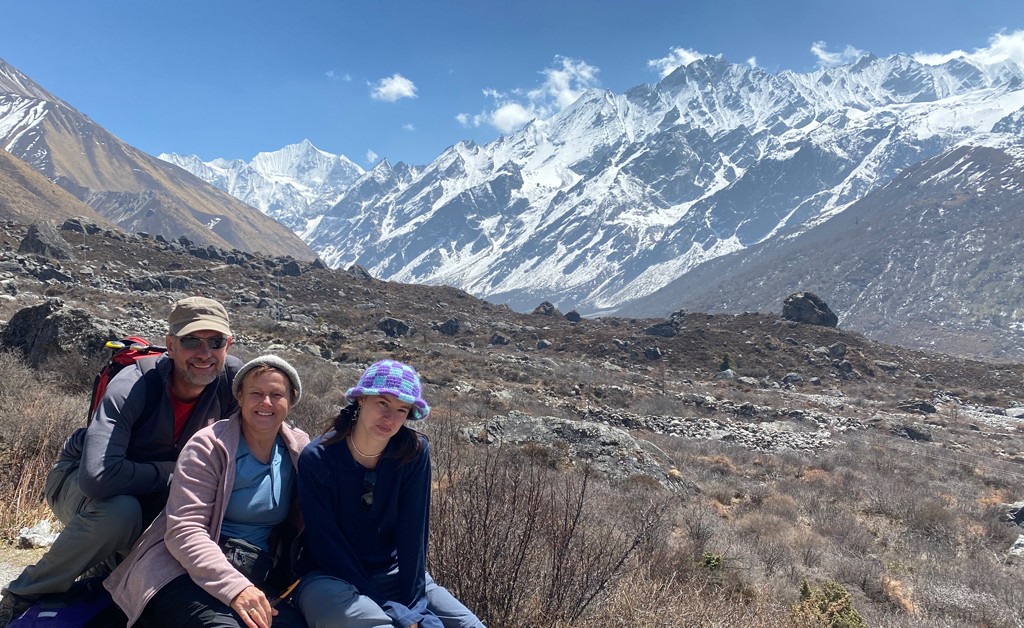
- Duration 13 Days
- Trip Start and End Kathmandu to Kathmandu
- Best Season All year round
- Trip Area Langtang Region
- Maximum Altitude 4773m.|15655ft. or 4984m.|16347ft.
- An adventurous trek in the Langtang region that also explore the Tamang Heritage trail and extends to the Helambu region
- The trail goes through the forests of rhododendron, bamboo, oak, pine, etc
- Overnight stay at beautiful villages resided by Sherpas & Tamangs
- Get to see the daily lifestyle and culture of the locals
- Come across lovely waterfalls, meadows and diverse flora & fauna while trekking
- Visit ancient Kyanjin Gompa and cross Lauribinayak pass
- Trek to holy Gosaikunda Lake and meet the indigenous group called Hyolmos
- Enjoy breathtaking sceneries, stunning glaciers, and snowy mountains views throughout the trek
The Langtang Circuit trek leads you close to the Tibetan border and a remote glacier valley called Langtang. It is one of the closest and least traveled trekking routes from Kathmandu that you can reach without taking any domestic flights. The trail winds through the Langtang National Park, a protected area and home to hundreds of flora & fauna. You trek by picturesque villages, lush rhododendron forests, cascading waterfalls, rivers, and meadows.
Enjoy the best of the Langtang region on our 13-day Langtang Circuit trek. Experience an authentic mountain lifestyle and witness heavenly mountain landscapes along the trail. Spend nights in beautiful villages, visit Kyanjin Gompa, unwind at the shore of Gosaikunda Lake, and have intimate encounters with the indigenous community of the Helambu region.
If you are aware of the Annapurna Circuit Trek and Manaslu Circuit Trek, then you must know how famous these two treks are. The Langtang Circuit trek is a great alternative to these well-known treks and also a budget-friendly trek. You get to enjoy a less crowded trail, excellent mountain views, an adventurous route, and the warm hospitality of the locals. Our Langtang Circuit trek of 13 days explores the beautiful Langtang Valley, some parts of the Tamang Heritage Trail, and extends to the sacred Gosaikunda Lake & Helambu region.
Learn about the culture & traditions of Tamangs & Sherpas on this trek. During your night stay in villages like Sherpa Gaun (2563m.|8406ft.) and Thyangsyapu (3140m.|10299ft.), you'll get to see their unique daily lifestyle. The trail then takes you to ancient Kyanjin Gompa (3870m.|12696ft.) and ascends to Gosaikunda Lake (4380m.|14366ft.). It is a holy lake and a pilgrimage site. This trek is also known as Langtang Gosaikunda Helambu Trek because the next part of the trek crosses the Lauribinayak pass (4610m.|15120ft.) and joins the stunning Helambu region.
Mountain Views & Close Encounters with the Locals
Langtang Circuit Trek is heaven for landscape lovers. This part of the Himalayas boasts storybook-like scenery and tranquility. You will be amazed by the hospitality of the locals and the mountain views. Some of the mountains you can see during the Langtang Circuit trek are Langtang Lirung (7234m.|23734ft.), Ganesh Himal (7422m.|24350ft.), Dorje Lhakpa (6966m.|22854ft.), Shishapangma (8027m.|26335ft.), Kang Guru (6981m.|22904ft.), Annapurna Ranges, Mt. Everest (8848.86m), etc.
As most of the time, you'll be walking through forests of rhododendron, bamboo, oak, etc, you may get to see wildlife like monkeys, deer, red panda, etc. Langtang Circuit Trek lets you make lifelong memories with your loved ones. You'll get a chance to bond and understand each other better. Every step of the trek does bring challenges but also lets you test your endurance & breathtaking views motivate you to move further.
Why trek with Nepal Nirvana Trails?
At Nepal Nirvana Trails, you get more than two decades of expertise in the travel industry. The team has multiple generations working together, so you'll have a very different trekking experience. You can see our itineraries are very different and designed to serve all kinds of travelers.
The Langtang Trek with Gosaikunda & Helambu is one of our best adventurous treks for 2024. We assure you of a safe and satisfying venture in the Himalayas. Our team members are very professional and friendly. We make sure all the journeys with us are special.
If you are looking to do a short trek in the Langtang region, then check out our Langtang Valley Trek and Gosaikunda Trek . These two are short and moderate treks. Similarly, here are some other less-visited adventurous trekking packages for you- Makalu Base Camp Trek , Kanchenjunga Circuit Trek , Upper Mustang Trek, Annapurna Circuit with ABC Trek , and Everest Three High Passes Trek .
Day to Day Details
Day 1: drive to syabrubesi (1460m.|4790ft.) 7-8 hrs.
We will start the trip by traveling to Syabrubesi from Kathmandu. We will go on the local bus through the Pasang Lhamu Highway and the Trishuli Dhunche Highway, viewing the Trishuli river basin, huts, terraced fields, and brick homes along the road. We will travel upward to Dhunche before reaching Syabrubesi.
- Breakfast, Lunch and Dinner
- 1460m.|4790ft.
Day 2: Syabrubesi to Sherpa Gaun (2563m.|8406ft) 6-7 hrs
Today is the beginning of the Langtang trip. We will follow the pathway close to the Bhote Koshi River. The path also ascends through a lush forest. The national bird of Nepal, the Himalayan Monal, can be encountered during our trek. Rhododendron trees with different colored flowers widely dispersed can be seen. We will reach Sherpa Gaun by strolling up these lovely paths.
- 2563m.|8406ft.
Day 3: Sherpa Village to Thyangsyapu (3140m.|10299ft.) 6 – 7 hrs
After breakfast, we will head to Langtang Valley, the hidden gem of the Langtang region. While strolling within the limits of Langtang National Park, we will get a glimpse of the incredible local fauna. As we reach the breathtaking majesty of Langtang, we experience nature's beauty in its purest form. The woodland stroll will take us through Ghodatabela. After gradually rising through the little settlements, you will eventually arrive at Thyangsyapu.
- 3140m.|10299ft.
Day 4: Thyang syapu to Kyanjin Gompa (3870m.|12696ft.) 4 – 5 hrs
After breakfast, we will move toward Kyanjin Gompa, taking in the beautiful surroundings and the thick forest beyond. On our route to Mundu, we will stop at the traditional Buddhist Monastery, which was affected by an earthquake in April 2015. The place we are going is one of the highlights of the Langtang Trek as we travel the Kyanjin Gompa. We will appreciate everything about this monastery. The area around the monastery is peaceful. Outside the monastery, there is a fantastic ambiance and a breathtaking view of mountain ranges.
- 3870m.|12696ft.
Day 5: Acclimatization day: hike to Tserko Ri (4984m.|16347ft.) or Kyanjin Ri (4773m.|15655ft.)
Today is a good day to unwind, explore, or become acclimated. We get the whole day to discover the landscape around Kyanjin Gompa. We may visit the monastery or the cheese factory. Then, we will hike to one of the famous spots in the area for 360-degree panoramic mountain views, Tserko Ri (4984m. | 16347ft.). Admire the vistas of Himalayan peaks and the sunshine shining over them. Once we reach the highest point of the viewpoint, we will have climbed to an altitude of 4984m.|16347ft. Then Return to the Kyanjin Gompa. We can also hike to the Kyanjin Ri (4773m.|15655ft.), which also offers the vistas of the Himalayan Ranges.
- 4984m.|16347ft.
Day 6: Trek to Rimche (2455m.|8053ft.) 7 – 8 hrs
After visiting Kyanjin Gompa, which gives a stunning view of the valley encircled by high peaks, we will hike to Rimche. After traveling through lush green woods, Langtang villages, Ghodatabela, and Gumnachok, we will ultimately arrive at Rimche. We will spend the time strolling alongside the captivating Langtang River and mountain views.
- 2455m.|8053ft.
Day 7: Trek to Foprang Danda via Thulo Syabru (3030m.|9939ft.) 5 – 6 hrs
From Rimche, our journey will start with a short climb through bamboo forests to the towns. After traversing the Langtang River, we will reach the bamboo village. We will keep going until we get to the top of a ridge, where we can gaze out over the Thulo Syabru valley in awe. After passing a bridge, we begin a slow drop. We will enjoy the stunning view of the Manaslu, Langtang, and Annapurna peaks. By making our way down the route, we will reach Foprang Danda.
- 3030m.|9939ft.
Day 8: Trek from Foprang Danda to Laurebina (3910m.|12828ft.) 5 – 6 hrs
We will begin our trek after enjoying a delicious breakfast at Foprang Danda. We will be mesmerized by Dhunche Town's breathtaking scenery. A beautiful route in Sing Gompa leads through a couple of cheese factories. We get to taste some of the finest yak cheese in Nepal. While walking through the trails among the pleasant pine and rhododendron woods, we will climb to Lauribna. Along the walk, there is a variety of plants and fauna. The majority of the red panda, also referred to by the Nepalese as cat bears - can be found here.
- 3910m.|12828ft.
Day 9: Trek from Laurebina to Gosaikunda (4380m.|14366ft.)
Our walk will begin with a tough ascent from Lauribina as we proceed to the most pristine holy lake, Gosaikunda. From the top of the Lauribina, we can admire the breathtaking Himalayan landscape. We will traverse a little slope and get the first glimpse of Gosaikunda Lake. The Gosaikunda area contains several lakes, but the three largest lakes are Bhiaravkunda, Saraswatikunda, and Gosaikunda. As we get closer to Gosaikunda, we see the entire lake. Thousands of worshippers travel to Gosaikunda every year around the August full moon during the Janai Purnima festival. Most hikers use this path mostly because it passes by Gosaikunda, one of the highest lakes in Nepal.
- 4380m.|14366ft.
Day 10: Trek from Gosaikunda to Ghopte (3430m.|11250ft.) via Lauribinayak pass 4610m/15’120ft, 7-8 hrs
After breakfast, we move forward on our trek. The route leaves Gosaikunda and ascends via rough terrain, passing small lakes to the highest point of this journey, the Laurebina pass (4610m). As we hike, we will glance at breathtaking views of Manaslu, the Ganesh Himal, and even the Langtang Lirung. The route becomes more difficult as we reach the pass. Passing the Lauribina La, we will descend toward Ghopte, taking in the spectacular scenery from the edge of the pass. The route traverses a bridge and passes by Phedi.
- Guest House
- 3430m.|11250ft.
Day 11: Trek from Ghopte to Kutumsang (2470m.|8101ft.) 6-7 hrs
We begin our journey, moving to the Helambu trail. It takes us an enjoyable hour and a half to go through the alpine forest to Thadepati, where we eat lunch and take in vistas of the snow-capped mountains of the Jugal Himalayan peaks in the east and Ganesh-Manaslu in the west. The path has several difficulties. We pass by remote areas while walking through Juniperus, pine trees, and rhododendron orchards. Following the route to Thadepati, we will descend to a ridge's western slope. We will go to Magin Goth and Kuala Bhanjyang. After there, a downhill track will lead us to Kutumsang, where we will spend the night.
- 2470m.|8101ft.
Day 12: Trek from Kutumsang to Chisapani (2165m.|7101ft.) 6 - 7 hrs
After breakfast, we will continue to rise through the track until it reaches a pass, then descends steeply, reaching Gul Bhanjyang, where it continues for another 3–4 hours to Pati Bhanjyang. Once we reach Thorong Danda, the route ascends and takes us to the chipping village. A short ascent leads from here to the overnight stay at Chisopani danda.
- 2165m.|7101ft.
Day 13: Trek to Sundarijal via Burlang bhanjyang pass and Drive to Kathmandu (1400m.|4593ft.)
We will begin our final day trek of this lovely adventure, witnessing some of the gorgeous mountains on the backdrop of the hills. The hike descends to Sundarijal across a pleasant forest with monkeys and fresh water flowing in between, which is a popular picnic spot for many locals who want to escape busy, populated metropolitan existence of this ancient city, Kathmandu. We travel to Kathmandu after continuing to descend from Sundarijal for another hour.
- Breakfast, Lunch and Farewell Dinner
- 1400m.|4593ft.
Want to customize your trip? Share your holiday plans. Our travel experts create an awesome trip for a lifetime experience holiday.
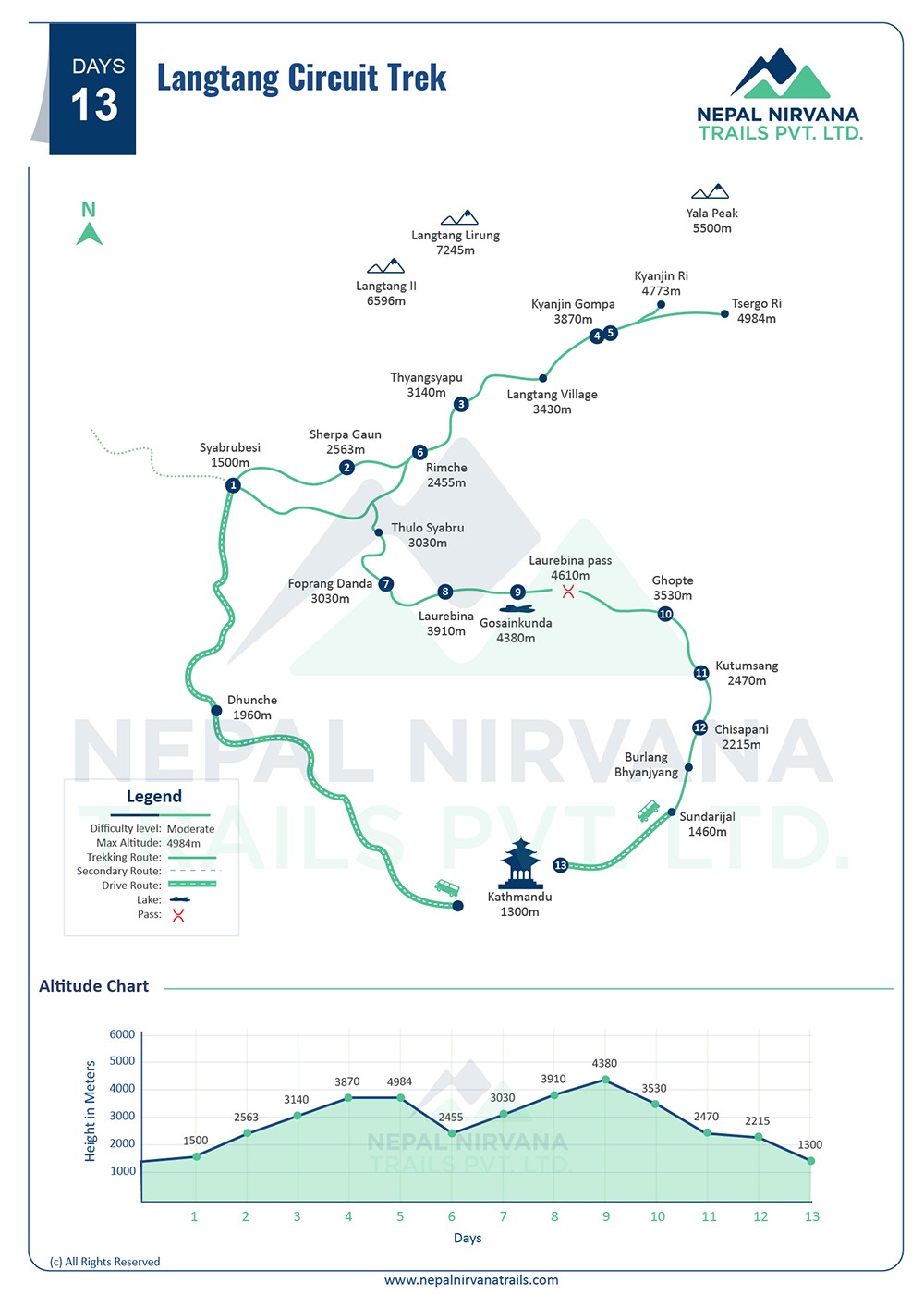
What's Included
- Complimentary airport transfer services during arrival and departure
- 3 Meals (Breakfast, Lunch, Dinner) and tea, or coffee while on the treks
- Seasonal fresh fruit each day
- Accommodations during the trek
- First aid trained, English-speaking government-licensed trekking guide, and his salary, meals, and equipment
- All required national park, and TIMS permits
- Public bus services Kathmandu - Syabrubesi
- Sundarijal to Kathmandu Private jeep/ car Transport
- Water purification tablet
- Souvenir: T-shirt, Trekking map
- Government tax, VAT.
What's Excluded
- International flight
- Travels and health Insurance which include emergency rescues and evacuations
- Personal expenses, all beverages, WI-FI
- Private Jeep from Kathmandu to Syabrubesi: USD 200
- Porter: USD 260
- Kathmandu hotel
- Tips for treks guide, porter (expected)
The package provides an affordable way for budget-conscious trekkers to explore the Langtang Region. However, there is also the option to enhance your experience with add-ons to the package.
Porter Service
You have the option to include a porter in addition to your guide. The porter carries a load of up to 20 - 25 kilograms. You can share the heavier belongings with the porter, allowing you to trek more comfortably and with the guidance of your trekking guide.
One Porter Costs: USD 260
Private Transportation
We offer regular local bus transportation between Kathmandu to Syabrubesi with the package.
Alternatively, you can opt for private transportation for an additional fee, which covers the journey from Kathmandu to Syabrubesi.
- Private Jeep for the Trek Costs: USD 200
Upcoming Departures
Useful info, langtang circuit trek difficulty.
Langtang Circuit trek 13 days is one of the moderate treks in the Langtang region. The trail encompasses the Langtang National Park and ascends to a high alpine lake before crossing a pass and joining the trodden Helambu region. The trail explores the isolated area with dense forests and small villages in between.
The constant ascents & descents, high elevation, and rugged paths make the journey challenging. For beginner trekkers, this trek is also suitable as their first attempt. You'll be spending a long time in the mountains away from the comforts of the modern city. Taking all these factors into consideration, the Langtang Circuit trek is much more demanding than you may have imagined.
Altitude Sickness
The risk of altitude sickness during the Langtang Circuit trek is common, and by taking proper measures you can easily avoid it or cure it. We do take all the precautions, still, you may see symptoms. Our trained guide will make sure you get proper attention during the trek if any medical help is needed. The moment your body begins to dehydrate and experience a lack of sleep, you'll be inviting altitude sickness. So, drink a lot of water, eat nutritious meals, and get plenty of rest.
Langtang Circuit Trek Permits
Below is the list of permits you need for Langtang Gosaikunda Helambu trekking. All the mentioned permits are included in the package cost, and the team gets them on your behalf.
- Langtang National Park Entry Permit
- Shivapuri National Park Entrance Fees
Best Time to go on Langtang Circuit Trek
The best time to do the Langtang Circuit trek is Mid-February to May and another time is from August to Mid-December. The mild climate and stable weather make the journey fantastic. The trail thrives with seasonal flowers and vegetation. The mountain views are fantastic and the night sky is full of stars. This trek can also be doable all around the year.
Last Minute Booking
Before booking the Langtang Circuit trek at the last minute, you should know all the challenges this trek has and the limited time you have to prepare for it. The booking also requires full payment for the trip confirmation, and canceling the last-minute booking may cost you 10% of the package cost as a cancellation charge.
Besides that, to place a last-minute Langtang Circuit trekking booking, go to our package page and click on the booking button. Fill in the necessary information and pay the package cost. Or, you can contact us for any further questions or booking assistance.
Accommodation & Meals
Langtang Circuit trek via Gosaikunda Lake involves teahouse accommodation. It's a simple accommodation with a shared washroom (most of the time) and basic services. The tea houses are operated by the locals and similar to their own living style. The rooms are twin shared (unless you request a single room). The bedding is clean and comfortable.
We have all the meals in the tea houses along the Langtang Circuit trails. The meals are given as per the menu of the teahouses. The most common meal is dal bhat. It's an authentic staple Nepali meal with lots of flavors and side dishes. Other options are momo, different kinds of Tibetan bread, Chapati, Potato items, noodles, chowmein, pasta, thenduk, soup, porridge, etc. For beverages, there are tea, coffee, milk, soft drinks, etc.
Note : The ingredients in a food item can be removed if you are allergic to any foods. Vegan food is also available.
Travel Insurance
Given the high altitude and remoteness of the Langtang Circuit trails, we need travel insurance that covers medical bills and emergency evacuation. Travel insurance is used if there is a need for immediate medical assistance that is beyond the control of first aid. There is no good healthcare infrastructure in the Langtang region, so we need to air evacuate the patient to a nearby hospital in Kathmandu (if needed).
Travel Tips (electricity, internet, ATM, luggage, tipping, personal expenses)
- The charging facility is good in the Langtang region. You may have to pay a few bucks to charge your devices because most of the teahouse owners rely hugely on solar energy too.
- Langtang Circuit trail has no ATM, and the locals do not accept foreign currency or Credit/Visa cards. So, it's better to withdraw cash in Kathmandu.
- The internet facility is not good as you might have guessed. Some teahouses do offer paid WiFi services, but the connection is questionable. The best choice is using cellular data, which is more economical too.
- The duffel bag weight limit is 10 kg per trekker. And you can carry up to 5 kg of the backpack on you.
- The tip is not covered in the Langtang Circuit trek package cost. You are free to tip as per your wish. We highly recommend you to feel free to tip our crew members for their hard work.
- Have an additional budget for personal expenses like charging, wifi, shopping, tips, etc.
- Most of the trekking clothes and gear are easily available to buy/rent in Thamel. So, you do not have to carry everything from your home.
Q1. How long is the Langtang Circuit Trek?
The Langtang Circuit trek varies from 13 days to 20 days. Our Langtang Circuit trek package is 13 days long.
Q2. How difficult is Langtang Circuit Trek?
Langtang Circuit trek is a difficult trek. The trek includes 6 hours of minimum walk each day. You live in basic accommodation and modern facilities like internet, TV, etc are less to none. You walk on steep slopes and rocky paths. The trek overall has a lot of hurdles.
Q3. Do you need a guide for Langtang Circuit Trek?
As per government rules and regulations for the Langtang Circuit trek, you do not need a guide. You can do Langtang Circuit trekking solo. However, given the difficulty, altitude, isolation, and unseen risks along the trail, we do not recommend the Langtang Circuit trek without a guide. The trail crosses high pastures and passes. Professional guidance will make the journey hassle-free, fun, and smooth for you.
Q4. What should I bring to Langtang Circuit Trek?
You do not need any advanced trekking gear for the Langtang Circuit trek, but you have to be well packed in terms of trekking clothes & basic gear such as a trekking pole, trekking boots, sleeping bag, pocket torch, reusable water bottle, et. While booking, our team will provide you with a packing checklist that you can follow to pack for this trek.
Q5. What is the location of the Langtang circuit trek?
The Langtang Circuit trek explores the Langtang region & the Langtang National Park, which is located northeast of Kathmandu. It's only a 68 km drive from Kathmandu to the starting point of the trek. The Langtang Circuit trekking also takes you close to the Tibetan border.
Q6. Can we customize the Langtang valley trek itinerary account to our needs?
Yes, you can customize the Langtang Circuit trek itinerary with us. You can change the departure date, cost, duration, and services as per your requirements & budget.
Q7. Where can you get a bus to go to the Langtang trek?
The bus to the Langtang region is available in Machhapokhari. The buses are open early in the morning. You have the option to drive to Syabrubesi or Dhunche. Both are the trailhead of Langtang Valley.
Q8. What is the fare of a local bus from Kathmandu to Syabrubesi?
The fare of a local bus from Kathmandu to Syabrubesi may be difficult according to the comfortability of the bus. The bus owner may charge foreigners a bit high.
Q9. What is the maximum altitude that we hike in Langtang Circuit Trek?
The maximum altitude reached during the Langtang Circuit trek is Tserko Ri (4984m.|16347ft.) or Kyanjin Ri (4773m.|15655ft.). There are two other high points touched during the trek. They are Gosaikunda Lake (4380m.|14366ft.) and Lauribinayak pass (4610m.|15120ft.).
Client Reviews
Langtang trekk
Brilliant team, very helpful and quick responses when you need to make last minute changes or adaptions. The Group where very informative prior to choosing which trekk we wanted. And kept in contact the whole way. Trekking is very hard work so practice beforehand. Shop opposite is brilliant for outdoor gear. Our guide was amazing throughout and really made the trip.
Dear Jemma, Namaste! Thank you so much for taking the time to share your positive experience with us! We're thrilled you had an excellent trek to the Langtang with the guide, Sukram. We hope to welcome you back for another unforgettable trek in the future! Best Regards, Kp Dhital and Nepal Nirvana Trails Team. WhatsApp: +977 9841380469
Yum snacks, good times
I did a 12 day trek through Langtang Valley and over to Helambu with Prajil as my guide. Had a beautiful time, everything was taken care of and Prajil was awesome to make sure I had options for where to go and stay, depending on how I felt and how my bad knees were feeling! Tea and fruit snacks included which was a bonus for me! Great vibes as solo person and the nature too of course was stunning 😊
Dear Beth, Namaste! Thank you for leaving a review about your experience at the Langtang Circuit Trek with our guide Prajil. We are glad to hear about your experience with the Nirvana Team. We look forward to providing services again. est regards, Kp Dhital and Nepal Nirvana Trails Team. WhatsApp: +977 9841380469
Similar Trips
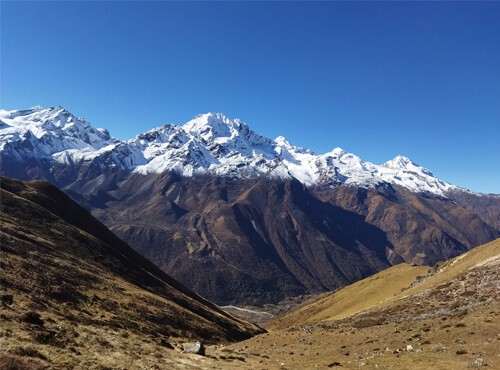
Langtang Budget Trek - 8 Days
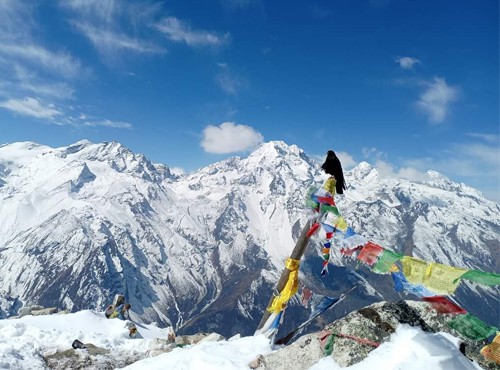
Tamang Heritage and Langtang Valley Trek - 13 Days

Langtang Valley Trek - 11 Days
Ask a question.

Are you looking for the Nepal holiday? or need help to plan a trip, please do not hesitate to get in touch with us.
We use cookies to ensure that we give you the best experience on our website.
Get Instant Response:
- Hillary Classical Trek – 17 Days
- Everest Base Camp Trek – 14 Days
- Everest Three High Passes Trek – 18 Days
- Everest Base Camp Trek Via Gokyo Lake – 15 Days
- Everest View Trek – 5 Days
- Gokyo Renjo La Pass Trek – 13 Days
- Everest Base Camp Trek Heli Return – 10 Days
- Everest Base Camp with Island Peak Climbing – 16 Days
- Everest Base Camp with Lobuche Peak Climbing – 16 Days
- Everest Panorama Trek – 7 Days
- Luxury Everest Base Camp Trek – 12 Days
- Ama Dablam Base Camp Trek – 8 Days
- Short Everest Base Camp Trek – 10 Days
- Gokyo Ri Trek – 10 Days
- Annapurna Base Camp Trek – 7 Days
- Annapurna Circuit Trek – 14 Days
- Annapurna Base Camp Trek via Poon Hill – 13 Days
- Annapurna Circuit Trek with Annapurna Base Camp – 20 Days
- Annapurna Circuit Trek with Tilicho Lake – 15 Days
- Nar Phu Valley Trek – 14 Days
- Poon Hill Trek – 7 Days
- Upper Mustang Trek – 15 Days
- Mardi Himal Trek – 5 Days
- Khopra Danda Trek – 8 Days
- Annapurna Base Camp Trek with Helicopter Return – 8 Days
- Annapurna Sanctuary Trek – 10 Days
- Short Annapurna Circuit Trek – 10 Days
- Manaslu Circuit Trek – 13 Days
- Manaslu Tsum Valley Trek – 20 Days
- Tsum Valley Trek – 16 Days
- Langtang Valley Trek – 8 Days
- Langtang Gosaikunda Trek – 13Days
- Gosaikunda Trek – 5 Days
- Tamang Heritage Trail – 7 Days
- Kanchenjunga Trek – 22 Days
- Pikey Peak Trek – 6 Days
- Mera Peak Climbing – 13 Days
- Lower Dolpo Trek – 15 Days
- Island Peak Expedition – 15 Days
- Mera Peak Climbing – 15 Days
- Legal Documents
- Terms & Condition

Langtang Valley Trek - 8 days
Starting from
Starting Price USD 690
Group Size 1+
Trip Grade Modarate
Best Season March - May, October - December
Accommodation Hotel/Tea House
Max Elevation 4984 m
Meals Full Board
Transportation Private Vehicle
Trek Route Syabrubensi-Langtang Village- Kyanjin Gompa
Trip Highlights
- Witness magnificent views of sky-touching mountains including the beautiful peaks of Dorje Lakpa, Langtang Lirung, and Langtang Ri.
- Enjoy trekking on well-established and less crowded trails in the Himalayas of Nepal for a peaceful trekking adventure.
- Walk through Langtang National Park while exploring incredible flora and fauna in nature.
- Immerse yourself in the traditional art, culture, and lifestyle of the local people in the Langtang region.
- Witness sublime views of the landscape and surrounding nature from either Tserku Ri, Langshisa Kharka, or Kyanjin Ri.
Trip Overview
The Langtang Valley Trek offers a beautiful blend of nature, culture, and adventure, making it a perfect choice for trekkers of all kinds. Hillary Step Treks presents Langtang Valley Trek 8 days package for trek enthusiasts to explore the magical Langtang Valley, a hidden gem that comes to life with vibrant sights and sounds. Nestled in the heart of Nepal, this trek is perfect for all kinds of trekkers and provides a remarkable experience for travelers with different levels of trekking expertise.
As you embark on this unforgettable journey, the valley has breathtaking views at every turn, surrounded by majestic snow-capped mountains. The towering peaks, such as Langtang Lirung , Dorje Lakpa, and Langshisa Ri, create a stunning backdrop against the clear blue sky. However, it is not just the mountain vistas that will leave you in awe during our Langtang Valley Trek 8 days trip. The pleasing landscape of Langtang Valley also features lush forests, cascading waterfalls, and meandering rivers. Moreover, the serene and pristine environment offers a peaceful respite from bustling city life, allowing you to reconnect with nature and rejuvenate your senses.
One of the other excellent features of the Langtang Valley Trek is the warm and welcoming atmosphere of Langtang National Park. As you traverse through the park, you’ll encounter a rich diversity of flora and fauna, including rhododendron forests, bamboo groves, and rare wildlife such as red pandas and Himalayan black bears.
In addition to breathtaking scenery and natural wonders, the Langtang Valley Trek 8 days trip also provides an opportunity to immerse yourself in the local culture. Along the trail, you’ll encounter traditional Tamang and Sherpa villages, where you can interact with friendly locals and learn about their way of life. Experience their warm hospitality and witness cultural traditions that have been passed down through generations. Additionally, the walking days are also well balanced in our Langtang Valley Trek 8 Days and you will find something special for each day as you explore Langtang.
Just so you are aware, the Langtang Valley trek distance covers 70 km/43 miles from Syabrubensi to Kyanjin Gompa and back upon completion of the trek with HST. To represent the cost, the Langtang Valley trek cost may vary depending on numerous factors including season of travel and group size. On average, our Langtang Valley trek cost ranges from USD 449 to USD 690. If you have more time, you can continue 13 Days Langtang Gossainkunda Trek
More Travel Blogs/Guides for Langtang Valley Trek
A complete guide for Langtang Valley Trek in 2023
Best Side Trips Around Langtang Valley
Day to Day Itinerary
Drive from kathmandu(1,359m/4,429ft) to syabrubensi (1,460m/4790 ft) by bus.
On your first day of the Langtang Valley trek itinerary, you will embark on the scenic drive to Syabrubensi from Kathmandu.
In the early morning, our representative will pick you up from your hotel and escort you to the bus station. From here, the scenic drive takes you through the rough high hills of Nepal to arrive at the rural hills of the Rasuwa district . In the midway settlements, we will take a break for lunch. Then, the further drive will take you through scenic landscape and scenery before reaching Syabru in the afternoon.
Upon arriving at Syabrubensi , you will check in to the hotel and the balance day is for rest and refreshment. Stay overnight in Syabrubensi
Trek from Syabrubensi (1,460m/4,790ft) to Lama Hotel (2,470m/8,103ft))
The second day of the Langtang Valley Trek veins with a sense of excitement and anticipation. Leaving behind the cozy village of Syabrubesi, you will embark on a journey that will lead you to the enchanting Lama Hotel.
Crossing the bridge nearby, you will begin by following a ride-side path on the trekking trails toward the Lama Hotel. The trail is comfortable and the astonishing surrounding views introduce you to the beautiful Langtang region.
During the journey, we will take a break at the picturesque Riverside teahouse to enjoy lunch. Afterward, you will continue walking on a gradually ascending trail to arrive at Rimche. From here, it takes a further 25 minutes on an easy trail to reach Lama Hotel. Stay overnight at a teahouse in the Lama Hotel.
Trek from Lama Hotel(2,470n/8,103ft) to Ghodatabela to Langtang Village (3,430m/11,253ft))
On the third day of the Langtang Valley Trek itinerary, the trail takes you deeper into the heart of the Langtang Valley, promising breathtaking vistas and cultural encounters that would leave a lasting impression.
From the beginning of the day, you will witness the change in the landscape and trail as you begin to feel the majestic snow-capped peaks getting nearer and nearer. Admiring the natural beauty, you will pass through a steep jungle trail alongside a wide and open terrain to arrive at Ghodatabela. Here, you will take a break to catch your breath, soaking in the panoramic views of the surrounding mountains and the tranquil beauty of the valley. The break is also for relishing the lunch.
Leaving Ghodatabela after lunch, the trail passes through the landslide-engulfed Langtang Village and takes you to the newly reconstructed village on the other side. Stay overnight in a teahouse/lodge in Langtang Village.
Trek from Langtang Village(3,430m/11,253ft) to Kyanjin Gompa (3,900m/12,795ft)
Today, the short trekking trail weaves its way through rugged terrain and captivating landscapes, as you make your way towards the enchanting destination of Kyanjin Gompa. Before leaving the Langtang village, you will have time to explore the village with an opportunity to interact with the locals. Draw upon the opportunity to hear their stories and learn about their unique culture, tradition, and way of life.
After a late breakfast, you will continue the trek ascending steadily, each step bringing you closer to the sky-piercing heights of the Langtang region. The path unveils breathtaking panoramas at every turn, offering glimpses of majestic peaks on your way to Kyanjo Gompa.
Kyanjin Gompa is a fantastic example of traditional Himalayan settlements in Nepal. Upon arriving at Kyanjin, you will visit the historic Kyanji Gompa monastery and join the monks for their evening prayer. Stay overnight at a teahouse in Kyanjin.
Excursion day (Kyanjin Ri, Tserku Ri, or Langshisa Kharka)
Kyanjin Gompa includes some amazing trails that lead the trekkers to the surrounding natural viewpoints and peaks. On this day of the captivating Langtang Valley Trek, you can choose one from the three of the popular day hike options in the region – Tserku Ri (4983 m), Kyanjin Ri (4773 m), and Langshisha Kharka (4325 m). All of this hiking can be completed in around 5 hours and amazes you with fantastic views of the astonishing Langtang range. Plus, you will also have to go over the 15000 ft mark which itself is an amazing milestone to achieve.
After accomplishing the hike, take a rest for the remaining day in a teahouse. Stay overnight at Kyanjin Gompa.
Trek from Kyanjin Gompa(3900m/12,795ft) to Rimche (2,400m/7,874ft)
On the sixth day of our Langtang Valley Trek itinerary, you will bid a fond farewell to the enchanting Kyanjin Gompa with memories of the towering peaks and the warm hospitality of the locals etched in your hearts. Today, you will embark on descending trails that retrace your footsteps back toward Rimche. As you drop further, the trail and landscape change from barren lands to lush hills.
Once again, the beautiful scenic trail passes through Langtang, Ghodatabela, and Lama Hotel before you arrive at Riche. You will reach Riche in the late afternoon. We will have lunch here and then, you can explore the place and interact with the locals. In the evening, you will enjoy a beautiful sunset from Rimche before spending a night at a local teahouse.
Trek from Rimche(2,400m/7,874ft) to Syabrubensi (1,460m/4,790ft))
Today marks the last day for trekking on foot on our Langtang Valley Trek 8 days trip. The hike back to Syabrubensi is a short and relaxed one. Before starting the trek, you can visit the farms and spend some time interacting with the locals to learn about their life under the shadows of the Himalayas. You will arrive at Syabrubensi in the late afternoon, taking a rest at the riverside for lunch on your way.
Upon arriving at Syabrubensi, the remaining day is for rest at the hotel. Stay overnight in Syabrubensi.
Drive from Syabrubensi(1,469m4,790ft) to Kathmandu(1,350m/4,429ft) by bus
On the final day of the remarkable Langtang Valley Trek, you will start the day with relishing breakfast before you bid farewell to the scenic town of Syabrubensi. You will embark on the scenic drive to return to Kathmandu. The beautiful hills on rivers on the roadside will keep you entertained throughout the journey.
Upon arriving in Kathmandu, our representative will transfer you to your hotel in Thamel. You can spend the remaining day exploring the Thamel Market and buy souvenirs and gifts to take back home. Stay overnight at a hotel.
Cost Inclusion
Accommodation.
- 7 Nights Accommodation During the trek, Five nights Attached bath room with hot shower. Syabrubensi two nights, Langtang Village, Kyanjin Gompa for two night. Two nights Standard common accommodation at Lama Hotel & Rimche Village.
- All Standard meals (7 Dinner, 8 lunch & 7 Breakfast /the main course) while on the trek
Transportation
- Both Way Kathmandu to Syabrubesi & Syabrubensi to kathmandu by Public Transportation ( If you ask we can arrange private vehicle on extra cost)
- Langtang Nationalpark permit fees
- Trekker’s information management system (TIMS) cards fees
- Professional & government licensed holder English Speaking Trekking Guide
- Porter (2 trekkers: 1 porter)
- Staff costs including their salary, insurance, equipment, food and accommodation etc
- Sleeping bag
- Trekking Map
- First aid kit
- Cookies & Seasonal fruits everyday
- All government and Local Taxes
Not Included
- International Airfare
- Nepal Visa fees at Tribhuwan International Airport ( 15 Days- $30, 30 Days – $50, 90 Days – $125
- All accommodation & Meals in Kathmandu
- Extra nights accommodation in Kathmandu due to early return from the trek
- Travel & Health Insurance
- Emergency Helicopter Rescue Insurance
- All hard and soft table drinks such as Tea/Coffee, Coke, Fanta, Beer, Water and deserts in trek
- International call/WIFI & Internet on trek
- Your trekking gear
- Tips for guides and porters
Trekking Information
Benefits of choosing hillary step treks(hst).
Our experienced team of over one decade has accomplished treks in Langtang Valley Treks and other treks too.
Our guides are fluent in English, and Nepali dialects. They are familiar with the terrain, culture, and people in the Langtang region to the core.
HST provides you with the best value services for your money. No hidden cost, every step with HST is transparent and clear. We value our clients over profit any day.
Your safety is the top priority while trekking with the HST team. Thus, in case of an emergency, a first-aid kit or provision of rescue teams are always in place.
We are a government-registered company providing you with real care services at the best reasonable rate.
Our company also has 70% repetitive clients over the years which shows their trust in us.
We go the extra mile to assure you of a complete trekking experience in Nepal. HST certainly is your ideal choice for trekking in Nepal.
Accommodation of Langtang Valley Trek
You will be staying in Tea Houses or local lodges for the whole duration of the Langtang Valley Trek. As soon as you leave Kathmandu, you will be traveling to the rural parts of the country where tea houses are more of a standard accommodation for trekkers. Your rooms are simple and you can expect sufficient basic services and facilities in these establishments. The teahouses will also provide you with food and shared dining rooms.
As for hot water and WI-FI availability, it is best to ask about them before choosing the teahouse. Also, inquire about the additional cost for the use of these services.
Meals & Drinking water
Meals in the Langtang trek are simple and prepared making the best use of the local organic ingredients. You can expect Dal Bhat and tea served at almost all the teahouses and hotels during the trek. A few other items that make it to the menu include popular snacks like bread, momos, chow mein, and so on. You can also find bakeries operating in major settlements like Langtang, Syabru, and Kyanjin here.
For drinking water, there are taps as well as freshwater streams straight from the mountain. We do suggest you ask for water refills at the teahouses and lunch stops just to be safe. Also, it is ideal to carry water purification tablets with you just to take additional precautions.
Langtang Valley Trek Packing List
Creating a packing list can be overwhelming when traveling to unfamiliar regions. Where do I start the packing checklist? What are the essentials that I can’t miss? And many such queries may arise. Don’t worry; we’ve got you covered on that one. Here is your packing guide to the Langtang Valley trek.
Upper Body: –
- A long-sleeve thermal base layer
- Trekking shirt
- Insulation layer
- fleece jacket
- Warm Down Jacket
- waterproof jacket
- T-Shirt lightweight
- Beanies and ear warmers
- Sunhat & Scarf
- Headlights with extra batteries
- Sunglasses with UV protection
- Face /Body wipe
legs & Boots:-
- Trekking Pants two pairs
- Trekking boots
- Sport Shoes
- Crampons (If snow or Ice)
- Thermal Leggins
- Underwear & thick Socks
List Of Clothing
Hiking Shorts
Comfortable Hiking Trousers
Wind Stopper Jackets
Non-cotton innerwear
Water-Proof Fabric Jackets, Pants
Light-Weight Thermal Tops & Bottoms
Woolen Trousers
Waterproof GoreTex Jackets
List Of Footwears
Light Weight Socks
Comfortable Hiking Shoes And Extra Shoelaces
Heavy Woolen Socks
Training Or Running Shoes
Cotton Socks Gaiters
List Of HeadWears
Sunglasses With UV Protection
Woollen Caps
Prescribed Sunglasses (if any)
Woolen Scarf
Headlamp Along With Extra Batteries And Bulbs
Personal Medical Kit
Simple And Light Medical Kit
Pain Killers
Skin-Blister Repair Kit
Anti-Diarrhoea Pills
Anti-Altitude Sickness Pills
Cough And Cold Medicines
Water Purifying Tablets
Stomach Antibiotic
Prescribed Medicines (If Any)
Essential Toiletries
Toothbrush And Toothpaste
Toilet Papers And Wet Wipes
Anti-Bacterial Handwash
Nail Cutter
Essential Documents
Trekking Permits
Travel Insurance
Tech Essentials
Camera, along with extra Batteries
Power Banks
Phone & Chargers
Adapter Plugs
Note: The above list can be customized as per the seasons and necessities of the trekkers .
Entry Permits for Langtang
You need a permit to enter and trek inside the Langtang National Park during the Langtang Valley Trek in Nepal. This permit will cost you around 30 USD per person and will last for the duration of the trek. Similarly, a Trekkers Information Management System (TIMS) card is also required for trekking in the Nepalese Himalayas. It will cost you 20 USD per person when applied in a group. You can get both these from the Nepal Tourism Board head office in Kathmandu.
Total Distance Covered During the Trek
The Langtang Valley trek distance covers 70 km/43 miles from Syabrubensi to Kyanjin Gompa and back upon completion of the trek with HST. The trek starts at an elevation of (1460m/ 4789ft) meters in Syabrubensi and reaches the maximum altitude of (5033m/16509ft) meters in Tserku Ri.
Difficulty Factor Of Langtang Valley Trek
The Langtang Valley trek is an easy to moderate-level trek. This trek does not require prior experience, skills, or knowledge. However, you need to get enough rest if you have any health conditions.
Our Langtang Valley trek 8 days journey starts at an altitude of 1460m. The trail includes; passing through the hill, forests, and rivers. The path through the hills gets narrow. Even so, the path is easy and not rugged. You will have a smooth experience passing through ethnic villages and radiant nature.
People of all age groups can do the Langtang Valley trek. This journey will be a good start if you have yet to gain experience in trekking.
Best time to Visit Langtang Valley Trek
Autumn is the best time for Langtang Valley Trek. During this time, the weather remains warm, pleasant, and stable. Therefore, going to the Langtang region during autumn will be the best decision as you get to see the marvelous blue skies, breathe fresh air, and have a clear view of the majestic mountains. Mornings might get chilly this season, but the temperature becomes more stable and pleasant as the day progresses.
Springs will be the second most preferred time to do the Langtang Valley trek in Nepal. Moderate and pleasant temperatures with the extraordinary sight of Rhododendron blossoms make spring a heavenly time for your trek.
Winter offers a fantastic view of the snow-covered Langtang Valley under deep blue skies. Periodic snowfalls and the chilly weather open another dimension of beauty. However, there are better times for trekking to the mountains than winter. If you want to travel to Langtang during winter, you must be prepared for heavy snowfall, harsh winds, and frosty weather. Trekking to Langtang during the winter is not recommended.
Monsoons follow summer in Nepal, and Rainy weather has its challenges. Rain invites bugs, worms, and leeches, along with slippery roads. So, summer is also not that favorable from a trekking point of view.
Hence, the best time to do the Langtang Valley trek is from September to Mid-December and March to May.
Travel Insurance for the trek
We recommend you get travel and medical insurance for the Langtang Valley trek. The Himalayas can get unpredictable at times and it is always a wise decision to get yourself covered. Make sure your policy also includes emergency helicopter evacuation, just in case. We can suggest some reputed international insurance companies for you while booking the trek with HST.
Electricity & Internet Availability
Electricity and Internet are available throughout the Langtang Valley trek. Both NTC and Ncell sim cards operate for most parts of the trail. Electricity is usually solar-powered and in some places, you might have to pay extra for charging your devices.
Altitude sickness and acclimatization
Altitude sickness is rare but not unheard of during the Langtang trek. Trekkers have to be especially cautious while hiking over Kyanjin Village i.e. during Kyanjin Ri (4773m), Tserku Ri (4983 m), and Langshisa Kharka (4325 m) excursion. Here are some preventive measures for altitude sickness.
– Rehydrate at regular intervals. Drink approx. 1 liter for every hour of walking.
– Avoid alcohol and overly salty food.
– Rest and get the appropriate amount of sleep.
– Do acclimatization hikes and warm-up exercises to prepare your body for high altitude.
– Take medicine if necessary by consulting with your guide.
Reaching Syabrubesi:- the starting point of Langtang Valley Trek
Syabrubesi will be the starting point of the Langtang Valley trek and it is only accessible by road. Local buses operate from the Macchapokhari Bus stand to reach there and the fare is around 10 USD as of date. You’ll have a midway lunch stop and the whole journey will take you around 6-7 hours. For big groups of trekkers, you can hire a tourist bus for slightly more cost to drive you to Syabru.
Your second option to reach Syabru is with a private vehicle i.e., a Jeep or Car. This tends to be much more expensive than taking a local bus. However, you can experience a comfortable ride with the freedom to stop in between while taking a private vehicle to Syabrubesi. Syabru is a small town just beside the Trishuli River and will be an ideal starting point to attempt the Langtang village trek.
You Might Be Interested In:
Langtang Gosaikunda Trek .
Photo Gallery

FAQs of Langtang Valley Trek
Why trek with hillary step treks.
Hillary Step Treks is regarded as one of the best trekking companies in Nepal. We have extremely experienced staff who have viable knowledge of all the treks and tour operations in Nepal. They have a reputation for successfully leading different types of treks and providing you with different types of services to make your stay memorable.
We are also an extremely charitable company that focuses on giving back to the community by getting involved with several cultural, religious, and eco-friendly activities.
Do I need to hire a guide and porters during my trek?
As of April 1, 2023, a new rule requires that visitors to any trekking spots in Nepal must hire at least one guide. This regulation aims to enhance safety and security for tourists, addressing the rising concerns regarding tourists going missing or requiring rescue. Guides help you explain more about the region, help in securing lodges, and hotels, and can even help you get helicopter rescue.
In the case of porters, although hiring them is not compulsory it is recommended. The porters carry heavy loads and have access to yaks, mules, and other animals to carry heavy loads of entire groups. They are also familiar with the local area and will help you in case of any type of emergency.
Can your guides speak English?
Our guides speak English fluently to ensure effective communication throughout your journey. They will share intriguing stories, traditions, and folklore of the mountains, making your experience more enriching. Furthermore, they will help you converse with locals as most shopkeepers and teahouse hosts may not be able to speak English.
Can I get an arrival visa in Nepal?
For any foreign nationals, you must apply for a visa to enter Nepal. Citizens from many countries listed on the Nepal Tourism Board can also get their visas on arrival. You just have to fill up the Nepal Visa application form at the Nepal immigration website.
To get your application verified you must submit certain documents like your original passport and at least one passport-size photo. Now pay the visa charge fee listed below and within a few hours your Nepal visa will be on your hand.
- Visa fee for up to 15 Days: USD 30
- Visa fee for up to 30 Days: USD 50
- Visa fee for up to 90 Days: USD 125
Do I need to add extra days as delays while booking to/from Nepal?
It’s always wise to add a day or two before and after your intended trek to cover the possibility of delays. Sometimes an unforeseen situation arises like flight delays and cancellations so it is wise to cover those days by booking a couple of days early.
The extra days or time will also give you time to purchase any necessary clothing. Gears or equipment if you need it. You must also keep in mind that Hillary Steps Treks is not responsible for missed international flights or delays.
Which is the best season for trekking in Nepal?
The best season for trekking in Nepal is generally a debate between Autumn or Spring. The months of September to November fall under the autumn season and the months between March to May fall under the Spring Season. During these two seasons, the temperature and weather are moderate to trek and there is less chance of rainfall and snowfall.
In certain Himalayan areas, the Winter season is also considered optimal for trekking. During the winter season, the temperature drops considerably below freezing point and there are chances of regular snowfall and snowstorms. Monsoon season is the worst of all the seasons because of continuous rainfall.
Do I need any kind of experience to trek in Nepal?
Trekking in Nepal presents challenges, yet it is not impossible. The difficulty of treks varies based on the region and the type of trekking you choose. While prior experience can enhance your adventure, it is not essential.
In recent times you must hire at least one authorized guide with you. These guides will help you in any kind of emergency or medical help. You can also hire porters from the local area to make your experience even more enjoyable and distribute your burden. With the assistance of guides and porters, completing a trek in Nepal is easily achievable even without prior experience.
Do I need permits for trekking in Nepal?
Yes, You need some important permits for any kind of trekking in Nepal. First of all, you need the TIMS Card which is also known as the Trekkers Information Management System which records all the data of the trekkers and tourists visiting the country. This card is mandatory for any type of trekkers who want to trek in any region of Nepal.
If you’re planning to trek in a conservation area, you’ll need a permit for that area. For example, if you are trekking the Everest region you must issue a Sagarmatha National Park permit and if you are visiting the Annapurna region then you need Annapurna Conservation Area Permit. There are few other trekking permits for other trekking regions in Nepal.
Can I withdraw or exchange money during the Langtang Valley Trek?
You can withdraw money at an ATM in Syabrubensi. However, we suggest you take enough cash from Kathmandu for your extra expenses.
What is the Luggage limit for Porter to carry?
Hillary Step Treks will provide one porter for two trekkers to carry a combined 20 Kg of Luggage (10Kg for each trekker)
Can I take a Private Vehicle to Travel to Syabrubensi instead of riding a public bus?
Yes, you can take Private Vehicles to travel to Syabrubensi at an extra cost. The private vehicle offers more hassle-free travel.
Can I hire or buy a sleeping bag and Down Jacket in Kathmandu?
Yes, you can hire a Sleeping bag and down jacket in Kathmandu. They charge around RS 150-200 per piece per day. And You also can buy it if you need a fresh one.
What permit is required for the Langtang Valley trek?
There are 2 permits required for the Langtang Valley trek. Langtang National Park permits fees and Trekkers Information Management System (TIMS) card.
How long does it take to reach Langtang Valley Trek?
Generally, it takes 8 Days to complete the Langtang Valley trek. However, it depends on which route you choose.
Do guides and Porters have Insurance?
Yes, Hillary Step Treks Guides & Porters are covered by Insurance. We also cover the cost of their salary, meals, accommodation, equipment, etc. during the trek.
What is the Tipping culture like in Nepal?
All our tour operators are a member of the Trekking Agencies Association of Nepal registered under the Nepal Government. You may wish to tip the guides and porters for their service during the trek. Tipping is your personal choice and you may tip about 10% of the trekking cost or more than that.
How many Kilometers do we have to walk on this Langtang Valley Trek?
You have to walk 70.8km on this Langtang Valley Trek.
What documents do I need for the Langtang Valley trek?
You need to submit the following documents by WhatsApp or Email after the advance deposit.
- A Copy of Passport copy
- P.P size Photos
- Flight details (Arriving and Departure date)
- Travel insurance which should include emergency evacuation
Trip Review

Travel Year : 2021 Jen USA
Thoroughly enjoyed the Langtang trek
Review trip, similar trips.

Langtang Gosaikunda Trek
Langtang Gosainkunda Trek 13 Days Program Deep within the majestic Himalayan range lies a hidden gem, the Langtang Gosaikunda Trek, an adventurous journey for the…

Manaslu Circuit Trek
Manaslu Circuit Trek: Unveiling the Untamed Beauty of Nepal Manaslu Circuit Trek is a dream trek for all adventure lovers seeking to trek on the…

Nar Phu Valley Trek
Nar Phu Valley Trek is a popular trek in the Annapurna region for its remoteness and isolated Nar and Phu valleys. The trek offers stunning…
Trip Inquiry

Discover the essential travel requirements for Nepal, including visa procedures, current travel restrictions, and health and safety guidelines. Our travel expert will guide you through the latest entry requirements based on your departure country and passport, ensuring you’re prepared for your Himalayan adventure.
- Partnership
- Travel Blog
- Responsible Travel
- Online Payment
- +9779851058664 Call us 24/7
- [email protected] Email support
When is the Best Time for the Langtang Valley Trek?
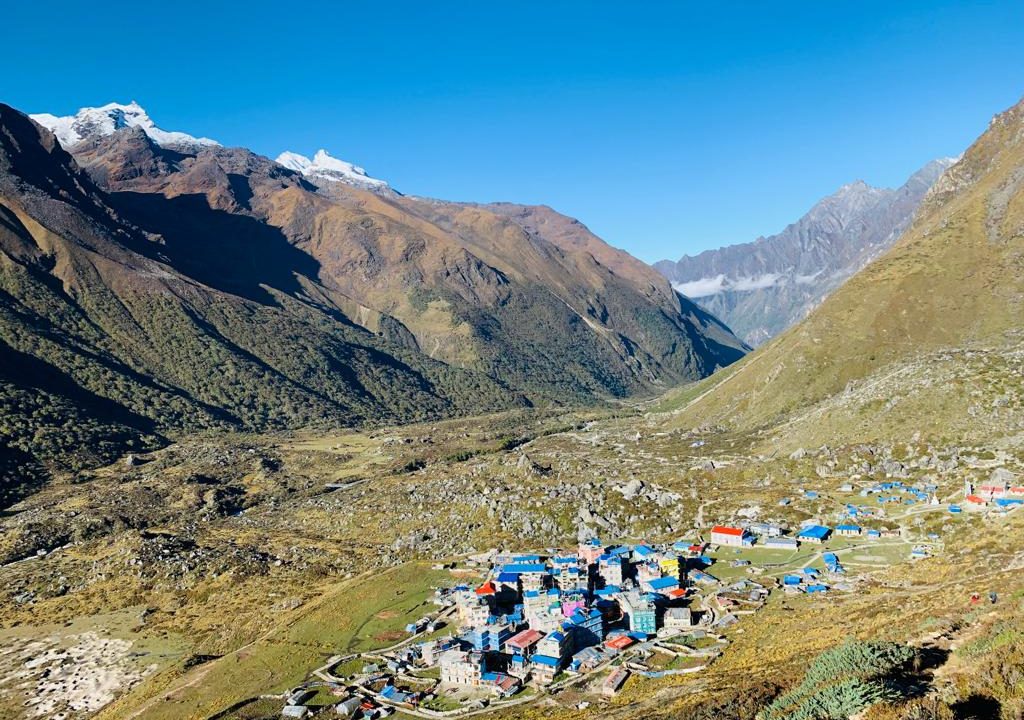
Langtang Valley, the “Valley of Glaciers”, is one of the most beautiful places in Nepal, with breathtaking views and beautiful landscapes. It is famous for many snow-capped mountains, such as Mount Langtang Ri, Langtang, Langrisa, and Ganjala Peak. Knowing a place’s weather before trekking is a must for safety reasons.
The Langtang Valley trek leads to an elevation of 3800 m (Kyanjin Gompa) and 4773 m (Kyanjin Ri). It starts from the easy route to the moderately difficult route. It is famous among soft adventure trekkers. This trek gives you a jaw-dropping view.
This trek lasts for 10-15 days. It starts from Kathmandu to SyabruBesi. Syabru Besi is the starting point of the trek. You trek to Lama Hotel, Mundu, and finally to Kyanjin. Then, return to Lama Hotel, SyabruBesi, to Kathmandu, which will end the trip.
This trek also passes through Langtang National Park , where many wildlife, such as Himalayan deer, bears, monkeys, and red pandas, inhabit. The trail goes up through Kyanjin Gompa by the Bank of Langtang River. You can enjoy a heavenly view after reaching Ghora Tabela.
This is a teahouse accommodation trek with the most magnificent forests, high alpine meadows, and yak pastures around Kyanjin Gompa, a Bushhist monastery. Tibetan Buddhist culture here gives you very serene and authentic vibes. Welcoming Tamang locals and their culture makes your heart flutter.
Langtang Valley makes it possible to trek in all four seasons. But among the four seasons, Spring and Autumn are the most comfortable seasons. Summer is difficult due to the hot climate and heavy rainfall. You can choose any season, but saving some trouble is always better. Let’s discuss the weather in Langtang Valley.
Table of Contents
Spring Season (March-May)

Spring is the best season to trek to Langtang Valley. The climate is stable, with mild temperatures, which makes your journey easier. This season starts in March and ends in May. This season is suitable for trekking in high altitudes.
You see flora, forests, and green vegetation along the trail. The views of the clear sky, mountains, and glaciers are picturesque. This blooming season welcomes you with the most beautiful natural landscapes.
In Spring, the days are longer and the nights are shorter. You get enough time to rest during your trek. The starry nights and good visibility in the early morning are best to embrace the beauty of the moon, stars, and warmth of the sun.
As this is the peak season, the place will be more crowded than the off-season but less crowded than other treks. You will get to see people from all around the world during this journey. Make new friends and enjoy your trek to the best in the upcoming Spring.
Autumn Season (September-November)
Autumn is also the best time to trek Langtang Valley. The moderate temperature makes the journey very cozy and comfortable. Autumn covers September, October, and November. It is colder than the spring season, with less chance of rain and snowfall.
It is cold, especially during nighttime, but it is tolerable. Autumn has dry days, clear skies, and the best views. The trails are in the best condition. This season favors trekkers in every possible way.
This is also the seasonal time. So, you get to meet many companions during your whole journey. The trails are crowded. You can hardly get any rooms at housestays. Still, this is the best time to trek if you want a safe trek without difficulties.
Summer Season (June-August)
Summer is quite a challenging time to trek Langtang Valley. The summer is known as the monsoon season, a season with downpours. The trails are in the worst condition, making it difficult to trek.
June is the start of Summer, and August is the ending. There is less rain at higher altitudes. It doesn’t rain all day, but it rains every day. The rain disturbs the journey. There is a high chance of injury on muddy trails. Due to heavy rainfall, landslides occur. This is offseason time for trekking.
So, there is less crowd and fewer disturbances in the season. The tea houses are also nearly empty, which makes it cheaper. Although the climate is unfavorable, the morning views are spectacular.
Winter Season (December-February)
Winter is the off-season time to trek due to its cold temperature. The temperature drops to -13 degrees during the night, making it difficult to tolerate. The chilly wind blowing in high altitudes makes you even colder.
December, January, and February are three months of winter. The fact that winter makes mountains beautiful is inevitable. You get to see the best views of snow-capped mountains and clear frozen glacier lakes. Langtang Valley is the “Valley of Glaciers”; winter makes glaciers look more meaningful.
If you are cool in a chilly season, you can also trek in winter. Keep yourself warm, and be careful of slippery and snowy trails.
Frequently Asked Questions
When is the prime trekking season for langtang valley.
The best times for Langtang Valley trekking are spring (March-May) and autumn (September-November). These seasons offer ideal weather conditions and visibility.
Is the Langtang Valley trek possible to do during winter?
While challenging, the Langtang Valley trek is still feasible in winter from December to February. However, expect colder temperatures, harsher conditions, and potentially some lingering snow and ice on the trails.
What is the monsoon season like in Langtang National Park?
Monsoon months (June-August) bring persistent rain, increased risk of landslides/mudslides, and reduced visibility, making a Langtang Valley trek more difficult and potentially hazardous.
How long does it take to complete the Langtang Valley trek?
The Langtang Valley trek typically takes 7-12 days to complete at a moderate, well-acclimatized pace.
Is a guide necessary for the Langtang Valley trek?
Given potential route-finding challenges, variable trail conditions, and altitude considerations, hiring a local guide is highly recommended for those new to the route.
What level of teahouse accommodation is available in Langtang Valley?
Basic tea house lodges can be found along the entirety of the trekking route in Langtang, providing simple food and lodging options.
Are permits mandatory for Langtang Valley Trek?
Yes, Permits are mandatory for Langtang Valley Trek. TIMS Permits and Langtang National Park Permits are required.
Is altitude sickness something I should worry about?
Due to portions of the Langtang Valley trek exceeding 3,000 m, there is a risk of developing altitude sickness, especially if you ascend too rapidly. Taking time to acclimate and recognize early signs of mountain sickness can reduce serious issues.
The Langtang Valley has beautiful alpine meadows, villages, mountains, and rivers to explore. The best times to visit are spring and autumn, when the weather is ideal for trekking, and the views are clearest. However, some adventurous travelers still journey during winter and monsoon seasons.
The weather in the Himalayas can always be unpredictable! As long as you plan wisely for the conditions of your chosen season, the magic of Langtang’s landscapes can be experienced year-round. This special region has almost legendary status among trekkers.
So let its scenery and trails excite your spirit, whenever you can make the journey. With reasonable expectations set, Langtang Valley always has sacred wanderings and surprises waiting around the next bend!
Our Partners

We are associated with

Sister Company


- Trekking In Nepal
Langtang Trekking
Langtang Trek
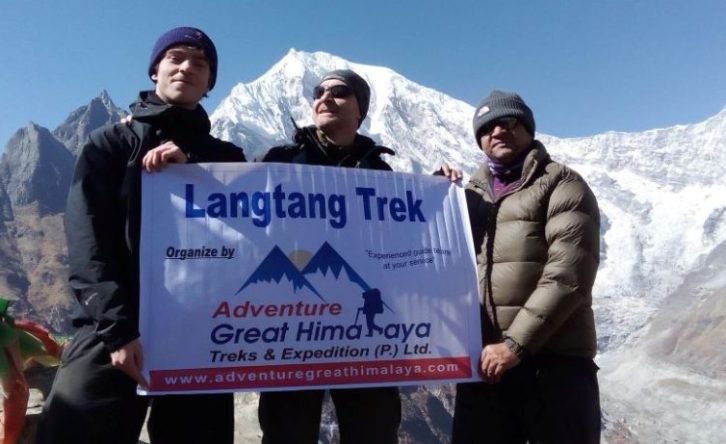
Group Discount Price
Number of Travellers
- Trip Itinerary
Cost Include/ Exclude
Langtang Trek is a marvelous and scenic destination around Central Himalaya just North of Kathmandu of 32 k.m. aerial distance, The Langtang trek suitable for all people in a week holiday.
Langtang Trekking is an easy and short Treks that can be packed up within a weeks. It is one of the most popular trekking trails because you will have Stunning Mountain views and Several Glacier with Short hiking and does not require any training and experiences of mountain trekking as in other trekking trails and climbing.
The 8 Days wonderful journey langtang Trek start from Kathmandu with an interesting drive to Langtang area at Syabrubesi village, from here our walk follows high above hills and ridges past farmland and villages and into lovely forest to reach a wide and spectacular Langtang valley .
As you progress up the wide spread Kyanjin valley you are surrounded by snowy peaks from all four sides. The trail takes you up to Kyangin gompa at 3800 meters, where you get an opportunity to ascend Kyangjin Ri from where 360◦ mountain views are fantastic.The trek runs through sparsely populated areas and you can visit the yak cheese factory After an ascent of Kyanjin Ri.
Enjoy the views of mountains from Annapurna-Manaslu-Ganesh-Langtang to Jugal Himal range with spectacular scenery along the route.
After a grand time concluding Langtang Valley trek with a drive back to Kathmandu with wonderful services of Adventure Great Himalaya guides and staff.
Why Langtang Trek
- Climb to Kynjin Ri (4700m) Over Mountain View of Dorjelakpa (6990m, Langtang (7227m), Langtang Lirung (7200) and Ganesh himal
- Explore Sherpa Langtang Village
- Test of the Best Yak Cheese in Kyanjin Goumpa.
- Tamang settlements and Their Unique Culture
- Beauty of forest of rhododendron, pine, bamboo and juniper trees and other medical herbs too
- the flow of mountain-streams and cliff of rocks amuses for those who love nature and it’s magic
- varieties of rare wild life- Himali Black Bear, Red Panda, Langur
Best Time For Langtang Trek
Langtang Trekking is one of the preferred trekking destinations in Nepal. Before planing this trek, you should know the When is the Best Time for Langtang Trekking . This will let you experience the best with fewer difficulties. Trekking in Langtang Region is possible all year round. The valley looks stunning in all seasons. And every season has its typical splendor.
Best Time for Langtang Trek is Autumn (Sept to Nov) and Spring (March to May) are the most preferable seasons. The weather is warm, moderate, and stable. The average temperature on these seasons ranges from 10 to 15 degrees.
In such climates, you can enjoy the fondest part of nature. Especially in spring, the trails bloom in colorful rhododendrons and other wildflowers. While in autumn, you get the most beautiful views of mountains and valleys. There are no heavy rain and snowfall. So, you can enjoy the rejuvenating environment.
Also, these seasons are the peak time of the year. You will walk with many fellow travelers on trekking trails. Thus, you can opt for a safe & sound solo travel too. if you love trekking in less crowded locale , you can choose for the remaining seasons. With appropriate trekking gears , the Langtang trek is doable. Plus, you need to have strong physical and mental preparedness too.
Difficulties of Langtang Trek
Langtang Trekking is a famous trek with a moderate grade . Any trekkers with basic physical and mental fitness can go for this trek. Yet, there are many difficulties you might face on the way. It will help you prepare well if you can identify them beforehand. Following are the factors for Langtang Trek Difficulties :
- The foremost difficulty is Langtang Trek Route . The total walking distance of the trek is about 70-80 Kilometers . The trekking paths follow uphill climb most of the time. You must prepare to walk around 6-7 hours on such challenging terrains.
- The next aspect is the unpredictable weather and temperatures. Sometimes, there is a drastic change in weather and climatic condition.
- The major difficulty is the high-altitude and chances of getting AMS ( Altitude Mountain Sickness ). The vantage point of Langtang Trek is Kyanjin Ri, at 4773 meters . At such altitude, the amount of oxygen starts decreasing. As you head towards higher elevation, you may face altitude sickness .
Thus, to avoid such difficulty during the trek, you need to have a good preparation. Indulge yourself in several exercises at least a month ahead. Whilst on the trek, be careful while ascending uphill. Walk slow and try not to over stress your body. Drink plenty of water and keep your body hydrated.
In any case, if you suffer from AMS related symptoms like nausea , vomiting , shortness in breathing, etc, descend immediately. Don’t forget to take related medications and proper care afterwards.
Food and Accommodation for Langtang Trekking
The standard of food and accommodation in the Langtang Region is basic. Every resting point has several tea houses providing ample services. However, the facilities may vary with the change in altitude . Most of the point, the tea house has additional facilities like gadget charging, Wi-Fi, hot showers, etc.
You will be staying in a normal room with two beds and a table. They will also provide bed-sheets, mattress, blanket, and pillows. Your room may or may not have an attached toilet. Every teahouse also has a big dining room with indoor heating. You can enjoy your meal and hang out there.
Regarding food, dal bhat is common. They will serve it with available seasonal vegetables. You can add-on this food as much as you can consume. It will cost the same price. Besides, the menu also has western items like pizza, spaghetti , toast , soup, noodles, pasta, and macaroni. However, the price of these items may vary accordingly.
Langtang Trek route
Langtang Region is quite close to Kathmandu . You will travel vis a bus or a jeep to Syabrubesi . This is the starting point of your trek. You travel through several narrow and graveled roads this day. This trip will take about 8-9 hours . There are various routes to reach Syabrubesi. You will either take the route from Tokha or Galchhi .
After the trip to Syabrubesi, you will start to trek. After reaching Syabrubesi, we hike towards Lama Hotel on the first day. Langtang trekking trails will be passing through magnificent forests , alpine pastures, and meadows. You will then reach Kyanjin Gompa via Mundu and Langtang Valley .
The majority of Trekkers spend an extra day at Kyanjin Gompa and discover Kyanjin Ri . Kyangjin Ri is popular for its 360-degree panorama of the Langtang range. Then, you will retrace your way back to Syabrubesi again. Finally, you will drive back to Kathmandu.
Langtang Trekking Permit
Trekking to Langtang, you will need two Types of Permit, The One is TIMS Permit , It cost USD 20 and another is for Langtang National Park Entry Permit, which cost USD 28 per person, It is available in Nepal Tourism Board, Kathmandu. Or, you can buy them at the entry point in Dhunche.
You also have to pay Shivapuri National Park Entrance Fee if you follow the Helambu Trail.
Langtang Trek Itinerary
Arrival in kathmandu and transfer to hotel., drive to syabrubesi by bus -1,460m- 07 hours..
Starting Langtang Valley trekking with drive on Nepal’s mountain highway to reach Langtang area at Syabrubesi village, journey leads past many farm villages and towns with views of mountains. On reaching Dhunche at 1,965m, a major town of Langtang area and Rasuwa district and an entrance of Langtang National Park. From here drive continues downhill for few hours to Syabrubesi village for overnight stop.
Transport:- By Bus Accommodation: : Lodge / tea House Meals: Breakfast, Lunch , Dinner
Trek to Lama Hotel 2,240m -06 hours.
First day walk leads uphill for a while with rest of the walk on gradual and winding trail through terraced farms and villages, walk descend to join a path of upper Syabru near Riverside. From here another hour walk to reach a small forest clearing at Lama Hotel for overnight stop.
Accommodation: : Lodge / tea House Meals: Breakfast, Lunch , Dinner
Trek to Langtang village 3,430m – 05 hours
Morning walk follows Trisuli or Langtang River upstream, leading to a climb into rhododendron and oaks forest after few hours walk reaching at Ghoretabla in the middle of the forest. After a nice stop continue walk for few hours to Langtang village through forest and crossing streams and leaving the tree line behind at Langtang village for overnight.
Trek to Kyanjin Gompa 3,850m – 04 hours.
Langtang village mostly inhabited by Tamang and Bhotias tribe, morning walk leads on gradual path for a short while, then winds up for few hours coming across “mani-prayer wall”, walk leads further east where the gorge opens up into a wide scenic valley with views of peaks at close distance.
After a good walk of 3 hours reaching at Kyanjin Gompa, a beautiful place with panorama of mountains and close views of Langtang Lirung at above 7,000m with icefall, here in a nice lodge with afternoon free for short walk visit the cheese factory established some 25 years ago by Swiss Technical Assistance and local support.
Climb Kynajin Ri (4700m) - Local Hike
Today is highlight day of our trek, Early morning we will hike to Kyanjin ri to enjoy and marvel the super Sunrise views,
Climb to kyanjing ri take about 2 hour from your lodge , from here enjoy views of GhenguLiru (Langtang II 6571m / 21,560ft), Langtang Lirung (7,425m / 23,765ft) Kimshun (6,745m / 22,137ft) and Shalbachum (6,918m / 22,699ft) to the south, the ChimsedangLekh forms a ridge of peaks which includes Naya-Kanga 5,846m and Gangchempo, Tilman’s beautiful Fluted Peak.
Beyond it continues to the Jugal Himal, ending with Dorje Lakpa (6,980m / 22,929ft), extending further east on the upper meadows of the Langtang range ends in a huge and massive mountain wall, forming the border with Tibet.
Trek back to Lama Hotel 2, 470m -06 hours.
After a great time at Kyanjin Gompa, return back on the same trail to Lama-Hotel a small settlement in the midst of the forest at the bank of upper Trisuli River.
Trek back to Syabrubesi -06 hours.
Trek follows on same route all the way, after crossing bridge walk is pleasant through bamboo forest; on leaving the river walk downhill through farm terraces till Syabrubesi is reached for overnight stop
Drive back to Kathmandu by Bus – 07 hrs journeys.
Last day of this wonderful trekking concludes with an exciting drive down hill back to Kathmandu, in Kathmandu transfer to your hotels with free afternoon for individual activities.
Accommodation: : No Meals: Breakfast, Lunch Transportation: By Bus
Departure from Nepal or extend your holiday
if you extend the trip highly recommend 3 hour Everest Helicopter tour,
Include/Exclude
What’s include.
- All Necessary Langtang Trekking Permit
- Kathmandu/Shybru Besi/Kathmandu by Bus (Private Jeep available for an additional Cost USD 165 per jeep for a one-way tri p)
- Meals: 3 meals a day during the trek (Breakfast, Lunch and Dinner)
- Hot Drinks : Tea / Coffee
- seasonable Fresh Fruit – Apple, banana etc
- All Lodge / tea house accommodation-twin sharing basis
- Trekking Guide : An experienced, English speaking Trekking guide Including his well paid salary, meals, accommodation and Insurance
- Adventure Certificate, Company T-shirt
- Medical supplies (first aid kit will be available).
- All government taxes.
- Service charge.
What’s excluded
- International airfare and Nepal entry visa fee
- Lunch and Dinner Kathmandu
- All the bar bills like coke, beer, bottle of water, hot water etc.
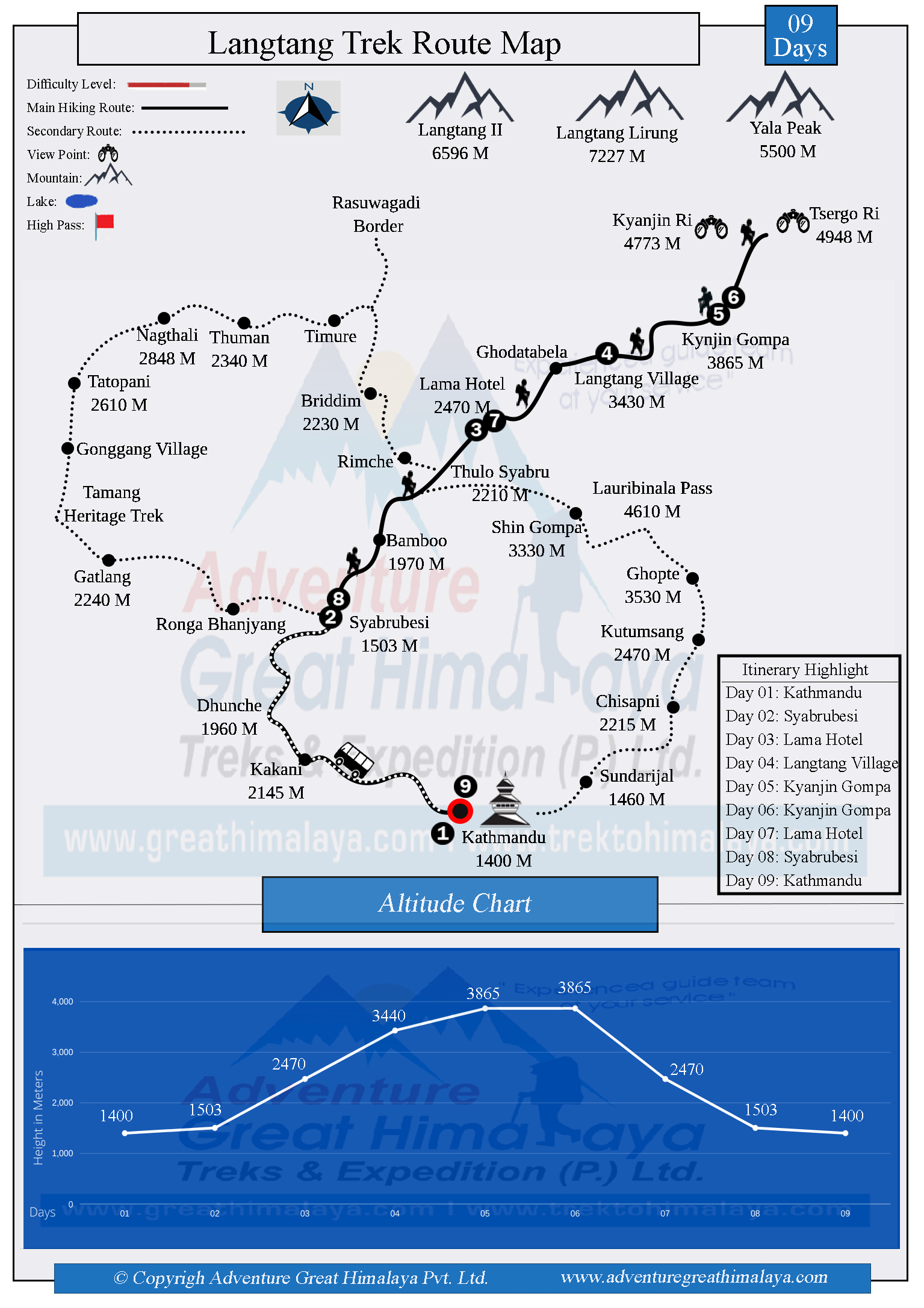
Reviews of Langtang Trek
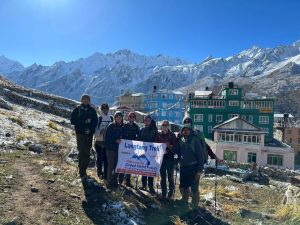
Malcolm Williams
Communication with Babu was always fast, clear and efficient. He was able to customize a trek in the Langtang valley to fit our group’s (8 ppl) schedule. As a former porter and guide the depth of his knowledge was invaluable in the planning process. We were immensely satisfied with the professionalism, kindness and good natured spirit of the guide, Dinesh.
Furthermore, Babu was able to help with a variety of other tasks in Kathmandu such as extending hotel bookings or arranging busses. We felt confident that he would be able to assist with any inquiries we might have.
I enjoyed the trek so much that I immediately booked another. I would highly recommend this company.
reviews source by trip adviser-
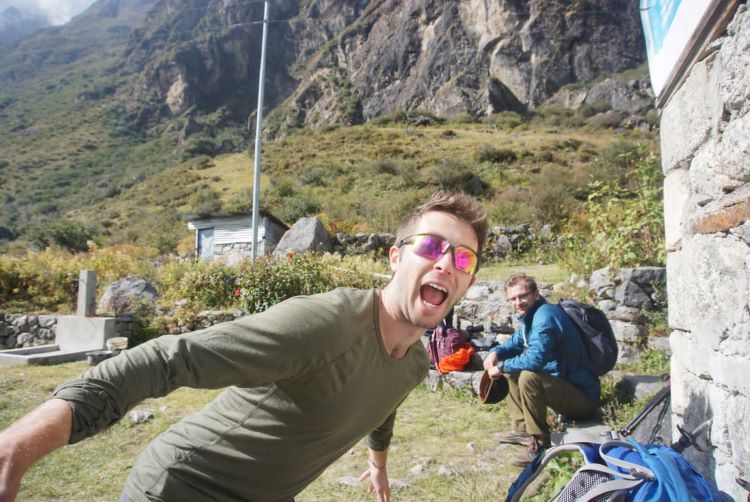
Albert Lucie
We discovered the amazing Langtang Valley during a 7 days trekking together with a very kind, attentive and pleasant guide Nanda and our porter Rachendra. They were very helpful during all this trekking. The organization was fantastic! We recommend you as an professional and dedicated organization, thanks a lot Albert and Mathis
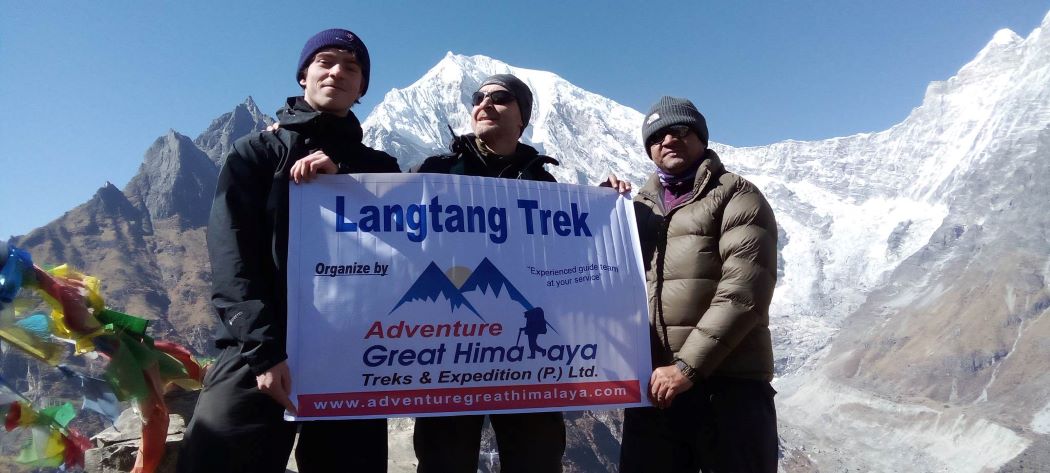
Nathalie Balaban
We had a great experience with Babu and with our guide Nahran, going on the Langtang Valley trek, a highly recommended trek for families. Babu was very responsive by email, and we had a Zoom meeting with him before the trip, which was very useful to match expectations and prepare for the trip. Everything that Babu promised was correct. Nahran led the two porter team extremely well, always attentive to our needs. We changed plans on a daily basis and Nahran always helped with a smile and suggestions. We did the trek in mid October 2022. The advantage is that the tea houses and trek were quite empty, but best would be to do it in November as the weather was not great. Despite that, we had a great family experience!
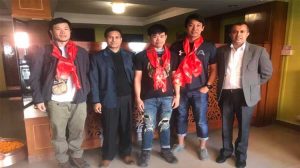
This is the 4th time we went with Adventure Great Himalaya. We decided to go in the late winter and a bit off season, hoping to see the scenery is covered with snow. We had a little bit lucky since the weather was all clear every day. The sceneries are so stunning. I never thought that Langtang would be this beautiful. I would like you to go and witness by yourselves. Additionally, I would like to thank for Babu Gogun and Naran for your hospitality. They are so friendly. This trip would not complete if we haven’t had them. If you are looking for the great agent tour in Nepal, I recommend you “Adventure Great Himalaya”. Worth a try!
Bangkok, Thailand
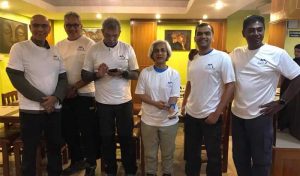
We are group of 6 from Malaysia, just complete the 8 days langtang Valley trek , This is our 2nd trip with Adventure Great Himalaya Treks & Expedition headed by Mr Babu Karki., We decided to do a late winter trek up the Langtang Valley to avoid the peak season. Started snowing from Langtang Village. Occasionally blizzard like conditions. I was told it snowed in Kathmandu on the same day after 12 years. Snow continued to Kanjin Gompa. Had to abandon the trek to Kanjin Ri because of heavy snowfall. Guide Janak made the right decision to start the return journey when the the was a gap in weather. The porters Gokul, Shonam and Nova with Janak guided us safety back to Syaprubesi.
Thanks for Babu and Team; we are highly recommending this company, Trust able Company, excellent service, knowledgeable Guide, frankly, helpful and Strong porters.
Malaysia Kuala Lumpur
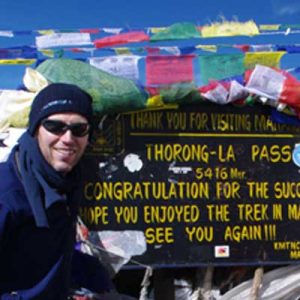
“I just want to commend Babu and Adventure Great Himalaya on making our second trip to Nepal very enjoyable experience. This is the second trip to Nepal I have made, and I have had two good experiences with Babu.
My first experience in Nepal involved a Lang Tang trek in 2004 with Babu himself as our guide. We decided we would carry our own packs, and employ Babu as our guide. Babu He also made a very wise suggestion to take Land cruisers from Kathmandu instead of the local buses.
At all times Babu paced the group well, organised excellent guest houses, ensured we all had enough food, and ensured we had time to see the sights, while being entertaining and informative.
Our group became good friends with Babu, and when two of us returned to Nepal five years later in 2009, we contacted him again. This time to walk the Annapurna circuit. We had decided to walk the circuit this time unaided. We were a little worried about telling Babu this, but we should not have been, “no problem”, he says, and promptly took us to lunch. He of course organises cars and permits, gives us some advice, and tells us to contact him when we get back to Pokhara.
In all our dealing with Babu, he has been professional, always works with professional people, and listens to what we want. Most importantly makes good suggestions, but had never attempted to force any services upon us. We value the friendship that we have developed with Babu, and I do not hesitate to recommend Babu and Adventure Great Himalaya.
Name: Martin Country: Austrilian

Write a Review
Enquiry form.
Note: Please ensure names must be exactly the same as your passport (for ticketing/security purposes). You could incur extra costs or even miss your flight if the names are not correct.
Interested Program: *
Full Name: *
Email Address: *
Contact Number: *
Afghanistan Albania Algeria Andorra Angola Antigua and Barbuda Argentina Armenia Australia Austria Azerbaijan Bahamas Bahrain Bangladesh Barbados Belarus Belgium Belize Benin Bhutan Bolivia Bosnia and Herzegovina Botswana Brazil Brunei Bulgaria Burkina Faso Burundi Cabo Verde Cambodia Cameroon Canada Central African Republic (CAR) Chad Chile China Colombia Comoros Democratic Republic of the Congo Republic of the Congo Costa Rica Cote d'Ivoire Croatia Cuba Cyprus Czech Republic Denmark Djibouti Dominica Dominican Republic Ecuador Egypt El Salvador Equatorial Guinea Eritrea Estonia Ethiopia Fiji Finland France Gabon Gambia Georgia Germany Ghana Greece Grenada Guatemala Guinea Guinea-Bissau Guyana Haiti Honduras Hungary Iceland India Indonesia Iran Iraq Ireland Israel Italy Jamaica Japan Jordan Kazakhstan Kenya Kiribati Kosovo Kuwait Kyrgyzstan Laos Latvia Lebanon Lesotho Liberia Libya Liechtenstein Lithuania Luxembourg Macedonia Madagascar Malawi Malaysia Maldives Mali Malta Marshall Islands Mauritania Mauritius Mexico Micronesia Moldova Monaco Mongolia Montenegro Morocco Mozambique Myanmar (Burma) Namibia Nauru Nepal Netherlands New Zealand Nicaragua Niger Nigeria North Korea Norway Oman Pakistan Palau Palestine Panama Papua New Guinea Paraguay Peru Philippines Poland Portugal Qatar Romania Russia Rwanda Saint Kitts and Nevis Saint Lucia Saint Vincent and the Grenadines Samoa San Marino Sao Tome and Principe Saudi Arabia Senegal Serbia Seychelles Sierra Leone Singapore Slovakia Slovenia Solomon Islands Somalia South Africa South Korea South Sudan Spain Sri Lanka Sudan Suriname Swaziland Sweden Switzerland Syria Taiwan Tajikistan Tanzania Thailand Timor-Leste Togo Tonga Trinidad and Tobago Tunisia Turkey Turkmenistan Tuvalu Uganda Ukraine United Arab Emirates (UAE) United Kingdom (UK) United States of America (USA) Uruguay Uzbekistan Vanuatu Vatican City (Holy See) Venezuela Vietnam Yemen Zambia Zimbabwe
Number of People: *
You May Like This
Langtang trek – 7 days, langtang & tamang heritage trek, share this trip, customer's reviews.
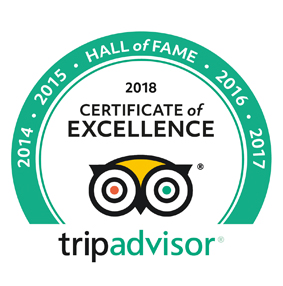
Adventure Great Himalaya Pvt. Ltd. (Private day tours)
Why booking with us ?
- Fully Locally Owned Company
- Quality Of Service and Competitive price
- Highly Professional Staff
- Flexible and customization trip itinerary
- 100% Customer satisfaction
24 hour customer service

Langtang Valley Trek
Langtang valley trek overview.
While there are plenty of places to visit in Nepal, we want to tell you that only a few of them will provide you with a truly fulfilling adventure experience in a short amount of time. Among those few, we have to say that the Langtang Valley trek is one of them. As this destination is near and dear to the capital city Kathmandu, it has been able to gather the attention and interests of both international and local tourists. Due to its exceptionally beautiful scenes and landscapes, there is no doubt that this trek gets high appreciation from all of the trekkers.
To be specific, this journey will be highly enjoyed by those who want to explore the rough and off-the-beaten path that goes through the mesmerizing forest routes finally leading to the beautiful mountains. Especially, we highly recommend this trek for those who are coming to this country for the first time.
Introduction
Known as the “Valley of Glaciers,” the Langtang Valley is a fantastic place that features tall snow-capped peaks, lush alpine meadows, and thick rhododendron woods. This trek is more than simply a physical adventure, it’s an adventure through the magnificent Langtang National Park , where rivers sparkle, waterfalls plummet, and the aroma of Himalayan flora penetrates the air.
You will learn more about the ancient Tamang and Tibetan villages’ rich cultural artwork as you continue on the path. While visiting these villages, you will find that each village is a unique chapter, which reveals the customs, traditions, and warm hospitality of the locals. From ancient monasteries echoing with spirituality to the vibrant celebrations of traditional festivals, Langtang Valley undoubtedly has a dynamic display of Himalayan culture.
Wildlife enthusiasts can also try to glimpse the elusive red panda, the Himalayan tahr, and a variety of bird species by trekking the special trail in Langtang National Park. In addition to being physically tiring, the trek strengthens one’s bond with the natural environment and incorporates wildlife observation into the experience.
Meanwhile, these are the additional features of the trek, specifically you have to be prepared yourself to be mesmerized by the panoramic views that will greet you at every turn. As guardians, peaks such as Langtang Lirung, Ganesh Himal, and Dorje Lakpa spread their shadows across the wild terrain of the Langtang region. Along with this beautiful background, the trek offers the opportunity to see the breathtaking panorama from Kyanjin Ri, which changes the Himalayan landscape into everchanging colors.
Therefore, the trek goes over 8 days, covering 65-75 kilometers within 6 days. While adventuring throughout these days, you will be guided through picturesque villages such as Langtang and Kyanjin Gompa. Passing through these trails will offer you a balanced challenge, with gradual ascents and descents that serve well for both experienced trekkers and those seeking a thrilling introduction to the Himalayan trails. So as we have introduced our trek, it’s time to deep dive into the further specifics of the trek. So without wasting any time, let’s get started-
Trip Highlights:
- See the beautiful Langtang Valley, a picturesque Tibetan-influenced village.
- Immerse yourself in the culture by staying in homestays, offering an authentic experience with Tamang and Sherpa families.
- Keep an eye out for diverse flora and fauna in Langtang National Park, including red pandas, Himalayan tahr, and various bird species.
- Encounter Buddhist stupas and prayer flags, adding a spiritual and visual dimension to the trek.
- Ascend to Tserko Ri or Kyanjing Ri for the Amazing views of the nearby mountains.
- Explore the local cheese factory in the village.
- Peaceful trails throughout the route.
- Spend the night in the local teahouses interacting with amazing locals.
Is the Langtang Valley trek really difficult?
The difficulty of the Langtang Valley Trek can vary depending on individual fitness levels, experience in trekking, and the specific route taken. Generally, the Langtang Valley Trek is considered to be of moderate difficulty, making it accessible to a wide range of trekkers, including those with some trekking experience and even to people with no experience at all.
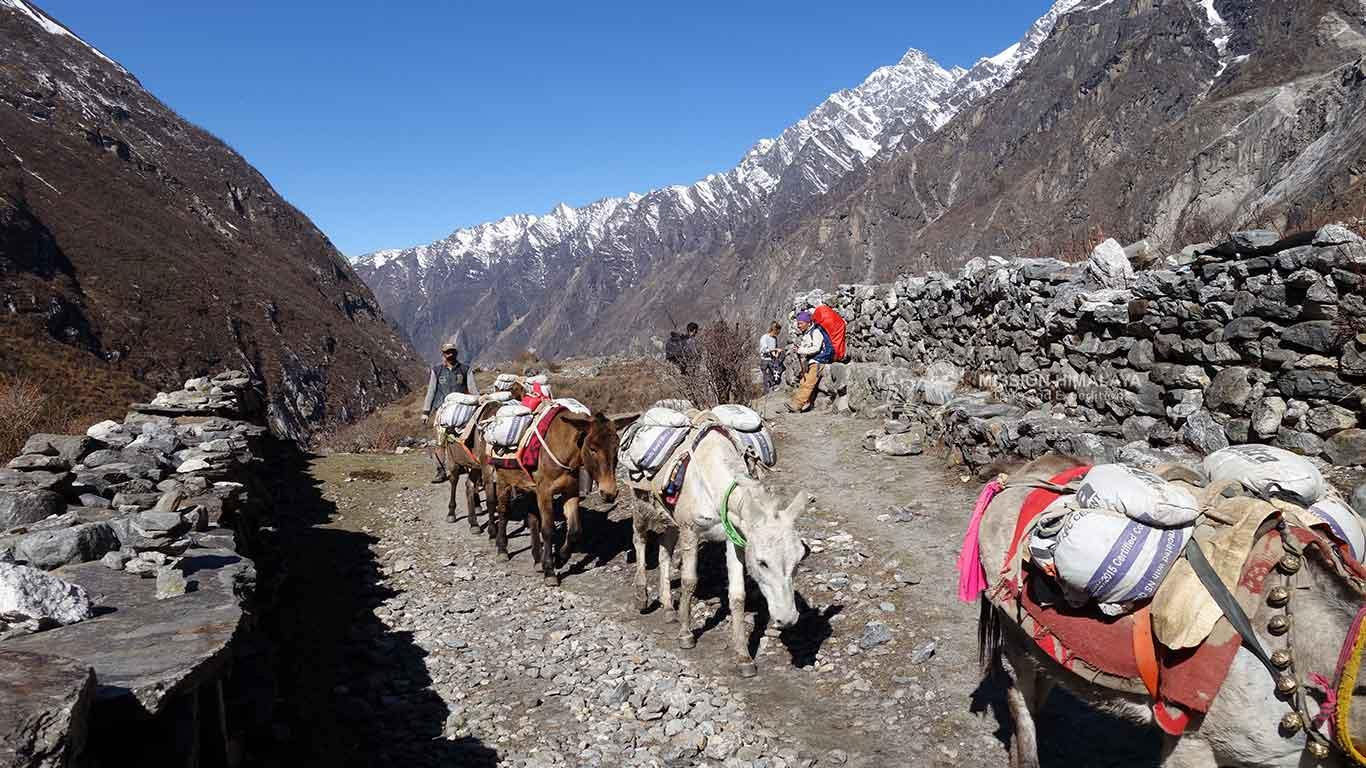
The trek takes you through a variety of landscapes, including lush forests, terraced fields, and high-altitude alpine meadows. While it doesn’t involve technical climbing, there are steep ascents and descents, and the altitude can be a factor of difficulty for some people. Remember that the highest point on this Langtang Valley Trek is Kyanjin Ri (4,773 meters or 15,655 feet), which is considered a high-altitude spot. From here, you can capture the stunning panoramic views of the surrounding peaks.
From where does the trek to Langtang Valley begin?
The trek to Langtang Valley typically begins in Syabrubesi, which is a scenic village located in the Rasuwa District of Nepal. Syabrubesi serves as the starting point for the Langtang Valley trek and is accessible by road from Kathmandu. Trekkers often take a bus or private transport from Kathmandu to Syabrubesi, and from there, they commence their trek towards the Langtang Valley. Therefore, in the same way, we will be taking a drive to Syabrubesi from Kathmandu. The trail passes through picturesque landscapes, charming villages, and diverse terrain as it gradually ascends toward the heart of the Langtang region.
Is Langtang Valley worth it?
Langtang Valley is worth a visit for those seeking a breathtaking blend of natural beauty and cultural richness. It offers a combination of stunning natural beauty, diverse landscapes, and rich cultural experiences. The panoramic views of snow-capped Himalayan peaks, interactions with local communities, and the trek’s varied terrain make it a rewarding adventure.

Additionally, Langtang Valley is less crowded than some other trekking destinations in Nepal. So, surely, it provides a more intimate and authentic experience. Therefore, we ensure that whether you’re a nature enthusiast, cultural explorer, or adventure seeker, the Langtang Valley trek will offer you a well-rounded and memorable journey.
When you should do the Langtang Valley trek for the best experience?
For the most rewarding experience, doing the Langtang Valley trek is highly recommended during the spring (March to May) and autumn (September to November) seasons.
Spring (March to May)
This season brings a delightful transformation to the Langtang Valley. The trail appears alive and well with rhododendron blossoms in bloom, which create a vibrant mosaic against a background of rich greenery of the region. Also, the weather remains mild and stable, with daytime temperatures ranging from 10 to 20 degrees Celsius (50 to 68 degrees Fahrenheit). Furthermore, in this season, clear skies will also provide crystal-clear views of the snow-capped peaks, making it an optimal time for trekkers who appreciate both vibrant landscapes and panoramic mountain vistas.
Autumn (September to November)
As the monsoon retreats, autumn shows a period of stable and dry weather. Like in the spring, the skies are clear in the autumn, offering unparalleled visibility of the Himalayan range. Particularly in this season, the daytime temperatures in this season hover between 10 to 15 degrees Celsius (50 to 59 degrees Fahrenheit) in higher altitudes. Further, the trekking trails are at their busiest during this season as they provide an ideal combination of pleasant weather and breathtaking scenery.
If we talk about the monsoon, then we advise you to avoid the monsoon season (June to August) due to heavy rainfall. Heavy rainfall in this season can lead to muddy and slippery trails, landslides, and limited visibility. Furthermore, winter (December to February) brings colder temperatures and occasional snowfall. So it makes the trek more challenging and requires proper cold-weather gear. Therefore, choosing the right season ensures that trekkers can fully enjoy the natural beauty and cultural richness of the Langtang Valley.
Langtang Valley Trek Itinerary
Day 1: kathmandu to syabrubesi.
Walking Hours: 8 Hours Driving
Meals Included: Breakfast, Lunch And Dinner
Accommodation: Tea House/ Lodge
On this first day of the trek, we leave bustling Kathmandu early in the morning and move to the starting point of our trek – Syabrubesi.
On this trip, you will enjoy seven hours of scenic driving along the Trishuli highway, driving through beautiful small villages, river valleys, and mountains. After passing the entrance gate to the Langtang National Park, the road then changes to offroad. We will arrive at the Syabrubesi village crossing the Dhunche headquarters of the Rasuwa. After journeying for about 7 hours, and then we will rest and prepare for tomorrow’s trek.
Day 2: Trek to Lama Hotel
Walking Hours: 5 To 6 Hour Trekking
Our journey today will begin with a slight three-hour ascent through a subtropical, deciduous, slightly higher-than pine and rhododendron forest upstream to the village of Bambus, where we will stop for lunch. If we’re lucky, we may come across Langur monkeys along the way. From here we will again climb steeply through the bamboo forest to our destination the Lama Hotel. Overnight at the Lama Hotel.
Day 3: Lama Hotel to Langtang Village
Walking Hours: 6 Hour Trekking
After having breakfast here at lama hotel, we will have a slight ascent through rhododendrons and pine forests upstream taking us around small villages, to the village of Ghoda Tabela, where we stop for lunch.
Then the landscape turns into a U-shaped glacial valley here. After lunch, we will continue along a scenic trail that includes a tree line and the magical views of the Langtang Lirung Peak. After passing through these, the route will then take us to the Langtang Valley. The Tibetan-style village of Langtang was destroyed by a massive catastrophe caused by an earthquake in April 2015. Overnight at the Langtang Village.
Day 4: Lama Hotel to Kyanjin Gompa
Walking Hours: 7 Hours Trek
Today will be a less demanding trek and at a calmer pace. Especially through the picturesque villages and herds of yaks, we reach the Kyangjin Gomba. If the weather permits us, we will have wonderful views of Ganchempo Mountain and Langtang Lirung. We will have time to relax, walk to the glacier, or visit the Yak cheese Factory, Kyanjin Monastery, or local houses. This will be the highest point of the trek so you will have plenty of opportunities to witness the scenery nearby. Overnight at the lodge in Kyanjing Gompa.
Day 5: Kyanjin Gompa
Today we have to climb the ridge of the mountain Kyanjin Ri 4300 m. After climbing the summit, we will witness the amazing view of the Langtang Mountains, including Langtang Lirung (7227 m), and Dorje Lhakpa (6966 m). Along with these peaks, you will also be able to see the beautiful Langsisa Ri Mountain (6560 m), Ganjala Peak, Yala Peak, and many other peaks.
If possible, we will continue to the top of Tsherko Ri 4986 m, where you will get an even better view of the Langtang Mountains, from which you will have a 360-degree view of the surrounding mountains and the top of Mount Yala. After climbing to any of these points, you will descend to Kyanjin Gompa and rest. Furthermore, while climbing to the top is voluntary, you can also spend the day walking with amazing views around Kyanjin Gompa and enjoying the snow-capped mountains and the warm sun. Overnight again in Kyanjing Gompa.
Day 6: Descend Lama Hotel
On this sixth day of the trek, we will return to the Lama Hotel. After breakfast, we will descend from Kyanjin Gompa through the Langtang Valley to Ghoda Tabela, where we will have lunch. From here, we will have another two hours of descent through the Langtang Khola River valley to the Lama Hotel. Along the way, the view of the 7,000-meter Langtang Mountain will accompany us. Overnight at the Lama Hotel.
Trek extension – Gosaikunda Lake. The trek continues through Thulo Shyaphru and will take you to the sacred lakes of Gosaikunda. If you choose to do the Gosaikunda Lake trek , the trek will be extended for about 7 days. We recommend extending the route, especially in spring, when you will be attracted by birds and flowers, blooming rhododendrons with a lush and green landscape.
Day 7: Syabrubesi
Today is the last day of our journey together. Half an hour after leaving the Lama Hotel, we will disconnect from the village of Rimche and head up the beautiful rhododendron forests to the typical Sherpa village of Syabrubesi. While descending, we will see snowy peaks in Tibet. Finally, after we descend to our destination Syabrubesi, we will celebrate our successful journey. Overnight at the lodge in Syabrubesi.
Day 8: Transfer to Kathmandu
Meals Included: Breakfast And Lunch
Accommodation: 3 Star Category Hotel
Today we will return to the capital by local bus. After having a continuous 8-hour drive, we will arrive in Kathmandu in the late afternoon.
Langtang Valley Trek Cost
- One strong porter with pay for food, lodging, insurance, and transportation.
- Pickups and drop-offs from airports and hotels.
- Accommodations: Twin-share teahouses on the trek and a 3-star hotel stay while in Kathmandu.
- Full-time meals along the trek and breakfast in Kathmandu.
- Welcome and farewell dinners.
- Down jacket, and a four-season sleeping bag (the down jacket and sleeping bag must be returned when the trip is over).
- A comprehensive medical kit.
- All necessary paperwork and permits.
- All relevant fees, including taxes and service costs.
- Private transportation in a welcoming car.
- English-speaking, professionally qualified, and experienced guide giving pay, lodging, food, and insurance.
- If your group consists of six or more people, an additional assistant trekking guide will be assigned.
- Nepal Entry Visa Fees.
- Other meals and beverages rather than compared to an itinerary.
- International travel to and from Nepal.
- Excess baggage charges.
- Evening and lunch meals in Kathmandu.
- Extra night(s) of lodging.
- Travel Insurance.
- Personal expenses (phone calls, laundry, bar bills, battery recharge, extra porters, bottle or boiled water, hot shower, heater charge, etc.).
- Tips for guides and porters.
- The services that are not included under "Cost Included".
Langtang Valley Trek Map

Langtang Valley Trek Support
How to prepare for the langtang valley trek.
Doing the Langtang Valley trek in Nepal promises an unforgettable journey through spectacular trails. However, the trek’s challenges, including varying altitudes and unpredictable weather, necessitate thorough preparation. So for that reason in this section, we’ll explore essential steps to ensure a safe and enjoyable trek. From physical fitness training to obtaining permits, packing smartly, and understanding local customs we will explore through all of it. So, now let’s delve into the details of this trip so that you get fully excited for the adventure of a lifetime.
Physical Fitness Training
Initiate a fitness training routine well in advance. Focus on cardiovascular exercises, strength training, and endurance activities to prepare your body for the physical demands of trekking in varied terrains and altitudes.
Trekking Gear Checklist
Create a comprehensive checklist of necessary trekking gear. Ensure your equipment is in good condition, including well-fitted trekking boots, layered clothing suitable for diverse weather conditions, a comfortable backpack, and a cold-weather sleeping bag.
Permits and Documentation
Prepare all of the necessary documents required to obtain the required permits for the Langtang Valley trek. As we are gonna manage everything for you, make sure that you make photocopies of the documents and keep them in a secure place.
Health Check-up
Schedule a pre-trek health check-up with a healthcare professional. Discuss your travel plans, and ensure you are physically fit for high-altitude trekking. Obtain any necessary vaccinations and medications.
Travel Insurance
Secure comprehensive travel insurance that covers trekking activities at high altitudes. Confirm that the policy includes emergency evacuation coverage in case of unforeseen circumstances.
Opt for lightweight and compact gear to reduce the weight of your backpack. Prioritize essential items, and avoid unnecessary belongings. Pack smartly to ensure comfort during the trek.
Money and Currency
Carry enough local currency for expenses along the way, as there might be limited access to ATMs in remote areas. Inform your bank about your travel dates to prevent any issues with card transactions.
Language and Cultural Preparation
Learn basic Nepali phrases to facilitate communication with locals. Acquaint yourself with the local customs and cultural norms to show respect and understanding during your trek.
Emergency Contacts
Compile a list of emergency contacts, including the contact information of local authorities, your embassy, and someone back home. Share your itinerary with a trusted friend or family member.
Therefore, by diligently preparing for the Langtang Valley trek, you increase your chances of having a safe, enjoyable, and fulfilling trekking experience amidst the breathtaking landscapes of the Himalayas.
Accommodation Facilities in Langtang Valley Trek
The Langtang Valley trek offers a range of accommodation options, primarily in the form of teahouses or lodges along the trail. These facilities provide trekkers with essential amenities for a comfortable stay amidst the stunning Himalayan landscapes.
1. Teahouses/Lodges:
Teahouses are simple lodgings equipped with basic amenities. These establishments often have communal dining areas where trekkers can socialize, share stories, and enjoy warm meals. So, expect clean beds, blankets, and shared bathrooms with cold water on this trek.
2. Room Options:
Teahouses typically offer single and double rooms. Double rooms may have twin beds or a double bed, with shared or attached bathrooms. Every bed will include a pillow, mattress, and blankets, as these are necessities for a bedroom.
3. Common Areas:
Generally, teahouses often have common rooms with heating, providing a cozy space for trekkers to relax and relax. Outdoor spaces with panoramic views allow travelers to enjoy the natural beauty of the Langtang Valley.
4. Hot Showers and Charging Facilities:
While hot showers may not be available at all teahouses, some do offer them for an additional fee. Charging facilities for electronic devices are available in Syaprubesi and Langtang Valley. This allows trekkers to stay connected during the trek.
5. Blankets and Sleeping Bags:
Accommodation along the Langtang Valley trek provides a unique opportunity to experience the warmth of Nepali hospitality while immersing yourself in the natural beauty of the Himalayas. Trekkers are encouraged to be flexible and embrace the simplicity of teahouse living for a truly authentic trekking experience. Teahouses typically provide blankets, but it’s advisable to bring your sleeping bag for added warmth, especially at higher elevations.
Food and drinks in Langtang Valley trek
Keep in mind that the food menu becomes simpler the more difficult it is to get to. Anywhere throughout the trek, tea houses have one thing in common: their menus are all identical, with dishes like Dal Bhat, noodles, potatoes, and soups. These products are available throughout the trek.
- Tea or Coffee: Most teahouses and lodges will offer tea or coffee to kickstart your day.
- Porridge: A warm and hearty bowl of oat or rice porridge might be available, providing energy for the day ahead.
- Eggs: You may have egg options in the lower altitudes.
- Bread and Jam: Simple options like toast with jam or honey are common in the teahouses.
- Pancakes or Chapati: Mainly in the teahouses, you will find pancakes or chapati (flatbread).
- Dal Bhat: A traditional Nepali meal consisting of lentil soup (dal), rice, and side dishes like vegetables (radish curry), pickles, and meat in lower altitudes.
- Noodles: Many teahouses serve a variety of noodles.
- Soups: Warm soups, especially vegetable or noodle soup, are commonly available.
- Momos: These delicious Nepali dumplings, filled with vegetables, are a popular lunchtime snack.
- Rice and Curry: Similar to lunch, you might have rice with a variety of curries, including vegetables, chicken, or yak.
- Local Specialties: Teahouses often showcase local specialties, allowing you to try different regional dishes.
- Quinoa or Buckwheat: At higher altitudes, you might find alternatives to rice and wheat, such as quinoa or buckwheat.
- Hot Drinks: Wrap up your day with a warm beverage like herbal tea or coffee.
Remember that the availability of specific dishes can vary, and the altitude and remoteness of the trekking route may influence menus. Further, it is also crucial to stay hydrated, so make sure to drink plenty of water or other hydrating beverages such as tea, coffee, and hot lemon, throughout the day. A few of your favorite snacks and energy bars are a great option to pack for your hike to provide you with extra energy and quick snacking.
Permits required for Langtang Valley Trek
To preserve the natural environment and cultural heritage, the Langtang Valley Trek in Nepal requires several permissions. Ensuring you comply with local legislation is also a formality. The primary permits that you’ll need are as follows:
- Langtang National Park Entry Permit: The entry permit for Langtang National Park is a requirement to access the park. This permit can be obtained in Kathmandu or at Syabru Besi’s park gate. Furthermore, this permit is valid for the whole length of your trek and contributes to the region’s conservation work.
- TIMS (Trekkers’ Information Management System) Card: Many treks in Nepal no longer require the TIMS card. In its place, more specialized national park permits are now required. But in the case of the Langtang Valley trek, it requires a TIMS Card.
You don’t need to stress about the procedure for obtaining these permits while engaging us. Still, to secure the required permits, you must give us the specifics and photocopies of the necessary documents. Therefore, know that these permits guarantee that you adhere to regional laws while also helping to protect the Langtang region’s natural and cultural assets.
Information on the medical facilities available along the Trek
There aren’t as many medical facilities here as in more developed locations. However, the following basic medical services and amenities are accessible throughout the trail:
- Local Health Posts and Clinics: You’ll find neighborhood health posts or limited clinics in a number of the settlements along the journey. These can provide you with basic first aid along with common medicines. Medical professionals typically run these clinics in the region.
- Emergency Services: If there are any problems and you need to arrange for an evacuation, we will aid you with the support of the locals and our staff. In more extreme situations, helicopter evacuations are an option, although they can be costly and weather-dependent.
- Kathmandu: If you have any issues, it is recommended that you see your doctor and have a comprehensive physical examination before starting the Langtang Valley Trek. If you want, you can use medical services in Kathmandu’s modern hospitals and medical institutions.
The Langtang region is a safe escape for those who love the outdoors as well as a location to experience the friendliness and customs of the surrounding people. Further, we want to tell that those who want to experience the surroundings of hills to mountains will find this journey as a go-to journey. Later, on the trip with the soaring snowy peaks around you, will find this journey to be more exciting and curious.
Along with overcoming difficult terrain, finishing this trek allows you to establish a spiritual connection with the Himalayas. We assure you that you will always cherish the memories and experiences you had on this journey. With us, you can rest assured, as we always offer our best to the clients we work with. Therefore, we would like to take this opportunity to offer you this amazing excursion through the Langtang region’s alpine adventure. Whether you are an experienced adventurer or planning your first adventure trip, never forget that we are here to assist you.
Langtang Valley Trek FAQ'S
Why not. Our itinerary tailor expert from Mission Himalayan Treks and Expedition will modify the itinerary. Please feel free to contact us if you’d like to personalize your Langtang Valley Trek schedule.
Buses and microbuses are available every morning in Machhapokhari, Kathmandu. It will be comfortable in buses rather than small microbus.
Without any doubt, you can proceed to explore the Langtang region. Since the region of Langtang is not a part of Nepal’s restricted area, most of the trekkers grasp this destination in their solo trekking spot. However, it will be better if you trek with a guide.
Finding the right track might be difficult, and you may become disoriented. The trails are extremely perplexing, with several paths leading through impenetrable woodlands. As a result, you must exercise extreme caution while taking a step to a new trail.
Allocate a budget up to USD $550 to $600 per individual. The prices for permits, public vehicle transportation tickets, and payment for hotels are included. However, you must pay an additional charge for a personal vehicle ride, charging electrons, wifi, hot shower, and hot drinking water.
Yes, you need to apply for two permits i.e Trekkers Information Management System (TIMS) and Langtang National Park entrance permit which can be applied from a trusted trekking company.
Due to the snowstorm and 2015’s earthquake, the Langtang village has been devastated, where 310 dead bodies were found and more than 100 are still missing.
You can get SIMs in Kathmandu so that you can get engaged with your loved one. In Addition, most of the hotels provide wifi facilities to the guest with extra charge.
Some of the prior trekkers have shared their experience as they got caught by altitude sickness. That’s why we recommend you to know about altitude symptoms and its quick prevention. Don’t neglect your health if you suffer from altitude sickness.
It is not compulsory to have travel insurance but you might get encountered by unforeseen incidents. Such as heavy snowstorm, landslides, diarrhea, altitude sickness, and many other physical weaknesses and natural disasters. So, it will be your profit if you obtain travel insurance.
There is no ATM facility in Langtang. You must carry the needed funds in cash before proceeding with this trek.
Langtang Valley Trek Reviews

Wonderful Trekking Experience
I was very very happy to do Langtang and Everest Trek with Raj and his friends. Even the trekking was a little difficult for me the most experienced guide Raj Take care us very well no word to explain him simple thanks not enough. In the alternative, he explained the trekking routes, the culture of people and history always simply language and respectful. It was the amazing moment of my lifetime trip. I congrats all of Mission Himalaya Treks And Expeditions Teams. Wish you all the best and keep it up continuation. Faithful Rani, Indonesia
Best Experience of trekking in my life
Our guide Birendra Duwadi was amazing. He had lots of knowledge to share and helps us along our trek, Shyam was a reliable porter as well and together the 2 of them gave us the best trek whatever they can. At night Shyam prepares our fruits for deserts and guide Birendra explained to us about our next day plan of trekking fluently. Great Job Birendra And Shyam, would highly recommend this company Mission Himalaya.
Overall the trip was amazing
Langtang Trek-I really loved this Langtang trek with Mission Himalaya. I and my friend chose a group tour to Langtang, so we were a little team with guide Bam Gurung and two porters and we all had a really nice time together with them. In the daytime, we trekked in the beautiful nature, and in the afternoons and evenings we played card games called less than 5 or Nepali Name “Dhummal”. Read books and drank ginger lemon honey tea in the clean tea houses. We had a great trek in Nepal. Overall the trip was amazing.
My Happy trek to Langtang
I went trekking in Langtang in October 2018. Everything was perfect, stunning mountains, spectacular glaciers, beautiful rhododendrons the national flower of Nepal which has 32 different colors of red white and pink. I made a good choice of picking Birendra Duwadi as my trekking guide and tour guide. He is experienced, sincere and honest that gives me confidence and makes me enjoy during my stay in Nepal. Thank you Mission Himalaya treks and the whole team.
beauty Langtang trekking
Mission Himalaya Treks and Expeditions helped with a great professional tool for us and which we were well taken care of and got to see Nepal and all its beauty. We liked this Langtang trekking so much, that we will be returning them for another trek soon may be Manaslu or Everest. I do recommend very strongly for this trekking company who have the plan to go to Nepal.
coaches are comfortable and the prices totally reasonable
I am always traveling with this company in Nepal. The coaches are comfortable and the prices totally reasonable. The guides and porter are very helpful. This time I traveled Langtang Valley trekking.
Had a great experience in Nepal Langtang
I had a great experience in Nepal Langtang. A private car for us is in perfect condition. The driver is nice and polite. The guide was very helpful in answering all my questions. I will definitely use this company again and highly recommended it. Thank you a lot.
Thanks for everybody for your work day by day
you and your very good company and your guide and porters are professional. Thanks, everybody for your workday by day. We are a really good experience in Langtang Nepal.
polite good English Spoken guide
Scorpio the vehicle we used was on time and very comfortable, had air-conditioned for each seat as well as a charging point in driver place. The driver was friendly. Guide and porter we used for this Langtang valley treks are so polite good spoken of English, Kind, helpful and so respectful. 100% recommended this company from Heart.
Fantastic journey
Fantastic journey if you traveling with Mission Himalaya and booking early that’s when you get the best deals on prices, Best Guides. I visit my wife Langtang valley in October. Best view.Perfect traveling.
- No Hidden Cost
- Customer Care And Safety
- Trustworthy Team
- Financially Secure
- Repeated Guests
- Flexible Departure Dates
- Different Group Sizes.
- High Successful Rate/Safety
- Stress & Worry Free Travel
- Staffs Welfare

Annapurna Base Camp Trek

Everest View Trek 2024

Helambu Trek

Langtang Gosaikunda Helambu Trek


Base Camp Adventure

- Email: [email protected]
Best Time for Langtang Trek: When to Go and When to Lay Low

Langtang Valley Trek is an enchanting and intriguing adventure that offers stunning views of the magnificent landscapes of the Langtang region . Langtang Valley lies in the Rasuwa district , which is in the northern part of Bagmati province in Nepal. It is one of the short trekking destinations in Nepal, with a starting point at Syabrubesi, which is 120 km northeast of the capital city, Kathmandu.
Langtang Trek presents the breathtaking views of Langtang Lirung(7234 m), Langtang Ri (7205 m), Porong ri(7292 m), Yala Peak (5550 m), and many other surrounding peaks. This moderate-grade trek also allows you to explore Kyanjin Gompa , a beautiful village famous for having a cheese factory made from yak milk. The Kyanjin Gompa (Monastery), which stands at an elevation of (3870 m) holds great cultural significance for the local community.
Trekking in Langtang is possible throughout the year. Choosing a season with outstanding perks helps you enhance the trekking experience, leaving you with memories that will last a long time. So, when is the ideal time for the Langtang Trek?
Generally, four seasons can be experienced in Nepal: Spring, Summer/Monsoon, Autumn, and Winter. However, the ideal time to trek in Langtang is Spring ( March, April, May) and Autumn (September, October, November).
The stable weather and clear visibility make the Spring and Autumn the best time for the Langtang Trek. Autumn marks the season of colors, cloud-free and clear blue skies, which offer a fresh environment and are truly a treat to your eyes. Similarly, the Spring season rewards you with a vibrant atmosphere; the sweet aroma of the blooming flowers makes nature more lively.
Winter offers enchanting views of the snow-clad mountains. However, the temperature drops significantly during winter, and trails are mostly covered with snow, which can be challenging. The fewer crowds and mesmerizing winter vibes present their unique charm. Similarly, the Summer/Monsoon season presents excellent views of lush surroundings and misty mountains. As it is off-season, you can trek with a sense of serenity and peacefulness. Seeing a beautiful layer of clouds floating in the sky resembles a painting of nature, filling your heart with wonder and joy.
Each season has its unique charms and features; let’s discuss the highlights of each season in detail so you can decide which is the best time for Langtang Trek.
Autumn Season: Is It Really The Best Season for Langtang Trek?

Autumn’s weather is stable, and it presents vibrant surroundings with stunning views of beautiful landscapes. It is also a peak season for trekking, attracting many trekkers worldwide. The post-monsoon autumn season is full of festive delights and a tranquil atmosphere. The autumn months are September, October, and November . The daytime temperature during the autumn season ranges from 10°C to 15°C, while at night, it ranges from 0°C to 5°C. Some of the key highlights of the autumn season are:
1) The delightful weather of Autumn creates the perfect atmosphere for Trekking.
Autumn is considered the Best Time for Langtang Trek due to its pleasant and favorable weather conditions. The mild temperature and stable weather create an optimal environment for trekking. Trekking in autumn means you won’t have to face the heat of the summer and the extreme cold of the winter, which doesn’t disrupt the smooth flow of the journey.
Similarly, favorable weather conditions make walking on the trails comfortable. You will cross many bridges and walk through the stone-paved pathways on many sections during the journey. Continuing the journey will be hard if the weather doesn’t support it. There is a minimum chance of rainfall during autumn, so the trails are mostly dry, making navigation easier for the trekkers. The daytime is mostly sunny, creating a delightful atmosphere for the trekkers and ensuring a comfortable and enjoyable journey.
2) Autumn showcases the captivating natural grandeur of the Langtang Valley.
Langtang Valley is renowned for its enchanting natural beauty, which is truly a visual treat for travelers. The leaves transform into vibrant colors in autumn, making the landscapes even more charming. The skies are clear in autumn , offering majestic views of the surroundings that will capture your heart with their grandeur. You will come across many fields along the way, mesmerizing you with their beauty. The sights of beautiful waterfalls flowing freely from the lush cliffs are mesmerizing, allowing you to witness nature’s magnificence.
3) Ethereal Mountain Panaromas create an awe-inspiring sight.
During the autumn season, you will see many beautiful mountain panoramas. The Langtang Region is known for offering stunning views of snow-covered mountain peaks. The ethereal mountain panoramas surround the beautiful valley, looking perfect from every angle. The views of Ganesh Himal, Langtang Lirung, and Porong Ri are stunning during the autumn, captivating the hearts of travelers. One of the major reasons many travelers opt for trekking in autumn is the surreal views of the majestic mountain panoramas.
What Makes the Spring Season Ideal Time to Embark on Langtang Trek?

The Spring season allows you a chance to witness the most beautiful aspects of the natural world in favorable weather conditions. March, April, and May are the spring months in Nepal. The daytime temperature of the Langtang region in the spring season ranges from around 10°C to 20 °C , while at nighttime, it can range from around 0°C to 10°C. Some of the reasons why the Spring season is ideal for Langtang Trek are:
1) The Mellow Weather of Spring is rejuvenating.
Spring season is the peak time for trekking. Due to the mild and clear springtime weather, the trekkers can get immersed in the beauty of the Langtang region. Spring season is the transition month from the winter, where the region sees a rise in the temperature. The daytime temperature in the season is very mild, making it the perfect time to embark on this trek. The mellow weather, the favorable trail, and the refreshing air make the trek more exciting and rewarding. The refreshing air while traversing the lush forests helps you feel the serenity of nature, which will calm your mind and heal your soul.
2) Radiant Rhododendrons display the enchanting beauty of the Spring.
In spring, you can see the beautiful rhododendrons blooming , making the surroundings beautiful. The lush forests of blooming flowers create an enchanting experience for the trekkers. The scenery of the forests decorated with vibrant rhododendrons and the backdrop of the beautiful mountains feels surreal. The air is filled with the beautiful flowers’ sweet fragrance, making the experience very pleasant for the trekkers. The spring season also provides an amazing opportunity to capture wonderful pictures of the radiant surroundings.
3) Distinct Mountain Scenery in Spring creates a magical atmosphere.
During the spring, you can see the stunning scenery of the mountains while trekking through the deep valleys and lush forests in the Langtang region. The wide views of the mountains are visible in the spring, displaying its enchanting beauty. The beautiful glow of the mountains in this vibrant season will fill your heart with a sense of joy. You will witness the spectacular views of mountains like Langtang Lirung, Yala Peak, Naya Kangri, and many more stunning snow-covered mountains. The magnificent mountains and the clear skies of the Langtang Valley in the spring will captivate your heart, creating unforgettable memories you will cherish for a long time.
What are the Perks of Trekking in Langtang Valley During the Winter Season?

The winter months in Nepal are December, January, and February. The Langtang Valley sees the coldest days in the winter season. There are snowfalls and strong winds during the season. The trails are less crowded than in other seasons. Even though the days are sunny, the nights are extremely cold. The daytime temperature of the region ranges from around 6°C to 9°C during the daytime, whereas it can drop -5°C at night. Trekking in the winter season has its challenges and rewards. Some of the rewards that Lantang Trek offers in the winter season are:
1) Winter presents the Crystal-Clear views of the Mountains
There is minimal chance of rainfall in winter and fewer clouds in the sky, rewarding excellent visibility. During the winter, the mountain peaks are covered with snow, offering an unparalleled view of the mountains. Enchanting views of the pristine mountains are visible from every direction in the Langtang region, allowing trekkers to witness the natural beauty and grandeur of the region. The unique and crystal-clear views of the snow-covered mountains are one of the rewards that trekking in the winter season offers.
2) Winter Allure captivates the hearts with its surreal beauty.
The Langtang region has a different kind of charm in winter. There are fewer crowds on the trails during the winter season, which offers a tranquil atmosphere where you can enjoy nature’s beauty without interruption. There will be enough space to enjoy the views from the vantage points, making you connect with nature on a deeper level. Winter is also a good time to photograph stunning peaks. Enchanting mountain panoramas can be captured at their best in winter. The rare still cuts of the ethereal landscapes showcase the winter’s vibes, which captivate the travelers’ hearts throughout the journey. Similarly, the snowfall makes the whole surroundings attractive, offering a joyous experience to the trekkers.
- Full Name *
- Contact Number
- Your Message/Inquiry *
The Obstacles of Winter Season
Even though the trek is doable in winter, the season has its own set of challenges. Some of the challenges are:
1) The Cold Winter.
The Langtang Valley is very cold in the winter. Traversing in cold weather requires a lot of energy. The temperature drops significantly lower in the higher zones. So, if you prepare for a winter trek, pack warm clothes to keep yourself warm. It is highly advisable to trek in winter if you can bear the freezing temperatures of the region. Similarly, always dress warmly in layers to protect yourself from the cold weather and ensure a comfortable journey.
2) The Langtang Region Trails are covered with snow in Winter.
During the winter, the Langtang region’s trails are mostly covered with snow. Passing through the snowy paths may be a bit challenging and requires a lot of effort. A good level of stability is needed to traverse through the snowy paths. Especially if there is a deep layer of snow, each step must be taken cautiously to ensure you won’t fall or slip. Similarly, when the terrains are covered with snow, it limits your visibility to see if any holes in the surface add to the challenge. Ascending the uphill section during the winter can be daunting and requires a lot of physical endurance.
3) The heavy backpacks of Winter.
As the region is very cold in winter, you must pack heavy jackets and the weight of the additional clothing, which can be quite burdensome. You must pack extra clothes and wear layers to keep yourself warm. So, the backpacks can be heavier compared to the other season.
Can you Trek to Langtang Valley during the Summer/Monsoon season?

June, July, and August are the summer/monsoon months. These months are hot and also receive heavy downpours. You can also notice a gradual increase in temperature during the rain showers. The weather is mostly unpredictable as it can be clear in a moment and change rapidly in another moment. So, it is crucial to be prepared for the weather-related challenges in the summer season. The daytime temperature of the summer ranges around 9°C to 25°C. Some of the rewards of trekking in the Summer/ Monsoon season are:
1) Summer presents the stunning views of the lush vistas.
The region gets rainfall in the summer, and the misty mountains look stunning in the mornings, especially if it rains at night. The rainfall nourishes the region’s vegetation, making the surrounding area green and charming. Getting glimpses of terrace farms during the summer makes the tour more intriguing and engaging. The region’s surroundings are refreshing, making the beautiful vistas stand out. The waterfall falling freely from the lush cliffs displays the mesmerizing beauty of nature.
2) Passing through the tranquil trail in the summer is peaceful and calming.
There are fewer crowds in summer in the Langtang Valley, which is why the surroundings are calm and peaceful, allowing you to feel a sense of serenity. The verdant vistas and picturesque landscapes, with just the sound of nature free from the hustle and bustle of the city, allow you to stay calm and enjoy the rare beauty of nature.
3) The sounds of beautiful rivers flowing along the way create a soothing melody.
The water level rises in the summer/ monsoon season due to the rainfall. Along the trail, you will witness many rivers and waterfalls. You can hear the soothing melody of the flowing rivers and waterfalls, which is truly healing. The sense of peacefulness you will feel while hearing the beautiful sounds of words is indescribable in words.
- 4+3=? * Solve above and submit button will appear!!!
Can you Overcome the Monsoon Challenges?
While trekking in summer/ monsoon season, you may face some challenges. Some of the challenges are:
1) Summer is also the Monsoon season in Nepal, so the rainfall makes the trail challenging.
Heavy downpours in the summer result in slippery and muddy trails, making it difficult for trekkers to walk properly. Similarly, even rain gear may not provide full protection if there is heavy rainfall. You may get wet in the rain and even fall sick. Traversing muddy trails is challenging; extra caution should be taken at every step. Any possible accidents can occur, or the possibility of slipping is high on such trails, which may cause travelers to get injured. Trekking in the Langtang region involves walking through various landscapes and stone stairs. Some sections are challenging, and rainfall and slippery trails make passing through them difficult.
2) Leeches and Insects along the trail during Summer may cause discomfort.
One of the major problems of walking in the summer season is the probability of getting a leech bite, which can be extremely unpleasant. The terrains are usually wet in the summer, so leeches are often found in the season. Getting a leech bite is extremely uncomfortable as it usually gets attached to the skin. So, wearing long-sleeved shirts and pants is advisable to minimize the risk of getting the bites. Similarly, if you get a leech bite during any part of your journey, gently detach it from your skin. You have to clean the affected area. Applying salt can help to remove it from the skin. Keep an eye on the affected part of your body; if you see any swelling or infection, getting medical help is crucial. Similarly, carrying insect repellent is a good choice, especially if you are trekking in the summer/monsoon season.
3) The risk of unforeseen events is high in the Summer/ Monsoon season.
One of the risks of traveling during the monsoon season is facing uncertain events. Many natural calamities, such as floods, landslides, or avalanches, may occur during the monsoon season. The weather in high-altitude zones can change in a short period. Heavy rainfall during the season may cause roadblocks , which may cause travelers to get stuck until the conditions improve. During the summer/ monsoon season, the water level rises, making crossings unpredictable and risky. So, you have to be extremely careful in every step. It is highly advisable to check the weather forecast or take the locals’ insights and guides about the condition of the terrain and the way to traverse it.
4) The visibility is limited in the Summer/Monsoon season.
During the season, many clouds may cover the views of the stunning mountains. You will notice a fog in the sky, obstructing visibility. Similarly, many find it difficult to navigate the trail in such weather conditions, increasing the chance of getting lost or requiring much time and effort to find the designated routes. People usually trek to get the closest view of the mountain region’s snow-capped peaks and stunning landscapes. So, if the weather isn’t clear and visibility is limited, the experience might be distasteful for the visitors.
When to Go and When to Lay Low?

The travelers trek to enjoy the beautiful views and connect deeply with nature. Picking a season that offers favorable weather conditions and clear visibility will create a memory of a lifetime. However, every season offers something different and unique. Autumn and Spring are the best time to embark on this journey because of the stable weather and stunning views. However, they are in the peak season, so booking the tour in advance is recommended to secure good accommodation and ensure a comfortable journey.
Winter and summer/ monsoon also offer beautiful scenery and the region’s unique beauty. However, you may face weather-related challenges if you plan to embark on the journey in these seasons. A good level of preparation is required to trek in these seasons. Less-crowded off-season discounts may also be available in these seasons.
It is essential to research the pros and cons of each season, then decide and plan accordingly to complete the trek as intended.
- Langtang Valley Trek
- Langtang Gosaikunda Trek
- Langtang Circuit Trek
You may also like...

Everest Base Camp Weather in Autumn (September, October and November)

12 Days Annapurna Circuit Trek

Annapurna Base Camp Trek with Helicopter Return
Leave a reply cancel reply.
Your email address will not be published. Required fields are marked *

IMAGES
VIDEO
COMMENTS
The Langtang Trek Itinerary: the ultimate guide. This post offers you the ultimate Langtang Trek itinerary. The Langtang trek is a beautiful multi day hike in the Bagmati province of Nepal. An area that is 51 kilometers north of Kathmandu. Making this an easy and accessible trek for those that love to see the Himalayas, but have limited time.
If time permits, you can combine the Langtang Valley Trek with Gosainkunda. The trek offers remote trails with spectacular views of the mountains at Langtang and high Himalayan lake at Gosainkunda. Gosainkunda, a holy glacial lake at an elevation of 4,380m, is a shrine of Hindus.
If you want to know the price for the Langtang Valley trek then the cost of the trek ranges from Rs. 15,000 - 20,000. But the cost may vary depending upon the group size, food, and accommodation you take during the trek. Be sure to carry extra money, it will be helpful in case of emergencies and other stuff.
A 2023 update for the Langtang trek. From the 1st of April 2023, it's compulsory for all international trekkers to have a licensed guide for hiking most routes in Nepal including the Langtang trek. It's a very recent change that was made in March 2023. Unfortunately, it's still unclear if it's compulsory for the Langtang trek or not.
The best time to trek the Langtang Valley is Autumn, from mid-September to mid-December, and Spring, from March to May. These are considered the best seasons to hike in Nepal. when the sun is out during the day, but the nights are cold. Winter is also a possibility, if you don't mind the cold.
Syabrubesi is the trailhead for the Langtang Valley trek, a small town approximately 115 km north of Kathmandu. You can get there by public bus or private jeep and the journey takes around 5.5 - 9 hours depending on your mode of transport. The road is narrow and twisting at points with occasional steep drop-offs, and includes some bumpy ...
Route: Langtang village (3430m) to Kyanjin Gompa (3870m) to Kyanjin Ri (4773) Trekking time: 6 hours, and then to reach Kyanjin Ri from Kyanjin Gompa 2 hours up, 1-1.5 hours down. Distance: 5.7km / 3.5 miles, and then around 4km / 2.5 miles from the Kyanjin Gompa village to Kyanjin Ri.
Day 1 - Drive from Kathmandu to Syabrubesi (8 hour drive) Day 2 - Trek from Syabrubesi to Lama Hotel (5 hours and 30 minutes walking time) Day 3 - Trek from Lama Hotel to Langtang Village (6 hours walking time) Day 4 - Trek from Langtang Village to Kyanjin Gompa (3 hours and 15 minutes walking time) Day 5 - Option to climb Kyanjin Ri ...
The best time to do Langtang Trek . Trekking in the Langtang Valley is possible in all 4 seasons. The valley takes on distinct flavors depending on the season. However, the most popular times to visit the Langtang region are in the spring (March to May), right after the freezing winter, and in the autumn (September to November), right after the ...
Best Time to do Langtang Trek: Spring (March, April, and May) and fall (September, October and November) are the optimum seasons for a Langtang valley trek. The greatest time to see the spectacular mountains and glaciers is in the autumn. Spring also brings us snow-capped mountains and green woodlands brimming with crimson rhododendrons.
The best time to visit Langtang Valley Trek in Nepal is during the spring (March to May) and autumn (September to November) seasons. During the spring season, the Langtang Valley Trek offers stunning views of colorful rhododendron forests in full bloom, with the snow-capped peaks of the Langtang Himalayas providing a breathtaking backdrop.
The Langtang, Gosainkund, Ganj La and Helambu treks all enter the Langtang National Park for which there is a Rs 3000 entry charge. The Helambu trek also enters the Shivapuri National Park for which there is a Rs 500 entry fee. The best time to trek the Langtang trails is from October to April.
The Langtang Trek is ideal for those who want to experience the beauty of the Himalayas without the strenuous trekking of higher altitude treks such as Everest Base Camp or Annapurna Circuit. Best Time to Trek Langtang. The best time to trek Langtang is from March to May and September to November. During these months, the weather is mild and ...
Monsoon Season is the least preferred time for 5 days Itinerary Langtang Valley Trek. There are low chances of meeting people in the trails. Most researchers are found trekking due this time of the year. These months are when heavy rainfalls occur which makes the path slippery. So you should be careful while walking on these routes.
Another trek difficulty that hikers have to overcome during the expedition is the Langtang Valley Trek route. The steep and narrow lanes that walk peaks and troughs are strenuous and time-consuming. The trail running from Syabrubesi to Kyanjin Gompa is primarily uphill, taking an average of 5-6 hours walk.
The best time to do the Langtang Circuit trek is Mid-February to May and another time is from August to Mid-December. The mild climate and stable weather make the journey fantastic. The trail thrives with seasonal flowers and vegetation. The mountain views are fantastic and the night sky is full of stars. This trek can also be doable all around ...
To represent the cost, the Langtang Valley trek cost may vary depending on numerous factors including season of travel and group size. On average, our Langtang Valley trek cost ranges from USD 449 to USD 690. If you have more time, you can continue 13 Days Langtang Gossainkunda Trek.
Summer is quite a challenging time to trek Langtang Valley. The summer is known as the monsoon season, a season with downpours. The trails are in the worst condition, making it difficult to trek. June is the start of Summer, and August is the ending. There is less rain at higher altitudes. It doesn't rain all day, but it rains every day.
After a grand time concluding Langtang Valley trek with a drive back to Kathmandu with wonderful services of Adventure Great Himalaya guides and staff. Why Langtang Trek. Climb to Kynjin Ri (4700m) Over Mountain View of Dorjelakpa (6990m, Langtang (7227m), Langtang Lirung (7200) and Ganesh himal;
On the Way to Langtang Gosainkunda Hike. The trek takes you through a variety of landscapes, including lush forests, terraced fields, and high-altitude alpine meadows. While it doesn't involve technical climbing, there are steep ascents and descents, and the altitude can be a factor of difficulty for some people.
The Langtang trek is possible at any time of year. But the best time to explore the Langtang national park is (spring and autumn) the most famous. (Spring season) March, April, and May. 90% sure of clear weather, blue skies, and mountain views. Blooming Nepalese National flower of Rhododendron (Red, White, Pink Color). Another Best season for ...
Langtang Valley Trek is an enchanting and intriguing adventure that offers stunning views of the magnificent landscapes of the Langtang region.Langtang Valley lies in the Rasuwa district, which is in the northern part of Bagmati province in Nepal.It is one of the short trekking destinations in Nepal, with a starting point at Syabrubesi, which is 120 km northeast of the capital city, Kathmandu.
Trek Duration: 4-5 hours. This is the final day of our Langtang trek itinerary 5-day and time to bid farewell to the Langtang region. Our short high-Himalayan trekking adventure ends after retracing steps back to Syabrubesi from Rimche.. After having breakfast at Rimche, we will follow the same trails that we traversed before, descending gradually through the cultural villages, meadows, and ...